Yaesu Musen 20415X20 AMATEUR RADIO WITH SCANNING RECEIVER User Manual pmd
Yaesu Musen Co., Ltd. AMATEUR RADIO WITH SCANNING RECEIVER pmd
Users Manual

144/430 MHz
DUAL BAND FM TRANSCEIVER
WITH GPS
OPERATING MANUAL
VERTEX STANDARD CO., LTD.
4-8-8 Nakameguro, Meguro-Ku, Tokyo 153-8644, Japan
VERTEX STANDARD
US Headquarters
10900 Walker Street, Cypress, CA 90630, U.S.A.
YAESU UK LTD.
Unit 12, Sun Valley Business Park, Winnall Close
Winchester, Hampshire, SO23 0LB, U.K.
VERTEX STANDARD HK LTD.
Unit 5, 20/F., Seaview Centre, 139-141 Hoi Bun Road,
Kwun Tong, Kowloon, Hong Kong
VERTEX STANDARD (AUSTRALIA) PTY., LTD.
Normanby Business Park, Unit 14/45 Normanby Road
Notting Hill 3168, Victoria, Australia
VX-8GR
FCC ID: K6620415X20 / IC:511B-20415X20
FCC ID: K6620415X20 / IC:511B-20415X20

VX-8GR OPERATING MANUAL 1
The Ultra Compact VX-8GR (2.4”W x 3.7”H x 1.1”D) is equipped with a GPS receiver and
thinner than the previous advanced model - It is packed with advanced technology and fea-
tures, designed for outdoor operation. It is submersible (IPX5) and shockproof! The compact
case combines a rugged die-cast chassis with the clean, tough polycarbonate resin front panel.
Its shockproof versatility will allow you to operate the radio in the toughest environments.
The large High-resolution Dot Matrix LCD display provides clear, easy-to-read indication of
both “A” (Main band) and “B” (Sub band) frequencies, the operating mode, and S-meters for
both bands. When you engage the Spectrum Scope function, the high-resolution display will
indicate relative signal strengths of up to ±50 adjacent channels!
The built-in worldwide standard AX.25 Data TNC Modem permits uncomplicated APRS®
operation. (Automatic Packet/Position Reporting System: APRS® is a registered trademark of
the APRS Software and Bob Bruninga, WB4APR.) The VX-8GR supports APRS® 1200/9600
bps data communication on the “B” (Sub band) band only. You may communicate your loca-
tion to other APRS® stations along with the position, speed and heading displayed on your
radio! You and others will be able to see your APRS® movement on the web! The VX-8GR
displays the received station’s positions, heading directions, messages, distances, icons (43
kinds), weather information, object, etc. With the list function you may automatically store and
recall up to 20 messages and the APRS® data from up to 40 stations. The built-in GPS Receiver
Unit can provide you with your real time APRS® data.
An Enhanced Paging and Code Squelch (EPCS) allows you to page a particular station and
only receive calls from that station. A security Password may be set, which will allow you to
turn on and operate the transceiver only after you enter the Password. A convenient key pro-
vides access to Vertex Standard’s WIRES™ (Wide-Coverage Internet Repeater Enhancement
System). The Emergency Automatic ID (EAI) function can automatically cause your VX-8GR
to transmit your callsign and engage your rig’s microphone, even if you are disabled and un-
able to press the PTT switch. Additional features include: transmit Time-Out Timer (TOT),
Automatic Power-Off (APO), and Automatic Repeater Shift (ARS). Yaesu’s exclusive ARTS™
(Auto-Range Transponder System) which “beeps” the user when you move out of communica-
tions range with another ARTS™ equipped station. There is provision to reduce the TX devia-
tion for use in areas of high channel congestion. The squelch circuit allows adjusting the squelch
to open at a programmable setting of the S-Meter, thus reducing guesswork in setting the
squelch threshold. Provides a DATA jack which enable to displaying the location data (Lat/
Lon) of the after-market GPS receiver, outputs the location data (Lat/Lon) of the built-in GPS
receiver unit and the Waypoint data of the received APRS beacon.
We appreciate your purchase of the VX-8GR, and encourage you to read this manual thor-
oughly, and learn about the many exciting features of your thrilling new Yaesu hand-held
transceiver!
INTRODUCTION
FCC ID: K6620415X20 / IC:511B-20415X20

VX-8GR OPERATING MANUAL2
CONTROLS & CONNECTIONS
ANTENNA Jack
Connect the sup-
plied rubber flex an-
tenna (or another
antenna presenting
a 50-Ohm imped-
ance) here.
VOL Key
Rotate the DIAL
knob while pressing
and holding this key
to adjust the audio
volume level.
DIAL Knob
The main tuning Dial
is used to set the op-
erating frequency,
and is also used for
audio volume level,
menu selections,
and other adjust-
ments.
MIC/SP Jack
This four conductor
miniature jack con-
nects an optional
MH-34B4B Speaker
Microphone, MH-
37A4B Ear piece/Mi-
crophone, or VC-25
VOX Headset.
EXT DC Jack
This coaxial DC jack
allows connection to
an external DC
power source (4-
14V DC). The center
pin of this jack is the
Positive (+) line.
MIC
The internal micro-
phone is located
hear.
LED Light
This white LED will
glow (or flash) during
“Emergency Chan-
nel” operation. It can
also be useful as a
flash light in a dark
environment via the
Set Mode Item 45
LED LIGHT.
PTT Switch
(“Push To Talk”)
Press this switch in-
ward to transmit, and
release it (to receive)
after your transmis-
sion is completed.
MONI Key
Pressing this key
disables the noise
squelching action,
allowing you to hear
very weak signals
near the background
noise level.
p(PWR) Switch
Press and hold this
switch for 2 seconds
to toggle the
transceiver’s power
“on” and “off”.
Press this switch
briefly while the
transceiver is turned
“on” to toggle the key
lockout feature “on”
or “off”.
DATA Jack
This two conductor
2.5-mm jack pro-
vides connection
points for an Exter-
nal computer.
KEYPAD
The 18 front panel
key buttons select
many of the most im-
portant operating
features.
The functions of the
keys are described
in details on pages 4
and 5.
F/W Key
Pressing this key
activates the “Alter-
nate” key function of
the keypad.
SPEAKER
The internal speaker
is located hear.
GPS RECEIVER
The internal GPS re-
ceiver is located
hear.
TX/BUSY Lamps
Thess indicators
glow green when a
signal is being re-
ceived and red when
transmitting.
FCC ID: K6620415X20 / IC:511B-20415X20
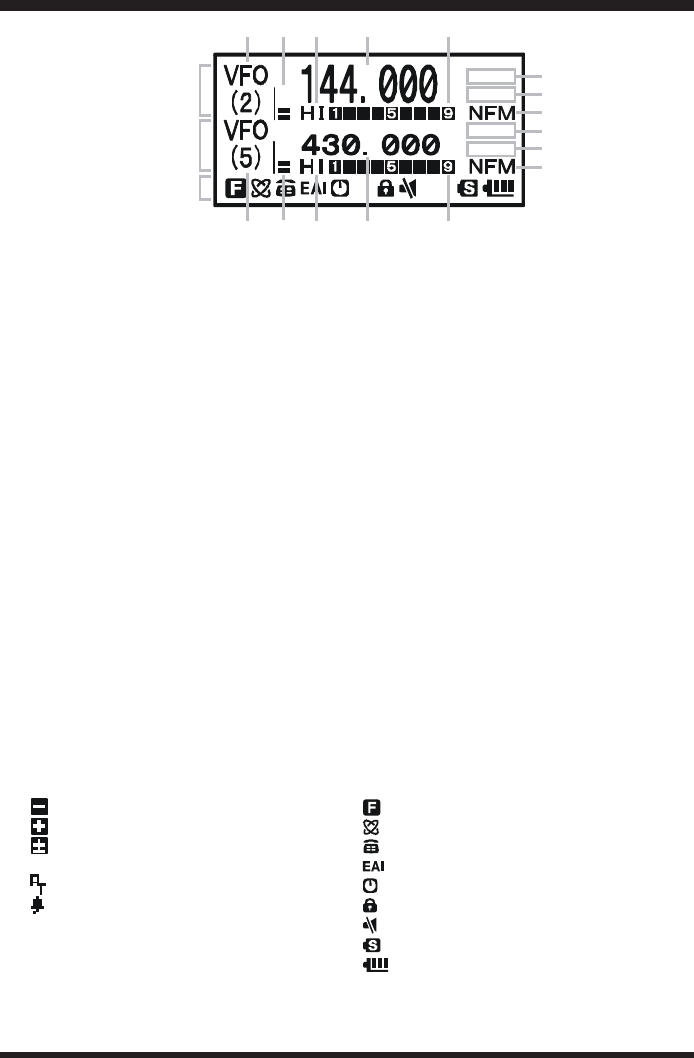
VX-8GR OPERATING MANUAL 3
DISPLAY ICONS & INDICATORS
FREQUENCY CONTROL
VFO: VFO Mode
MR: Memory Mode
MT: Memory Tune Mode
HOM: Home Channel Memory
PMS: Programmable Memory Scan Mode
VDW: Dual Watch Active
(VFO-Memory Channel)
MDW:Dual Watch Active
(Memory Channel-Memory Channel)
SMS: Smart Search Active
Note: When these icon is blinked, the Sub Band Operation feature is active.
SQUELCH TYPE & RADIO MODE
TN: Tone Encoder Active
TSQ: Tone Squelch Active
DCS: Digital Code Squelch Active
RTN: Reverse Tone Squelch Active
PR: User Programmed Reverse CTCSS Decoder Active
PAG: Enhanced Paging & Code Squelch (EPCS) Active
MSG: Message Feature Active
DC: Split Tone Feature Active (DCS Encode only)
T-D: Split Tone Feature Active (Encodes a CTCSS Tone and Decodes a DCS Code)
D-T: Split Tone Feature Active (Encodes a DCS Code and Decodes a CTCSS Tone)
A12: APRS® Feature Active (1200 bps)
A96: APRS® Feature Active (9600 bps)
MISCELLANEOUS SETTING
: Repeater Shift Direction (Minus Shift)
: Repeater Shift Direction (Plus Shift)
: Independent Transmit Frequencies
(Odd Splits)
: Attenuator Active
: Bell Alarm Active
OPERATING MODE
NFM: FM
AM: AM
Note 1): When the under bar is appended to these icons, the Vibrator function is active.
2): When the dashed under bar is appended to these icons, the CTCSS/DCS/EPCS Vibrator operation
is active.
VOLUME LEVEL
TX POWER LEVEL
HI: High Power (5 W)
L3: LOW3 Power (2.5 W)
L2: LOW2 Power (1 W)
L1: LOW1 Power (0.02 W)
OPERATING FREQUENCY
S&PO METER
ICON
: Secondary Keypad Active
: Internet Connection Feature (WiRESTM) Active
: DTMF Autodialer Active
: Emergency Automatic ID (EAI) Feature Active
: Automatic Power-Off Active
: Key Lock Active
: Mute Feature Active
: Battery Saver Active
: Battery Indicator
“B” Band
Display
Icon
“A” Band
Display
FCC ID: K6620415X20 / IC:511B-20415X20

VX-8GR OPERATING MANUAL4
KEYPAD FUNCTIONS
Frequency entry digit “1”
Switches the “Upper”
frequency to be the
“Operating” (TX) Band.
Activates the
Dual Receive Feature.
Switches the “Lower”
frequency to be the
“Operating” (TX) Band.
Activates the
Dual Receive Feature.
PRIMARY FUNCTION
(PRESS KEY)
(1) Moves operation to the
next-highest frequency band.
(2) Activates the Memory Bank
feature.
Moves operation to the
next-lowest frequency band
THIRD FUNCTION
(PRESS AND HOLD KEY)
(1) Select the Bandwidth for
the VFO scanner.
(2) Select the Memory Scan
mode.
Selects the synthesizer steps
to be used during VFO
operation.
Frequency entry digit “2”
SECONDARY FUNCTION
(PRESS + )
PRIMARY FUNCTION
(PRESS KEY)
THIRD FUNCTION
(PRESS AND HOLD KEY)
Selects the CTCSS Tone,
DCS code, EPCS code, or
Message.
SECONDARY FUNCTION
(PRESS + )
PRIMARY FUNCTION
(PRESS KEY)
THIRD FUNCTION
(PRESS AND HOLD KEY)
SECONDARY FUNCTION
(PRESS + )
PRIMARY FUNCTION
(PRESS KEY)
THIRD FUNCTION
(PRESS AND HOLD KEY)
Frequency entry digit “4”
Activates the ARTS feature.
Reverses transmit and
receive frequencies while
working through a repeater.
Switches operation to the
“Home” (favorite frequency)
channel.
Activates the EMERGENCY
function.
Frequency entry digit “5”
Activates the Memory Scan
“Skip” channel selection
mode.
Activates the Internet
Connection feature.
Selects the desired transmit
power output level.
No Action.
Frequency entry digit “7”
Activates the Audio Mute
Feature.
Frequency entry digit “8”
Activates the Spectrum
Analyzer (Spectra-ScopeTM)
feature.
No Action No Action
No Action No Action
No Action No Action
No Action No Action
NOTE
Press the a or b
key to switch the fre-
quency display between
the “Double-size Charac-
ter” and “Small Character”
mode while Mono band
operation.
SECONDARY FUNCTION
(PRESS + )
FCC ID: K6620415X20 / IC:511B-20415X20

VX-8GR OPERATING MANUAL 5
KEYPAD FUNCTIONS
Enter the Set Mode.
Activate the APRS
(Automatic Position
Reporting System) function.
No Action
Frequency entry digit “3”
Selects the DTMF mode. SECONDARY FUNCTION
(PRESS + )
PRIMARY FUNCTION
(PRESS KEY)
THIRD FUNCTION
(PRESS AND HOLD KEY)
SECONDARY FUNCTION
(PRESS + )
PRIMARY FUNCTION
(PRESS KEY)
THIRD FUNCTION
(PRESS AND HOLD KEY)
Selects the receive mode
between AM and FM.
Engage the Special
Search mode.
Activates the CTCSS
or DCS operation.
SECONDARY FUNCTION
(PRESS + )
PRIMARY FUNCTION
(PRESS KEY)
THIRD FUNCTION
(PRESS AND HOLD KEY)
SECONDARY FUNCTION
(PRESS + )
PRIMARY FUNCTION
(PRESS KEY)
THIRD FUNCTION
(PRESS AND HOLD KEY)
Frequency entry digit “6”
Selects the direction of the
uplink frequency shift (either
“–”, “+”, or “simplex”) during
repeater operation.
Switches frequency control
between the VFO and
Memory System.
Activates the “Memory Tune”
mode while in the Memory
Recall mode.
Activates the Priority (Dual
Watch) function.
Frequency entry digit “9”
Enters the “Special Memory”
mode.
Frequency entry digit “0”
Activates the Sub Band
Operation feature.
USA Version: Disables the Noise
and Tone Squelch System.
EXP Version: Activates the T.CALL
(1750 Hz) for repeater access.
Adjusts the Squelch
threshold level.
No Action
Activates the “Secondary”
key function.
Disables the “Secondary”
key function.
Toggle the DIAL knob
function between the
“Frequency Control” and
“Receiver Audio Control”.
Rotate the DIAL knob while
holding this key to adjust the
audio volume level.
No Action
No Action
No Action No Action Activates the “Memory Write”
mode (for memory channel
storage).
USA Version: Disables the Noise
and Tone Squelch System.
EXP Version: Activates the T.CALL
(1750 Hz) for repeater access.
Toggle the transceiver’s
power “on” and “off”.
Toggle the key lock feature
“on” and “off” while the
transceiver is turned “on”.
No Action
Activates the transmitter.
Activates the transmitter with
the “high” power temporarily
while the transceiver is “low”
power operation.
Activates the Transmitter.
FCC ID: K6620415X20 / IC:511B-20415X20

VX-8GR OPERATING MANUAL6
ACCESSORIES SUPPLIED WITH THE VX-8DR
Antenna 1 pc YHA-72 (Q3000236)
Li-Ion Battery Pack 1 pc FNB-101LI (7.4V/1,100mAh: AAG10X001)
Battery Charger 1 pc NC-86B (for USA version: Q9500149) or
NC-86C (for EXP version: Q9500150)
Belt Clip 1 pc (RA1053600)
Screws 2 pcs (M3x10SUS: U24310020)
Plastic Cap 1 pc (RA1054200)
Sheet 1 pcs (RA1231300)
Operating Manual 1 pc
Warranty Card 1 pc
ACCESSORIES & OPTIONS
FCC ID: K6620415X20 / IC:511B-20415X20
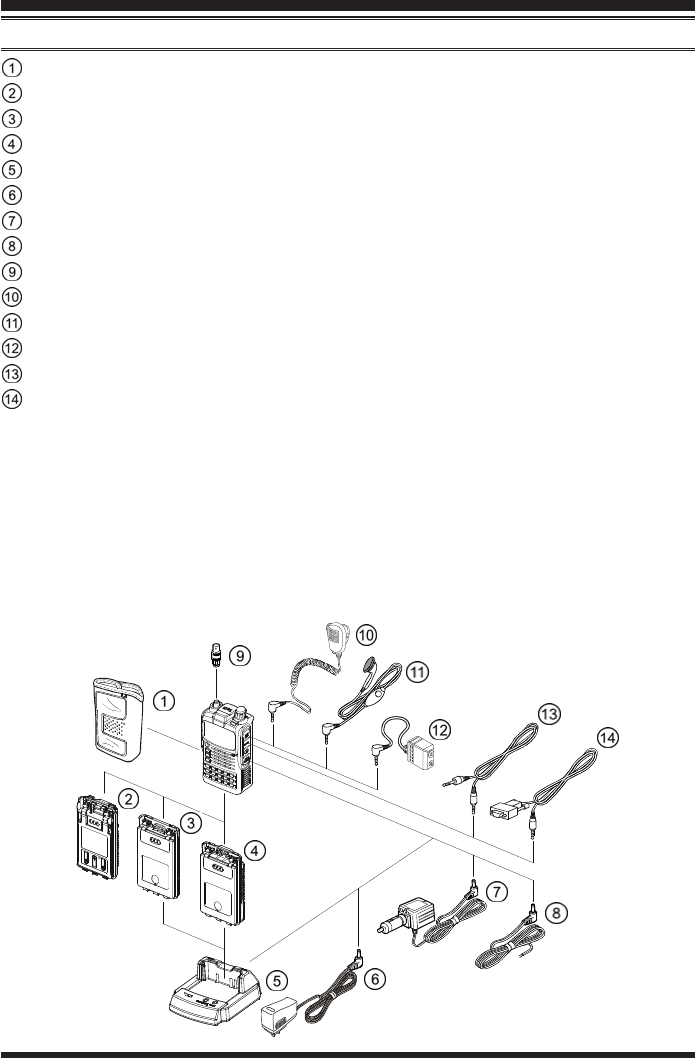
VX-8GR OPERATING MANUAL 7
AVAILABLE OPTIONS FOR YOUR VX-8DR
CSC-101LI Soft Case
FBA-39 3 x “AA” Cell Battery Case (batteries not supplied)
FNB-101LI Li-Ion Battery Pack (7.4V/1,100 mAh)
FNB-102LI Li-Ion Battery Pack (7.4V/1,800 mAh)
CD-41 Rapid Charger (requires NC-86B/C/U)
NC-86B/C/UBattery Charger for the CD-41
E-DC-5B DC Cable w/Noise Filter
E-DC-6 DC Cable; plug and wire only
CN-3 BNC-to-SMA Adapter
MH-34B4B Speaker/Microphone
MH-37A4B Ear peace Microphone
CT-44 Microphone Adapter
CT-144 Clone Cable
CT-143 PC Connection Cable
: “B” suffix is for use with 120 VAC (Type-A plug), “C” suffix is for use with 230 VAC
(Type-C plug), and “U” suffix is for use with 230 VAC (Type-BF plug).
Availability of accessories may vary. Some accessories are supplied as standard per local
requirements, while others may be unavailable in some regions. Consult your Yaesu Dealer
for details regarding these and any newly-available options. Connection of any non-Yaesu
approved accessory, should it cause damage, may void the Limited Warranty on this ap-
paratus.
ACCESSORIES & OPTIONS
FCC ID: K6620415X20 / IC:511B-20415X20
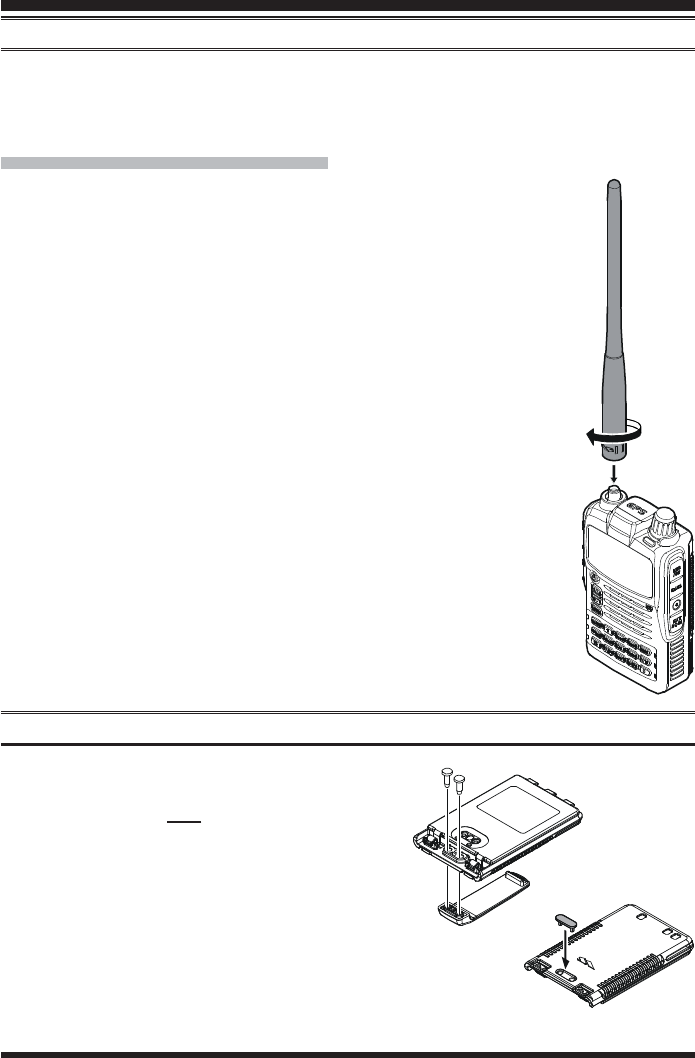
VX-8GR OPERATING MANUAL8
Figure 1
Figure 2
ANTENNA INSTALLATION
The supplied antenna provides good results over the entire frequency range of the trans-
ceiver. However, for enhanced base station medium-wave and shortwave reception, you
may wish to connect an external (outside) antenna.
TO INSTALL THE SUPPLIED ANTENNA
Hold the bottom end of the antenna, then screw it onto the mating connec-
tor on the transceiver until it is snug. Do not over-tighten by use of ex-
treme force.
Notes:
Never transmit without having an antenna connected.
Carefully turn the supplied antenna onto the SMA jack. Never twist
the upper part of the antenna while screwing it onto the mating con-
nector of the transceiver.
If using an external antenna for transmission, ensure that the SWR
presented to the transceiver is 1.5:1 or lower.
INSTALLATION OF ACCESSORIES
BELT CLIP INSTALLATION
Install the supplied Belt Clip to the FNB-101LI
Battery Pack using the supplied two screws
(Figure 1). Use only the screws included with
the Belt Clip to mount the Belt Clip to the back
of the Battery Pack!
If you do not need the Belt Clip, install the sup-
plied Plastic Cap to the Battery Pack (Figure
2). If you install the belt clip later, push the Plas-
tic Cap out with a small tool or screwdriver.
FCC ID: K6620415X20 / IC:511B-20415X20

VX-8GR OPERATING MANUAL 9
INSTALLATION OF FNB-101LI BATTERY PACK
The FNB-101LI is a high-performance Lithium-Ion battery providing high capacity in a
very compact package. Under normal use, the FNB-101LI may be used for approxi-
mately 300 charge cycles, after which operating time may be expected to decrease. An old
battery pack, which is displaying diminished capacity should be replaced with a new one.
To install the FNB-101LI Battery Pack, carefully mate the
battery’s three alignment tabs with their corresponding align-
ment slots on the transceiver bottom case, then gently press
the top side of the Battery Pack until it locks in place with a
“click”.
To remove the Battery Pack, turn the transceiver off and
remove any protective cases. Press the Battery Pack Release
Knobs downward to unlock the latch, then remove the Bat-
tery Pack from the transceiver.
The VX-8GR battery must be correctly installed, to
maintain the waterproof integrity.
INSTALLATION OF ACCESSORIES
REMOVE
BATTERY PACK RELEASE KNOB
INSTALL
If the battery has never been used, or its charge is depleted, it may be charged by connect-
ing the NC-86B/C Battery Charger, as shown in the illustration, to the EXT DC jack. If
only 12 ~ 16 Volt DC power is available, the optional E-DC-5B DC Adapter (with its
cigarette lighter plug) or E-DC-6 DC Cable may also be used for charging the battery, as
shown in the illustration.
While the battery is being charged, the display will indicate “CHARGINGCHARGING
CHARGINGCHARGING
CHARGING” and the “A”
indicator will glow red. The S-meter will deflect according to the charging status. When
charging is finished, the display will change to indicate “COMPLETECOMPLETE
COMPLETECOMPLETE
COMPLETE” and the “A” indica-
tor will glow green.
E-DC-5BNC-86 E-DC-6
FCC ID: K6620415X20 / IC:511B-20415X20

VX-8GR OPERATING MANUAL10
INSTALLATION OF ACCESSORIES
BATTERY LIFE INFORMATION
When the battery charge is almost depleted, a “Low Voltage” indicator will appear on the
display. When this icon appears, it is recommended that you charge the battery soon.
TX 6 seconds, RX 6 seconds, and Squelched 48 seconds (continuous operating cycle).
The present battery voltage can be displayed manually on the LCD, by following the
instructions on page .
Battery capacity may be reduced during extremely cold weather. Keeping the radio inside
your parka may help preserve the full charge capacity.
OPERATING BAND
144 MHz
430 MHz
FNB-101LI
5.0 hours
5.0 hours
FBA-39
17 hours
16 hours
BATTERY INDICATOR
: Full battery power
: Enough battery power
: Low battery power
: Poor battery power
(w/Blink): Charge (or replace) the battery
BATTERY LIFE (APPROX.)
FNB-102LI
8.5 hours
8.0 hours
FCC ID: K6620415X20 / IC:511B-20415X20
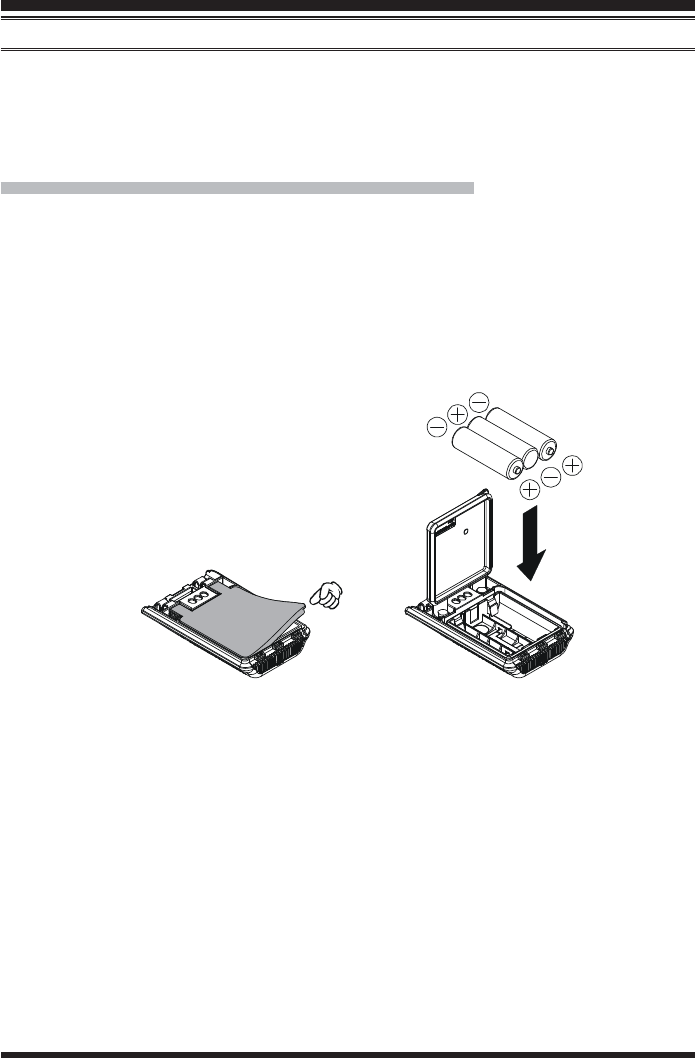
VX-8GR OPERATING MANUAL 11
INSTALLATION OF FBA-39 ALKALINE BATTERY CASE (OPTION)
The optional FBA-39 Battery Case allows receive monitoring using three “AA” size Al-
kaline batteries. Alkaline batteries can also be used for low power transmission in an
emergency. The power output will only be selectable 1 W/50 mW (for 50/144/430 MHz
FM) or 500 mW/50 mW (for 222 MHz FM), or 1 W fixed (for 50 MHz AM).
TO INSTALL ALKALINE BATTERIES INTO THE FBA-39
1. Lift up the lower right corner of the rubber cover, and then open the cover (Figure 1).
2. Referring to Figure 2, slide the batteries into the FBA-39 as shown in the illustration,
with the Negative [–] side of the batteries touching the spring connections inside the
FBA-39.
3. Close the rubber cover.
4. Install the FBA-39 in the transceiver in the same manner as the FNB-101LI.
INSTALLATION OF ACCESSORIES
The FBA-39 does not provide connections for charging, since Alkaline cells cannot be
re-charged. Therefore, the NC-86B/C, E-DC-5B, or E-DC-6 may safely be connected to
the EXT DC jack when the FBA-39 is installed.
Notes:
The FBA-39 is designed for use only with AA-type Alkaline cells.
If you do not use the VX-8DR for a long time, remove the Alkaline batteries from the
FBA-39, as battery leakage could cause damage to the FBA-39 and/or the trans-
ceiver.
Figure 1 Figure 2
FCC ID: K6620415X20 / IC:511B-20415X20
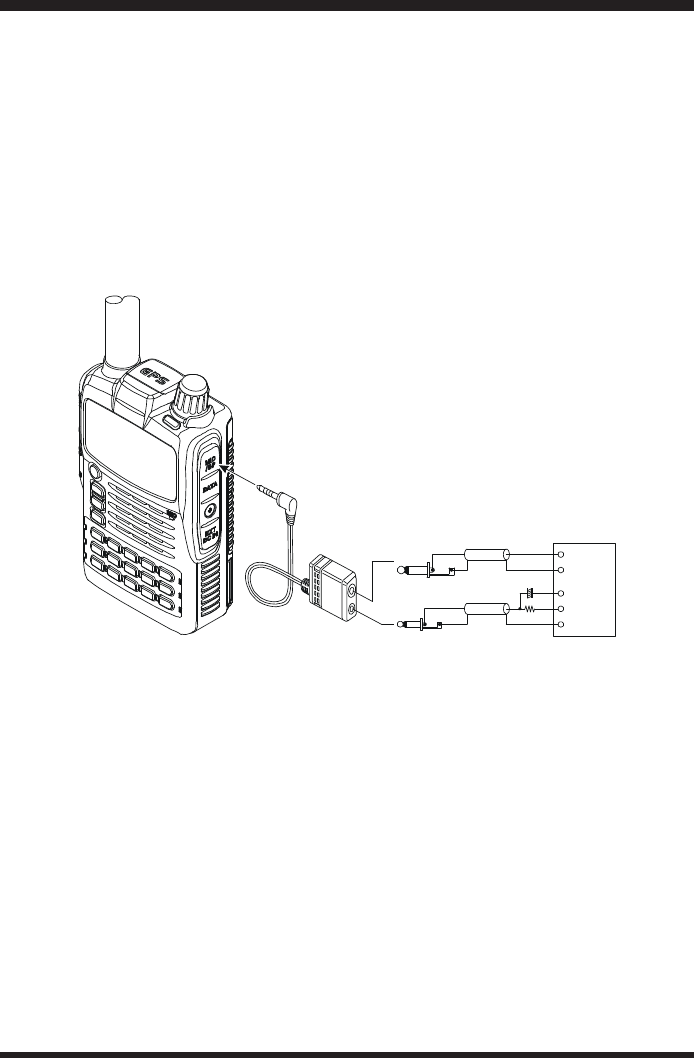
VX-8GR OPERATING MANUAL12
INTERFACE OF PACKET TNCS
The VX-8GR may be used for Packet operation, using the optional CT-44 Microphone
Adapter (available from your Yaesu dealer) for easy interconnection to commonly-avail-
able connectors wired to your TNC.
The audio level from the receiver to the TNC may be adjusted by rotating the DIAL knob
while pressing and holding the g key, as with voice operation. The input level to the
VX-8GR from the TNC should be adjusted at the TNC side; the optimum input voltage is
approximately 5 mV at 2000 Ohms.
Be sure to turn the transceiver and TNC off before connecting the cables, to prevent volt-
age spikes from damaging your transceiver.
TNC
SP
GND
GND
2 k
10 FµMIC
MIC
EAR
PTT
CT-44 Microphone Adapter
FCC ID: K6620415X20 / IC:511B-20415X20

VX-8GR OPERATING MANUAL 13
Hi! I’m R. F. Radio, and I’ll be helping you along as you learn the many
features of the VX-8GR. I know you’re anxious to get on the air, but I en-
courage you to read the “Operation” section of this manual as thoroughly as
possible, so you’ll get the most out of this fantastic new transceiver. Now. . .let’s get
operating!
SWITCHING POWER ON AND OFF
1. Be sure the battery pack is installed, and that it is fully charged. Connect the antenna
to the top panel ANTENNA jack.
2. Press and hold in the p(PWR) switch (on the left side
of the front panel) for 2 seconds. Two beeps will be heard
when the switch has been held long enough. The open-
ing message will appear briefly on the display, then the
frequency display will appear. After another two sec-
onds, the receive-mode Battery Saver function will be-
come active, unless you have disabled it (see page xx).
3. To turn the VX-8GR off, press and hold in the p(PWR) switch again for 2 seconds.
If you don’t hear the two “Beep” tones when the radio comes on, the Beeper
may have been disabled via the Menu system. See page 27, which tells you
how to reactivate the Beeper.
ADJUSTING THE VOLUME LEVEL
Rotate the DIAL knob while pressing and holding the g
key to set the desired audio level. Clockwise rotation in-
creases the volume level.
1) The Volume level may be set on the
“A-Band” and “B-Band” separately.
2) You may set the Audio Output Level to the
Speaker, and the Earphone Output Level individually. The
“SP VOLUME” notation appears in the S- & PO meter area while adjusting the Speaker
Output Level. The “HP VOLUME” notation appears in the S- & PO meter area while
adjusting the Earphone Output Level.
3) Pressing the f key followed by the g key, the DIAL knob function changes to the
Volume Level adjustment instead of the frequency control. In this case, the “Volume
Level Indicator” on the display blinks. Pressing the f key followed by the g key
again, returns the DIAL knob function to the frequency control. You may also change
the g key function via Set Mode Item 99: VOLUME MODE. See page xx for details.
OPERATION
FCC ID: K6620415X20 / IC:511B-20415X20
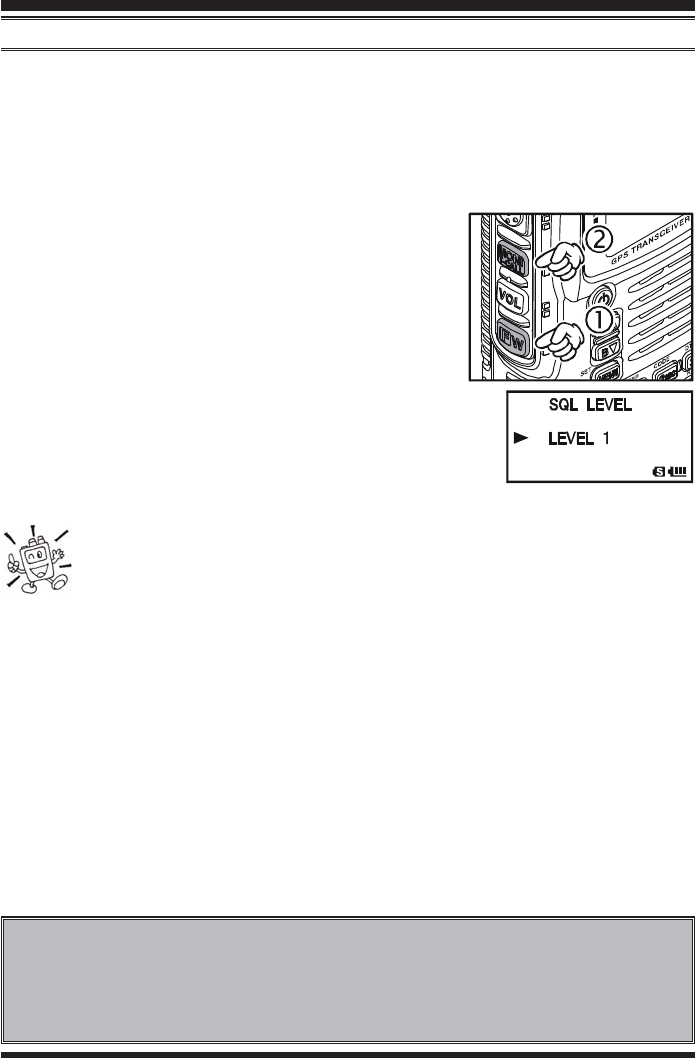
VX-8GR OPERATING MANUAL14
OPERATION
SQUELCH ADJUSTMENT
The VX-8GR’s Squelch system allows you to mute the background noise when no signal
is being received. Not only does the Squelch system make “standby” operation more
pleasant, it also significantly reduces battery current consumption.
The Squelch system may be adjusted independently for the FM and Wide-FM (FM Broad-
cast) modes.
1. Press the f key, then press the e key on the left
side of the radio. This provides a “Short-cut” to Set
Mode Item 85: SQL LEVEL85: SQL LEVEL
85: SQL LEVEL85: SQL LEVEL
85: SQL LEVEL.
2. Now, rotate the DIAL knob to the point where the back-
ground noise is just silenced (typically at a setting of
about “3” or “4” on the scale); this is the point of maxi-
mum sensitivity to weak signals.
3. When you are satisfied with the Squelch threshold setting,
press the PTT key briefly to save the new setting and exit to
normal operation.
4. You may also adjust the Squelch setting by using the “Set”
(Menu) mode. See page xx for details.
1) The Squelch level may be set on the “Main” and “Sub” bands separately.
2) If you’re operating in an area of high RF pollution, you may need to
consider “Tone Squelch” operation using the built-in CTCSS Decoder. This
feature will keep your radio quiet until a call is received from a station sending a carrier
which contains a matching (sub audible) CTCSS tone. Or if your friends have radios
equipped with DCS (Digital Coded Squelch) like your VX-8GR, try using that mode for
silent monitoring of busy channels.
24-HOUR CLOCK
The VX-8GR has a 24-hour clock with a calendar which covers all dates from
January 1, 2000 through December 31, 2099. Set the clock according to the “Clock
Set” column on page xx
FCC ID: K6620415X20 / IC:511B-20415X20
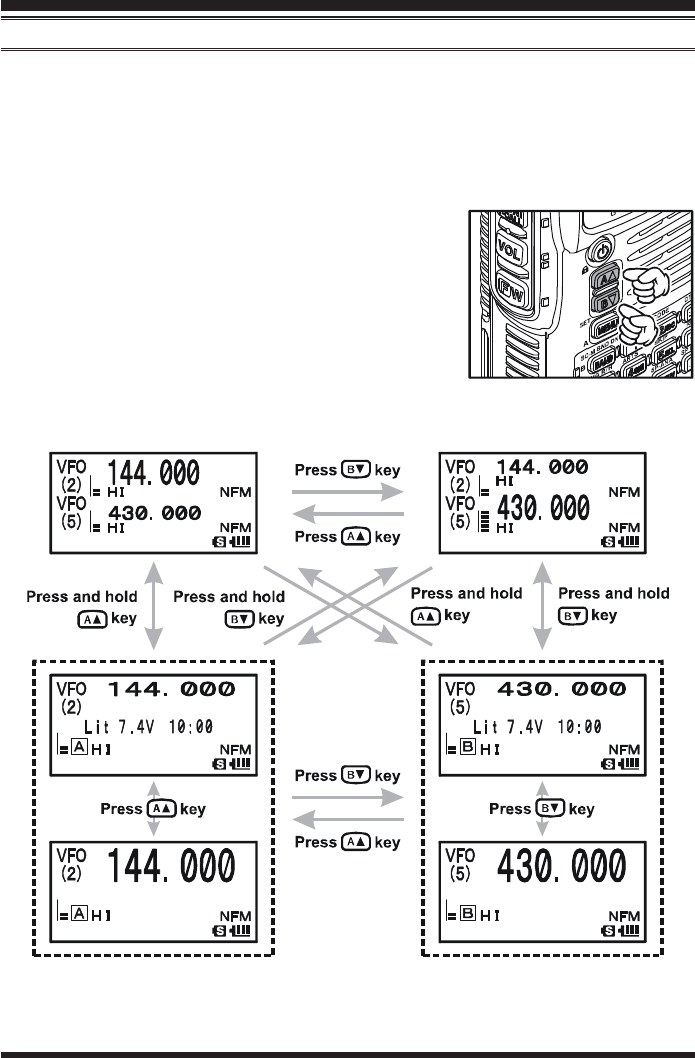
VX-8GR OPERATING MANUAL 15
SELECTING THE OPERATING BAND
In the factory default configuration, the VX-8GR operates in the “Dual Receive” mode.
During Dual Receive operation, the “A-Band” frequency will be displayed on the upper
part of the LCD, and the “B-Band” frequency will be displayed on the lower part. The
“Operating” band (the band on which transmission and band/frequency changes are pos-
sible) is shown in large characters, and “Receive only” band is shown in small characters.
Press the a key briefly to engage the “A-Band” fre-
quency as the “Operating” band. Alternatively, press the
b key briefly to engage the “B-Band” frequency, as de-
scribed previously.
Press and hold in the a or b key for 1/2 seconds to
switch to Mono Band Operation. During Mono band op-
eration, you may change the display between “double-size
character” and “large character” by pressing the a/b key.
OPERATION
FCC ID: K6620415X20 / IC:511B-20415X20

VX-8GR OPERATING MANUAL16
OPERATION
SELECTING THE FREQUENCY BAND
The VX-8GR covers an incred-
ibly wide frequency range, over
which a number of different op-
erating modes are used. There-
fore, the VX-8GR’s frequency
coverage has been divided into
different operating bands. Each
band has its own preset channel
steps and operating modes. You can change the channel steps and operating modes later, if
you like (see page xx).
TO CHANGE OPERATING BANDS
1. Press the B key repeatedly. You will see the LCD
indication change to a higher frequency band each time
you press the B key. A Band Number according to
the receiving frequency is also displayed.
2. If you wish to move the operating band selection down-
ward (toward lower frequencies), press the f key
first, then press the B key.
3. The VX-8DR uses a dual VFO system (described previously). To switch TX/RX op-
eration from the “VFO-A” to the “VFO-B” instantly, press the b key briefly. Pressing
the a key will return TX/RX operation to “VFO-A”. The frequency band shown in
“Large” characters is the band on which transmission is possible; the band shown in
“Small” characters may only be used for reception.
4. Once you have selected the desired band, you may initiate manual tuning (or scan-
ning). See the discussions on the next page.
If desired, you may omit (skip) one or more bands from the band selection
loop for faster recall of your favorite operating bands. See page xx for de-
tails.
OPERATING BAND
[BAND NUMBER]
AIR Band
VHF HAM Band
VHF Band
INFO 1 Band
UHF HAM Band
UHF Band
INFO 2 Band USA Version: Cellular Blocked
FREQUENCY RANGE
[1]
[2]
[3]
[4]
[5]
[6]
[7]
“VFO-B”
108-137 MHz
137-174 MHz
174-222 MHz
222-420 MHz
420-470 MHz
470-580 MHz
–
“VFO-A”
108-137 MHz
137-174 MHz
174-222 MHz
222-420 MHz
420-470 MHz
470-800 MHz
800-999.99 MHz
FCC ID: K6620415X20 / IC:511B-20415X20
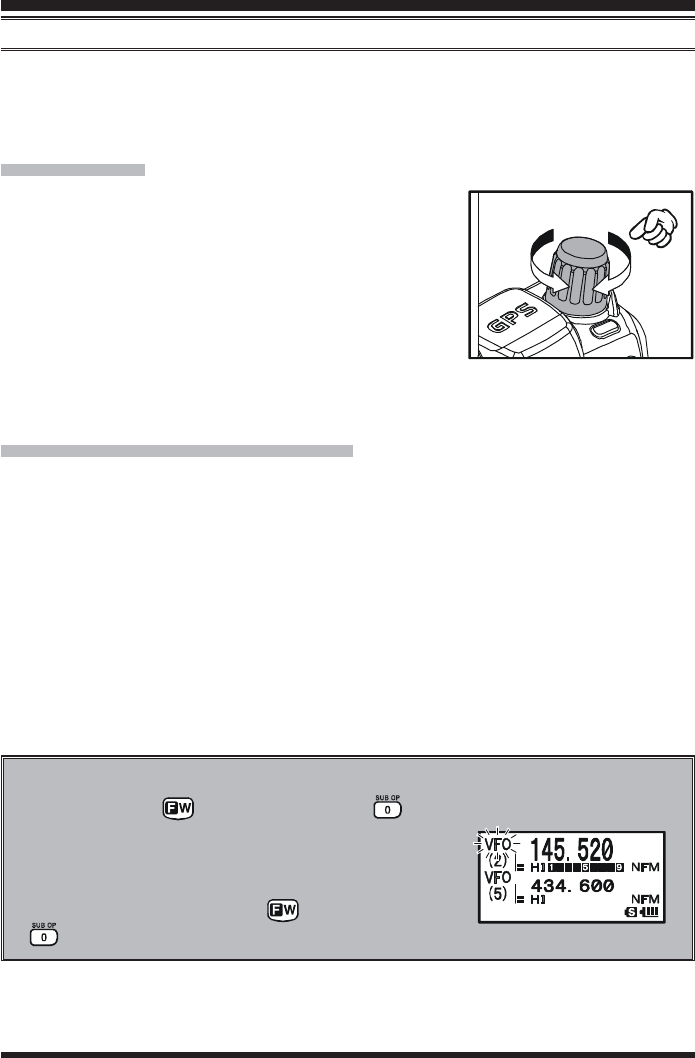
VX-8GR OPERATING MANUAL 17
FREQUENCY NAVIGATION
The VX-8GR will initially be operating in the “VFO” mode, as just described. This is a fre-
quency step system which allows free tuning throughout the currently-selected operating band.
Three basic frequency navigation methods are available on the VX-8GR:
1) TUNING DIAL
Rotation of the DIAL knob allows tuning in the pre-pro-
grammed steps established for the current operating band.
Clockwise rotation of the DIAL knob causes the VX-8GR
to be tuned toward a higher frequency, while counter-clock-
wise rotation will lower the operating frequency.
If you press the f key briefly, then rotate the DIAL knob,
frequency steps of 1 MHz will be selected. This feature is
extremely useful for making rapid frequency excursions over the wide tuning range of the
VX-8GR.
2) DIRECT KEYPAD FREQUENCY ENTRY
The desired operating frequency may be entered directly from the keypad.
The operating mode will automatically be set once the new frequency is entered via the
keypad.
To enter a frequency from the keypad, just press the numbered digits on the keypad in the
proper sequence. There is no “Decimal point” key on the VX-8GR. However, there is a short-
cut for frequencies ending in zero - press the c key after the last non-zero digit.
Examples:
To enter 146.520 MHz, press 146520
To enter 430.000MHz, press 43c
OPERATION
Sub Band Operation
When press the key followed by the key, you can cause the controls
(except the TX function) to act on the “Sub” band. When
the Sub Band operation is activated, the Main band’s
“Frequency Control” icon will blinks. After making con-
trol to the Sub band, press the key followed by the
key to return control to the “Main” band.
FCC ID: K6620415X20 / IC:511B-20415X20

VX-8GR OPERATING MANUAL18
3) SCANNING
From the VFO mode, press and hold in the B key for one second, and while still
holding in the B key, rotate the DIAL knob to select
the bandwidth for the VFO scanner. Release the B key
to begin scanning toward a higher frequency. The scanner
will stop when it receives a signal strong enough to break
through the Squelch threshold. The VX-8GR will then hold
on that frequency according to the setting of the “RESUMERESUME
RESUMERESUME
RESUME”
mode (Menu Item 77: SCAN RESUME77: SCAN RESUME
77: SCAN RESUME77: SCAN RESUME
77: SCAN RESUME).
If you wish to reverse the direction of the scan (i.e. toward a lower frequency, instead of a
higher frequency), just rotate the DIAL knob one click in the counter-clockwise direction
while the VX-8GR is scanning. The scanning direction will be reversed. To revert to
scanning toward a higher frequency once more, rotate the DIAL knob one click clock-
wise.
Press the PTT switch briefly to cancel the scanning. See page xx for more details regard-
ing Scan Operation.
OPERATION
FREQUENCY NAVIGATION
Dual Receive Notice
The VX-8GR may receive very strong signals on the Image frequency, and/or the
receiver sensitivity may be somewhat reduced by the combination of the “A-Band”
and “B-Band” frequencies while Dual Receive operation is engaged.
If you experience interference that you suspect may be coming in via an “Image”
path, you may calculate the possible frequencies using the formulas below. This
information may be used in the design of effective countermeasures such as traps,
etc.
9.8304 MHz x n11.7 MHz x n(n is an integer: 1, 2, 3, …)
4.9152 MHz x n6.1440 MHz x n
“A-Band” Freq. = (“B-Band” Freq. ± 46.35 MHz) x n
“B-Band” Freq. = (“A-Band” Freq. ± 47.25 MHz) x n (@ “A-Band” = NFM)
“B-Band” Freq. = (“A-Band” Freq. ± 45.8 MHz) x n (@ “A-Band” = WFM)
FCC ID: K6620415X20 / IC:511B-20415X20
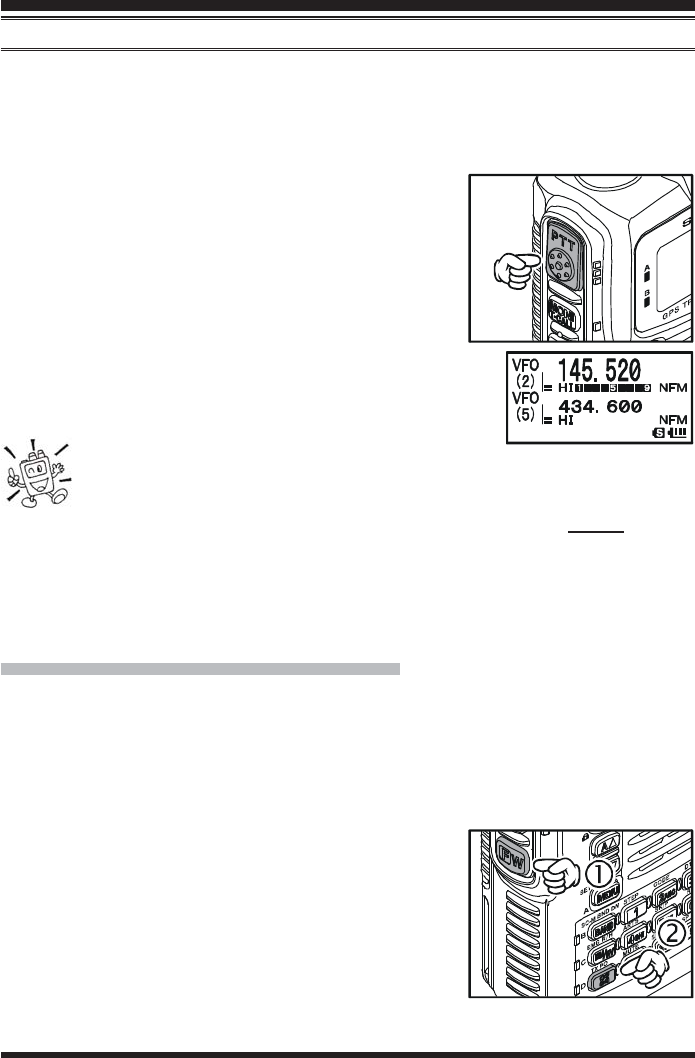
VX-8GR OPERATING MANUAL 19
TRANSMISSION
Once you have set up an appropriate frequency inside one of the dual amateur bands on
which the VX-8GR can transmit (144 MHz or 430 MHz), you’re ready to transmit. These
are the most basic steps; more advanced aspects of transmitter operation will be discussed
later.
1. To transmit, press the PTT switch, and speak into the
front panel microphone (located in the upper right-hand
corner of the speaker grille) in a normal voice level.
The LED of the “A” or “B” which is designated the
“Main” band will glow red during transmission.
2. To return to the receive mode, release the PTT switch.
3. During transmission, the relative power level will be
indicated on the LCD. Additionally, the “L1”, “L2”, “L3”,
or “HI” icon will appear at the left side of the PO meter,
corresponding with the “Power” Level setting.
1) If you’re just talking to friends in the immediate
area, you’ll get much longer battery life by switching to Low Power opera-
tion. To do this, press the f key, then press the d key so that the “Low
Power” icon appears at the bottom of the display. And don’t forget: always have an
antenna connected when you transmit.
2) Transmission is not possible on “Sub” band and any operating bands other than the
144 MHz and 430 MHz bands on the “Main” band.
3) Never transmit without having an antenna connected.
CHANGING THE TRANSMITTER POWER LEVEL
You can select between a total of four transmitter power levels on your VX-8GR. The
exact power output will vary somewhat, depending on the voltage supplied to the trans-
ceiver. With the standard FNB-101LI Battery Pack and external DC source, the power
output levels available are: “L1”, “L2”, “L3”, or “HI”
To change the power level:
1. The default setting for the power output is “High;” in
this configuration, the display shows the “HI” icon.
Pressing the f key, followed by the d key, causes
the power level “L1”, “L2”, or “L3” to appear.
2. Press the f key, followed by the d key (repeat-
edly, if necessary) to make the “HI” icon appear and
restore “High Power” operation.
OPERATION
FCC ID: K6620415X20 / IC:511B-20415X20

VX-8GR OPERATING MANUAL20
OPERATION
1) The VX-8GR is smart! You can set up Low power on one band (like UHF),
while leaving VHF on High power, and the radio will remember the different
settings on each band. And when
you store memories, you can store High and
Low power settings separately in each
memory, so you don’t waste battery power
when using very close-in repeaters!
2) When you are operating on one of the Low
power settings, you can press the key, then press the PTT switch, to cause the VX-
8GR to transmit (temporarily) on High power. After one transmission, the power level
will revert to the previously-selected Low power setting.
TRANSMISSION
FNB-101LI/-102LI
or EXT DC (7.4 V)
HI: 5.0 W,
L3: 2.5 W,
L2: 1.0 W,
L1: 0.05 W
TRANSMIT POWER
FBA-39
(w/Fresh Batteries)
L2: 1.0 W,
L1: 0.05 W
FCC ID: K6620415X20 / IC:511B-20415X20
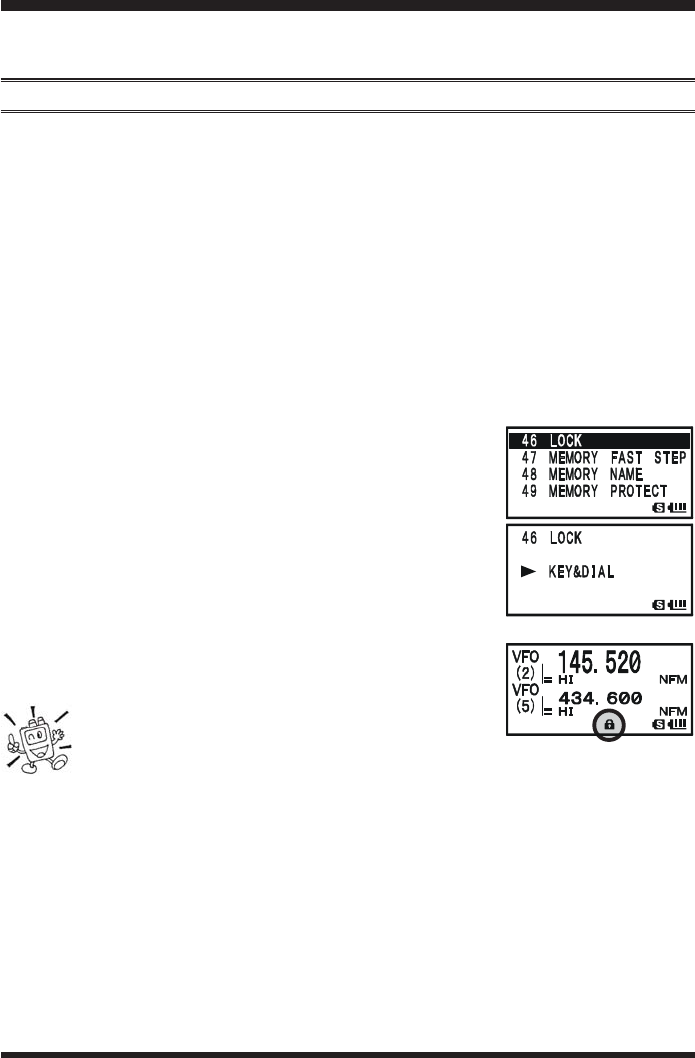
VX-8GR OPERATING MANUAL 21
ADVANCED OPERATION
Now that you mastered the basics of VX-8GR operation, let’s learn more about some of
the really neat features.
KEYBOARD LOCKING
In order to prevent accidental frequency change or inadvertent transmission, various keys
and switches may be locked out. The possible lockout combinations are:
KEYKEY
KEYKEY
KEY: Just the front panel keys are locked out
DIALDIAL
DIALDIAL
DIAL: Just the top panel DIAL is locked out
KEY&DIALKEY&DIAL
KEY&DIALKEY&DIAL
KEY&DIAL: Both the DIAL knob and Keys are locked out
PTTPTT
PTTPTT
PTT: The PTT switch is locked (TX not possible)
KEY&PTTKEY&PTT
KEY&PTTKEY&PTT
KEY&PTT: Both the keys and PTT switch are locked out
DIAL&PTTDIAL&PTT
DIAL&PTTDIAL&PTT
DIAL&PTT: Both the DIAL knob and PTT switch are locked out
ALLALL
ALLALL
ALL: All of the above are locked out
To lock out some or all of the keys:
1. Press and hold the m key for one second to enter the Set Mode.
2. Rotate the DIAL knob to select Set Mode Item 46: LOCK46: LOCK
46: LOCK46: LOCK
46: LOCK.
3. Press the m key briefly to enable selection of this Menu
Item.
4. Rotate the DIAL knob to choose between one of the lock-
ing schemes as outlined above.
5. When you have made your selection, press the PTT switch
to save the new setting and resume normal operation.
To activate the locking feature:
Press the p(PWR) switch briefly. The “k” icon will appear
on the LCD. To cancel locking, press the p(PWR) switch again.
Even when “ALL” keys have been locked out, one
key actually is not locked out: the p(PWR) switch
remains available so you can unlock your keypad when you want to!
FCC ID: K6620415X20 / IC:511B-20415X20
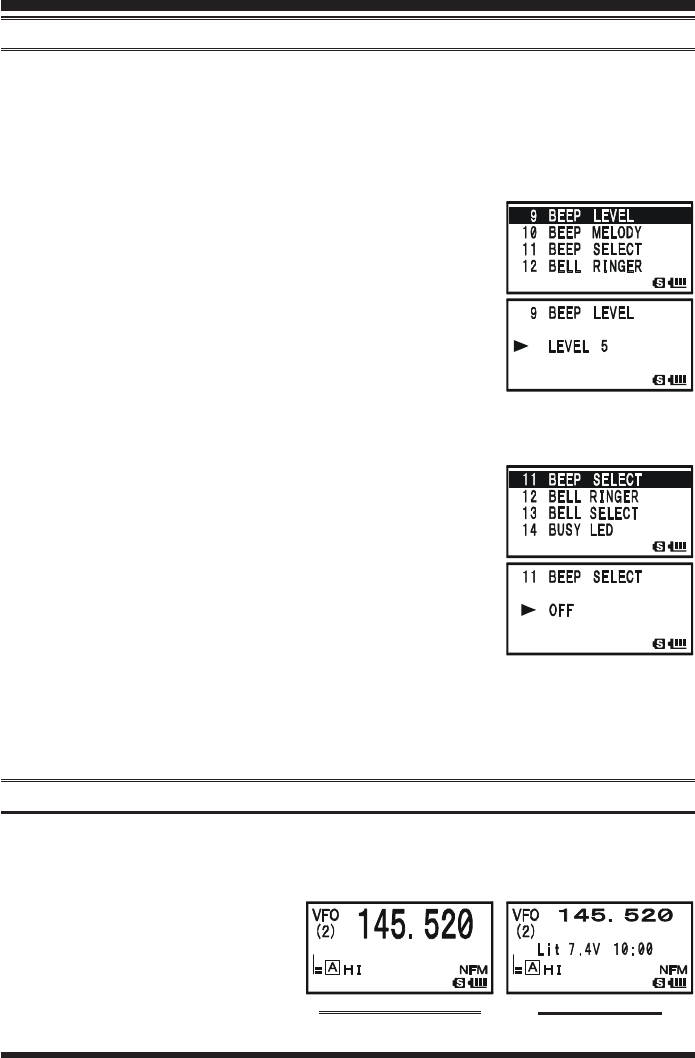
VX-8GR OPERATING MANUAL22
ADJUSTING THE KEYPAD BEEPER VOLUME LEVEL
A keypad beeper provides useful audible feed back whenever a key button is pressed. The
keypad beeper level changes according to the receiver audio volume level setting. How-
ever, you may adjust the volume balance between the receiving audio and keypad beeper
using Set Mode Item 11: BEEP LEVEL11: BEEP LEVEL
11: BEEP LEVEL11: BEEP LEVEL
11: BEEP LEVEL.
1. Press and hold the m key for one second to enter the Set Mode.
2. Rotate the DIAL knob to select Set Mode Item 9: BEEP9: BEEP
9: BEEP9: BEEP
9: BEEP
LEVELLEVEL
LEVELLEVEL
LEVEL.
3. Press the m key briefly to enable selection of this Set
Mode Item.
4. Rotate the DIAL knob to select the desired level.
5. When you have made your choice, press the PTT switch to
save the new setting and return to normal operation.
Additionally, if you want to turn the beep off:
1. Press and hold the m key for one second to enter the Set Mode.
2. Rotate the DIAL knob to select Set Mode Item 11: BEEP11: BEEP
11: BEEP11: BEEP
11: BEEP
SELECTSELECT
SELECTSELECT
SELECT.
3. Press the m key briefly to enable selection of this Set
Mode Item.
4. Rotate the DIAL knob to change the setting to “OFFOFF
OFFOFF
OFF”.
5. When you have made your choice, press the PTT switch to
save the new setting and return to normal operation.
6. If you wish to re-enable the Beeper, just repeat the above
procedure, rotating the DIAL knob to select “KEYKEY
KEYKEY
KEY” or “KEY & SCANKEY & SCAN
KEY & SCANKEY & SCAN
KEY & SCAN” in step “4”
above.
KEYKEY
KEYKEY
KEY: The beeper sounds when you press any key.
KEY & SCANKEY & SCAN
KEY & SCANKEY & SCAN
KEY & SCAN: The beeper sounds when you press a key or when the scanner stops.
SETTING THE FREQUENCY DISPLAY IMAGE SIZE
When operating in “Mono” band, pressing the a or b key, causes the LCD to “toggle”
between display of double-size characters and large characters. However, this feature
does not work during Dual Receive operation, as two frequencies are displayed in that
instance.
ADVANCED OPERATION
LARGE CHARACTERS
DOUBLE-SIZE CHARACTERS
FCC ID: K6620415X20 / IC:511B-20415X20
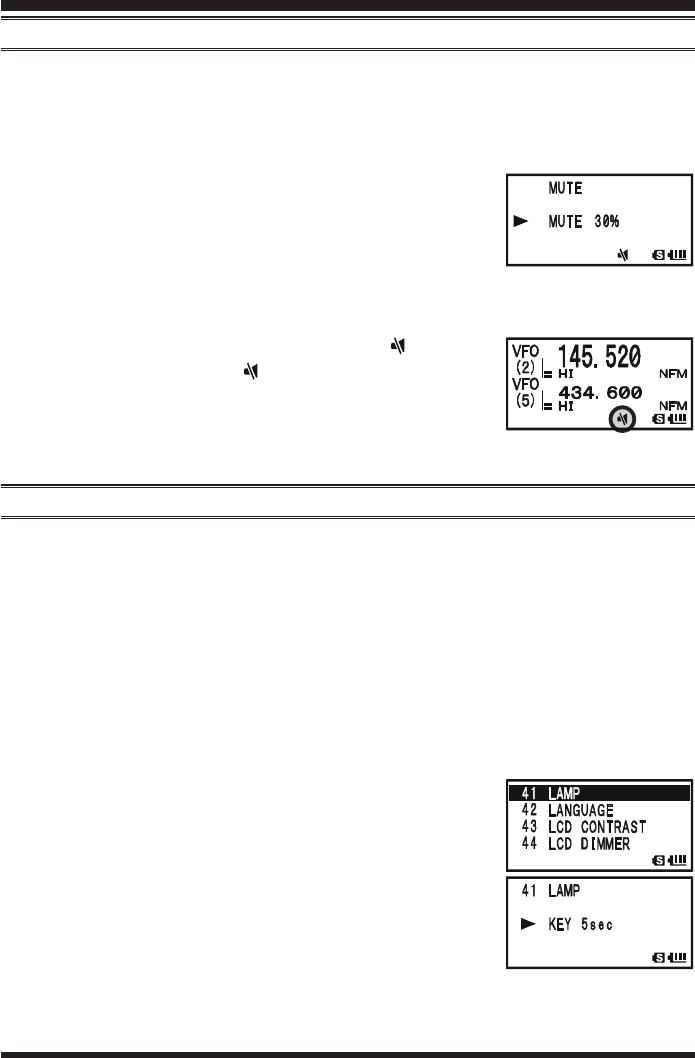
VX-8GR OPERATING MANUAL 23
ADVANCED OPERATION
AUDIO MUTING
The Audio Mute feature is useful in situations where it would be helpful to reduce the
audio level of the “Receive Only” band (Small character display) whenever you receive a
signal on the “Main” band (Large character display) during Dual Receive operation.
To activate the Audio Mute feature:
1. Press the f key, then press the 7 key. This provides a
“Short-cut” to Set Mode Item 57: MUTE57: MUTE
57: MUTE57: MUTE
57: MUTE.
2. Rotate the DIAL knob to select the desired muting level
(MUTE 30%MUTE 30%
MUTE 30%MUTE 30%
MUTE 30%, MUTE 50%MUTE 50%
MUTE 50%MUTE 50%
MUTE 50%, MUTE 100%MUTE 100%
MUTE 100%MUTE 100%
MUTE 100%, or OFFOFF
OFFOFF
OFF).
3. When you have made your choice, press the PTT switch to save the new setting and
return to normal operation.
When the Audio Mute feature is activated, the “ ” icon will
appear on the display, and the “ ” icon blinks while muting the
“Receive Only” band audio.
To cancel the Audio Mute feature, just repeat the above proce-
dures, selecting “OFFOFF
OFFOFF
OFF” in step 2 above.
KEYPAD/LCD ILLUMINATION
Your VX-8GR includes a reddish illumination lamp which aids in nighttime operation.
The red illumination yields clear viewing of the display in a dark environment, with mini-
mal degradation of your night vision. Three options for activating the lamp are provided:
KEY 2secKEY 2sec
KEY 2secKEY 2sec
KEY 2sec - KEY 10secKEY 10sec
KEY 10secKEY 10sec
KEY 10sec: Illuminates the Keypad/LCD for the selected illumination
time when any key is pressed.
CONTINUOUSCONTINUOUS
CONTINUOUSCONTINUOUS
CONTINUOUS: Illuminates the Keypad/LCD continuously.
OFFOFF
OFFOFF
OFF: Disables the Keypad/LCD lamp.
Here is the procedure for setting up the Lamp mode:
1. Press and hold the m key for one second to enter the Set Mode.
2. Rotate the DIAL knob to select Set Mode Item 41: LAMP41: LAMP
41: LAMP41: LAMP
41: LAMP.
3. Press the m key briefly to enable selection of this Set
Mode Item.
4. Rotate the DIAL knob to select one of the three modes de-
scribed above.
5. When you have made your choice, press the PTT switch to
save the new setting and return to normal operation.
FCC ID: K6620415X20 / IC:511B-20415X20
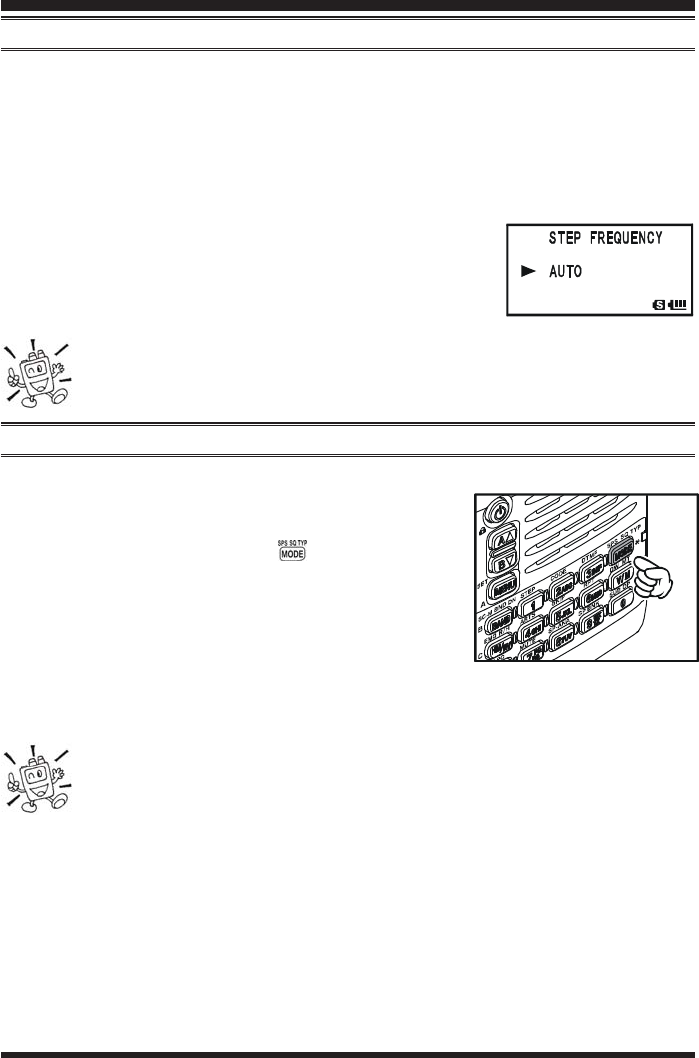
VX-8GR OPERATING MANUAL24
CHANGING THE CHANNEL STEPS
The VX-8GR’s frequency synthesizer provides the option of utilizing tuning steps of 5,
6.25, 8.33, 10, 12.5, 15, 20, 25, 50 and 100 kHz per step. The VX-8GR is set up at the
factory with different default steps for each operating band which are probably satisfactory
for most operation. However, if you need to change the channel step increments, the proce-
dure to do so is very easy.
1. Press the f key, then press the 1 key on the left side of the radio. This provides a
“Short-cut” to Set Mode Item 89: STEP FREQUENCY89: STEP FREQUENCY
89: STEP FREQUENCY89: STEP FREQUENCY
89: STEP FREQUENCY.
2. Rotate the DIAL knob to select the desired step size.
3. Press the PTT switch to save the new setting and return to
normal operation.
1) 8.33 kHz steps are available only when receiving on the Air band.
2) 5 kHz steps are not available for use on 250 - 300 MHz, nor above 580
MHz.
CHANGING THE RECEIVING MODE
The VX-8GR provides for automatic mode changing when the radio is tuned to different
operating frequencies. However, should an unusual receiv-
ing situation arise in which you need to change to a differ-
ent receiving mode, just press the key. The receiving
modes available are:
AUTOAUTO
AUTOAUTO
AUTO: The receive mode is automatically set accord-
ing to the default values for the selected fre-
quency range
NFMNFM
NFMNFM
NFM: Frequency Modulation
AMAM
AMAM
AM: Amplitude Modulation
Unless you have a compelling reason to do so, leave the Automatic Mode
Selection feature on in order to save time and trouble when changing bands.
If you make a mode change for a particular frequency or station, you can
always store that one channel into memory, as the mode setting will be memorized along
with the frequency information.
ADVANCED OPERATION
FCC ID: K6620415X20 / IC:511B-20415X20
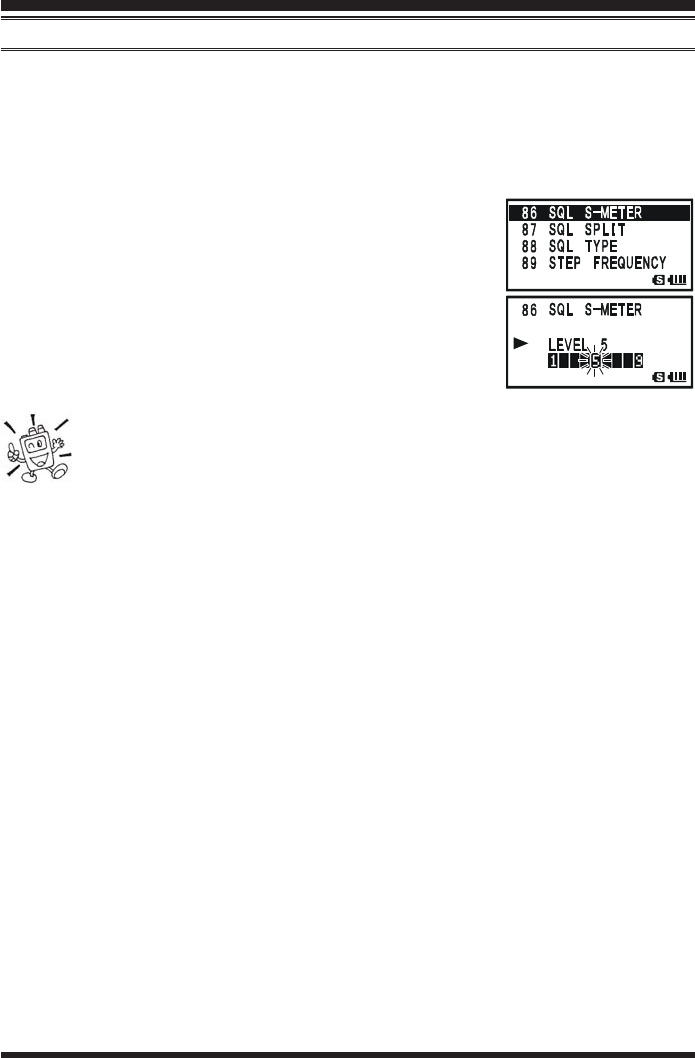
VX-8GR OPERATING MANUAL 25
ADVANCED OPERATION
SQL S-METER
A special SQL (Squelch) S-meter feature is provided on this radio. This feature allows
you to set the squelch so only signals exceeding a certain S-meter level will open the
squelch.
To set up the S-meter squelch feature for operation, use the following procedure:
1. Press and hold the m key for one second to enter the Set Mode.
2. Rotate the DIAL knob to select Set Mode Item 86: SQL S-86: SQL S-
86: SQL S-86: SQL S-
86: SQL S-
METERMETER
METERMETER
METER.
3. Press the m key briefly to enable selection of this Set
Mode Item.
4. Rotate the DIAL knob to select the desired signal strength
level for the squelch threshold (LEVEL1LEVEL1
LEVEL1LEVEL1
LEVEL1 - LEVEL9LEVEL9
LEVEL9LEVEL9
LEVEL9 or OFFOFF
OFFOFF
OFF).
5. When you have made your choice, press the PTT switch to
save the new setting and return to normal operation.
1) When the SQL S-meter is activated, the S-meter segment corresponding to
the squelch threshold which was set by step 4 above will blink.
2) The receiver’s squelch will open based on the higher of the levels set by the
Noise Squelch or the S-meter Squelch system.
For example:
a) If the Noise Squelch (SQL control) is set so that signals at a level of “S-3” will open
the squelch, but the SQL S-meter (Set Mode Item 93) is set to “LEVEL 5,” the squelch
will only open on signals which are “S5” or stronger on the S-meter.
b) If the SQL S-meter is set to “S3,” but the Noise Squelch is set to a high level which
will only pass signals which are Full Scale on the S-meter, the squelch will only open on
signals which are Full Scale on the S-meter. In this case, the Noise Squelch overrides
the action of the S-meter Squelch.
FCC ID: K6620415X20 / IC:511B-20415X20
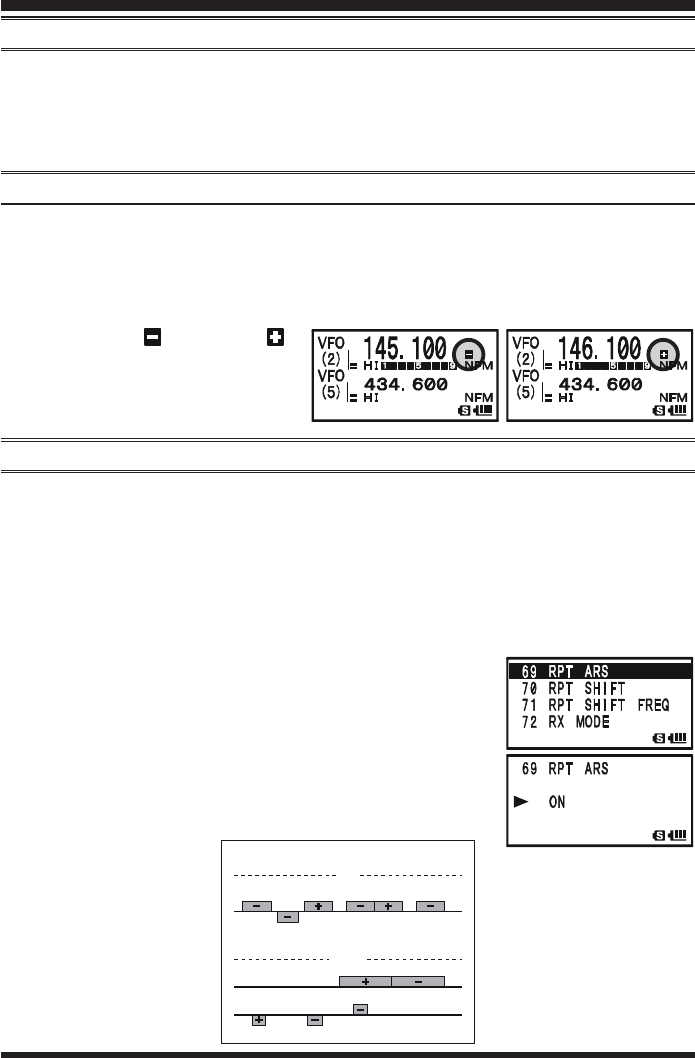
VX-8GR OPERATING MANUAL26
REPEATER OPERATION
GENERAL
Repeater stations, usually located on mountaintops or other high locations, provide a dra-
matic extension of the communication range for low-powered hand-held or mobile trans-
ceivers. The VX-8GR includes a number of features, which make repeater operation simple
and enjoyable.
REPEATER SHIFTS
Your VX-8DR has been configured, at the factory, for the repeater shifts customary in
your country. For the 144 MHz band, this usually will be 600 kHz, while the 430 MHz
shift will be 1.6 MHz, 7.6 MHz, or 5 MHz (USA version).
Depending on the part of the band in which you are operating, the repeater shift may be
either downward ( ) or upward ( ),
and one of these icons will appear at
the bottom of the LCD when repeater
shifts have been enabled.
AUTOMATIC REPEATER SHIFT (ARS)
The VX-8GR provides a convenient Automatic Repeater Shift feature, which causes the
appropriate repeater shift to be automatically applied whenever you tune into the desig-
nated repeater sub-bands in your country. These sub-bands are shown below.
If the ARS feature does not appear to be working, you may have accidentally disabled it.
To re-enable ARS:
1. Press and hold the m key for one second to enter the Set Mode.
2. Rotate the DIAL knob to select Set Mode Item 6969
6969
69: RPT ARS: RPT ARS
: RPT ARS: RPT ARS
: RPT ARS.
3. Press the m key briefly to enable selection of this Set
Mode Item.
4. Rotate the DIAL knob to select “ONON
ONON
ON”(to enable Automatic
Repeater Shift).
5. When you have made your choice, press the PTT switch to
save the new setting and return to normal operation.
European Version
Version A
2-m
145.1 145.5
145.6 145.8
146.0 146.4 147.0 147.6 148.0
146.6 147.4
Version A
70-cm
440.0 445.0 450.0
ARS-Repeater Subbands
Euro Version 1
Euro Version 2
439.45438.20
433.00 434.60433.40 435.00
FCC ID: K6620415X20 / IC:511B-20415X20
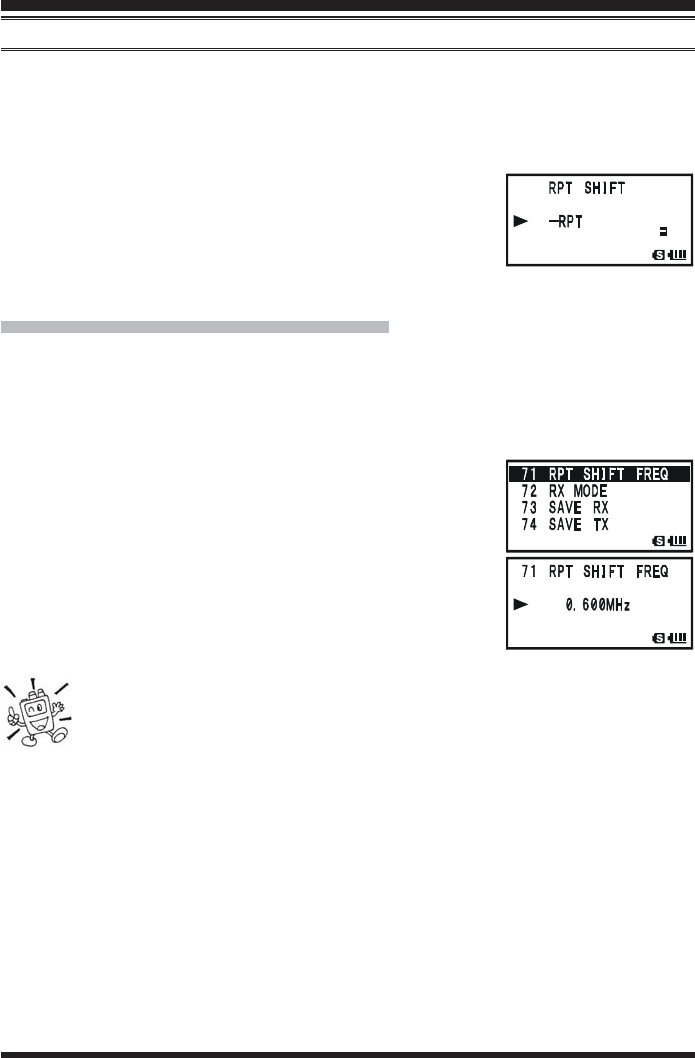
VX-8GR OPERATING MANUAL 27
MANUAL REPEATER SHIFT ACTIVATION
If the ARS feature has been disabled, or if you need to set a repeater shift direction other
than that established by the ARS, you may set the direction of the repeater shift manually.
To do this:
1. Press the f key, then press the 66
66
6 key. This provides a “Short-cut” to Set Mode
Item 70: RPT SHIFT70: RPT SHIFT
70: RPT SHIFT70: RPT SHIFT
70: RPT SHIFT.
2. Rotate the DIAL knob to select the desired shift among
“–RPT–RPT
–RPT–RPT
–RPT,” “+RPT+RPT
+RPT+RPT
+RPT,” and “SIMPLEXSIMPLEX
SIMPLEXSIMPLEX
SIMPLEX.”
3. Press the PTT switch to save the new setting and exit to
normal operation.
CHANGING THE DEFAULT REPEATER SHIFTS
If you travel to a different region, you may need to change the default repeater shift, to
ensure compatibility with local operating requirements.
To do this, follow the procedure below:
1. Press and hold the m key for one second to enter the Set Mode.
2. Rotate the DIAL knob to select Set Mode Item 71: RPT71: RPT
71: RPT71: RPT
71: RPT
SHIFT FREQSHIFT FREQ
SHIFT FREQSHIFT FREQ
SHIFT FREQ.
3. Press the m key briefly to enable selection of this Set
Mode Item.
4. Rotate the DIAL knob to select the new repeater shift mag-
nitude.
5. Press the PTT switch to save the new setting and return to
normal operation.
If you just have one “odd” split that you need to program, don’t change the
default repeater shift! Enter the transmit and receive frequencies separately,
as shown on page ??.
REPEATER OPERATION
FCC ID: K6620415X20 / IC:511B-20415X20

VX-8GR OPERATING MANUAL28
REPEATER OPERATION
CHECKING THE REPEATER UPLINK (INPUT) FREQUENCY
It often is helpful to be able to check the uplink (input) frequency of a repeater, to see if the
calling station is within direct (“Simplex”) range.
To do this, just press the h key. You’ll notice that the display has shifted to the repeater
uplink frequency. Press the h key again to cause operation to
return to normal monitoring of the repeater downlink (output)
frequency. While you are listening on the input frequency of the
repeater using the h key, the repeater offset icon (“ ” or ”)
will blink.
The configuration of h key may be set either to “RV” (for checking the
input frequency of a repeater, or “HM” (for instant switching to the “Home”
channel for the band you are operating on). To change the configuration of
h key, use Set Mode Item 34: HOME/REVERSE. See page xx.
FCC ID: K6620415X20 / IC:511B-20415X20
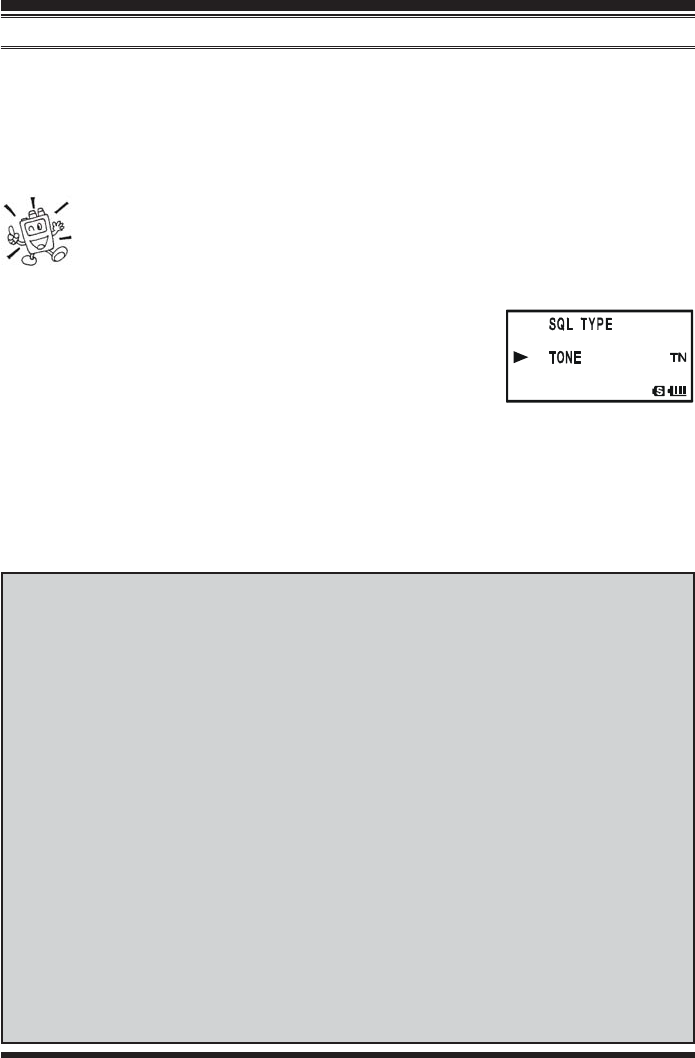
VX-8GR OPERATING MANUAL 29
CTCSS OPERATION
Many repeater systems require that a very-low-frequency audio tone be superimposed on
your FM carrier in order to activate the repeater. This helps prevent false activation of the
repeater by radar or spurious signals from other transmitters. This tone system, called
“CTCSS” (Continuous Tone Coded Squelch System), is included in your VX-8GR, and is
very easy to activate.
CTCSS setup involves two actions: setting the Tone Frequency and then set-
ting the Tone Mode. These functions are set up using Set Mode Items 88:
SQL TYP and 91: TONE FREQUENCY.
1. Press the f key, then press the M key. This provides a “Short-cut” to Set Mode
Item 88: SQL TYPE88: SQL TYPE
88: SQL TYPE88: SQL TYPE
88: SQL TYPE.
2. Rotate the DIAL knob so that “TONETONE
TONETONE
TONE” appears on the dis-
play. This activates the CTCSS Encoder.
3. Rotation of the DIAL knob one more “click” in step “2”
above will also activate the “TSQTSQ
TSQTSQ
TSQ” decode function. When “TSQTSQ
TSQTSQ
TSQ” is displayed, the
Tone Squelch system is active, which mutes your VX-8GR’s receiver until it receives
a call from another radio sending out a matching CTCSS tone. This can helpful in a
high RF congested location by keeping your radio quiet until a call is received from a
specific station with a matching CTCSS tone.
CTCSS/DCS/EPCS OPERATION
You may notice an additional “DCSDCS
DCSDCS
DCS” indication appearing while you rotate
the DIAL knob in step 3 above. We’ll discuss the Digital Code Squelch sys-
tem shortly.
You may notice “REV TONEREV TONE
REV TONEREV TONE
REV TONE” indication on the display while you rotate the
DIAL knob in step 3 above. When the Reverse Tone Squelch system is ac-
tive, the VX-8GR’s receiver is muted when it receives a call from a radio
sending a matching CTCSS tone. The “RTNRTN
RTNRTN
RTN” icon will appear on the display
when the Reverse Tone Squelch system is activated.
You may notice “PR FREQPR FREQ
PR FREQPR FREQ
PR FREQ” indication on the display while you rotate the
DIAL knob in step 3 above, this means the user programmed Reverse CTCSS
Decoder will mute your VX-8GR’s receiver when it receives a call from a
radio sending a CTCSS tone matching your programmed tone (determine by
Set Mode Item 65: PR FREQUENCY65: PR FREQUENCY
65: PR FREQUENCY65: PR FREQUENCY
65: PR FREQUENCY). The “PRPR
PRPR
PR” icon will appear on the
display when the Reverse CTCSS Decoder is activated.
You may notice “PAGERPAGER
PAGERPAGER
PAGER” and “MESSAGEMESSAGE
MESSAGEMESSAGE
MESSAGE” indication on the display while
you rotate the DIAL knob in step 3 above. These appear when the “Enhanced
Paging & Code Squelch” and the “Message Feature” are activated. We’ll
discuss these functions later.
FCC ID: K6620415X20 / IC:511B-20415X20
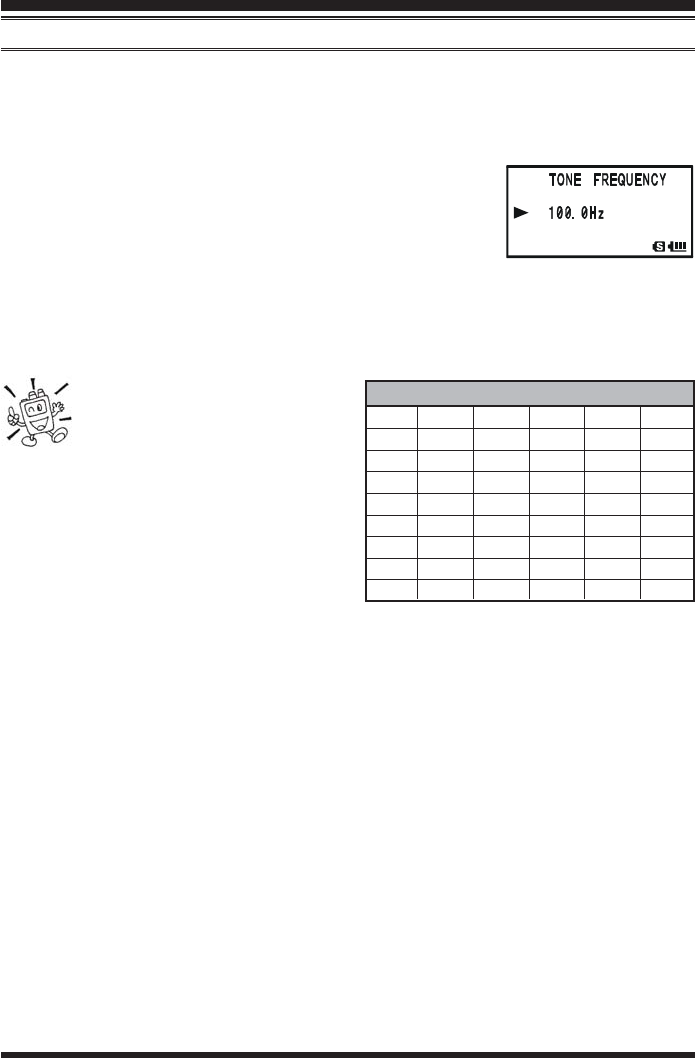
VX-8GR OPERATING MANUAL30
4. When you have made your selection of the CTCSS tone mode, press the M key to
save the new setting and exit to normal operation.
5. Press the f key, then press the 2 key. This provides a “Short-cut” to Set Mode
Item 91: TONE FREQUENCY91: TONE FREQUENCY
91: TONE FREQUENCY91: TONE FREQUENCY
91: TONE FREQUENCY.
6. Rotate the DIAL knob until the display indicates the fre-
quency of the CTCSS tone that you need to send on your
transmission (ask the repeater owner/operator if you don’t
know the tone frequency).
7. When you have made your selection, press the 2 key briefly to save the new setting
and exit to normal operation. This is different from the usual method of restoring
normal operation, and it applies only to the configuration of the CTCSS/DCS fre-
quencies.
1) The repeater may or may not
re-transmit a CTCSS tone - some
systems just use CTCSS to control
access to the repeater, but do not pass it along
when transmitting. If the S-Meter deflects,
but you cannot hear the audio, repeat steps
“1” through “4” above, but rotate the DIAL
so that “TSQ” disappears - this will allow
you to hear all traffic on the channel being
received.
2) During CTCSS operation, you may set up the VX-8GR so a ringing “bell” sound
alerts you to an incoming call. See page xx for details.
CTCSS/DCS/EPCS OPERATION
CTCSS TONE FREQUENCY (Hz)
67.0 69.3 71.9 74.4 77.0 79.7
82.5 85.4 88.5 91.5 94.8 97.4
100.0 103.5 107.2 110.9 114.8 118.8
123.0 127.3 131.8 136.5 141.3 146.2
151.4 156.7 159.8 162.2 165.5 167.9
171.3 173.8 177.3 179.9 183.5 186.2
189.9 192.8 196.6 199.5 203.5 206.5
210.7 218.1 225.7 229.1 233.6 241.8
250.3 254.1 – – – –
CTCSS OPERATION
FCC ID: K6620415X20 / IC:511B-20415X20
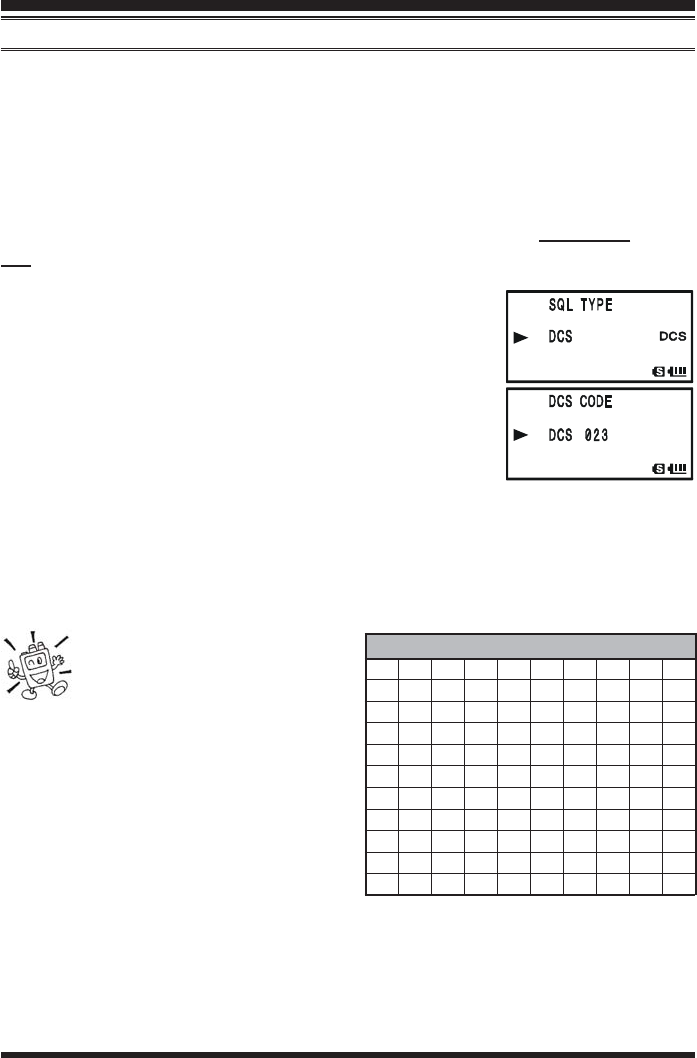
VX-8GR OPERATING MANUAL 31
DCS OPERATION
Another form of tone access control is Digital Code Squelch, or DCS. It is a newer, more
advanced tone system which generally provides more immunity from false paging than
does CTCSS. The DCS Encoder/Decoder is built into your VX-8GR, and operation is
very similar to that just described for CTCSS. Your repeater system may be configured for
DCS. The DCS Squelch may be quite useful in Simplex operation if your friends use
transceivers equipped with this advanced feature.
Note: Just as in CTCSS operation, DCS requires that you set the Tone Mode to DCS
and that you select a DCS code.
1. Press the f key, then press the M key. This provides a
“Short-cut” to Set Mode Item 88: SQL TYPE88: SQL TYPE
88: SQL TYPE88: SQL TYPE
88: SQL TYPE.
2. Rotate the DIAL knob until “DCSDCS
DCSDCS
DCS” appears on the display;
this activates the DCS Encoder/Decoder.
3. Press the M key to save the new setting and exit to nor-
mal operation.
4. Press the f key, then press the 2 key. This provides a
“Short-cut” to Set Mode Item 21: DCS CODE21: DCS CODE
21: DCS CODE21: DCS CODE
21: DCS CODE.
5. Rotate the DIAL knob to select the desired DCS Code (a three-digit number). Ask the
repeater owner/operator if you don’t know DCS Code; if you are working simplex,
just set up the DCS Code to be the same as that used by your friends.
6. When you have made your selection, press the 2 key to save the new settings and
exit to normal operation.
Remember that the DCS is an
Encode/Decode system, so your
receiver will remain muted until
a matching DCS code is received on an in-
coming transmission. Switch the DCS off
when you’re just tuning around the band!
CTCSS/DCS/EPCS OPERATION
DCS CODE
023 025 026 031 032 036 043 047 051 053
054 065 071 072 073 074 114 115 116 122
125 131 132 134 143 145 152 155 156 162
165 172 174 205 212 223 225 226 243 244
245 246 251 252 255 261 263 265 266 271
274 306 311 315 325 331 332 343 346 351
356 364 365 371 411 412 413 423 431 432
445 446 452 454 455 462 464 465 466 503
506 516 523 526 532 546 565 606 612 624
627 631 632 654 662 664 703 712 723 731
732734743754––––––
FCC ID: K6620415X20 / IC:511B-20415X20
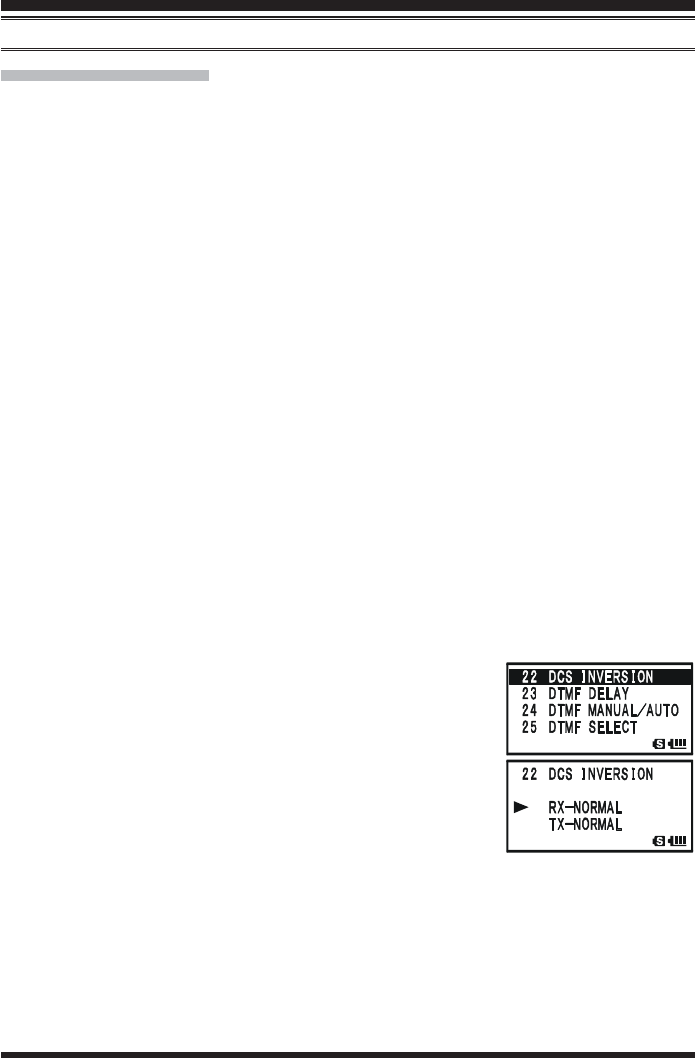
VX-8GR OPERATING MANUAL32
DCS CODE INVERSION
The DCS system was first introduced in the commercial LMR (Land Mobile Radio) ser-
vice, where it is now in widespread use. DCS is sometime referred to by its different
proprietary names, such as DPL® (Digital Private Line®, a registered trademark of Motorola,
Inc.).
DCS uses a codeword consisting of a 23-bit frame, transmitted (sub audible) at a data rate
of 134.4 bps (bit/sec). Occasionally, signal inversion can result in the complement of a
code being sent or received. This prevents the receiver’s squelch from opening with DCS
enabled, as the decoded bit sequence would not match that selected for operation.
Typical situations that might cause inversion to occur are:
Connection of an external receiver preamplifier.
Operating through a repeater.
Connection of an external linear amplifier.
Note that code inversion does not mean that any of the above listed equipment is defective!
In certain amplifier configurations, the output signal (phase) is inverted from the input. Small
signal or power amplifiers having an odd number (1, 3, 5, etc.) of amplification stages may
result in inversion of a transmitted or received DCS code. While under most circumstances
this should not occur (amplifier designs and industry standards take this into account), if you
find that your receiver squelch does not open when both you and the other station are using a
common DCS code, you or the other station (but not both) can try the following:
1. Press and hold the m key for one second to enter the Set Mode.
2. Rotate the DIAL knob to select Set Mode Item 22: DCS22: DCS
22: DCS22: DCS
22: DCS
INVERSIONINVERSION
INVERSIONINVERSION
INVERSION.
3. Press the m key briefly to enable adjustment of this Set
Mode Item.
4. Rotate the DIAL knob to select one of the following modes:
RX-NORMAL, TX-NORMALRX-NORMAL, TX-NORMAL
RX-NORMAL, TX-NORMALRX-NORMAL, TX-NORMAL
RX-NORMAL, TX-NORMAL:
Receive and transmit the Normal DCS Tone.
RX-INVERT, TX-NORMALRX-INVERT, TX-NORMAL
RX-INVERT, TX-NORMALRX-INVERT, TX-NORMAL
RX-INVERT, TX-NORMAL:
Receive the Inverted DCS Tone and transmit the Normal DCS Tone.
RX-BOTH, TX-NORMALRX-BOTH, TX-NORMAL
RX-BOTH, TX-NORMALRX-BOTH, TX-NORMAL
RX-BOTH, TX-NORMAL:
Receive both Normal and Inverted DCS Tones and transmit the Normal DCS
Tone.
RX-NORMAL, TX-INVERTRX-NORMAL, TX-INVERT
RX-NORMAL, TX-INVERTRX-NORMAL, TX-INVERT
RX-NORMAL, TX-INVERT:
Receive the Normal DCS Tone and transmit the Inverted DCS Tone.
CTCSS/DCS/EPCS OPERATION
DCS OPERATION
FCC ID: K6620415X20 / IC:511B-20415X20

VX-8GR OPERATING MANUAL 33
RX-INVERT, TX-INVERTRX-INVERT, TX-INVERT
RX-INVERT, TX-INVERTRX-INVERT, TX-INVERT
RX-INVERT, TX-INVERT:
Receive and transmit the Inverted DCS Tone.
RX-BOTH, TX-INVERTRX-BOTH, TX-INVERT
RX-BOTH, TX-INVERTRX-BOTH, TX-INVERT
RX-BOTH, TX-INVERT:
Receive both Normal and Inverted DCS Tones and transmit the Inverted DCS
Tone.
5. When you have made your selection, press the PTT switch, to save the new settings
and exit to normal operation.
This is different from the usual method of restoring normal operation, and it applies only
to the configuration of the CTCSS/DCS frequencies. Remember to restore the default
setting “RX-NORMAL, TX-NORMALRX-NORMAL, TX-NORMAL
RX-NORMAL, TX-NORMALRX-NORMAL, TX-NORMAL
RX-NORMAL, TX-NORMAL” (Receive and transmit the Normal DCS Tone) when
done.
CTCSS/DCS/EPCS OPERATION
DCS OPERATION
FCC ID: K6620415X20 / IC:511B-20415X20
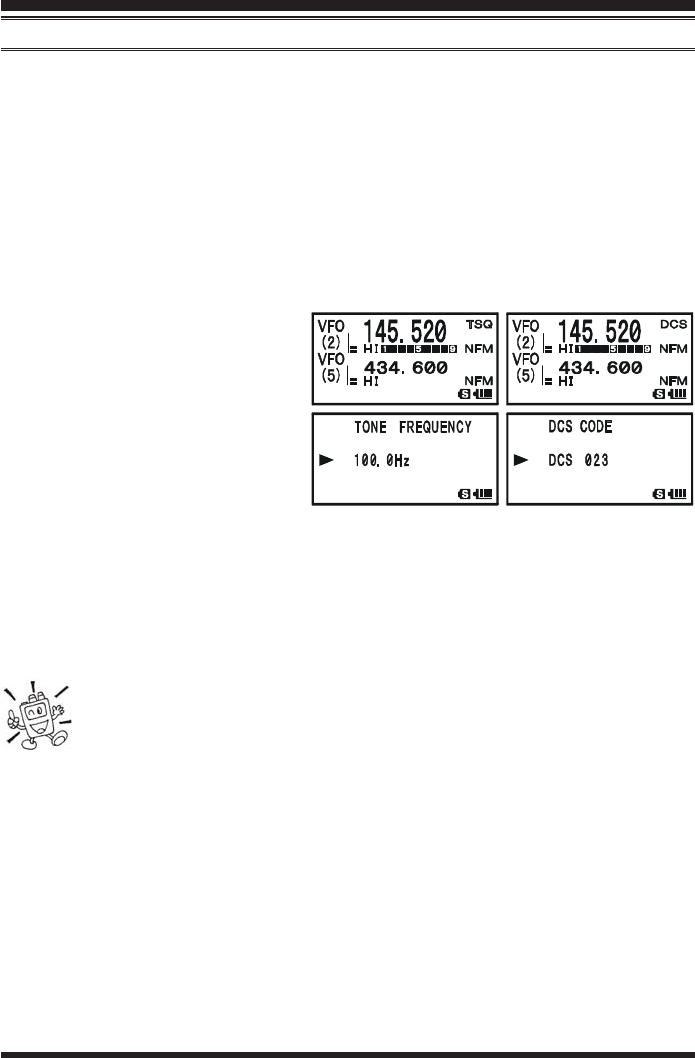
VX-8GR OPERATING MANUAL34
TONE SEARCH SCANNING
In operating situations where you don’t know the CTCSS or DCS tone being used by
another station, you can command the radio to listen to the incoming signal and scan in
search of the tone being used. Two things must be remembered in this regard:
You must be sure that your repeater uses the same tone type (CTCSS vs. DCS).
Some repeaters do not pass the CTCSS tone; you may have to listen to the station
transmitting on the repeater uplink (input) frequency in order to allow Tone Search
Scanning to work.
To scan for the tone in use:
1. Set the radio up for either CTCSS or DCS Decoder operation (see the previous dis-
cussion). In the case of CTCSS,
“TSQTSQ
TSQTSQ
TSQ” will appear on the display;
in the case of DCS, “DCSDCS
DCSDCS
DCS” will
appear on the display.
2. Press the f key, then press the
2 key to recall the Set Mode
Item 91: TONE FREQUENCY91: TONE FREQUENCY
91: TONE FREQUENCY91: TONE FREQUENCY
91: TONE FREQUENCY
when CTCSS is selected, or Menu
Item 21: DCS CODE21: DCS CODE
21: DCS CODE21: DCS CODE
21: DCS CODE during DCS operation.
3. Press and hold in the B key, the “TONE SEARCHTONE SEARCH
TONE SEARCHTONE SEARCH
TONE SEARCH” notation will appear, release
the B key to start scanning for the incoming CTCSS or DCS tone/code.
4. When the radio detects the correct tone or code, it will halt on that tone/code, and
audio will be allowed to pass. Press the B key to lock in that tone/code, then press
the 2 key to exit to normal operation.
If the Tone Scan feature does not detect a tone or code, it will continue to
scan indefinitely. When this happens, it may be that the other station is not
sending any tone. You can press the PTT switch to halt the scan at any time.
You can also press the e key during Tone Scanning to listen to the (muted) signal from
the other station. When you release the e key, Tone Scanning will resume after about a
second.
Tone Scanning works either in the VFO or Memory modes.
CTCSS/DCS/EPCS OPERATION
FCC ID: K6620415X20 / IC:511B-20415X20
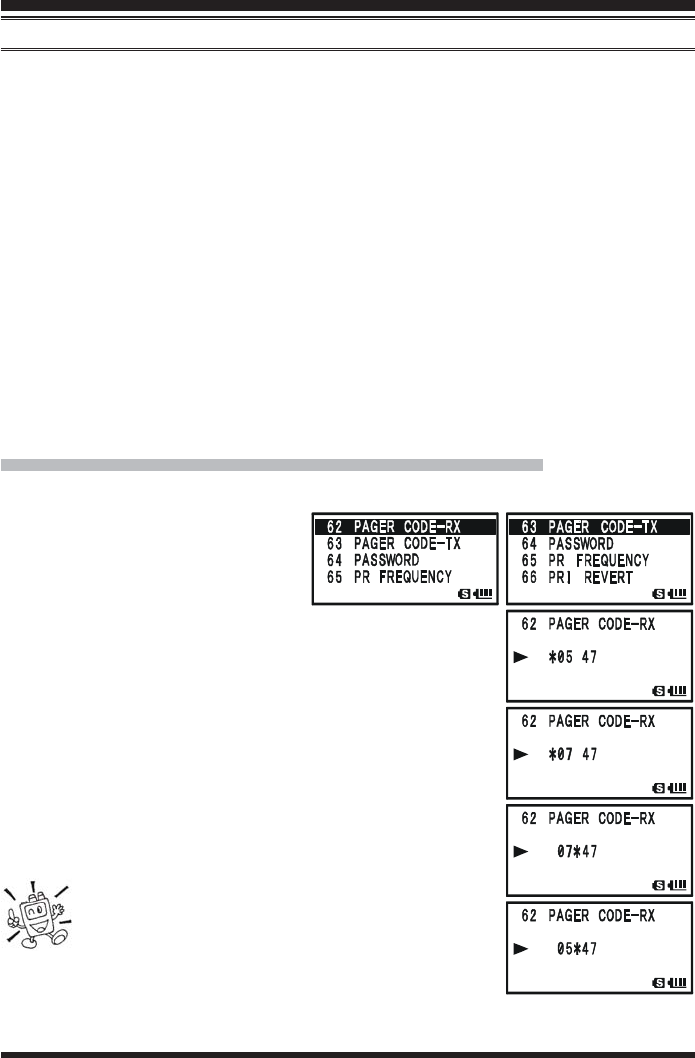
VX-8GR OPERATING MANUAL 35
CTCSS/DCS/EPCS OPERATION
EPCS (ENHANCED PAGING & CODE SQUELCH)
The VX-8GR includes an Enhanced CTCSS tone encoder/decoder and a dedicated micro-
processor providing paging and selective calling features. This allows you to place a call
to a specific station (Paging), and to receive calls of your choice directed only to you
(Code Squelch).
The paging and code squelch systems use two pairs of (alternately switched) CTCSS
tones which are stored in the pager memories. Basically, your receiver remains silent until
it receives the CTCSS tone pair that matches those stored in the Receiving Pager Memory.
The squelch then opens so the caller is heard, and the paging ringer immediately sounds,
if activated. When you close the PTT switch to transmit, the CTCSS tone pair that is
stored in the Transmitting Pager Memory will be transmitted automatically.
On the paged radio, the Code Squelch will close automatically after the incoming page
ends. Meanwhile, on the paging radio, the Enhanced Paging and Code Squelch system
will be disabled after the PTT switch is released after the paging transmission. You may
re-activate the Enhanced Paging and Code Squelch system again.
STORING THE CTCSS TONE PAIRS FOR EPCS OPERATION
1. Press and hold the m key for one second to enter the Set Mode.
2. Rotate the DIAL knob to select Set
Mode Item 62: PAGER CODE-RX62: PAGER CODE-RX
62: PAGER CODE-RX62: PAGER CODE-RX
62: PAGER CODE-RX
for the Receiving CTCSS Tone
Pair or Set Mode Item 63: PAGER63: PAGER
63: PAGER63: PAGER
63: PAGER
CODE-TXCODE-TX
CODE-TXCODE-TX
CODE-TX for the Transmitting CTCSS Tone Pair.
3. Press the mm
mm
m key briefly to enable adjustment of this Set
Mode Item.
4. Rotate the DIAL knob to set the CTCSS Tone number which
corresponds to the first tone of the CTCSS Tone Pair.
5. Press the M key (“” icon moves to the right), then
rotate the DIAL knob to set the CTCSS Tone number, which
corresponds to the second tone of the CTCSS Tone Pair.
6. Press the PTT switch to save the new setting and exit to
normal operation.
The VX-8GR does not recognize the order of the
1st tone and the 2nd tone. In other words, for ex-
ample, the VX-8GR considers both CTCSS pairs
“10, 35” and “35, 10” to be identical.
FCC ID: K6620415X20 / IC:511B-20415X20
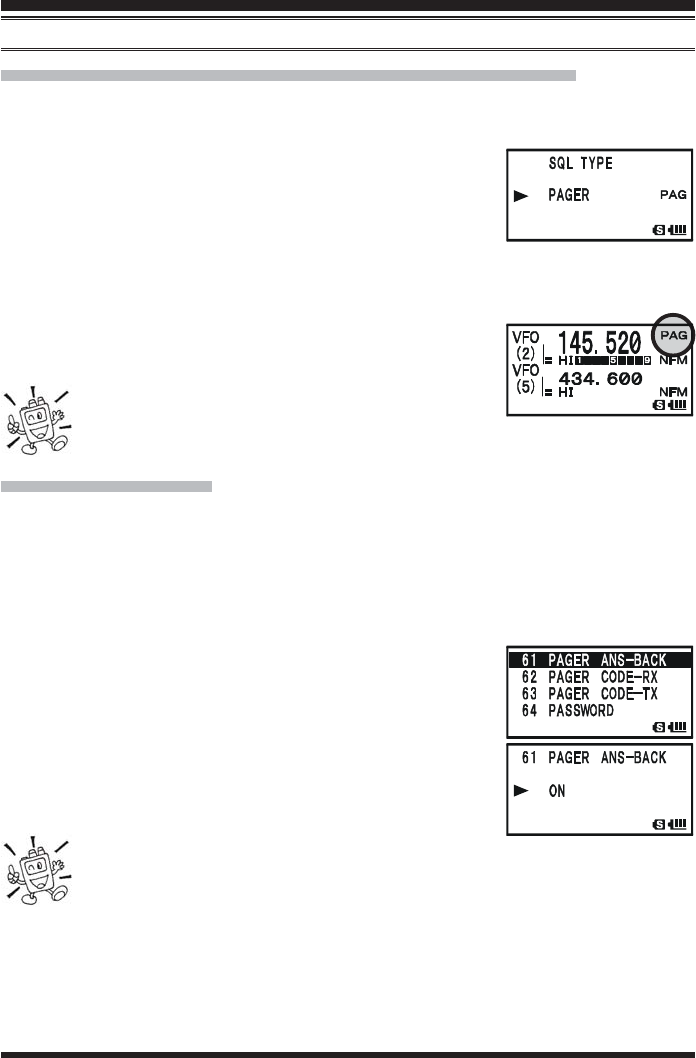
VX-8GR OPERATING MANUAL36
CTCSS/DCS/EPCS OPERATION
ACTIVATING THE ENHANCED PAGING & CODE SQUELCH SYSTEM
1. Press the f key, then press the M key. This provides a “Short-cut” to Set Mode
Item 88: SQL TYPE88: SQL TYPE
88: SQL TYPE88: SQL TYPE
88: SQL TYPE.
2. Rotate the DIAL knob until “PAGERPAGER
PAGERPAGER
PAGER” appears on the dis-
play; this activates the Enhanced Paging & Code Squelch.
3. Press the PTT switch to save the new setting and activate
the Enhanced Paging & Code Squelch.
To disable the Enhanced Paging & Code Squelch, just repeat the above procedure, rotate
the DIAL knob to select “OFFOFF
OFFOFF
OFF” in step 2 above.
When the Enhanced Paging & Code Squelch feature is acti-
vated, the “PAGPAG
PAGPAG
PAG” notation will appear on the display.
During Enhanced Paging & Code Squelch opera-
tion, you may set up the VX-8GR so that a ringing
“bell” sound alerts you when a call is coming in. See next page for details.
PAGING ANSWER BACK
When you press the PTT switch to respond to a page call, the VX-8GR transmits the same
CTCSS tone pair. This tone pair will open the Code Squelch of the calling station. If you
prefer, you can have the VX-8GR respond to page calls automatically (“transpond”). To
enable this feature:
1. Press and hold the m key for one second to enter the Set Mode.
2. Rotate the DIAL knob to select Set Mode Item 61: PAGER61: PAGER
61: PAGER61: PAGER
61: PAGER
ANS-BACKANS-BACK
ANS-BACKANS-BACK
ANS-BACK.
3. Press the m key briefly to enable adjustment of this Set
Mode Item.
4. Rotate the DIAL knob to select “ONON
ONON
ON”.
5. Press the PTT switch to save the new setting and exit to
normal operation.
The Paging Answer Back feature constitutes a form
of “remote control” operation that may be restricted to certain frequencies.
U.S. users should confirm the current status of §97.201(b) of the FCC’s rules
governing the Amateur service before utilizing this feature on the 144 MHz band.
EPCS (ENHANCED PAGING & CODE SQUELCH)
FCC ID: K6620415X20 / IC:511B-20415X20
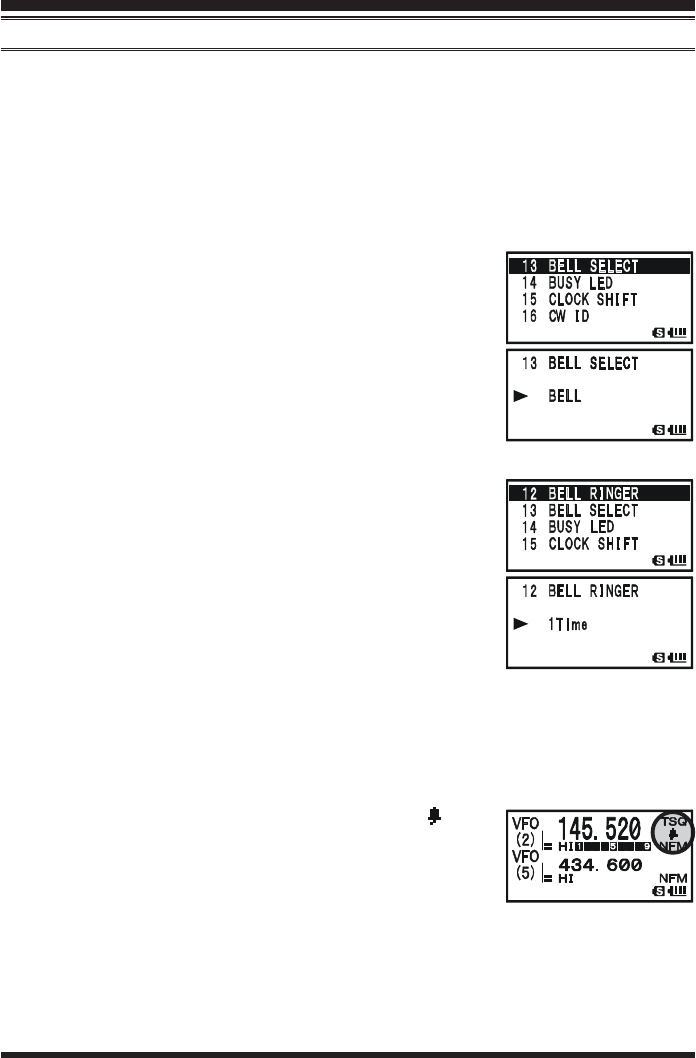
VX-8GR OPERATING MANUAL 37
CTCSS/DCS/EPCS BELL OPERATION
During CTCSS Decode, DCS, or EPCS operation, you may set up the VX-8GR so that a
ringing “bell” sound alerts you that a call is coming in. Here is the procedure for activating
the CTCSS/DCS/EPCS Bell:
1. Set the operating frequency to the desired channel.
2. Set the transceiver up for CTCSS Decode (“Tone Squelch”), DCS, or EPCS opera-
tion, as described previously.
3. Press and hold the m key for one second to enter the Set Mode.
4. Rotate the DIAL knob to select Set Mode Item 13: BELL13: BELL
13: BELL13: BELL
13: BELL
SELECTSELECT
SELECTSELECT
SELECT.
5. Press the m key briefly to enable adjustment of this Set
Mode Item.
6. Rotate the DIAL knob to set the desired “bell” sound. The
available choices are BELLBELL
BELLBELL
BELL, USER BP1USER BP1
USER BP1USER BP1
USER BP1, USER BP2USER BP2
USER BP2USER BP2
USER BP2, USERUSER
USERUSER
USER
BP3BP3
BP3BP3
BP3, or OFFOFF
OFFOFF
OFF (disable the Bell function).
Note: When User Beep (described later) does not register,
USER BP1USER BP1
USER BP1USER BP1
USER BP1, USER BP2USER BP2
USER BP2USER BP2
USER BP2, or USER BP3USER BP3
USER BP3USER BP3
USER BP3 does not appear.
7. Press the m key briefly, then rotate the DIAL knob one
click counter-clockwise to select Set Mode Item 12: BELL12: BELL
12: BELL12: BELL
12: BELL
RINGERRINGER
RINGER
RINGER
RINGER.
8. Press the m key briefly to enable adjustment of this Menu
Item.
9. Rotate the DIAL knob to set the desired number of rings of
the Bell. The available choices are 1Time1Time
1Time1Time
1Time through 20Times20Times
20Times20Times
20Times
or CONTINUOUSCONTINUOUS
CONTINUOUSCONTINUOUS
CONTINUOUS.
10. Press the PTT switch briefly to save the new setting and exit to normal operation.
When you are called by a station whose transceiver is sending a CTCSS tone, DCS code,
or CTCSS tone pair which matches that set into your Decoder, the Bell will ring in accor-
dance with this programming.
When the CTCSS/DCS/EPCS Bell is activated, the “ ” icon
will appear in the display.
To disable the CTCSS/DCS/EPCS Bell function, select the set-
ting of Set Mode Item 11: BELL SELECT11: BELL SELECT
11: BELL SELECT11: BELL SELECT
11: BELL SELECT to “OFFOFF
OFFOFF
OFF”.
CTCSS/DCS/EPCS OPERATION
FCC ID: K6620415X20 / IC:511B-20415X20
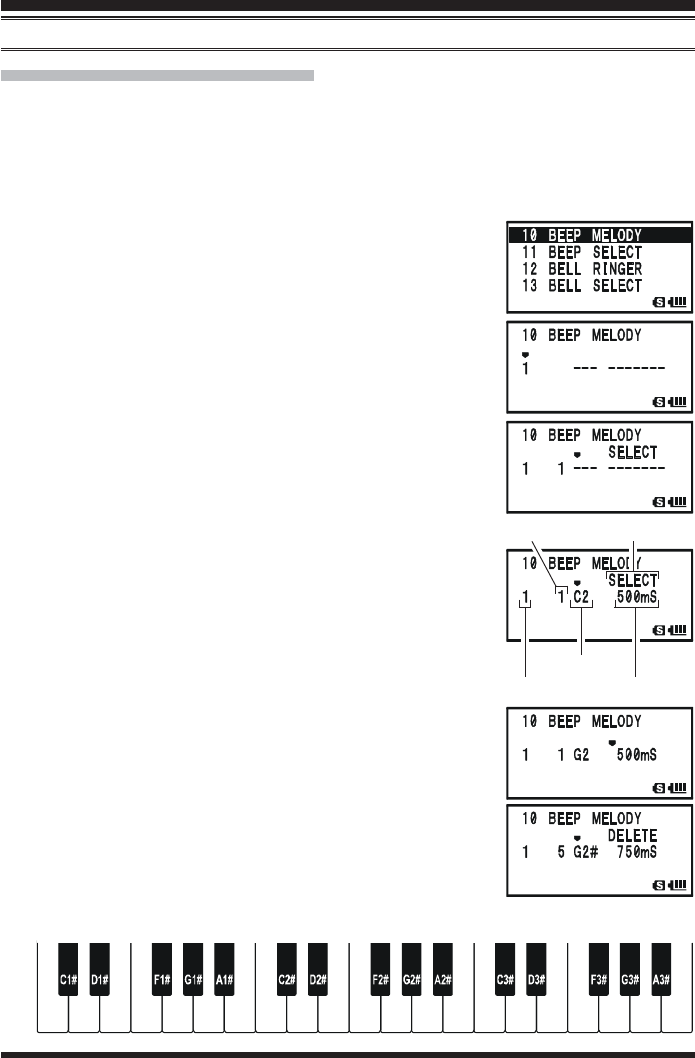
VX-8GR OPERATING MANUAL38
CTCSS/DCS/EPCS OPERATION
PROGRAMMING THE USER MELODY
Three User Beep Memories are provided, allowing you to create unique original beep
tone melodies.
Each User Beep Memory can store up to 64 steps with three octaves (“C1C1
C1C1
C1” through “B3B3
B3B3
B3”).
1. Press and hold the m key for one second to enter the Set Mode.
2. Rotate the DIAL knob to select Set Mode Item 10: BEEP10: BEEP
10: BEEP10: BEEP
10: BEEP
MELODYMELODY
MELODYMELODY
MELODY.
3. Press the m key briefly to enable adjustment of this Set
Mode Item.
4. Rotate the DIAL knob to select the memory slot into which
you wish to store your programmed beep melody. Avail-
able selections are 11
11
1, 22
22
2, and 33
33
3. The previously stored beep
melody will be displayed.
5. Press the M key to enable programming the beep melody.
Press and hold the h key for one second to clear any
previous beep melody, if desired.
6. Rotate the DIAL knob to select the first beep tone of the
User Beep Melody. Available selections are C1C1
C1C1
C1 - B3B3
B3B3
B3, and
POSPOS
POSPOS
POS (rest).
7. Press the M key, then rotate the DIAL knob to set the
length of the first beep tone. Available selections are 10ms10ms
10ms10ms
10ms
(10 msec) - 2500ms2500ms
2500ms2500ms
2500ms (2.5 sec).
8. Press the M key to accept the first beep tone of the User
Beep Melody.
9. If you make a mistake, press the B key to back-space
the cursor, then re-enter the correct beep tone or length.
10. Repeat steps 6 - 9 until you have completed the User Beep
Melody.
11. When there is a beep tone, which you wish to delete, bring
the cursor to that beep tone using the B/M key, then
press the c key repeatedly until the “SELECTSELECT
SELECTSELECT
SELECT” notation
in the “Operation Mode” slot turns into “DELETEDELETE
DELETEDELETE
DELETE”. Now,
press and hold in the c key for one second to delete that beep tone.
CTCSS/DCS/EPCS BELL OPERATION
C2C1 C3D2D1 D3E2E1 E3F2F1 F3G2G1 G3A2A1 A3B2B1 B3
Step Operation Mode
Memory Slot Tone Length
Beep Tone
FCC ID: K6620415X20 / IC:511B-20415X20
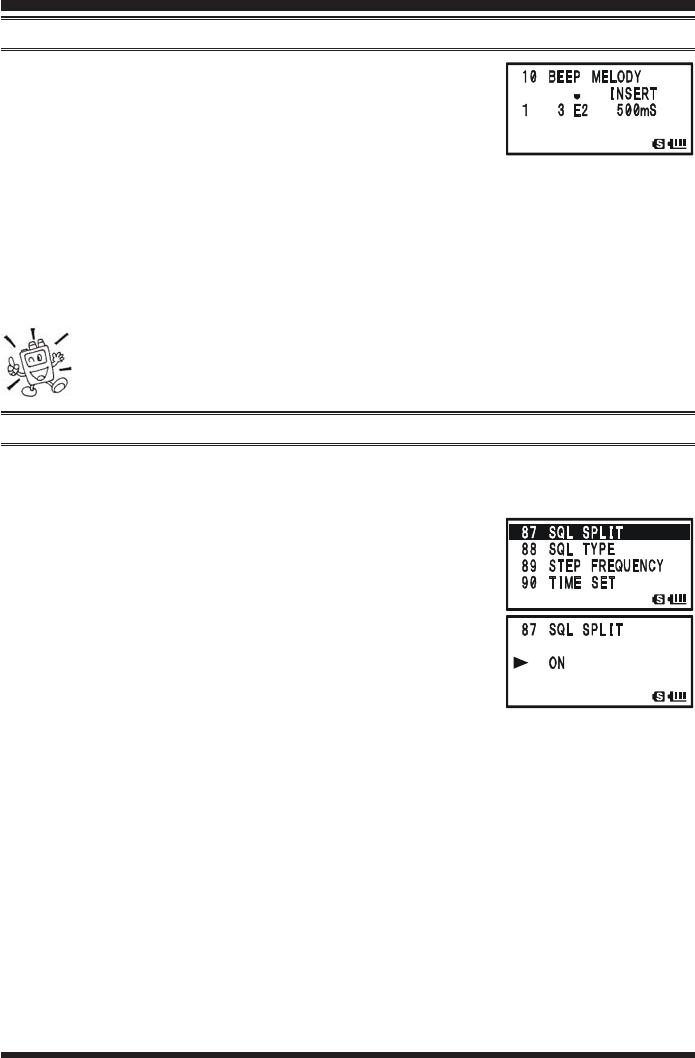
VX-8GR OPERATING MANUAL 39
12. When you wish to add a beep tone into the beep melody
strings, move the cursor to the place where you wish to en-
ter the beep tone using the B/M key, then press the
c key repeatedly until the “SELECTSELECT
SELECTSELECT
SELECT” notation in the “Op-
eration Mode” slot turns into “INSERTINSERT
INSERTINSERT
INSERT”. Now, press and hold in the c key for one
second to add the new beep tone (Tone: “C2”, Tone Length: “500mS”).
13. Press and hold the h key for one second to delete all data after the current position
that may have previously been stored in the User Beep Melody.
14. When you have programmed User Beep Melody, press the PTT switch briefly to save
the new setting and exit to normal operation.
You may check your work by monitoring the programmed User Beep Melody.
To do this, repeat steps 1 - 4 above, then press the f key.
SPLIT TONE OPERATION
The VX-8GR can be operated in a Split Tone configuration via the Set mode.
1. Press and hold the m key for one second to enter the Set Mode.
2. Rotate the DIAL knob to select Set Mode Item 87: SQL87: SQL
87: SQL87: SQL
87: SQL
SPLITSPLIT
SPLITSPLIT
SPLIT.
3. Press the m key briefly to enable adjustment of this Set
Mode Item.
4. Rotate the DIAL knob to select “ONON
ONON
ON” (to enable the Split
Tone feature).
5. Press the PTT switch briefly to save the new setting and
exit to normal operation.
When the Split Tone feature is activated, you can see the following additional parameters
after the “MESSAGEMESSAGE
MESSAGEMESSAGE
MESSAGE” parameter while selecting the Set Mode Item 88: SQL TYPE88: SQL TYPE
88: SQL TYPE88: SQL TYPE
88: SQL TYPE:
D CDD CD
D CDD CD
D CD: DCS Encode only (“DCDC
DCDC
DC” icon will appear while operating)
TONE-DCSTONE-DCS
TONE-DCSTONE-DCS
TONE-DCS: Encodes a CTCSS Tone and Decodes a DCS code
(the “T-DT-D
T-DT-D
T-D” icon will appear during operation)
D CD-TONE SQLD CD-TONE SQL
D CD-TONE SQLD CD-TONE SQL
D CD-TONE SQL: Encodes a DCS code and Decodes a CTCSS Tone
(the “D-TD-T
D-TD-T
D-T” icon will appear during operation)
Select the desired operating mode from the selections shown above.
CTCSS/DCS/EPCS OPERATION
CTCSS/DCS/EPCS BELL OPERATION
FCC ID: K6620415X20 / IC:511B-20415X20
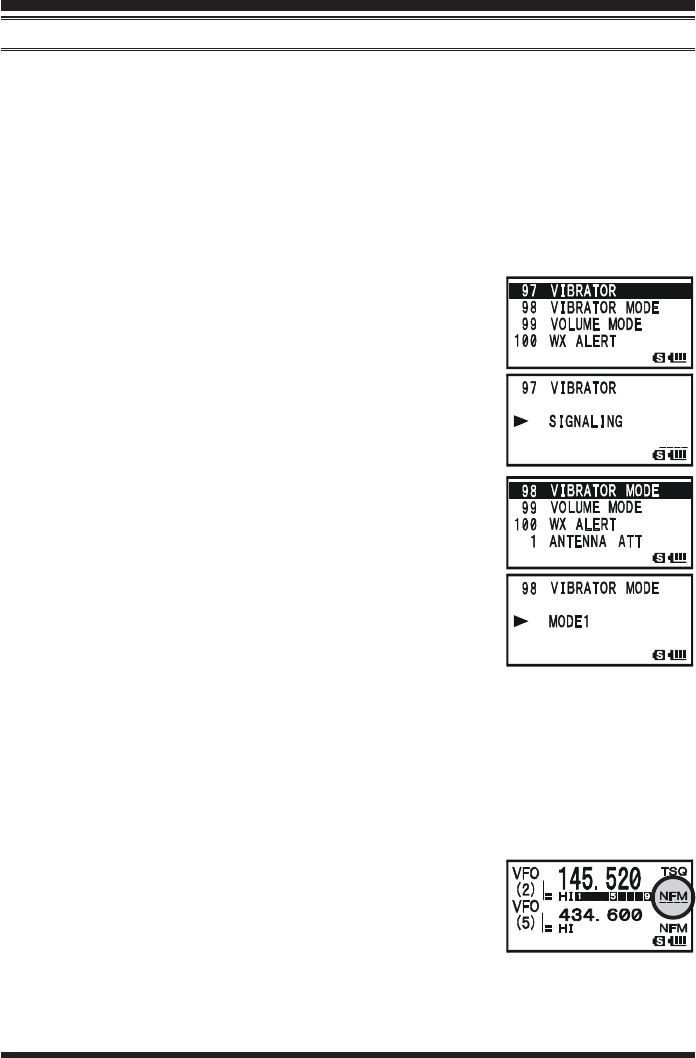
VX-8GR OPERATING MANUAL40
CTCSS/DCS/EPCS VIBRATOR OPERATION
The CTCSS/DCS/EPCS Vibrator operation is similar to the CTCSS/DCS/EPCS BELL
operation. The CTCSS/DCS/EPCS Vibratory operation inform you that a call is coming
in by vibration, during CTCSS Decode, DCS, or EPCS operation. Here is the procedure
for activating the CTCSS/DCS/EPCS Vibrator:
1. Set the operating frequency to the desired channel.
2. Set the transceiver up for CTCSS Decode (“Tone Squelch”), DCS, or EPCS opera-
tion, as described previously.
3. Press and hold the m key for one second to enter the Set Mode.
4. Rotate the DIAL knob to select Set Mode Item 97: VIBRA-97: VIBRA-
97: VIBRA-97: VIBRA-
97: VIBRA-
TORTOR
TORTOR
TOR.
5. Press the m key briefly to enable adjustment of this Set
Mode Item.
6. Rotate the DIAL knob to select “SIGNALINGSIGNALING
SIGNALINGSIGNALING
SIGNALING”.
Note: When this item is set to “BUSYBUSY
BUSYBUSY
BUSY”, the VX-8GR vi-
brates just to have received a signal without affecting the
CTCSS, DCS, or EPCS decoder.
7. Press the m key briefly, then rotate the DIAL knob one
click clockwise to select Set Mode Item 98: VIBRATOR98: VIBRATOR
98: VIBRATOR98: VIBRATOR
98: VIBRATOR
MODEMODE
MODEMODE
MODE.
8. Press the m key briefly to enable adjustment of this Menu
Item.
9. Rotate the DIAL knob to set the desired vibrating mode.
The available choices are:
MODE1MODE1
MODE1MODE1
MODE1: The VX-8GR vibrates continuously.
MODE2MODE2
MODE2MODE2
MODE2: The VX-8GR vibrates at a long interval.
MODE3MODE3
MODE3MODE3
MODE3: The VX-8GR vibrates at a short interval.
10. Press the PTT switch briefly to save the new setting and exit to normal operation.
When you are called by a station whose transceiver is sending a CTCSS tone, DCS code,
or CTCSS tone pair which matches that set into your Decoder, the VX-8GR will vibrate in
accordance with this programming.
When the CTCSS/DCS/EPCS Vibrator operation is activated,
the “dashed line” will appear under the mode icon.
To disable the CTCSS/DCS/EPCS Vibrator operation, select the
setting of Set Mode Item 97: VIBRATOR97: VIBRATOR
97: VIBRATOR97: VIBRATOR
97: VIBRATOR to “OFFOFF
OFFOFF
OFF”.
CTCSS/DCS/EPCS OPERATION
FCC ID: K6620415X20 / IC:511B-20415X20
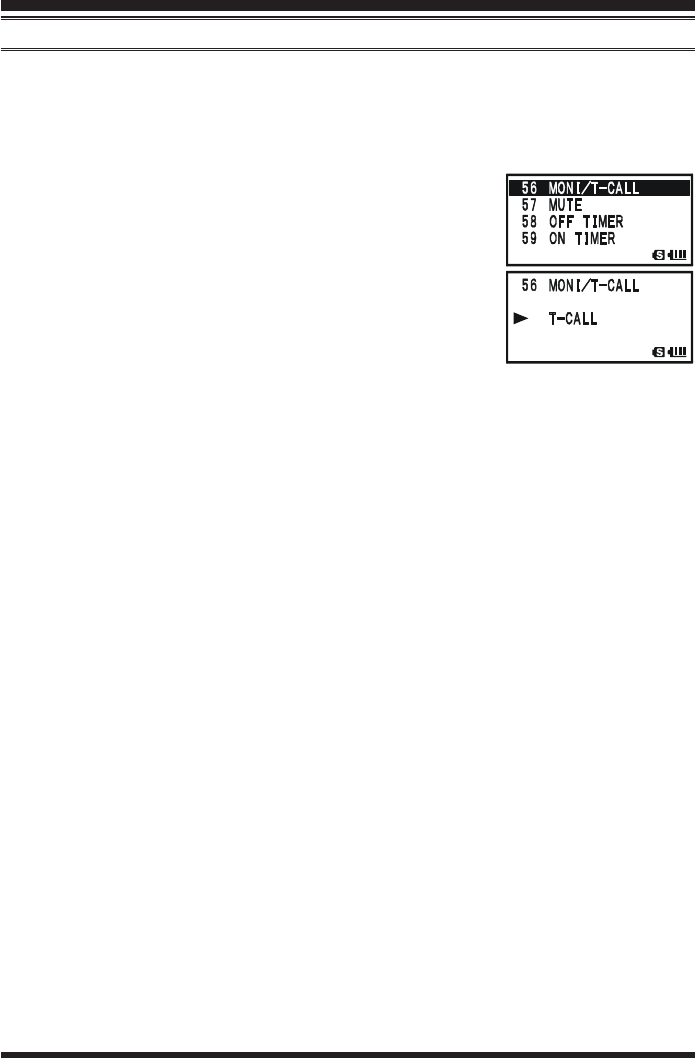
VX-8GR OPERATING MANUAL 41
CTCSS/DCS/EPCS OPERATION
TONE CALLING (1750 HZ)
If the repeaters in your country require a 1750-Hz burst tone for access (typically in Eu-
rope), you can set the e key to serve as a “Tone Call” switch instead. To change the
configuration of this switch, we again use the Menu to help us.
1. Press and hold the m key for one second to enter the Set Mode.
2. Rotate the DIAL knob to select Set Mode Item 56: MONI56: MONI
56: MONI56: MONI
56: MONI/T-T-
T-T-
T-
CALLCALL
CALLCALL
CALL.
3. Press the m key briefly to enable adjustment of this Set
Mode Item.
4. Rotate the DIAL knob to select “T-CALLT-CALL
T-CALLT-CALL
T-CALL” on the display.
5. Press the PTT switch briefly to save the new setting and
exit to normal operation.
To access a repeater, press and hold in the e key for the amount
of time specified by the repeater owner/operator. The transmitter will automatically be
activated, and a 1750-Hz audio tone will be superimposed on the carrier. Once access to
the repeater has been gained, you may release the e key, and use the PTT switch for
activating the transmitter.
FCC ID: K6620415X20 / IC:511B-20415X20

VX-8GR OPERATING MANUAL42
MEMORY MODE
The VX-8GR provides a wide variety of memory system resources. These include:
“Regular” Memory Channels, which include:
900 “Standard” memory channels, numbered “11
11
1” through “900900
900900
900.”
99 “Frequency Skip Memories,” numbered “901901
901901
901” through “999999
999999
999.”
7 “Home” channels, providing storage and quick recall of one prime frequency
on each operating band.
50 sets of band-edge memories, also known as “Programmable Memory Scan”
channels, labeled “L01L01
L01L01
L01/U01U01
U01U01
U01” through “L50L50
L50L50
L50/U50U50
U50U50
U50.”
24 Memory Banks, labeled “b 1b 1
b 1b 1
b 1” through “b24b24
b24b24
b24.” Each Memory Bank can be
assigned up to 100 channels from the “regular” memory channels.
Special Memory Channels, which include:
One “Emergency Automatic ID (EAI)” Channel.
10 “Weather Broadcast” Channels.
57 VHF Marine Channels.
HOME Channels
(7 channels)
VHF Marine Channels
(57 channels)
900
889
4
3
2
1
904
903
902
901
999
998
L50/U50
L49/U49
L4/U4
L3/U3
L2/U2
L1/U1
Standard Memory Channels
(900 channels) Frequency Skip Memory Channels
(99 channels) PMS Memory Channels
(50 Sets)
Weather Broadcast Channels
(10 channels)
WX10
WX9
WX4
WX3
WX2
WX1
EAI
EAI Channel
(1 channel)
Info. Band-2
UHF Band
Info. Band-1
VHF Band
Air Band
FCC ID: K6620415X20 / IC:511B-20415X20
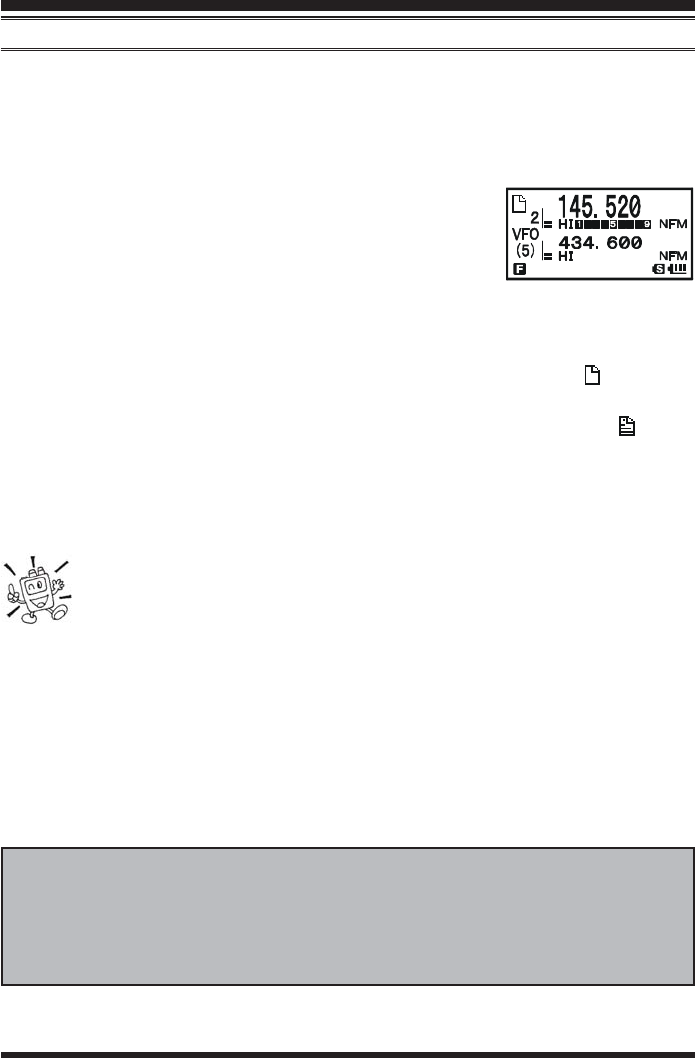
VX-8GR OPERATING MANUAL 43
MEMORY MODE (REGULAR MEMORY CHANNEL OPERATION)
MEMORY STORAGE
1. Select the desired frequency, while operating in the VFO mode. Be sure to set up any
desired CTCSS or DCS tones, as well as any desired repeater offset. The power level
may also be set at this time, if you wish to store it.
2. Press and hold in the f key for 1/2 second.
3. Within five seconds of releasing the f key, you need to make a decision regarding
channel storage. The microprocessor will automatically se-
lect the next-available “free” channel (a memory register
on which no data has been stored). If you do not wish to
make a change and accept the “free” channel, proceed to
step 4. If you wish to select a different channel number into which to store the data,
rotate the DIAL knob to select the desired memory channel.
Advice: You may jump 100 memory channels, if you’re in a hurry (101 201 301 …),
by pressing the m key (multiple times, if necessary). If you see the “ ” icon at the
upper left of the channel number, it means that the channel currently has no data
written on it (i.e. the channel is “free”: the occupied channel displays the “ ” icon).
4. Press the f key once more to store the frequency into memory.
5. You still will be operating in the “VFO” mode, so you may now enter other frequen-
cies, and store them into additional memory locations, by repeating the above pro-
cess.
1) You may change the automatic memory channel selection feature to select
the “next-highest memory channel above the last-stored memory channel”
instead of the “next-available ‘free’ channel” via the Set Mode Item 51:
MEMORY WRITE; see page xx.
2) You may disable the memory write function which prevents a memory write operation
if you should accidentally perform a wrong key sequence via the Set Mode Item 49:
MEMORY PROTECT. See page xx for details. When the memory write protect is acti-
vated, the “PROTECT” notation appears on the display while a memory write opera-
tion is being performed.
3) You may change the duration time of the secondary function (press and holding the
key) of the f key via the Set Mode Item 31: FW KEY HOLD TIME; see page xx.
IMPORTANT NOTE
On rare occasions the memorized data may become corrupted by miss operation,
or static electricity. When repairs are made the memory data may be lost. Please
write down or record the memorized information so you will be able to restore it if
needed.
FCC ID: K6620415X20 / IC:511B-20415X20
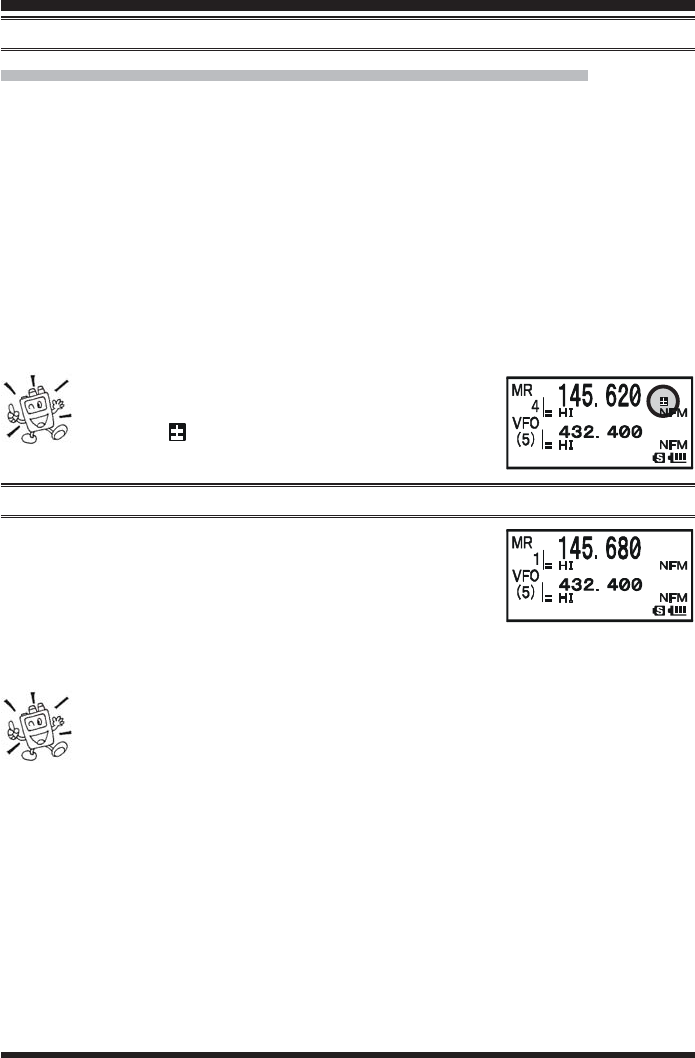
VX-8GR OPERATING MANUAL44
MEMORY MODE (REGULAR MEMORY CHANNEL OPERATION)
MEMORY STORAGE
STORING INDEPENDENT TRANSMIT FREQUENCIES (“ODD SPLITS”)
All memories can store an independent transmit frequency, for operation on repeaters
with non-standard shift. To do this:
1. Store the receive frequency using the method already described under MEMORY STOR-
AGE (it doesn’t matter if a repeater offset is active).
2. Tune to the desired transmit frequency, then press and hold in the f key for 1/2
second.
3. Within five seconds of releasing the f key, rotate the DIAL knob to select the same
memory channel number as used in step “1” above.
4. Press and hold in the PTT switch, then briefly press the f key once more while
holding the PTT switch in (this does not key the transmitter).
Whenever you recall a memory, which contains in-
dependently-stored transmit and receive frequen-
cies, the “ ” indication will appear in the display.
MEMORY RECALL
1. While operating in the VFO mode, press the c key to
enter the Memory mode.
2. Rotate the DIAL knob to select the desired channel.
3. If you press the f key briefly, then rotate the DIAL knob,
the memory channel will be selected in 10 channels per step.
4. To return to the VFO mode, press the c key.
1) When the radio is already set to the Memory mode, an easy way to recall
memories is to key in the memory channel number, then press the c key.
For example, to recall memory channel #14, press 14 c.
2) You may change the step of the fast channel selection mode (f key + DIAL knob)
via Set Mode Item 47: MEMORY FAST STEP. See page xx for details.
FCC ID: K6620415X20 / IC:511B-20415X20
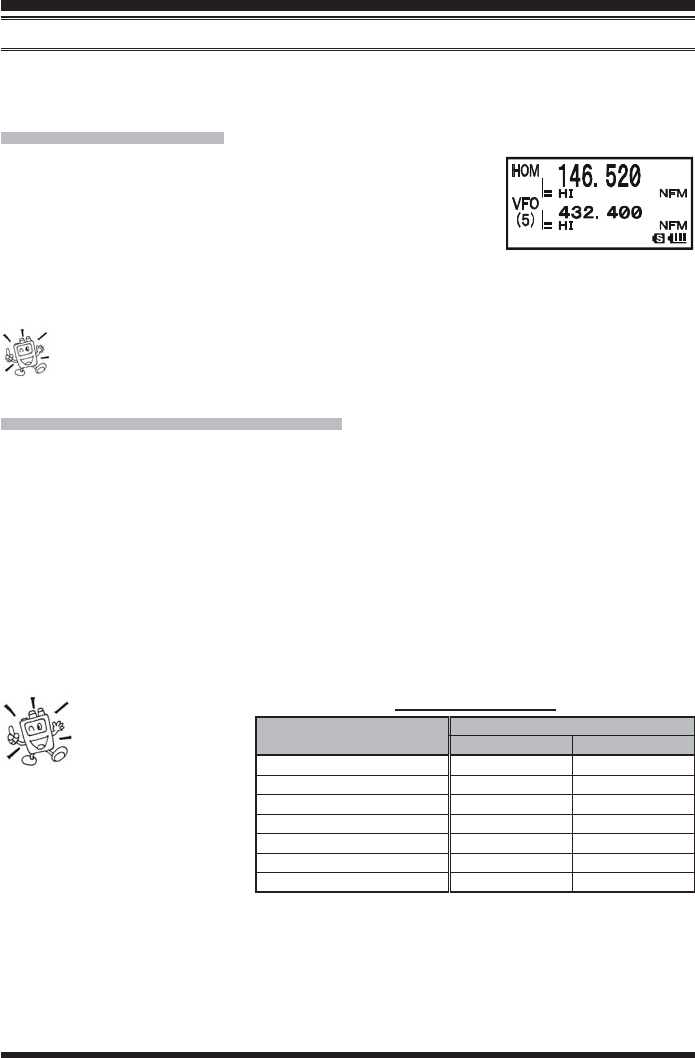
VX-8GR OPERATING MANUAL 45
A special one-touch “HOME” channel is available for each operating band, to allow quick
recall of a favorite operating frequency on each band.
HOME CHANNEL RECALL
1. Press the f key, then press the h key to recall the Home
Channel on the band group where you are currently operat-
ing.
2. Press the f key, then press the h key again to return to
the previously-used frequency (either a VFO or a memory channel).
The transceiver switches to VFO mode if the DIAL knob is turned.
You may disable the above function (automatically switching to the VFO mode)
using Set Mode Item 33: HOME VFO.
HOME CHANNEL FREQUENCY CHANGE
The factory defaults for the Home channels are listed below. You may re-program the
Home channel in a manner identical to that used for the regular memories:
1. Select the desired frequency, while operating in the VFO mode. Be sure to set up any
desired CTCSS or DCS tones, as well as any desired repeater offset. The power level
may also be set at this time, if you wish to store it.
2. Press and hold in the f key for 1/2 second.
3. While the memory channel number is blinking, just press the h key. The frequency
and other data (if any) will now be stored in the special HOME channel register.
4. You may repeat this process on the other operating bands.
Note that the UHF
HOME channel is
the one used during
“Emergency” operation. See
page xx for details regarding
this feature.
MEMORY MODE (REGULAR MEMORY CHANNEL OPERATION)
HOME CHANNEL MEMORY
OPERATING BAND
[BAND NUMBER]
Air Band [1]
VHF HAM Band [2]
VHF Band [3]
Information Band 1 [4]
UHF HAM Band [5]
UHF Band [6]
Information Band 2 [7]
EXP VERSION
108.000 MHz
144.000 MHz
174.000 MHz
222.000 MHz
430.000 MHz
470.000 MHz
860.000 MHz
USA VERSION
108.000 MHz
146.520 MHz
174.000 MHz
222.000 MHz
446.000 MHz
470.000 MHz
860.000 MHz
DEFAULT HOME CHANNELS
FREQUENCY
FCC ID: K6620415X20 / IC:511B-20415X20
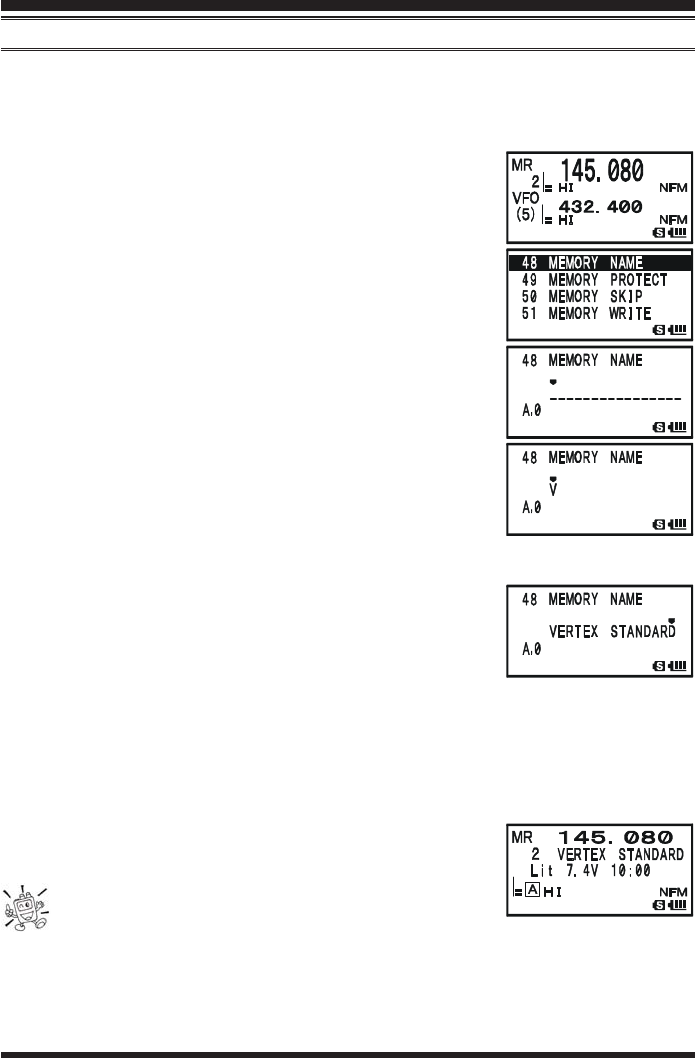
VX-8GR OPERATING MANUAL46
LABELING MEMORIES
You may wish to append an alpha-numeric “Tag” (label) to a memory or memories, to aid
in recollection of the channel’s use (such as a club name, etc.). This is easily accomplished
using the Set Mode.
1. Recall the memory channel on which you wish to append a
label.
2. Press and hold the m key for one second to enter the Set
Mode.
3. Rotate the DIAL knob to select Set Mode Item 48: MEMORY48: MEMORY
48: MEMORY48: MEMORY
48: MEMORY
NAMENAME
NAMENAME
NAME.
4. Press the m key briefly to enable programming of the
name tag. Press and hold the h key for two seconds to
clear any previous name, if desired.
5. Rotate the DIAL knob, or press one of the keyboard keys,
to select the first digit of the desired label.
Example 1: Rotate the DIAL knob to select any of the 61
available characters.
Example 2: Press the 8 key repeatedly to toggle among
the seven available characters associated with
that key: t u v 8 T U V
6. Press the M key to move to the next character, if needed.
7. Repeat steps 5 and 6 to program the remaining letters, num-
bers, or symbols of the desired label. A total of 16 charac-
ters may be used in the creation of a label.
8. Press and hold the h key for two seconds to delete all
data after the cursor that may have been previously stored.
9. If you make a mistake, press the B key to backspace the cursor, then re-enter the
correct letter, number, or symbol.
10. When you have completed the creation of the label, press the PTT switch briefly to
save the label and exit to normal operation.
During Memory Recall (“MR”) with Mono Band operation, the
alphanumeric Tag will appear below the frequency display.
The alphanumeric Tag does not appear if you activate
the Dual Receive Operation.
MEMORY MODE (REGULAR MEMORY CHANNEL OPERATION)
FCC ID: K6620415X20 / IC:511B-20415X20
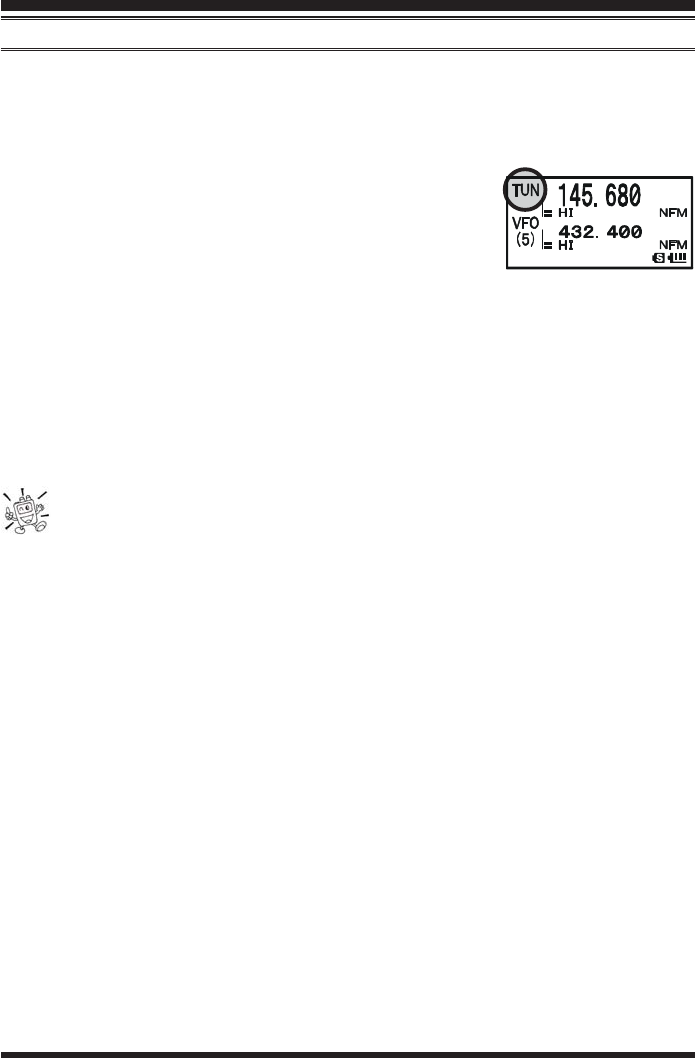
VX-8GR OPERATING MANUAL 47
MEMORY OFFSET TUNING
Once you have recalled a particular memory channel, you may easily tune off that chan-
nel, as though you were in the “VFO” mode.
1. With the VX-8GR in the Memory Recall (“MR”) mode, select the desired memory
channel.
2. Now press the f key, then press c key. The “MRMR
MRMR
MR” in-
dicator will be replaced by one which says “TUNTUN
TUNTUN
TUN” (“Memory
Tuning”).
3. Rotate the DIAL, as desired, to tune to a new frequency.
The synthesizer steps selected for VFO operation on the current band will be the steps
used during Memory Tuning.
4. If you wish to return to the original memory frequency, press c key briefly. The
“TUNTUN
TUNTUN
TUN” indicator will be replaced by “MRMR
MRMR
MR.”
5. If you wish to store a new frequency set during Memory Tuning, just press and hold
in the f key for one second, per normal memory storage procedure. The micropro-
cessor will automatically set itself to the next-available clear memory location, and
you then press the f key again, briefly to lock in the new frequency.
If you want to replace the original memory contents with the new frequency
settings, be sure to rotate the DIAL to the original memory channel number!
Any required CTCSS/DCS changes, or repeater offset modifications, must be done before
storing the data into the new (or original) memory channel location.
MEMORY MODE (REGULAR MEMORY CHANNEL OPERATION)
FCC ID: K6620415X20 / IC:511B-20415X20
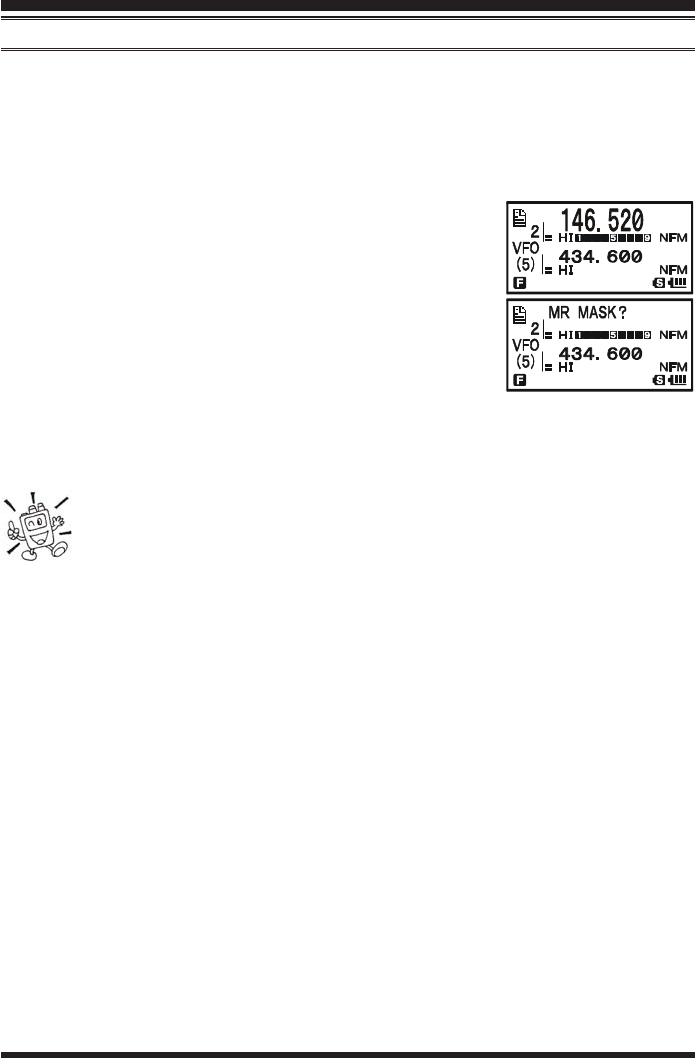
VX-8GR OPERATING MANUAL48
MEMORY MODE (REGULAR MEMORY CHANNEL OPERATION)
MASKING MEMORIES
There may be situations where you want to “Mask” memories so they are not visible
during memory selection or scanning. For example, several memories used only in a city
you visit infrequently may be stored, then “Masked” until you visit that city, at which time
you can “Unmask” them for normal use (except for Memory Channel “1”).
1. Press the c key, if needed, to enter the Memory Recall (“MR”) mode.
2. Press and hold in the f key for 1/2 second, then rotate
the DIAL to select the memory channel to be “Masked”
from view.
3. Press the d key. The confirmation message (MR MASK?MR MASK?
MR MASK?MR MASK?
MR MASK?)
will appear on the display. Press the d key once more,
the display will revert to memory channel #1. If you rotate
the DIAL to the location you just “Masked,” you will ob-
serve that it is now invisible.
4. To Unmask the hidden memory, repeat the above procedure: press and hold in the
f key for 1/2 second, rotate the DIAL to select the masked memory’s number, then
press the d key to restore the memory channel’s data.
Watch out! You can manually store data over a “Masked” memory, deleting
previous data, if you’re not careful. Use the “next available memory” stor-
age technique to avoid over-writing a masked memory.
FCC ID: K6620415X20 / IC:511B-20415X20
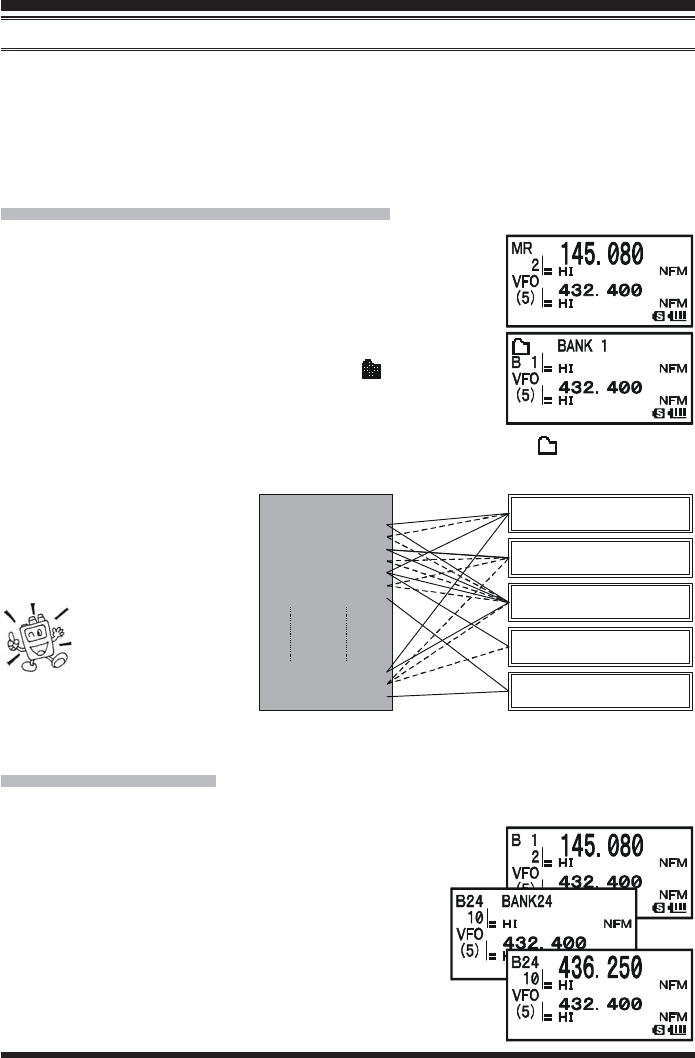
VX-8GR OPERATING MANUAL 49
MEMORY BANK OPERATION
The large number of memories available in the VX-8GR could be difficult to utilize with-
out some means of organizing them. Fortunately, the VX-8GR includes provision for
dividing the memories into as many as 24 Memory Banks, so you can categorize the
memories in a manner convenient to you. You may enter and exit the “Memory Bank”
mode by a single press of the B key, as we shall see below.
ASSIGNING MEMORIES TO A MEMORY BANK
1. Recall the memory channel to be assigned to a Memory
Bank.
2. Press and hold in the f key for 1/2 second, then rotate the
DIAL knob to select the Memory Bank number where you
want to include this channel (Memory Bank numbers are
found before memory channel “11
11
1”). The “ ” icon will ap-
pear at the upper left of the Memory Bank number if some
channels have already been assigned to that Memory Bank
number. (If no channels are assigned to the Memory Bank, the “ ” icon appears on
the left of the Memory Bank number).
3. Press the f key briefly.
4. At this point, the memory
channel data is copied into
the Memory Bank.
1) You may assign
one memory chan-
nel into several
Memory Banks.
2) The PMS memory channels
(L1/U1 through L50/U50) may not be assigned to a Memory Bank.
MEMORY BANK RECALL
1. Press the c key, if needed, to enter the MR mode.
2. Press the B key to activate the “Memory Bank” mode.
The “MRMR
MRMR
MR” indicator will be replaced by one of the Memory
Bank numbers (“B 1B 1
B 1B 1
B 1” through “B24B24
B24B24
B24”).
3. Press the f key, and then press the B key,
then rotate the DIAL knob to select the desired
Memory Bank.
4. Press the B key. Now, as you rotate the DIAL knob
to select memories, you will observe that you can only select
memory channels in the current Memory Bank.
Memory Channel
CH 1 145.000 MHz
CH 2 145.080 MHz
CH 3 435.000 MHz
CH 4 435.500 MHz
CH 5 145.800 MHz
CH 6 436.000 MHz
CH 7 128.800 MHz
CH 897 145.620 MHz
CH 898 436.780 MHz
CH 899 128.600 MHz
Memory Bank “5”
Air Band Channels
Memory Bank “4”
Club Channels
Memory Bank “3”
All Amateur Band Channels
Memory Bank “1”
144 MHz Amateur Band Channels
Memory Bank “2”
430 MHz Amateur Band Channels
MEMORY MODE (REGULAR MEMORY CHANNEL OPERATION)
FCC ID: K6620415X20 / IC:511B-20415X20
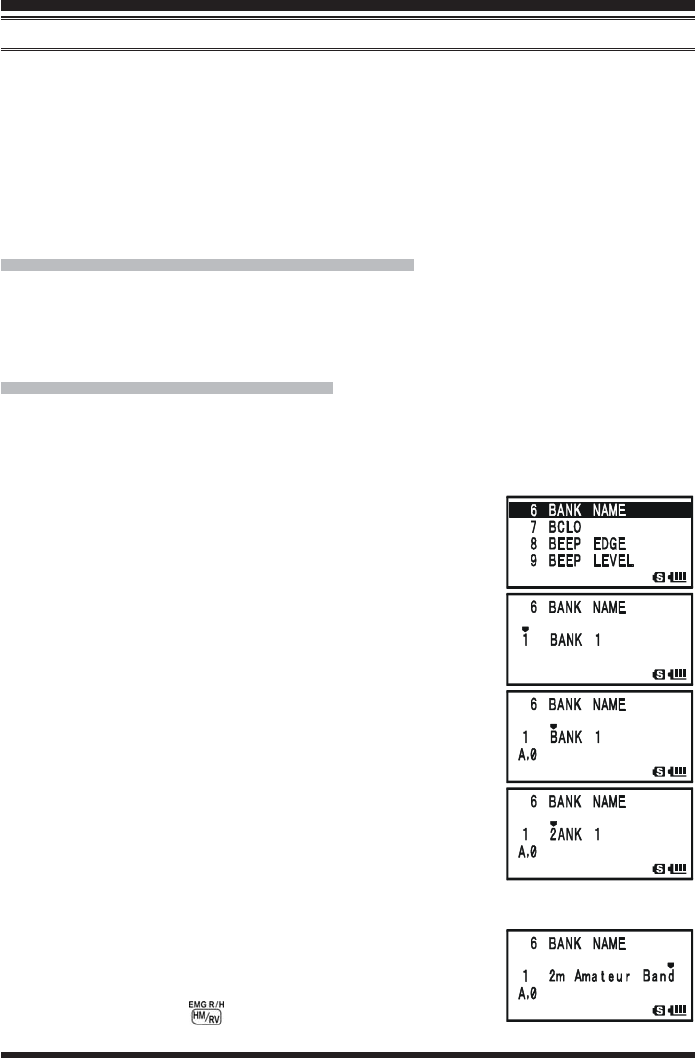
VX-8GR OPERATING MANUAL50
MEMORY MODE (REGULAR MEMORY CHANNEL OPERATION)
5. To change to another Memory Bank, press the f key, then press the B key.
Now rotate the DIAL knob to select the new Memory Bank, then press the B key
again.
6. To exit from Memory Bank operation, just press the B key. The Memory Bank
number will be replaced by the “MRMR
MRMR
MR”, and you are now in the “regular” Memory
Recall mode, without utilization of the Memory Banks. The memories stored in the
various Banks will remain in those banks. You do not need to store them again.
REMOVING MEMORIES FROM A MEMORY BANK
1. Recall the memory channel to be removed from a Memory Bank.
2. Press and hold the f key for 1/2 second, then press the d key to remove the
memory channel data from the Memory bank.
CHANGING A MEMORY BANK’S NAME
You may change the default Memory Bank Names, which are shown on the display while
selecting the Memory Bank your desire.
1. Press and hold in the m key for one second to enter the Set Mode.
2. Rotate the DIAL knob to select the Set Mode Item 6: BANK6: BANK
6: BANK6: BANK
6: BANK
NAMENAME
NAMENAME
NAME.
3. Press the m key briefly to enable adjustment of this Set
Mode Item.
4. Rotate the DIAL knob to select the memory bank on which
you wish to change a label.
5. Press the M key briefly to enable changing of the name
tag. Press and hold the h key for two seconds to clear
any previous name, if desired.
6. Rotate the DIAL knob, or press one of the keyboard keys,
to select the first digit of the desired label.
Example 1: Rotate the DIAL knob to select any of the 61
available characters.
Example 2: Press the 2 key repeatedly to toggle among
the seven available characters associated with
that key: a b c 2 A B C
7. Press the M key to move to the next character, if needed.
8. Repeat steps 6 and 7 to program the remaining letters, num-
bers, or symbols of the desired label. A total of 16 charac-
ters may be used in the creation of a label.
9. Press and hold the key for two seconds to delete all
data after the cursor that may have been previously stored.
MEMORY BANK OPERATION
FCC ID: K6620415X20 / IC:511B-20415X20
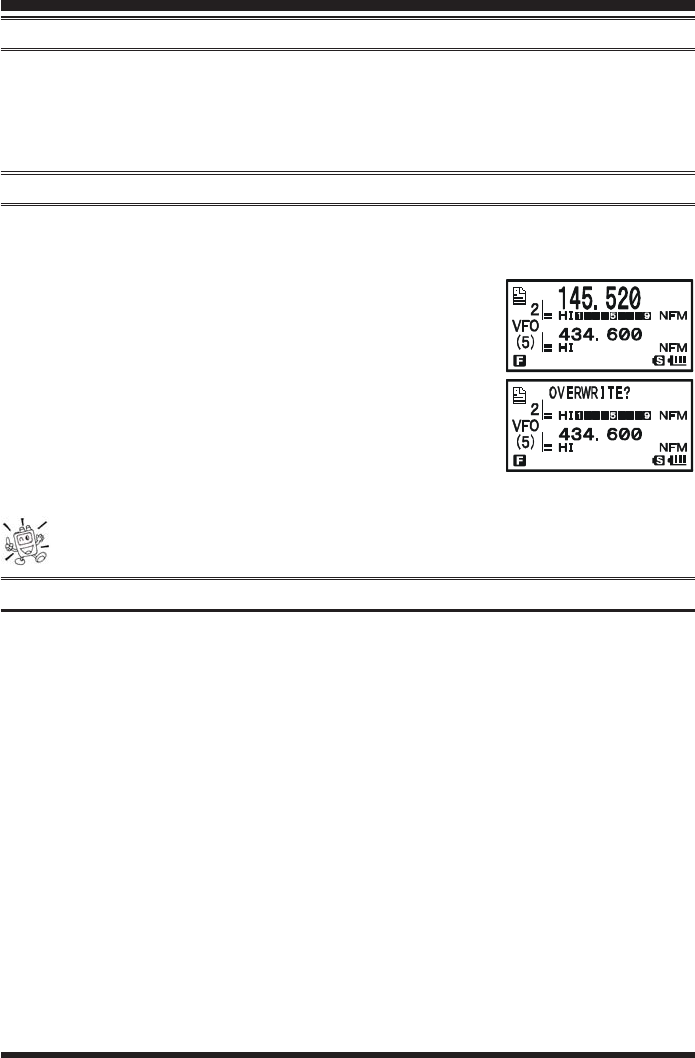
VX-8GR OPERATING MANUAL 51
10. If you make a mistake, press the B key to backspace the cursor, then re-enter the
correct letter, number, or symbol.
11. When you have completed the changes of the label, press the PTT switch to save the
label and exit.
MOVING MEMORY DATA TO THE VFO
Data stored on memory channels can easily be moved to VFO, if you like.
1. Press the c key, if needed, to enter the Memory Recall (“MR”) mode.
2. Press and hold in the f key for 1/2 second, then rotate
the DIAL knob to select the memory channel containing the
frequency data to be moved to VFO.
3. Press the c key. The confirmation message (OVER-OVER-
OVER-OVER-
OVER-
WRITE?WRITE?
WRITE?WRITE?
WRITE?) will appear on the display. Press the c key once
more, the data will now have been copied to VFO, although
the original memory contents will remain intact on the pre-
viously stored channel. Press the PTT switch to cancel the
Moving Memory Data procedure, if desired.
If a Split Frequency Memory channel was transferred, the Tx frequency will be
ignored (you will be set up for Simplex operation on the Receive frequency).
MEMORY ONLY MODE
Once memory channel programming has been completed, you may place the radio in a
“Memory Only” mode, whereby VFO operation is impossible. This may be particularly
useful during public-service events where a number of operators may be using the radio
for the first time, and ultimate simplicity of channel selection is desired.
To place the radio into the Memory Only mode, turn the radio off. Now press and hold in
the c key while turning the radio on.
To return to normal operation, repeat the above power-on procedure.
MEMORY MODE (REGULAR MEMORY CHANNEL OPERATION)
MEMORY BANK OPERATION
FCC ID: K6620415X20 / IC:511B-20415X20

VX-8GR OPERATING MANUAL52
MEMORY MODE (SPECIAL MEMORY CHANNEL OPERATION)
The VX-8GR provides Special Memory Channels, which are made up of:
10 Weather Broadcast Channels.
57 VHF Marine Channels
1) The Special Memory Channels are only recalled on the “A-Band”
2) You may assign the Special Memory Channels to a Memory Bank. See page xx re-
garding Memory Bank Operation for details.
WEATHER BROADCAST CHANNELS
The VHF Weather Broadcast Station Memory Channel Bank has been pre-programmed at
the factory, for quick selection of NOAA weather information stations.
1. Press the a key briefly to set the “A-Band” to the “Operating” band.
2. Press the f key, then press the 9 key, to recall the Special Memory Menu.
3. Press the B key, repeatedly if necessary to select the
“WX CHWX CH
WX CHWX CH
WX CH” (thus recalling the Weather Broadcast Memory
Bank).
4. Rotate the DIAL knob to select the desired Weather Broad-
cast channel.
5. If you wish to scan this bank to search for louder stations,
just press the PTT switch. When the scanner pauses on a
station, press the PTT switch once to halt the scan, or press
it twice to restart the scan.
6. To exit to normal operation, press the c key, or press f key followed by the 9
key.
In the event of extreme weather disturbances, such as storms and hurri-
canes, the NOAA (National Oceanic and Atmospheric Administration) sends
a weather alert accompanied by a 1050 Hz tone and subsequent weather
report on one of the NOAA weather channels. You may disable the Weather Alert tone
via Set Mode Item 100: WX ALERT, if desired. See page xx.
CH
1
2
3
4
5
CH
6
7
8
9
10
FREQUENCY
162.550 MHz
162.400 MHz
162.475 MHz
162.425 MHz
162.450 MHz
FREQUENCY
162.500 MHz
162.525 MHz
161.650 MHz
161.775 MHz
163.275 MHz
WX CHANNEL FREQUENCY LIST
FCC ID: K6620415X20 / IC:511B-20415X20
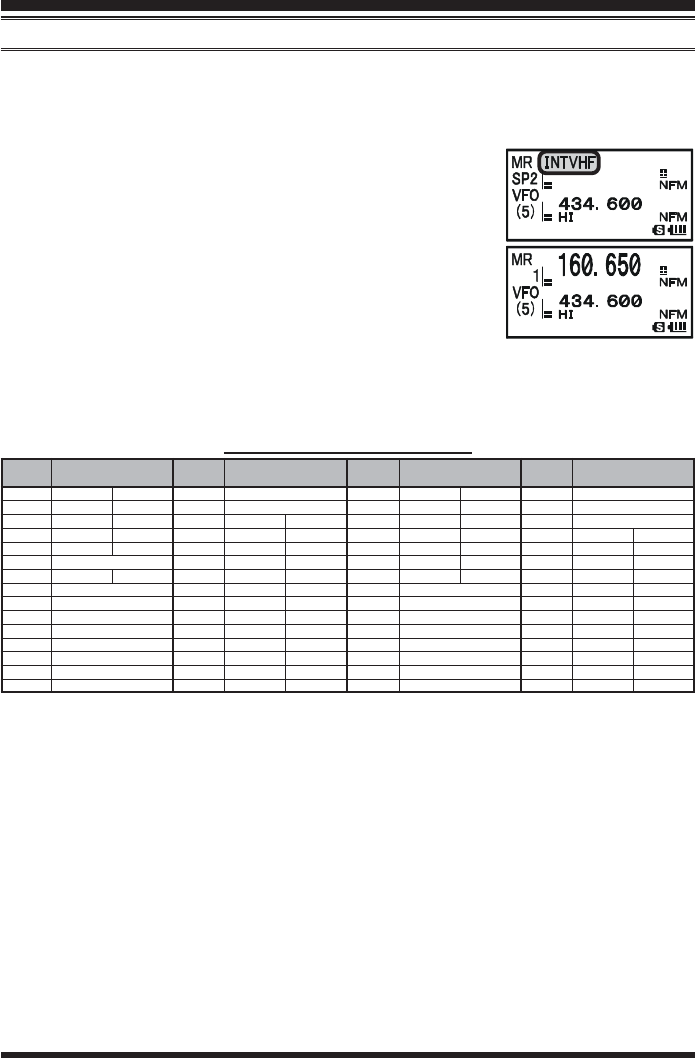
VX-8GR OPERATING MANUAL 53
VHF MARINE MEMORY CHANNELS
The VHF Marine Channel Bank has been pre-programmed at the factory, for quick selec-
tion.
1. Press the a key briefly to set the “A-Band” to the “Operating” band.
2. Press the f key, then press the 9 key, to recall the Spe-
cial Memory Menu.
3. Press the B key, repeatedly if necessary to select the
“INTVHFINTVHF
INTVHFINTVHF
INTVHF” (thus recalling the VHF Marine Channel Bank).
4. Rotate the DIAL to select any of the 57 available VHF Ma-
rine Channels.
5. Press the h key to monitor the duplex frequency while
recalling a semi-duplex channel (such as Channel “1”). Press
the h key again to revert to simplex monitoring.
6. To exit to normal operation, press the c key, or press f key followed by the 9
key.
VHF MARINE CHANNEL FREQUENCY LIST
MEMORY MODE (SPECIAL MEMORY CHANNEL OPERATION)
CH
No.
1
2
3
4
5
6
7
8
9
10
11
12
13
14
15
CH
No.
60
61
62
63
64
65
66
67
68
69
70
71
72
73
74
CH
No.
16
17
18
19
20
21
22
23
24
25
26
27
28
CH
No.
75
76
77
78
79
80
81
82
83
84
85
86
87
88
FREQUENCY
(MHz)
156.050 160.650
156.100 160.700
156.150 160.750
156.200 160.800
156.250 160.850
156.300
156.350 160.950
156.400
156.450
156.500
156.550
156.600
156.650
156.700
156.750
FREQUENCY
(MHz)
156.800
156.850
156.900 161.500
156.950 161.550
157.000 161.600
157.050 161.650
157.100 161.700
157.150 161.750
157.200 161.800
157.250 161.850
157.300 161.900
157.350 161.950
157.400 162.000
FREQUENCY
(MHz)
156.025 160.625
156.075 160.675
156.125 160.725
156.175 160.775
156.225 160.825
156.275 160.875
156.325 160.925
156.375
156.425
156.475
156.525
156.575
156.625
156.675
156.725
FREQUENCY
(MHz)
156.775
156.825
156.875
156.925 161.525
156.975 161.575
157.025 161.625
157.075 161.675
157.125 161.725
157.175 161.775
157.225 161.825
157.275 161.875
157.325 161.925
157.375 161.975
157.425 162.025
FCC ID: K6620415X20 / IC:511B-20415X20
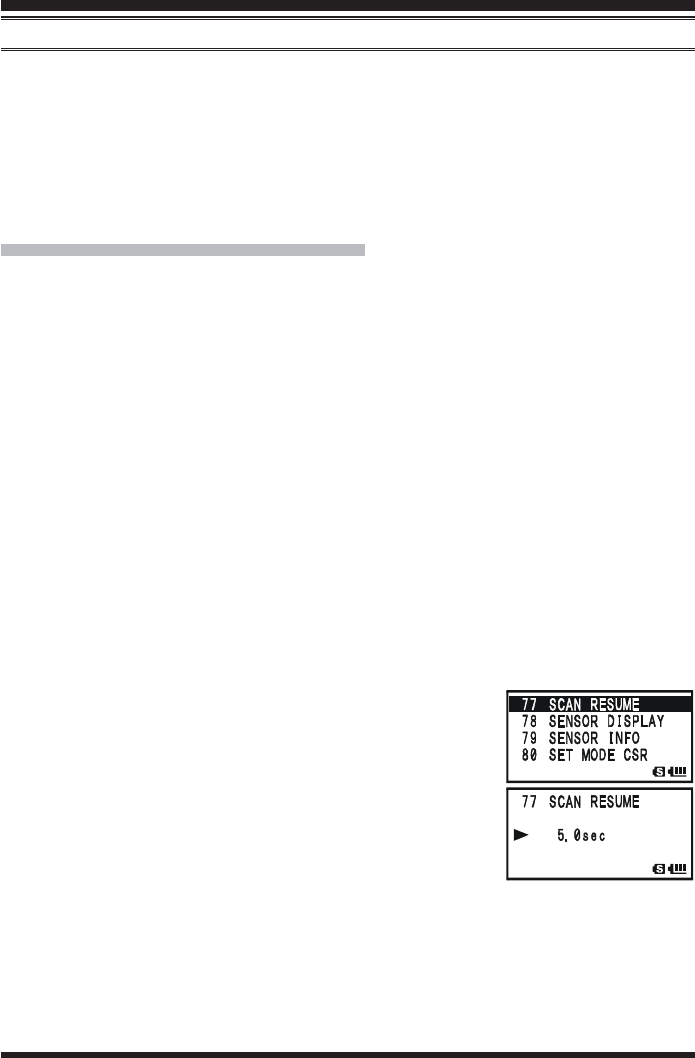
VX-8GR OPERATING MANUAL54
GENERAL
The VX-8GR allows you to scan just the memory channels, the entire operating band, or
a portion of that band. It will halt on signals encountered, so you can talk to the station(s)
on that frequency, if you like.
Scanning operation is basically the same in each of the above modes. Before you begin,
take a moment to select the way in which you would like the scanner to resume scanning
after it halts on a signal.
SETTING THE SCAN-RESUME TECHNIQUE
Three options for the Scan-Resume mode are available:
2.0sec - 10.0sec2.0sec - 10.0sec
2.0sec - 10.0sec2.0sec - 10.0sec
2.0sec - 10.0sec: In this mode, the scanner will halt on a signal it encounters, and will
hold there for the selected resume time. If you do not take action to
disable the scanner within that time period, the scanner will resume
even if the station is still active.
BUSYBUSY
BUSYBUSY
BUSY: In this mode, the scanner will halt on a signal it encounters. When the
carrier has dropped because the other station ceased transmission, the
scanner will resume. In the case of constant-carrier signals like Weather
Station broadcasts, the scanner will likely remain on this frequency
indefinitely. The Scan Re-start Delay time (default interval: 2 seconds)
is set by Set Mode Item 76: SCAN RE-START76: SCAN RE-START
76: SCAN RE-START76: SCAN RE-START
76: SCAN RE-START.
HOLDHOLD
HOLDHOLD
HOLD: In this mode, the scanner will halt on a signal it encounters. It will not
restart automatically; you must manually re-initiate scanning if you
wish to resume.
To set the Scan-Resume mode:
1. Press and hold the m key for one second to enter the Set Mode.
2. Rotate the DIAL knob to select Set Mode Item 77: SCAN77: SCAN
77: SCAN77: SCAN
77: SCAN
RESUMERESUME
RESUMERESUME
RESUME.
3. Press the m key briefly to enable adjustment of this Set
Mode Item.
4. Rotate the DIAL knob to select the desired scan-resume
mode.
5. Press the PTT switch to save the new setting and exit to
normal operation.
The default condition for this Set Mode Item is “5.0sec”.
SCANNING
FCC ID: K6620415X20 / IC:511B-20415X20
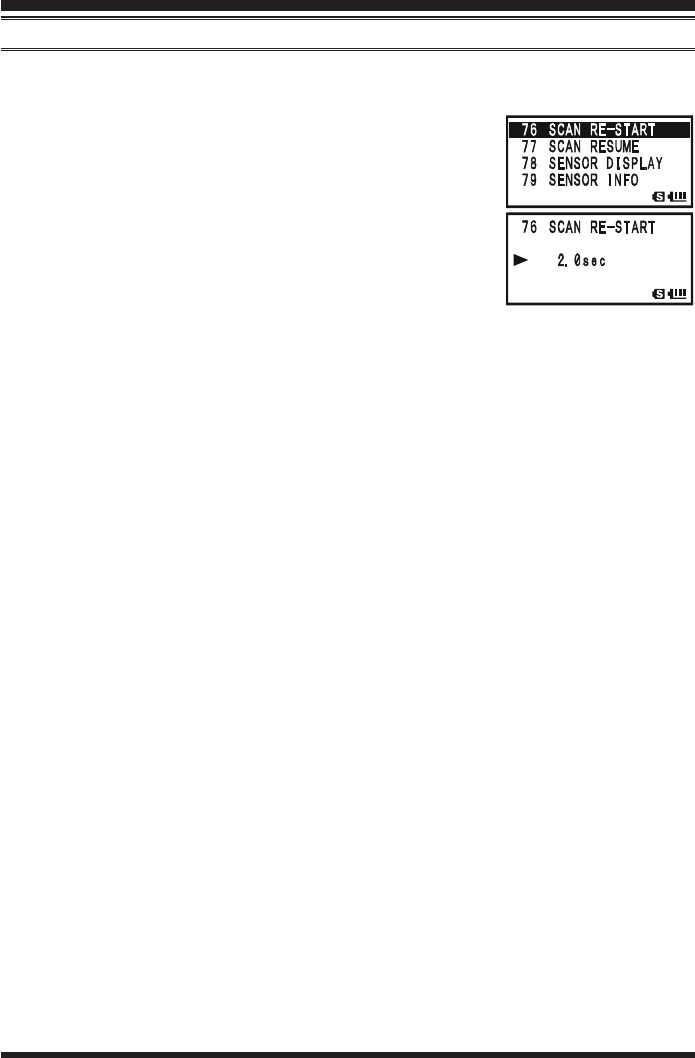
VX-8GR OPERATING MANUAL 55
SCANNING
To set the Scan-Restart Delay Time:
1. Press and hold the m key for one second to enter the Set Mode.
2. Rotate the DIAL knob to select Set Mode Item 76: SCAN76: SCAN
76: SCAN76: SCAN
76: SCAN
RE-STARTRE-START
RE-STARTRE-START
RE-START.
3. Press the m key briefly to enable adjustment of this Set
Mode Item.
4. Rotate the DIAL knob to select the desired Scan-Restart
Delay Time. Available selections are 0.1sec0.1sec
0.1sec0.1sec
0.1sec - 0.9sec0.9sec
0.9sec0.9sec
0.9sec
(0.1sec/step) and 1.0sec1.0sec
1.0sec1.0sec
1.0sec - 10.0sec10.0sec
10.0sec10.0sec
10.0sec (0.5sec/step).
5. Press the PTT switch to save the new setting and exit to
normal operation.
The default condition for this Set Mode Item is “2.0sec”.
GENERAL
FCC ID: K6620415X20 / IC:511B-20415X20
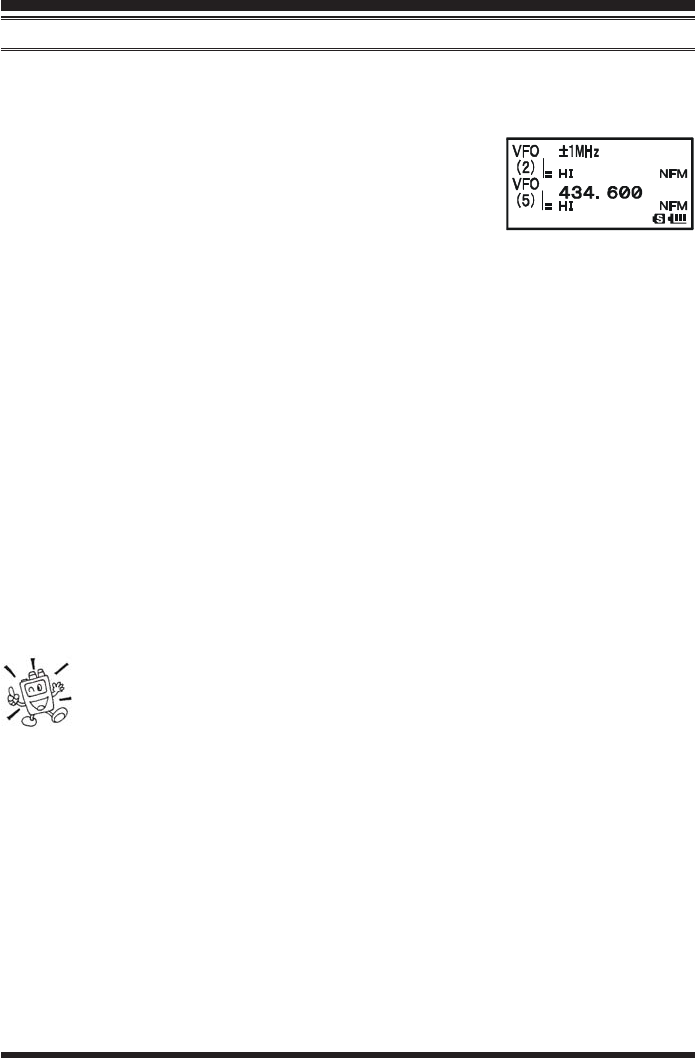
VX-8GR OPERATING MANUAL56
VFO SCANNING
This mode allows you to scan on the VFO mode.
1. Select the VFO mode by pressing the c key, if necessary.
2. Press and hold in the B key, then rotate the DIAL knob while holding in the
B key (the current bandwidth for the VFO scanner will
appear on the display) to select the bandwidth for the VFO
scanner. Available selections are ±1 MHz±1 MHz
±1 MHz±1 MHz
±1 MHz, ±2 MHz±2 MHz
±2 MHz±2 MHz
±2 MHz, ±5±5
±5±5
±5
MHzMHz
MHzMHz
MHz, BANDBAND
BANDBAND
BAND, ALLALL
ALLALL
ALL, and PMS-XPMS-X
PMS-XPMS-X
PMS-X.
±1 MHz±1 MHz
±1 MHz±1 MHz
±1 MHz, ±2 MHz±2 MHz
±2 MHz±2 MHz
±2 MHz, ±5 MHz±5 MHz
±5 MHz±5 MHz
±5 MHz: The scanner will sweep frequencies within the selected
bandwidth.
BANDBAND
BANDBAND
BAND: The scanner will sweep frequencies only on the cur-
rent band.
ALLALL
ALLALL
ALL: The scanner will sweep all frequencies between 108
MHz and 999.99 MHz.
PMS-XPMS-X
PMS-XPMS-X
PMS-X: The scanner will sweep frequencies within the cur-
rently-selected PMS frequency pair. See page xx for
details.
3. Release the B key to start scanning.
4. When the scanner encounters a signal strong enough to open the squelch, the scanner
will halt temporarily; the decimal point of the frequency display will blink during this
“Pause” condition.
5. The scanner will then resume according to the Scan-Resume mode selected in the
previous section.
6. To cancel scanning, press the PTT switch or c key.
1) If you want to change direction of the scan while it is underway, rotate the
DIAL knob one click in the opposite direction. You’ll see the scanner turn
around and change frequency downward!
2) You may change the scanner’s method of operation so the VFO frequency will jump
to the low band edge of the next band when the VFO frequency reaches the high edge
of the current band (or vice versa). See page xx regarding Set Mode Item 95: VFO
MODE.
SCANNING
FCC ID: K6620415X20 / IC:511B-20415X20

VX-8GR OPERATING MANUAL 57
SCANNING
HOW TO SKIP (OMIT) A FREQUENCY DURING VFO SCAN
If the VFO scan stops on a frequency or frequencies that you do not need (such as a
spurious radiation from a television), such frequencies can be “skipped” during VFO scan-
ning. A special “Frequency Skip Memory” bank is reserved to store these frequencies.
To skip a frequency during VFO scanning:
1. While VFO scanning is stopped on the frequency that you do not need, press and hold
the f key for one second, then rotate the DIAL knob to select the desired Fre-
quency Skip Memory channel (900900
900900
900 - 999999
999999
999). The microprocessor will automatically
select the next-available “free” Frequency Skip Memory channel (a memory register
on which no data has been stored). If you see the “ ” icon at the upper left of the
channel number, it means that the channel currently has no data written on it (i.e. the
channel is “free”).
2. Press the f key to store the frequency into the Frequency Skip Memory. It will now
be ignored during VFO scanning.
To re-institute a frequency into the VFO scan loop:
1. Press the c key, if needed, to enter the Memory Recall (“MR”) mode.
2. Press and hold in the f key for one second, then rotate the DIAL knob to select the
memory channel to be re-instituted.
3. Press the d key to delete the channel from the Frequency Skip Memory; this will
restore the frequency into the VFO scan loop.
The VX-8GR has 100 VFO Frequency Skip Memory Channels.
VFO SCANNING
SETTING THE SQUELCH LEVEL DURING ACTIVE SCANNING OPERATION
The VX-8GR allows adjustment of the Squelch level “on the fly” while you are
scanning.
1. While the scanner is engaged, press the key,
then press the key (the current squelch level
will appear below the frequency display).
2. Rotate the DIAL to select the desired Squelch level.
3. Press the PTT switch briefly to save the new setting and exit to normal op-
eration. In this case, pressing the PTT switch this one time will not causing
scanning to stop.
FCC ID: K6620415X20 / IC:511B-20415X20

VX-8GR OPERATING MANUAL58
SCANNING
MEMORY SCANNING
Memory scanning is also easy to initiate:
1. Set the radio to the Memory Recall (“MR”) mode by pressing the c key, if neces-
sary.
2. Press and hold in the B key, then rotate the DIAL knob while holding in the
B key (the current Memory Scan mode will appear on
the frequency display) to select the desired Memory Scan
mode. Available selections are ALL CHALL CH
ALL CHALL CH
ALL CH, TAG1TAG1
TAG1TAG1
TAG1, TAG2TAG2
TAG2TAG2
TAG2, BANDBAND
BANDBAND
BAND,
and PMS-XPMS-X
PMS-XPMS-X
PMS-X.
ALL CHALL CH
ALL CHALL CH
ALL CH: The scanner sweeps all Memory channels.
TAG1TAG1
TAG1TAG1
TAG1: The scanner sweeps only those Memory channels with the same first digit of
the alpha/numeric tag as the first channel on which scanning started.
TAG2TAG2
TAG2TAG2
TAG2: The scanner sweeps only those Memory channels with the same first and
second digits of the alpha/numeric tag as the first channel on which scan-
ning started.
BANDBAND
BANDBAND
BAND: The scanner sweeps only those Memory channels which are memorized on
the same operating band as the first channel on which scanning started.
PMS-XPMS-X
PMS-XPMS-X
PMS-X: The scanner will sweep frequencies within the currently-selected PMS fre-
quency pair. See page xx for details.
3. Release the B key to start scanning.
4. As with VFO scanning, the scanner will halt on any signal encountered that is strong
enough to open the squelch; it will then resume scanning according to the Scan-Re-
sume mode set previously. When there are no memory channels corresponding to the
selected Memory Scan mode, the “MS ERRMS ERR
MS ERRMS ERR
MS ERR” notation will appear on the display.
5. To cancel scanning, press the PTT switch or c key.
FCC ID: K6620415X20 / IC:511B-20415X20
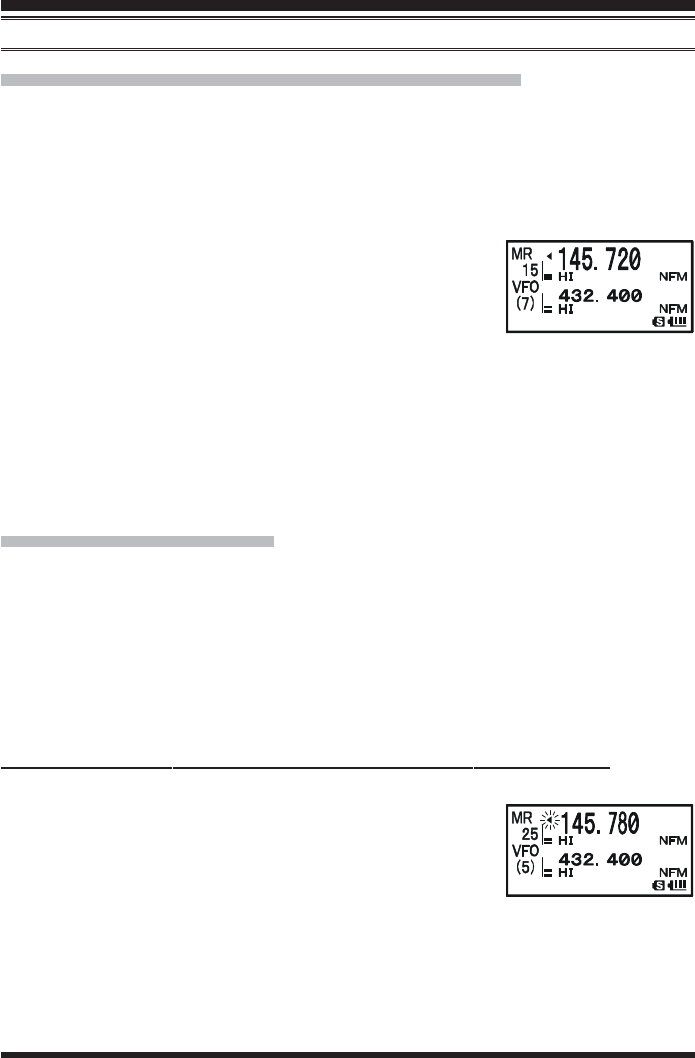
VX-8GR OPERATING MANUAL 59
HOW TO SKIP (OMIT) A CHANNEL DURING MEMORY SCAN
As mentioned previously, some continuous-carrier stations like a Weather Broadcast sta-
tion will seriously impede scanner operation if you are using the “Carrier Drop” Scan-
Resume mode, as the incoming signal will not pause long enough for the transceiver to
resume scanning. Such channels may be “Skipped” during scanning, if you like:
1. Recall the Memory Channel to be skipped during scanning.
2. Press the f key, then press the 5 key to appear a small
“” icon at the left of the frequency display. The current
Memory Channel will now be ignored (skipped) during
scanning (the “skipped” channel will, of course, still be ac-
cessible via manual channel selection methods using the DIAL knob in the Memory
Recall (“MR”) mode, whether or not it is locked out of the scanning loop).
To re-institute a channel into the scanning loop, press the f key followed by the 5
key twice, to disappear the small “” icon from display.
Note: You may notice a blinking “” icon while you perform above procedure. It indi-
cates the “Preferential Memory Scan” channel, described in the next column.
PREFERENTIAL MEMORY SCAN
The VX-8GR also allows you to set up a “Preferential Scan List” of channels which you
can “flag” within the memory system. These channels are designated by a blinking “”
icon when you have selected them, one by one, for the Preferential Scan List. When you
initiate memory scanning on a channel with the blinking “” icon appended, only those
channels bearing the blinking “” icon will be scanned. If you initiate scanning on a
channel which does not have the blinking “” icon appended, you will scan all channels
including those with the blinking “” icon appended.
Here is the procedure for setting up and using the Preferential Scan List:
1. Recall the Memory Channel which you wish to add to the Preferential Scan List.
2. Press the f key followed by the 5 key until a blinking
small “” icon appears at the left of the frequency display.
To clear the memory channel from the “Preferential Scan List”,
press the f key followed by the 5 key to disappear the
blinking small “” icon from display.
SCANNING
MEMORY SCANNING
FCC ID: K6620415X20 / IC:511B-20415X20

VX-8GR OPERATING MANUAL60
To initiate Preferential Memory Scan:
1. Press the c key briefly to enter the Memory Recall (“MR”) mode, if you are not
using memories already.
2. Rotate the DIAL knob to select any channel which has a
blinking “” icon appended to the channel number.
2. Press and hold in the B key, then rotate the DIAL knob
while holding in the B key (the current Memory Scan
mode will appear on the frequency display) to select the
desired Memory Scan mode. Available selections are ALLALL
ALLALL
ALL
CHCH
CHCH
CH(ONLYONLY
ONLYONLY
ONLY), TAG1TAG1
TAG1TAG1
TAG1(ONLYONLY
ONLYONLY
ONLY), TAG2TAG2
TAG2TAG2
TAG2(ONLYONLY
ONLYONLY
ONLY), BANDBAND
BANDBAND
BAND(ONLYONLY
ONLYONLY
ONLY), and
PMS-XPMS-X
PMS-XPMS-X
PMS-X.
ALL CHALL CH
ALL CHALL CH
ALL CH: The scanner sweeps all Preferential Scan Channels.
TAG1TAG1
TAG1TAG1
TAG1: The scanner sweeps only those Preferential Scan Channels with the same
first digit of the alpha/numeric tag as the first channel on which scanning
started.
TAG2TAG2
TAG2TAG2
TAG2: The scanner sweeps only those Preferential Scan Channels with the same
first and second digits of the alpha/numeric tag as the first channel on which
scanning started.
BANDBAND
BANDBAND
BAND: The scanner sweeps only those Preferential Scan Channels which are memo-
rized on the same operating band as the first channel on which scanning
started.
PMS-XPMS-X
PMS-XPMS-X
PMS-X: The scanner will sweep frequencies within the currently-selected PMS fre-
quency pair. This is not a Preferential Memory Scan, see page ?? for details.
3. Release the B key to start scanning.
When there are no memory channels corresponding to the selected Memory Scan
mode, the “MS ERRMS ERR
MS ERRMS ERR
MS ERR” notation will appear on the display.
5. To cancel scanning, press the PTT switch or c key.
MEMORY SCANNING
SCANNING
FCC ID: K6620415X20 / IC:511B-20415X20
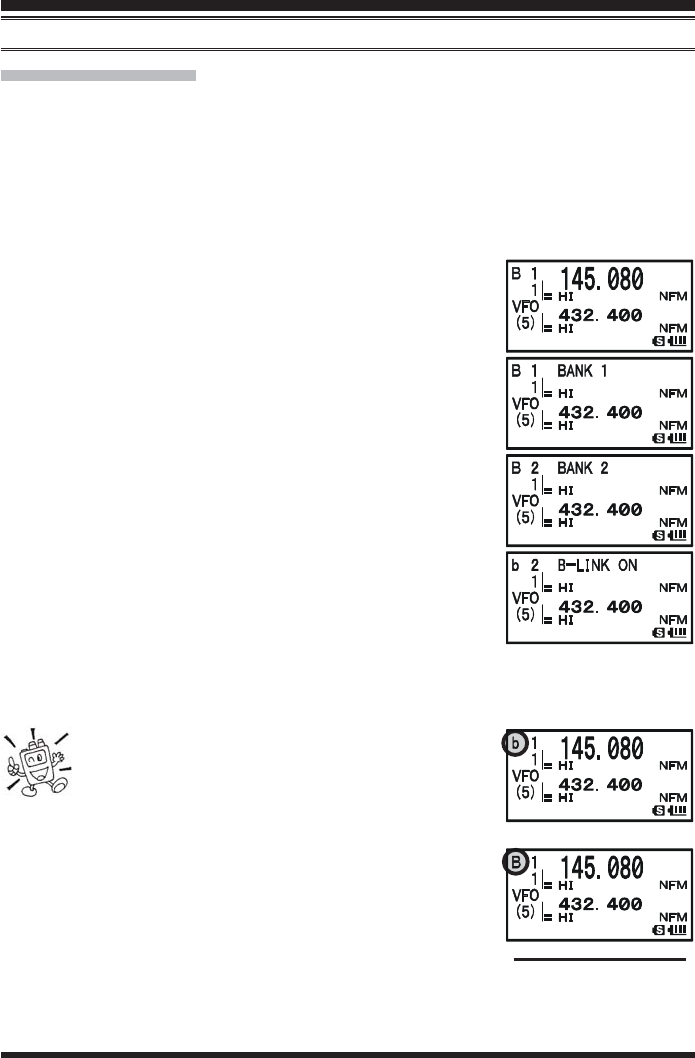
VX-8GR OPERATING MANUAL 61
MEMORY BANK SCAN
When the Memory Bank feature is engaged, the scanner sweeps only memory channels in
the current Memory Bank. However, if the Memory Bank Link Scan feature is enabled,
you may sweep the memory channels in several Memory Banks which you have selected.
To enable the Memory Bank Link Scan feature:
1. Set the radio to the Memory Recall (“MR”) mode by pressing the c key, if neces-
sary.
2. Press the B key to activate the “Memory Bank” mode.
The “MRMR
MRMR
MR” indicator will be replaced by one of the Memory
Bank numbers (“B 1B 1
B 1B 1
B 1” through “B24B24
B24B24
B24”).
3. Press the f key followed by the B key. The Memory
Bank number will begin to blink.
4. Rotate the DIAL knob to select the first Memory Bank
(“BANK 1BANK 1
BANK 1BANK 1
BANK 1” ~ “BANK24BANK24
BANK24BANK24
BANK24”) you wish to sweep using Memory
Bank Link Scan.
5. Press the c key briefly. A “B-LINK ONB-LINK ON
B-LINK ONB-LINK ON
B-LINK ON” notation will ap-
pear for two seconds on the display, indicating this Memory
Bank will now be swept during Memory Bank Scan.
6. Repeat steps 4 and 5 above, to append the “B-LINK ONB-LINK ON
B-LINK ONB-LINK ON
B-LINK ON”
notation to any other Memory Banks you wish to sweep.
7. Press the B key.
8. Now, press and hold in the B key for one second to
initiate the Memory Bank Link Scan.
9. To remove a Memory Bank from the Memory Bank Link Scan, repeat steps 1 - 5
above, to change the “B-LINK ONB-LINK ON
B-LINK ONB-LINK ON
B-LINK ON” notation into “B-LINK OFFB-LINK OFF
B-LINK OFFB-LINK OFF
B-LINK OFF”.
1) When the Memory Bank is enabled for Memory
Bank scan, the Memory Bank number (“B x”) in-
dication turns into “bx” (capital “B” turns into
small “b”).
2) You may enable/disable the Memory Bank scan via Set Mode
Item 5: BANK LINK.
MEMORY SCANNING
SCANNING
MEMORY BANK SCAN “DISABLED”
FCC ID: K6620415X20 / IC:511B-20415X20
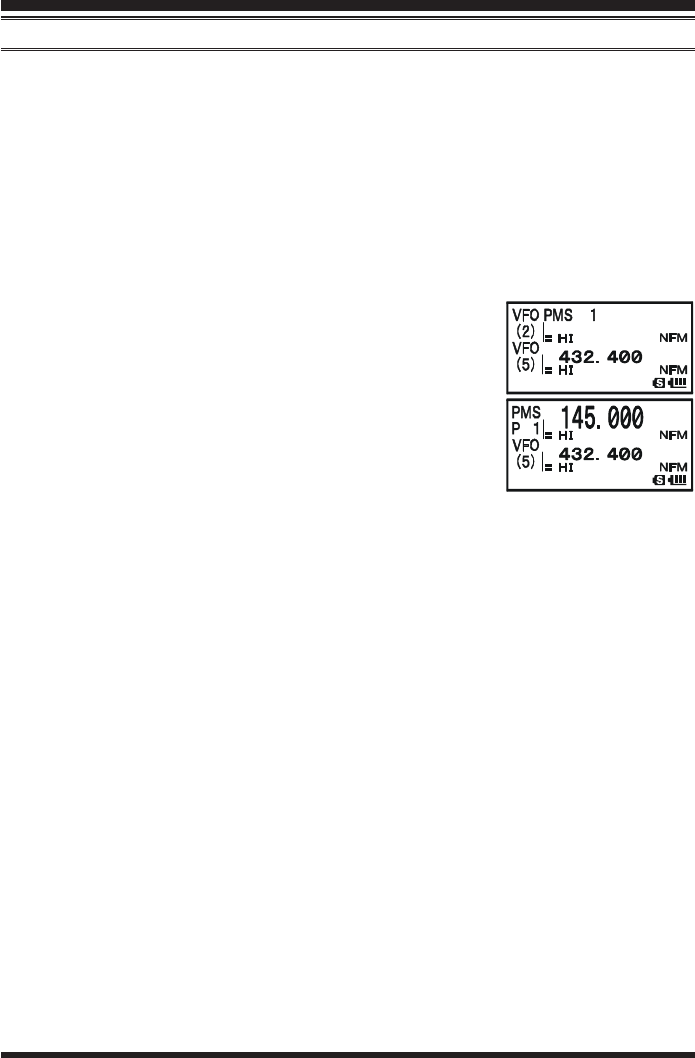
VX-8GR OPERATING MANUAL62
PROGRAMMABLE (BAND LIMIT) MEMORY SCAN (PMS)
This feature allows you to set sub-band limits for either scanning or manual VFO opera-
tion. For example, you might wish to set up a limit (in North America) of 144.300 MHz to
148.000 MHz to prevent encroachment into the SSB/CW “Weak Signal” portion of the
band below 144.300 MHz. Here’s how to do this:
1. Set the radio to the VFO mode by pressing the c key, if necessary.
2. Using the techniques learned earlier, store (per the above concept) 144.300 MHz into
Memory Channel #L1L1
L1L1
L1 (the “L” designates the Lower sub-band limit).
3. Likewise, store 146.000 MHz into Memory Channel #U1U1
U1U1
U1 (the “U” designates the
Upper sub-band limit).
4. Press and hold in the B key for one second and rotate
the DIAL knob while holding in the B key to select the
desired PMS frequency pair (PMSxxPMSxx
PMSxxPMSxx
PMSxx).
5. Release the B key to start scanning within the just-pro-
grammed range. The “VFOVFO
VFOVFO
VFO” label will be replaced by “PMSPMS
PMSPMS
PMS”
and the Band number will be replaced by “PxxPxx
PxxPxx
Pxx”. Tuning
and scanning will now be limited within the just-pro-
grammed range.
6. 50 pairs of Band Limit memories, labeled L1L1
L1L1
L1/U1U1
U1U1
U1 through L50L50
L50L50
L50/U50U50
U50U50
U50 are available.
You therefore can set upper and lower operation limits on a number of bands, if you
like.
7. To exit to normal operation, press the c key.
SCANNING
FCC ID: K6620415X20 / IC:511B-20415X20
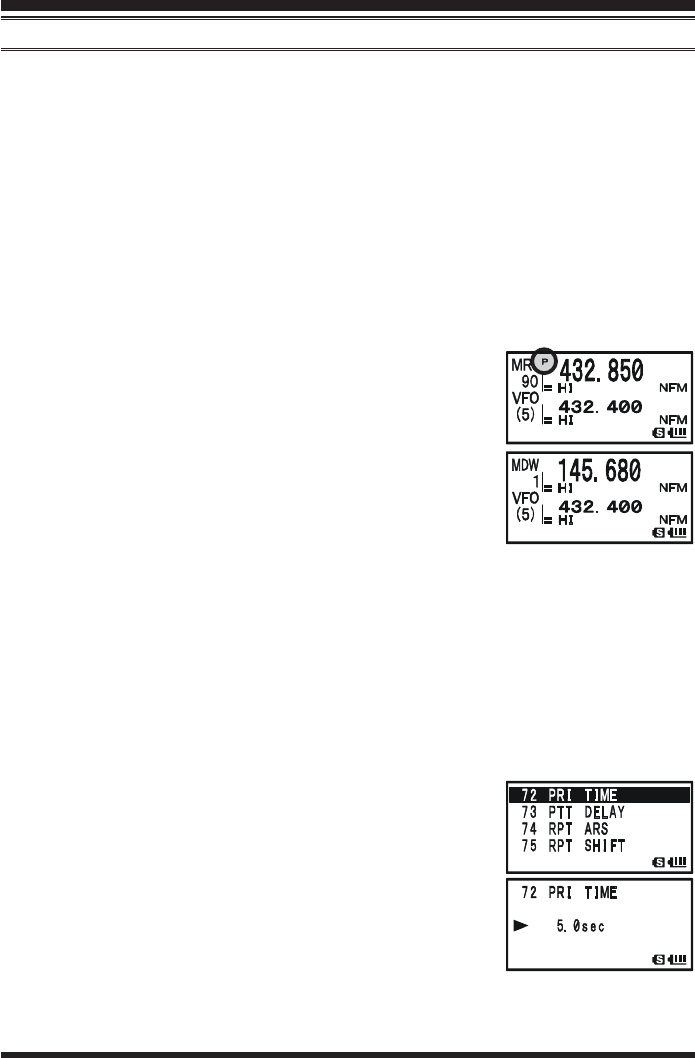
VX-8GR OPERATING MANUAL 63
“PRIORITY CHANNEL” SCANNING (DUAL WATCH)
The VX-8DR’s scanning features include a two-channel scanning capability which al-
lows you to operate on a VFO or Memory channel, while periodically checking a user-
defined Memory Channel for activity. If a station is received on the Memory Channel
which is strong enough to open the Squelch, the scanner will pause on that station in
accordance with the Scan-Resume mode set via Menu Item 83: SCAN RESUME83: SCAN RESUME
83: SCAN RESUME83: SCAN RESUME
83: SCAN RESUME. See
page 60.
Here is the procedure for activating Priority Channel Dual Watch operation:
1. Press the c key briefly to enter the Memory Recall (“MR”) mode, if you are not
using memories already.
2. Press and hold in the f key for one second, then rotate the DIAL knob to select the
memory channel you wish to be the “Priority” channel.
3. Press the B key. The “PP
PP
P” icon will appear to the right of
the “MRMR
MRMR
MR” label, indicating it is the Priority channel.
4. Now set the VX-8GR for operation on another memory
channel, or on a VFO frequency.
5. Press and hold in the c key for one second. The display
will remain on the VFO or memory channel selected. How-
ever, every five seconds the VX-8GR will check the Prior-
ity Channel for activity. The “MRMR
MRMR
MR” label will be replaced by
“MDWMDW
MDWMDW
MDW” while operating on the Memory channel or the “VFOVFO
VFOVFO
VFO” label will be replaced
by “VDWVDW
VDWVDW
VDW” while operating on the VFO mode.
6. If a station appears on the Priority Channel, the radio will pause on that channel, as
described previously.
The receiving time interval (ratio) between the current channel (or VFO frequency) and
Priority channel may be customized via Set Mode Item 67: PRI TIME67: PRI TIME
67: PRI TIME67: PRI TIME
67: PRI TIME.
To set the receiving time interval:
1. Press and hold the m key for one second to enter the Set Mode.
2. Rotate the DIAL knob to select Set Mode Item 62: PRI TIME62: PRI TIME
62: PRI TIME62: PRI TIME
62: PRI TIME.
3. Press the m key briefly to enable adjustment of this Set
Mode Item.
4. Rotate the DIAL knob to select the desired time interval.
Available selections are 0.1sec0.1sec
0.1sec0.1sec
0.1sec - 0.9sec0.9sec
0.9sec0.9sec
0.9sec (0.1sec/step) and
1.0sec1.0sec
1.0sec1.0sec
1.0sec - 10.0sec10.0sec
10.0sec10.0sec
10.0sec (0.5sec/step).
5. Press the PTT switch briefly to save the new setting and
exit to normal operation.
The default condition for this Set Mode Item is “5.0sec”.
SCANNING
FCC ID: K6620415X20 / IC:511B-20415X20
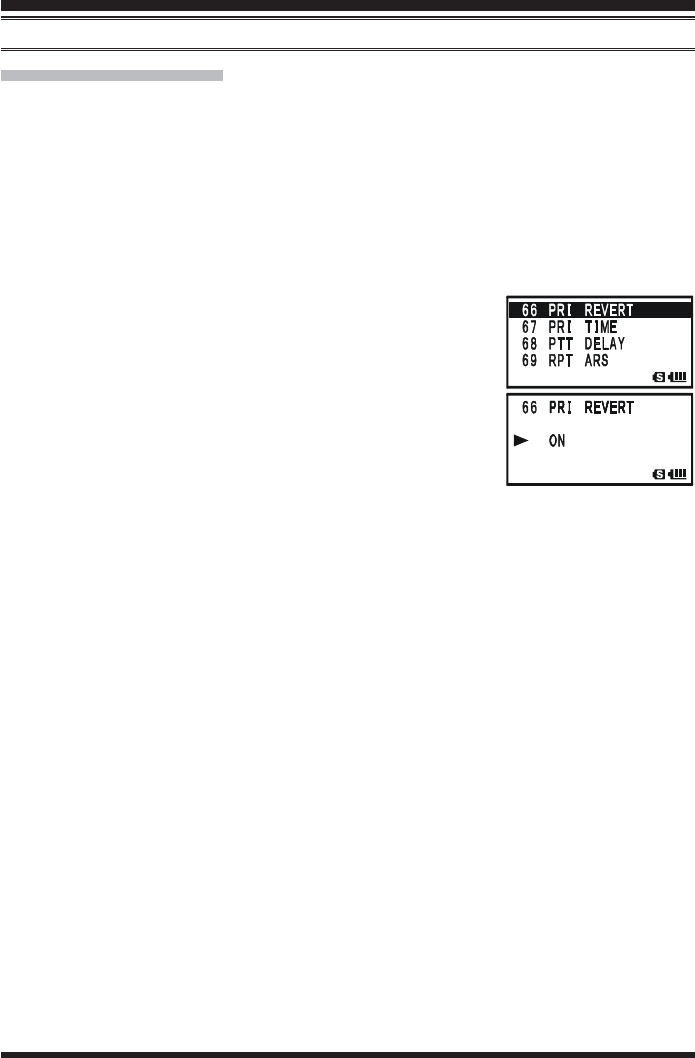
VX-8GR OPERATING MANUAL64
PRIORITY REVERT MODE
During Priority channel operation (Dual Watch), a special feature is available which will
allow you to move to the Priority Channel instantly, without waiting for activity to appear
on the Priority Channel.
When this feature is enabled, and priority monitoring is engaged, just press the microphone’s
PTT switch. Operation will instantly revert to the Priority Channel.
To enable Priority Revert operation:
1. Press and hold the m key for one second to enter the Set Mode.
2. Rotate the DIAL knob to select Set Mode Item 66: PRI RE-66: PRI RE-
66: PRI RE-66: PRI RE-
66: PRI RE-
VERTVERT
VERTVERT
VERT.
3. Press the m key briefly to enable adjustment of this Set
Mode Item.
4. Rotate the DIAL knob to select “ONON
ONON
ON”.
5. Press the PTT switch briefly to save the new setting and
exit to normal operation.
To disable Priority Revert operation, select “OFFOFF
OFFOFF
OFF” in step 4 above.
“PRIORITY CHANNEL” SCANNING (DUAL WATCH)
SCANNING
FCC ID: K6620415X20 / IC:511B-20415X20
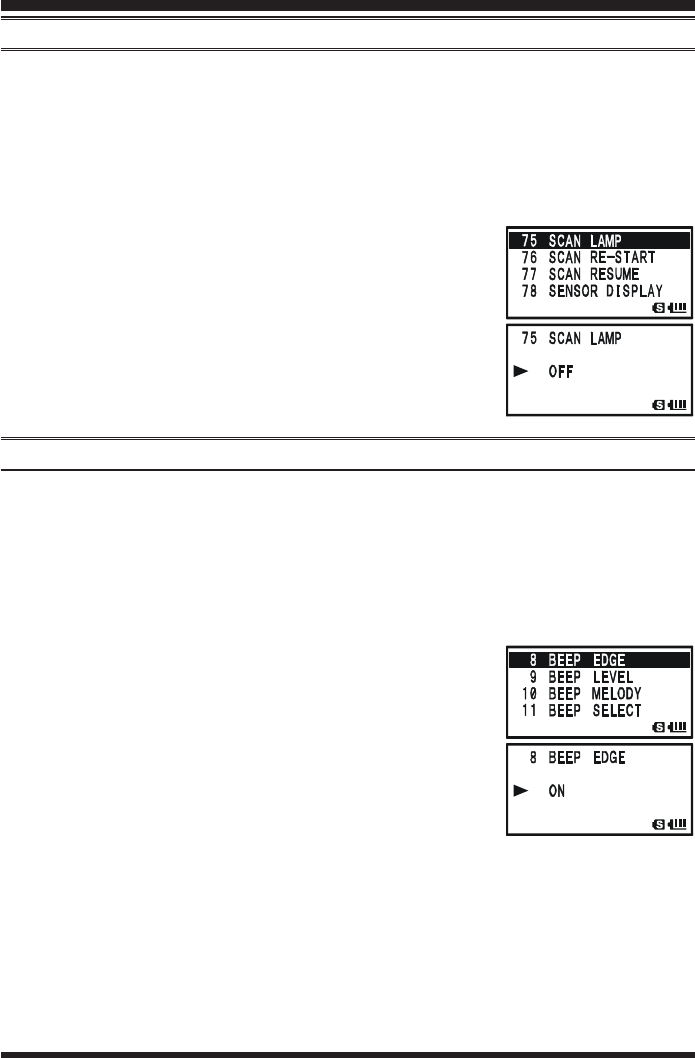
VX-8GR OPERATING MANUAL 65
AUTOMATIC LAMP ILLUMINATION ON SCAN STOP
The VX-8GR will automatically illuminate the LCD Lamp whenever the scanner stops on
a signal; this allows you to see the frequency of the incoming signal better at night. Note
that this will, of course, increase battery consumption, so be sure to switch it off during the
day (the default condition for this feature is “ON”).
The procedure for disabling the Scan Lamp is:
1. Press and hold the m key for one second to enter the Set Mode.
2. Rotate the DIAL knob to select Set Mode Item 75: SCAN75: SCAN
75: SCAN75: SCAN
75: SCAN
LAMPLAMP
LAMPLAMP
LAMP.
3. Press the m key briefly to enable adjustment of this Set
Mode Item.
4. Rotate the DIAL knob to select “OFFOFF
OFFOFF
OFF”.
5. Press the PTT switch briefly to save the new setting and
exit to normal operation.
BAND EDGE BEEPER
The VX-8GR will automatically “beep” when a band edge is encountered during scan-
ning (either in standard VFO scanning or during PMS operation). You may enable this
feature (band edge beeper) when the frequency reaches the band edge while selecting the
VFO frequency by the DIAL knob.
The procedure for enabling the Band-Edge Beeper is:
1. Press and hold the m key for one second to enter the Set Mode.
2. Rotate the DIAL knob to select Set Mode Item 8: BEEP8: BEEP
8: BEEP8: BEEP
8: BEEP
EDGEEDGE
EDGEEDGE
EDGE.
3. Press the m key briefly to enable adjustment of this Set
Mode Item.
4. Rotate the DIAL knob to select “ONON
ONON
ON”.
5. Press the PTT switch briefly to save the new setting and
exit to normal operation.
SCANNING
FCC ID: K6620415X20 / IC:511B-20415X20
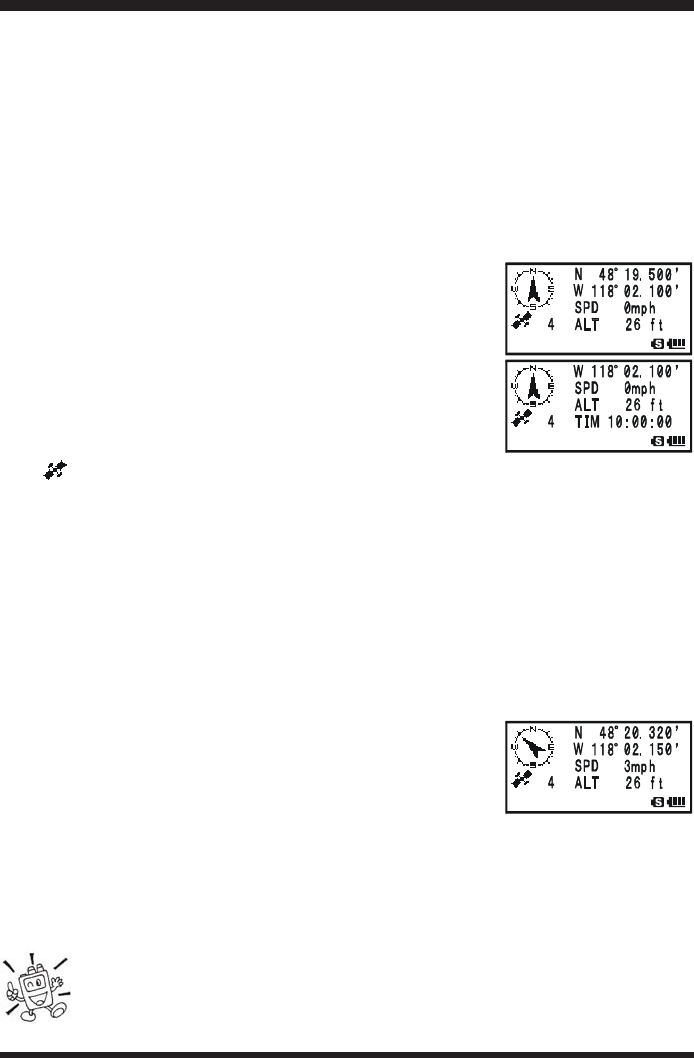
VX-8GR OPERATING MANUAL66
The VX-8GR allows the display of your position (Longitude/Latitude) with the built-in
GPS Antenna Unit.
1. Press the m key until the GPS screen appears.
2. Press and hold in the m key for one second to enter the APRS/GPS Set Mode.
3. Ratate the DIAL knob to select Set Mode Item 18: GPS POWER18: GPS POWER
18: GPS POWER18: GPS POWER
18: GPS POWER.
4. Press the m key briefly to enable selection of this Set Mode Item.
5. Rotate the DIAL knob to select “GPS ON” (to activate the built-in GPS Antenna
Unit).
6. Press the PTT switch briefly to save the new setting and exit to normal operation.
7. When the transceiver succeeds in receiving a valid GPS
signal, your current position (Longitude/Latitude), current
time (UTC), and altitude will appear on the display. Rotate
the DIAL knob (or press the a/b key) to scroll through
additional lines of station text on the display.
The received satellite number appears at the lower right of
compasses (In the example at the right, it is 4 satellites).
When receiving a signal from more than 3 satellites, the
“” icon will appear on the display.
Advice: 1) When the built-in GPS Antenna Unit is first turned on, it may take several
minutes to compute a fix of your position. This is normal, as the built-in GPS unit is
downloading “almanac” information from the GPS satellites.
2) While the VX-8GR searches for a GPS signal, the compass icon does not appear
on the display and the position information (Longitude/Latitude) blinks on the dis-
play.
3) If the VX-8GR does not receive a valid GPS signal after three minutes have passed,
you may be in a poor location for satellite reception, such as inside of a house or
building; try moving to a less obstructed position.
3. If you walk a few meters from your current location, your
course direction is displayed on the compass of the display
and walking speed is displayed in the “SPDSPD
SPDSPD
SPD” column of the
display.
4. Press the M key to toggle the GPS screen between “North Up” and “Course Up”.
The course direction displays a black arrow in the “North Up” screen, and displays a
white arrow in the “Course Up” screen.
5. To return to normal operation, press the m key several times until the normal screen
appears.
1) When the VX-8DR GPS signal is interrupted; such as when you enter into a
tunnel, the compass icon disappears from the display but maintains the position
information (Longitude/Latitude) at the point where the GPS signal was lost.
2) When the built-in GPS Antenna Unit is activated, the current consumption increases
GPS OPERATION
FCC ID: K6620415X20 / IC:511B-20415X20
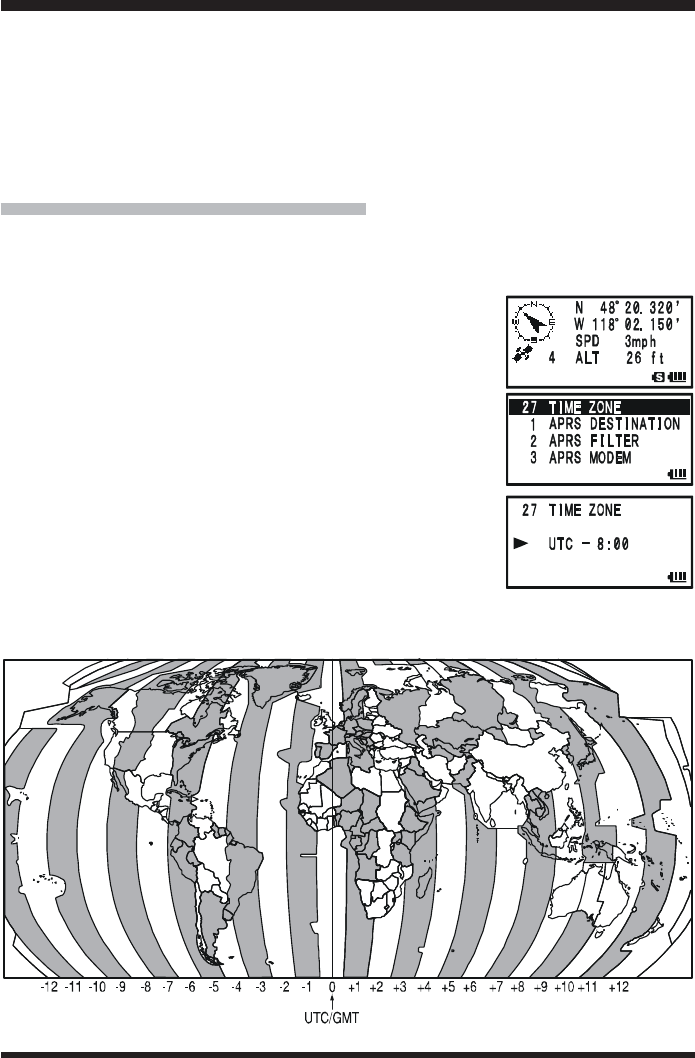
VX-8GR OPERATING MANUAL 67
approximately 40 mA. Therefore, battery life is reduced by approximately 20 % when
the built-in GPS Antenna Unit is activated.
3) You may memorize your current position as plotted by the GPS (up to ten points can be
saved) via the APRS/GPS Set Mode Item 23: MY POSITION. See page xx for details.
You may customize the Time Zone (Time Offset), Display Unit of the GPS screen, and
GPS Datum for your own operating requirements via the APRS/GPS Set Mode.
SETTING THE TIME ZONE (TIME OFFSET)
Sets the time offset between your local time and UTC (Universal Time Coordinated or
GMT: Greenwich Mean Time) shown on the display.
1. Press the m key several times until the GPS screen ap-
pears on the display.
2. Press and hold the m key for one second to enter the
APRS/GPS Set Mode.
3. Rotate the DIAL knob to select Set Mode Item 27: TIME27: TIME
27: TIME27: TIME
27: TIME
ZONEZONE
ZONEZONE
ZONE.
4. Press the m key briefly to enable selection of this Set
Mode Item.
5. Rotate the DIAL knob to select the time offset from UTC.
See illustration below to find your offset time from UTC. If
“UTC +0:00UTC +0:00
UTC +0:00UTC +0:00
UTC +0:00” is assigned, the time is the same as UTC.
6. Press the PTT switch briefly to save the new setting and
exit from the APRS/GPS Set Mode.
GPS OPERATION
FCC ID: K6620415X20 / IC:511B-20415X20
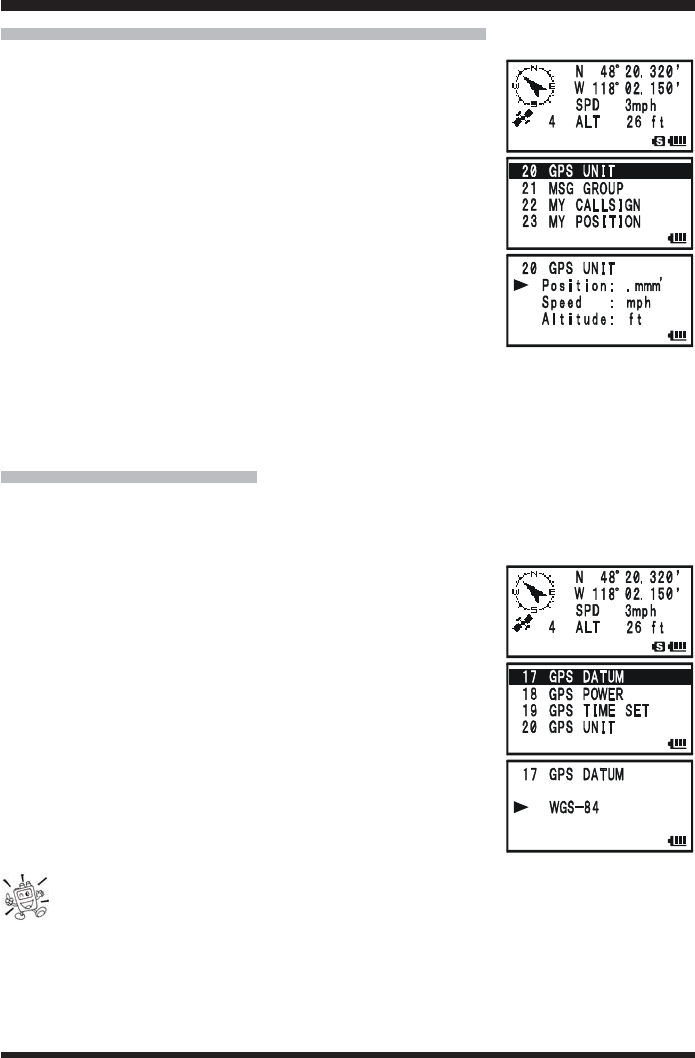
VX-8GR OPERATING MANUAL68
SELECTING THE DISPLAY UNITS OF THE GPS SCREEN
1. Press the m key until the GPS screen appears.
2. Press and hold the m key for one second to enter the
APRS/GPS Set Mode.
3. Rotate the DIAL knob to select Set Mode Item 20: GPS20: GPS
20: GPS20: GPS
20: GPS
UNITUNIT
UNITUNIT
UNIT.
4. Press the m key briefly to enable adjustment of this Set
Mode Item.
5. Rotate the DIAL knob to select the preferred unit for “Posi-Posi-
Posi-Posi-
Posi-
tiontion
tiontion
tion” (.MMM’.MMM’
.MMM’.MMM’
.MMM’ or ‘SS”‘SS”
‘SS”‘SS”
‘SS”).
6. Press the b key to change the cursor to “SpeedSpeed
SpeedSpeed
Speed”, then
rotate the DIAL knob to select the preferred unit (KmKm
KmKm
Km/hh
hh
h,
mphmph
mphmph
mph, or KnotKnot
KnotKnot
Knot).
7. Press the b key to change the cursor to “AltitudeAltitude
AltitudeAltitude
Altitude”, then rotate the DIAL knob to
select the preferred unit (mm
mm
m or ftft
ftft
ft).
8. Press the PTT switch briefly to save the new setting and exit from the APRS/GPS Set
Mode.
SELECTING THE MAP DATUM
While most operations (including APRS® operation) will utilize the default “WGS84”
database of locations, you may use a different database.
1. Press the m key until the GPS screen appears.
2. Press and hold the m key for one second to enter the
APRS/GPS Set Mode.
3. Rotate the DIAL knob to select Set Mode Item 17: GPS17: GPS
17: GPS17: GPS
17: GPS
DATUMDATUM
DATUMDATUM
DATUM.
4. Press the m key briefly to enable adjustment of this Set
Mode Item.
5. Rotate the DIAL knob to select the database you wish to
use. Available selections are WGS-84WGS-84
WGS-84WGS-84
WGS-84, Tokyo MeanTokyo Mean
Tokyo MeanTokyo Mean
Tokyo Mean, TokyoTokyo
TokyoTokyo
Tokyo
JapanJapan
JapanJapan
Japan, Tokyo KoreaTokyo Korea
Tokyo KoreaTokyo Korea
Tokyo Korea, and Tokyo OkinawaTokyo Okinawa
Tokyo OkinawaTokyo Okinawa
Tokyo Okinawa.
6. Press the PTT switch briefly to save the new setting and
exit from the APRS/GPS Set Mode.
Do not change the Map Datum while the GPS/APRS (described next chapter) in
in operation. The position indication will be incorrect.
GPS OPERATION
FCC ID: K6620415X20 / IC:511B-20415X20

VX-8GR OPERATING MANUAL 69
NOTE
FCC ID: K6620415X20 / IC:511B-20415X20
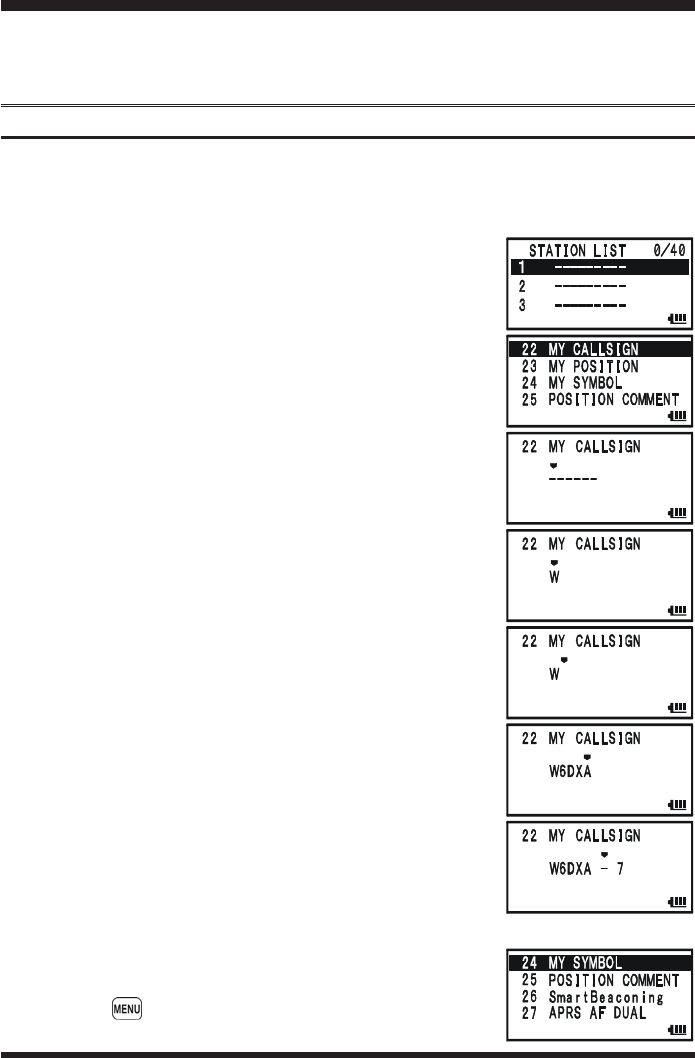
VX-8GR OPERATING MANUAL70
The VX-8GR is equipped with a 1200/9600bps AX.25 Data Modem to enable APRS®
(Automatic Packet Reporting System) operation. The Automatic Packet Reporting Sys-
tem (APRS®) is a software program and registered trademark of Bob Bruninga, WB4APR.
PREPARATIONS
Before performing any APRS® operations, set your callsign, symbol, and position (Lon-
gitude/Latitude) into the VX-8GR, and activate the AX.25 Data Modem via the APRS/
GPS Set Mode.
1. Press the m key repeatedly until “STATION LIST” ap-
pears on the display.
2. Press and hold the m key for one second to enter the
APRS/GPS Set Mode.
3. Rotate the DIAL knob to select Set Mode Item 22: MY22: MY
22: MY22: MY
22: MY
CALLSIGNCALLSIGN
CALLSIGNCALLSIGN
CALLSIGN.
4. Press the m key briefly to enable Callsign programming.
5. Rotate the DIAL knob or press the appropriate keys on your
keyboard to set the first letter or number in your callsign.
Example 1: Rotate the DIAL knob to select any of the 37
available characters.
Example 2: Press the 9 key repeatedly to toggle among
the five available characters associated with that key: W
X Y Z 9 W ......
6. Press the M key to move on to the next character, if
needed.
7. Repeat steps 5 and 6 as many times as necessary to com-
plete your callsign.
8. If you make a mistake, press the B key to backspace
the cursor and re-enter the correct letter/number.
The callsign can consist of up to six characters. If your
callsign is less than six characters, enter spaces into the re-
maining digits.
9. Press the M key to move on to the next position, then
rotate the DIAL knob to select the SSID (Secondary Station
Identifier) if desired (see next page).
10. When you have completed entering your callsign and SSID,
press the m key briefly to save the new setting.
11. Rotate the DIAL knob to select Set Mode Item 24: MY SYM-24: MY SYM-
24: MY SYM-24: MY SYM-
24: MY SYM-
BOLBOL
BOLBOL
BOL.
12. Press the key briefly to enable adjustment of this Set
Mode Item.
APRS® OPERATION
FCC ID: K6620415X20 / IC:511B-20415X20
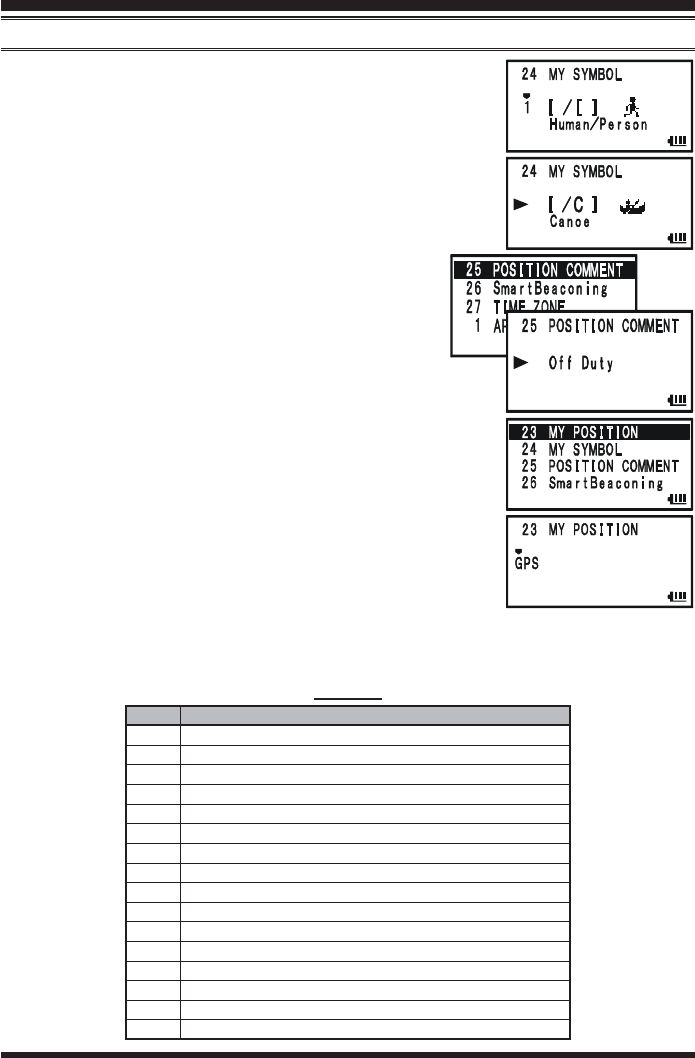
VX-8GR OPERATING MANUAL 71
13. Rotate the DIAL knob to select the desired one of the three
preset icons. To choose another icon, press the B key,
then rotate the DIAL knob to select the desired symbol after
having selected the preset icon. When you have completed
selecting the icon, press the B key again. You may
choose 1 of 46 different symbols.
14. Press the m key briefly to save the new setting.
15. Rotate the DIAL knob to select Set Mode Item 25:25:
25:25:
25:
POSITION COMMENTPOSITION COMMENT
POSITION COMMENTPOSITION COMMENT
POSITION COMMENT.
16. Press the m key briefly to enable adjustment of
this Set Mode Item.
17. Rotate the DIAL knob to select the desired comment.
18. Press the m key briefly to save the new setting.
19. Rotate the DIAL knob to select Set Mode Item 23: MY23: MY
23: MY23: MY
23: MY
POSITIONPOSITION
POSITIONPOSITION
POSITION.
20. Press the m key briefly to enable adjustment of this Set
Mode Item.
21. If you enter your position (Longitude/Latitude) manually
without using the built-in GPS receiver, perform the fol-
lowing procedures. Otherwise, select “GPSGPS
GPSGPS
GPS” by rotating the
DIAL knob and advance to the step 22.
APRS® OPERATION
PREPARATIONS
SSID
Non
-1
-2
-3
-4
-5
-6
-7
-8
-9
-10
-11
-12
-13
-14
-15
DETAILS
Home Station, Home Station IGate
Digipeater
Digipeater
Digipeater
HF to VHF Gateway
IGate (not Home Station)
Operation via Satellite
Hand-held Transceiver, such as VX-8DR
Maritime Mobile
Mobile
Operation via Internet
APRS touch-tone User (and the Occasional Balloons)
Portable Units, such as Laptops, Camp Sites etc.
Not Used
Trackers
HF Operation
SSID LIST
FCC ID: K6620415X20 / IC:511B-20415X20
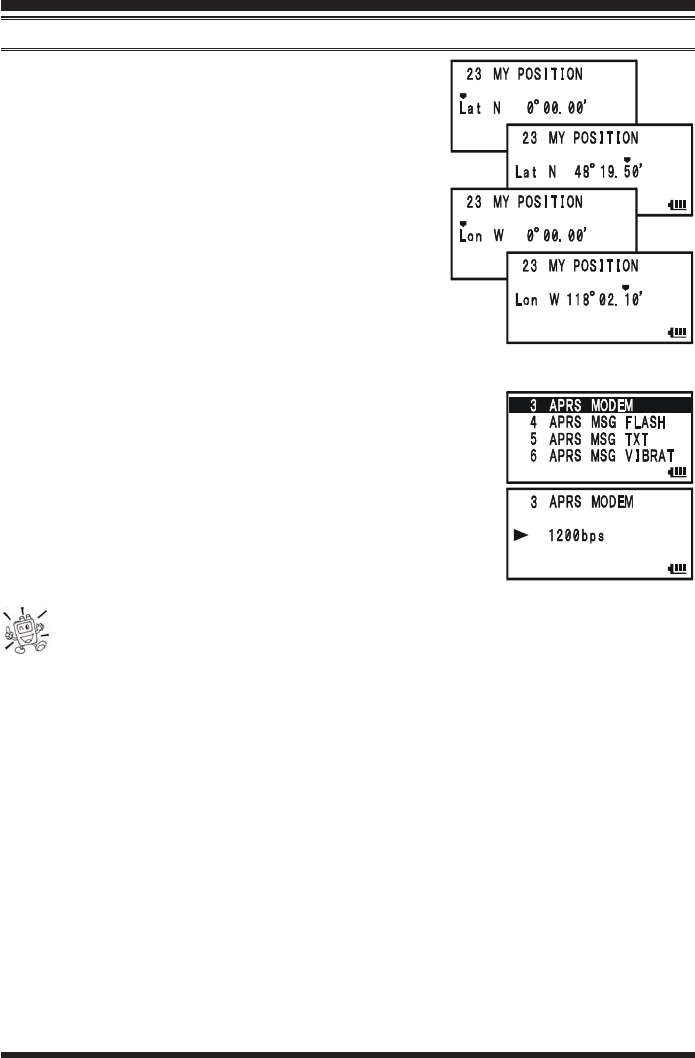
VX-8GR OPERATING MANUAL72
1) Select “LatLat
LatLat
Lat” by rotating the DIAL knob.
2) Press the M key to enable entering of your
latitude using the Decimal system.
3) Use the B and M keys to navigation to
each column and then use the DIAL knob to select the
desired numbers in each column. Repeat for each
column to complete your latitude entry.
4) Move the cursor to “LatLat
LatLat
Lat” using the B/M
key and then rotate the DIAL knob one click clock-
wise to select “LonLon
LonLon
Lon”. Enter your longitude using the same
procedure as described above, then advance to the next
step.
22. Press the m key briefly to save the new setting.
23. Rotate the DIAL knob to select Set Mode Item 3: APRS3: APRS
3: APRS3: APRS
3: APRS
MODEMMODEM
MODEMMODEM
MODEM.
24. Press the M key briefly to enable adjustment of this Set
Mode Item.
25. Rotate the DIAL knob to select “1200bps1200bps
1200bps1200bps
1200bps” (to activate the
AX.25 modem).
26. Press the PTT switch briefly to save the new setting and
exit from the APRS/GPS Set Mode.
You may memorize your current position as plotted by the GPS (up to ten points
can be saved). See page xx for details.
The VX-8GR provides many convenient functions for the APRS operation. Refer to the
“APRS/GPS Set Mode” chapter beginning with page xx for details.
APRS® OPERATION
PREPARATIONS
FCC ID: K6620415X20 / IC:511B-20415X20
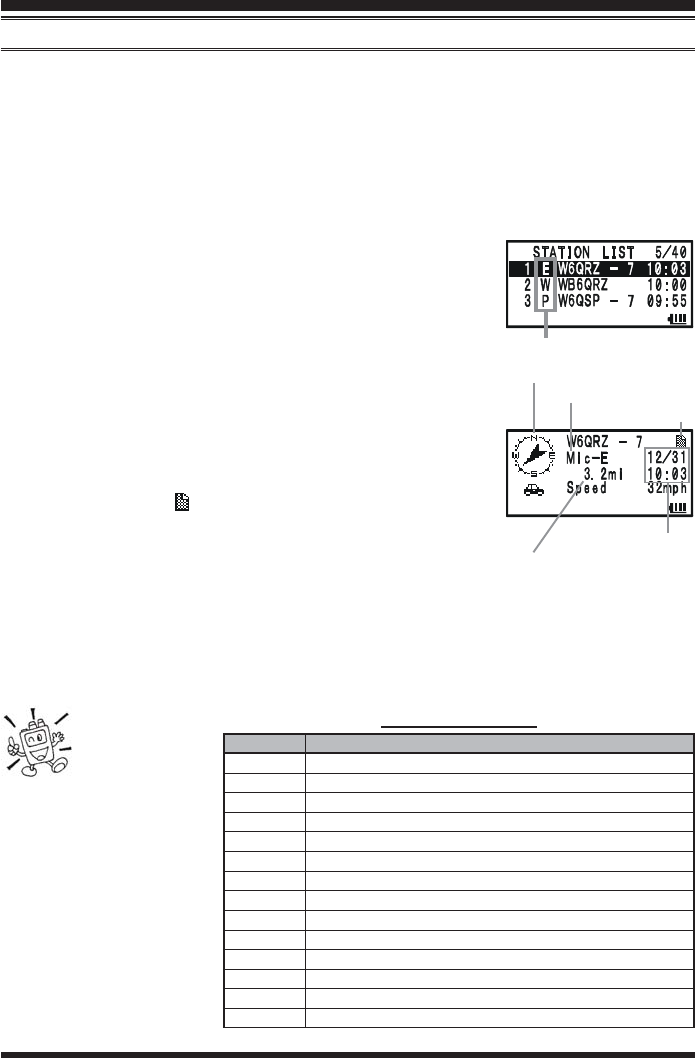
VX-8GR OPERATING MANUAL 73
RECEIVING AN APRS BEACON
1. Set the “B-Band” to the APRS frequency. 144.390 MHz is generally used in North
America. If you don’t know the APRS frequency of your country, ask your dealer.
The AX.25 modem cannot be activated in the “A-Band”.
2. Disable the Receiver Battery Saver via the Set Mode Item 73: SAVE RX73: SAVE RX
73: SAVE RX73: SAVE RX
73: SAVE RX.
When the Receiver Battery Saver is turned on, the VX-8GR can not reliably receive
an APRS Beacon.
3. When receive the APRS beacon, the alert beep will emit.
4. Press the m key several times until the “STATION LIST”
screen appears on the display. The “STATION LIST” screen
will save up to 50 stations. And the “STATION LIST” screen
sorts each station according to the received time.
5. To confirm the details of the received beacon, rotate the
DIAL knob (or press the a/b keys) to select the de-
sired station, then press the B key. The “Received Data
and Time”, “Distance and Direction of the station”, and other
information will be displayed.
When the “Status Text” is included in the Mic Encoder Sta-
tion Beacon, the “ ” icon appears at the upper right corner
of the display.
6. Rotate the DIAL knob (or press the a/b keys) to scroll
through additional lines or pages of the received informa-
tion.
7. Press the M key to display the “Raw” data of the received APRS beacon.
8. When the confirmation is finished, press the B key to return to the STATION
LIST screen.
When the VX-
8GR GPS signal
is interrupted;
such as when you enter into
a tunnel, the display main-
tains the direction on the
compass icon, distance to the
received station and the po-
sition information (Longi-
tude/Latitude) at the point
where the GPS signal was
lost.
APRS® OPERATION
STATION LIST CHARACTER
STATION LIST CHARACTER
RECEIVED DATE & TIME
STATUS TEXT “FLAG”
DISTANCE TO THE RECEIVED STATION
DIRECTION TO THE RECEIVED STATION
CHARACTER
E
Emg
P
p
W
w
O
o
I
i
K
k
S
?
DETAILS
Mic-E: Mic Encoder Station
Mic-E: Mic Encoder Station (Emergency Beacon)
Position (Fixed/Moving) Station
Position (Fixed/Moving) Station (Compressed Data)
Weather Station
Weather Station (Compressed Data)
Object Station
Object Station (Compressed Data)
Item Station
Item Station (Compressed Data)
Killed Station
Killed Station (Compressed Data)
Status Station
Other Station (Include Non-Decoding Station)
STATION LIST CHARACTER
FCC ID: K6620415X20 / IC:511B-20415X20
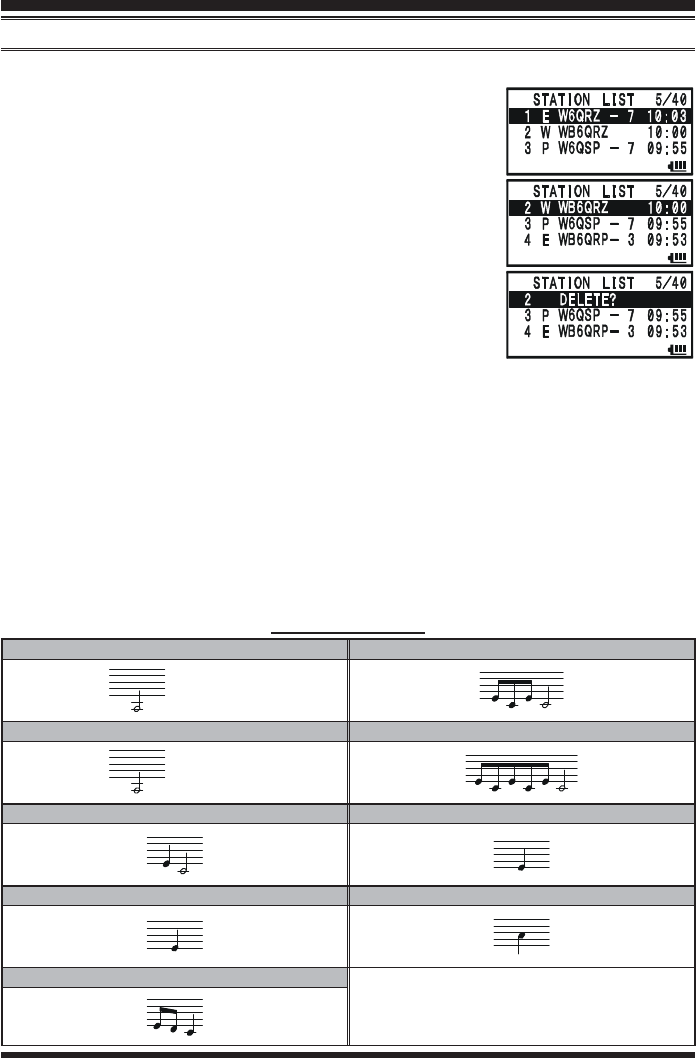
VX-8GR OPERATING MANUAL74
Deleting a Received Beacon from the “STATION LIST”
1. Press the m key several times until the STATION LIST
screen appears on the display.
2. Rotate the DIAL knob (or press the a/b keys) to se-
lect the beacon station to be deleted.
3. Press the c key. The confirmation message (DELETE?DELETE?
DELETE?DELETE?
DELETE?)
will appear on the display. Press the c key once more,
the selected beacon station will be deleted from the STA-
TION LIST.
APRS® OPERATION
RECEIVING AN APRS BEACON
EMERGENCY COMMENT Set
x 3 times
EMERGENCY COMMENT Received
x 12 times
BEACON Received (@Filter “ON”)
BEACON Received (@Filter “OFF”)
OWN BEACON (MY POSITION) Received
APRS ALERT BEEP LIST
MESSAGE Received
GROUP/BULLETIN MESSAGE Received
MESSAGE ACK Received
MESSAGE REJ Received
FCC ID: K6620415X20 / IC:511B-20415X20
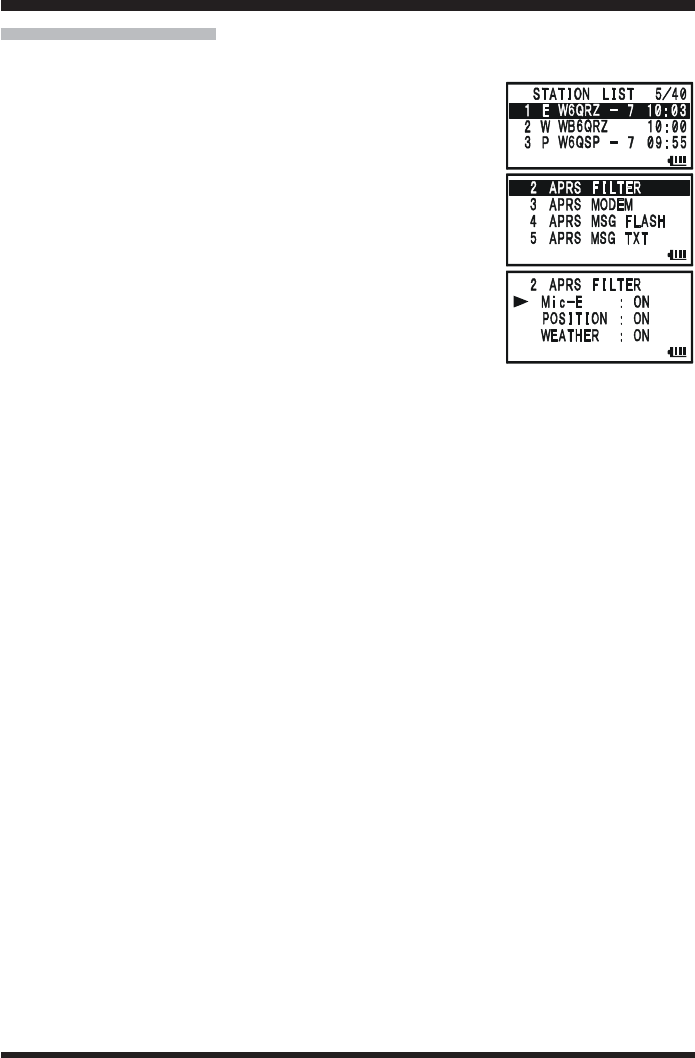
VX-8GR OPERATING MANUAL 75
APRS FILTER SETTING
The APRS filter option allows you to receive only specified types of the data.
1. Press the m key several times until the STATION LIST
screen appears on the display.
2. Press and hold the m key for one second to enter the
APRS/GPS Set Mode.
3. Rotate the DIAL knob to select Set Mode Item 2: APRS2: APRS
2: APRS2: APRS
2: APRS
FILTERFILTER
FILTERFILTER
FILTER.
4. Press the m key briefly to enable adjustment of this Set
Mode Item.
5. Press the a/b key to select the “Filter” you wish to
exclude, then rotate the DIAL knob to select “OFFOFF
OFFOFF
OFF”.
6. Repeat above steps and select “OFFOFF
OFFOFF
OFF” to any other filters you
wish to exclude.
7. When you have completed your selection, press the PTT switch to save the new
setting and exit to the STATION LIST screen.
APRS® OPERATION
FCC ID: K6620415X20 / IC:511B-20415X20
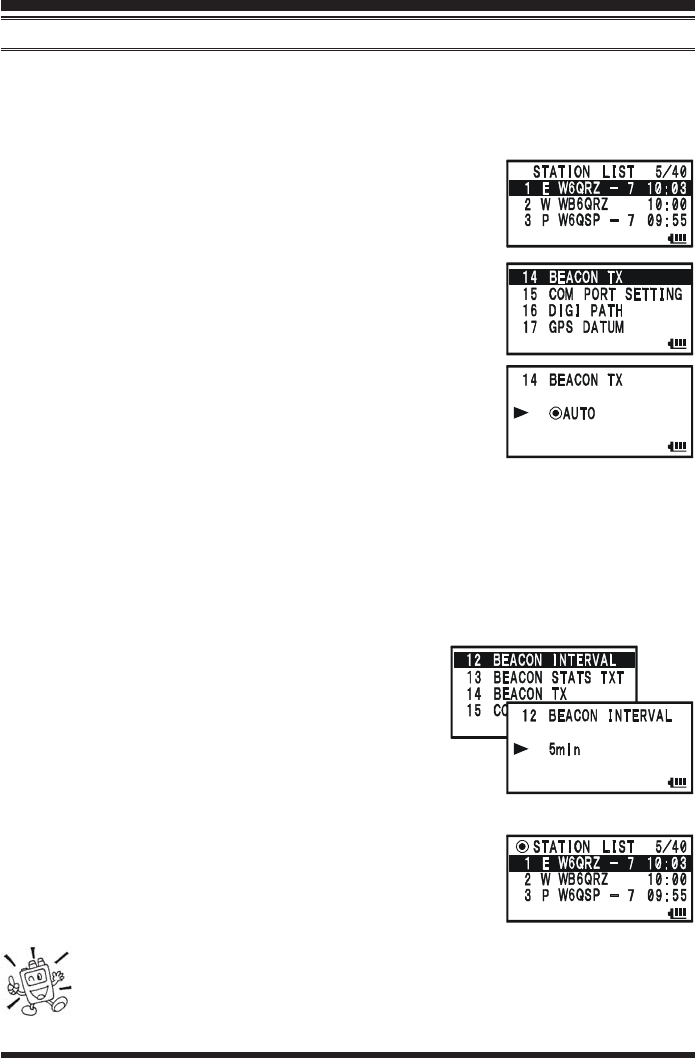
VX-8GR OPERATING MANUAL76
APRS® OPERATION
TRANSMIT AN APRS BEACON
To transmit your APRS Beacon, just press the d key.
The VX-8GR allows you to transmit your APRS Beacon automatically and repeatedly via
the APRS/GPS Set Mode.
1. Press the m key several times until the STATION LIST
screen appears on the display.
2. Press and hold the m key for one second to enter the
APRS/GPS Set Mode.
3. Rotate the DIAL knob to select Set Mode Item 14: BEA-14: BEA-
14: BEA-14: BEA-
14: BEA-
CON TXCON TX
CON TXCON TX
CON TX.
4. Press the m key briefly to enable adjustment of this Set
Mode Item.
5. Rotate the DIAL knob to select the desired “Auto” beacon
mode.
MANUALMANUAL
MANUALMANUAL
MANUAL: Disable Automatic Transmission.
AUTOAUTO
AUTOAUTO
AUTO: Enable Automatic Transmission.
Transmits your APRS beacon in accordance with the interval determined
by Set Mode Item 12: BEACON INTERVAL12: BEACON INTERVAL
12: BEACON INTERVAL12: BEACON INTERVAL
12: BEACON INTERVAL.
SMARTSMART
SMARTSMART
SMART: Enable Automatic Transmission.
Transmits your APRS beacon in accordance with the interval determined
by Set Mode Item 26: SmartBeaconing26: SmartBeaconing
26: SmartBeaconing26: SmartBeaconing
26: SmartBeaconing. This selection does not appear
unless Set Mode Item 26: SmartBeaconing26: SmartBeaconing
26: SmartBeaconing26: SmartBeaconing
26: SmartBeaconing is activated. See page ??? for
details.
6. Press the m key briefly, then rotate the DIAL knob
to select Set Mode Item 12: BEACON INTERVAL12: BEACON INTERVAL
12: BEACON INTERVAL12: BEACON INTERVAL
12: BEACON INTERVAL.
7. Press the m key briefly to enable adjustment of
this Set Mode Item.
8. Rotate the DIAL knob to select the desired interval time.
9. Press the PTT switch to save the new setting and exit to the
STATION LIST screen.
When the APRS Beacon mode is set to “AUTOAUTO
AUTOAUTO
AUTO”, the “” icon
will appear at the upper left corner of the display. Similarly,
when the APRS Beacon mode is set to “SMARTSMART
SMARTSMART
SMART”, the “”
icon will appear at the upper left corner of the display.
1) You may toggle the APRS Beacon mode between “MANUAL”, “AUTO”,
and “SMART” by pressing the M key.
2) When the APRS frequency is busy (Squelch is opened), the VX-8GR will not
transmit an APRS Beacon in manual or automatic modes. Insure that the squelch is closed.
FCC ID: K6620415X20 / IC:511B-20415X20
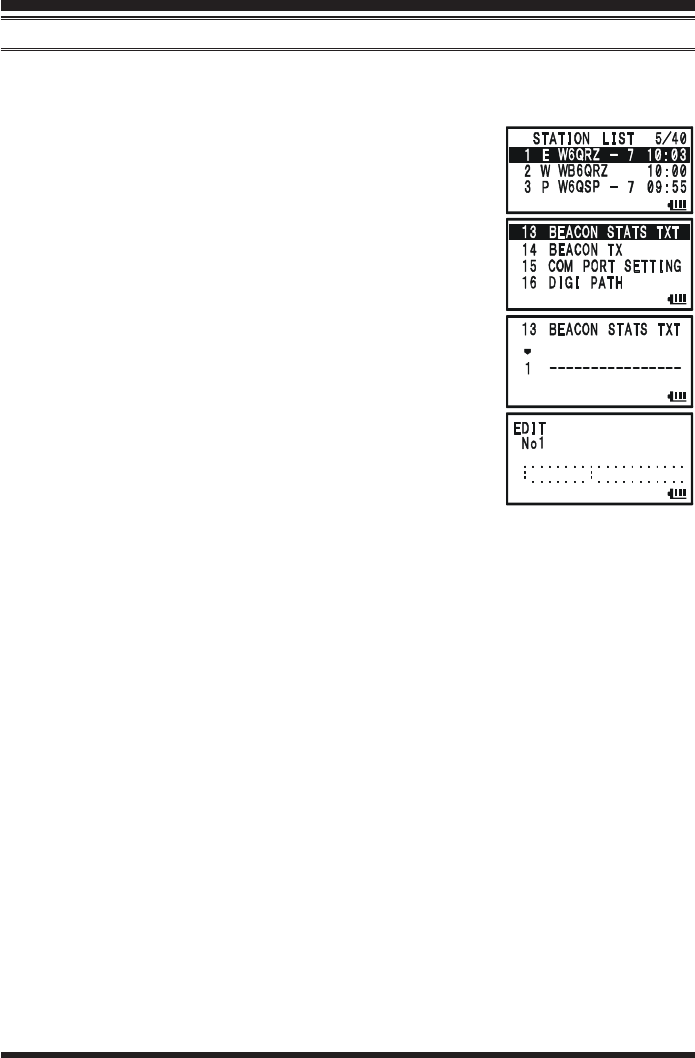
VX-8GR OPERATING MANUAL 77
You may store five Status Text Messages (up to the 60 characters for each memory), and
you may transmit one of these Status Text Messages with the APRS Beacon.
1. Press the m key several times until the STATION LIST
screen appears on the display.
2. Press and hold the m key for one second to enter the
APRS/GPS Set Mode.
3. Rotate the DIAL knob to select Set Mode Item 13: BEA-13: BEA-
13: BEA-13: BEA-
13: BEA-
CON STATS TXTCON STATS TXT
CON STATS TXTCON STATS TXT
CON STATS TXT.
4. Press the m key briefly to enable adjustment of this Set
Mode Item.
5. Rotate the DIAL knob to select the Status Text register
(11
11
1 - 55
55
5) you wish to store data to.
6. Press the M key briefly to begin comment entry into the
selected resister.
7. Rotate the DIAL knob (or press the keyboard) to select the
first character of the comment.
8. Press the M key to move to the next character.
9. Repeat steps 6 and 7 to program the remainder of the com-
ment.
10. If you make a mistake, press the B key to back-space the cursor, then re-enter the
correct character.
11. You may add/delete a character to a comment using the following technique.
1) If you want to clear any previous comments, press the a/b key to select the
“ALL CLEARALL CLEAR
ALL CLEARALL CLEAR
ALL CLEAR” then press the c key.
2) If you want to delete a previously-stored comment after the cursor, press the
a/b key to select “CLEARCLEAR
CLEARCLEAR
CLEAR” then press the c key.
3) If you want to add a character, press the a/b key to select “INSERTINSERT
INSERTINSERT
INSERT” then
press the c key.
Note: Some transceivers cannot receive the full 60-character message. We recom-
mend that you make the message as short as possible.
12. When you have completed your entry, press the PTT switch to save the new setting
and exit to the STATION LIST screen.
APRS® OPERATION
TRANSMIT AN APRS BEACON
FCC ID: K6620415X20 / IC:511B-20415X20
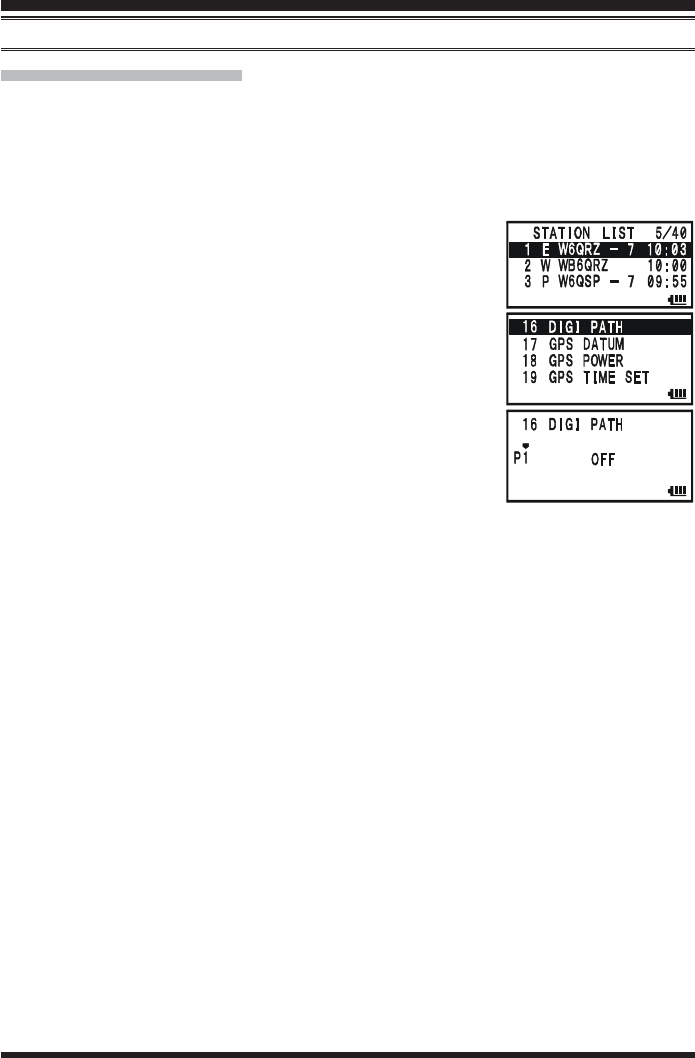
VX-8GR OPERATING MANUAL78
TRANSMIT AN APRS BEACON
DIGIPEATER PATH SETTING
The VX-8GR allows you to set up to eight digipeaters for the APRS Packet Path.
The VX-8GR is preset to “WIDE1-1” and “WIDE1-1, WIDE2-1” digi-path to insure that
your transmitted APRS Beacon is repeated by the new-N paradigm digipeaters. We rec-
ommend that you use this setting by default.
1. Press the m key several times until the STATION LIST
screen appears on the display.
2. Press and hold the m key for one second to enter the
APRS/GPS Set Mode.
3. Rotate the DIAL knob to select Set Mode Item 16: DIGI16: DIGI
16: DIGI16: DIGI
16: DIGI
PATHPATH
PATHPATH
PATH.
4. Press the m key briefly to enable adjustment of this Set
Mode Item.
5. Rotate the DIAL knob to select the Pass Number (P1P1
P1P1
P1 - P8P8
P8P8
P8)
you wish to set.
6. Press the M key briefly to begin callsign entry into the
selected path.
7. Rotate the DIAL knob (or press the keyboard) to select the first character of the callsign
(with SSID) of the digipeater.
8. Press the M key to move to the next character.
9. Repeats steps 7 and 8 to program the remainder of the callsign.
10. If you make a mistake, press the B key to backspace the cursor, then re-enter the
correct character.
11. When you have completed your entry, press the PTT switch to save the new setting
and exit to the STATION LIST screen.
APRS® OPERATION
FCC ID: K6620415X20 / IC:511B-20415X20
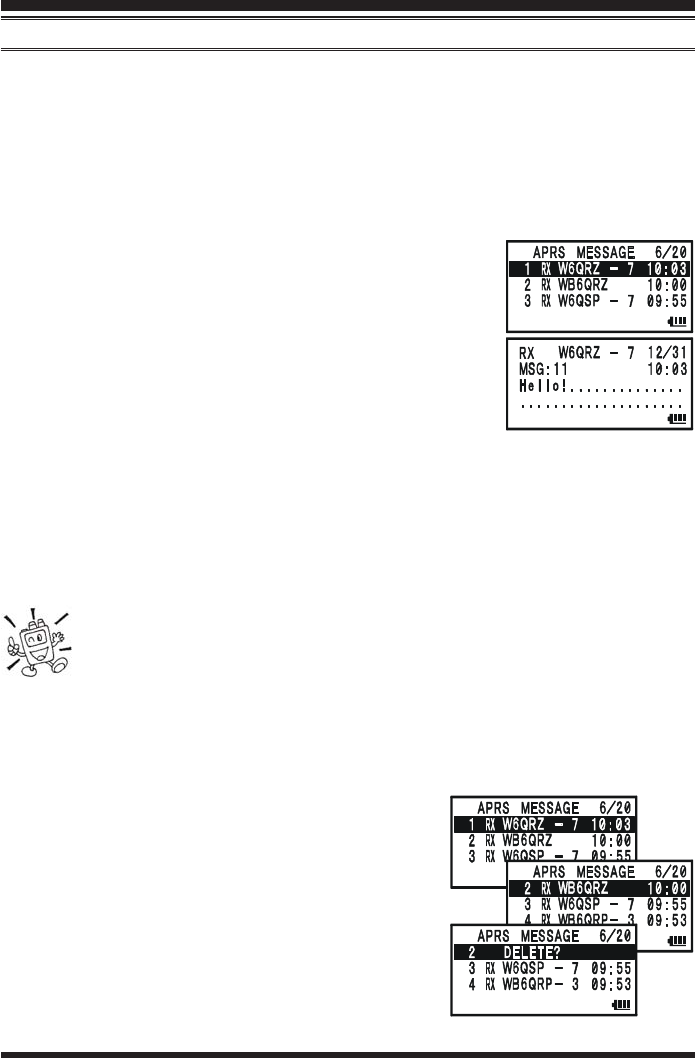
VX-8GR OPERATING MANUAL 79
RECEIVING AN APRS MESSAGE
1. Set the “B-Band” to the APRS frequency. 144.390 MHz is generally used in North
America. If you don’t know the APRS frequency for your country, ask your dealer.
The AX.25 modem is not activated in the “A-Band”.
2. Disable the Receiver Battery Saver from Set Mode Item 73: SAVE RX73: SAVE RX
73: SAVE RX73: SAVE RX
73: SAVE RX.
When the Receiver Battery Saver is turned on, the VX-8GR cannot reliably receive
APRS Messages.
3. When receive the APRS message, the alert beep will emit and white LED will blink.
4. Press the m key several times until the APRS MESSAGE
screen appears on the display.
The APRS MESSAGE screen stores up to 30 messages.
The messages are sorted according to the time the station
message is received. The latest message is stored into the
first message slot (First-in, First-out format).
5. To confirm the received message, rotate the DIAL knob (or
press the a/b keys) to select the desired message, then
press the B key.
6. Rotate the DIAL knob (or press the a/b keys) to scroll through additional lines
or pages of the received stations message.
7. Press the M key to display the receive message “Raw” data.
8. When you have finished reading your message, press the B key to return to the
APRS MESSAGE screen.
1) You may change the alert beep tone via APRS/GPS Set Mode Item 8:
APRS RINGER MSG.
2) You may change the blinking mode of the while LED via APRS/GPS Set
Mode Item 4: APRS MSG FLASH.
3) You may work the Vibrator function via APRS/GPS Set Mode Item 6: APRS MSG
VIBRAT when receive an APRS message.
Delete the Received Message from the “APRS MESSAGE” Screen
1. Press the m key several times until the APRS
MESSAGE screen appears on the display.
2. Rotate the DIAL knob (or press the a/b keys)
to select the message to be deleted.
3. Press the c key. The confirmation message (DELETE?DELETE?
DELETE?DELETE?
DELETE?)
will appear on the display. Press the c key once
more and the selected message will be deleted from
the APRS MESSAGE screen.
APRS® OPERATION
FCC ID: K6620415X20 / IC:511B-20415X20
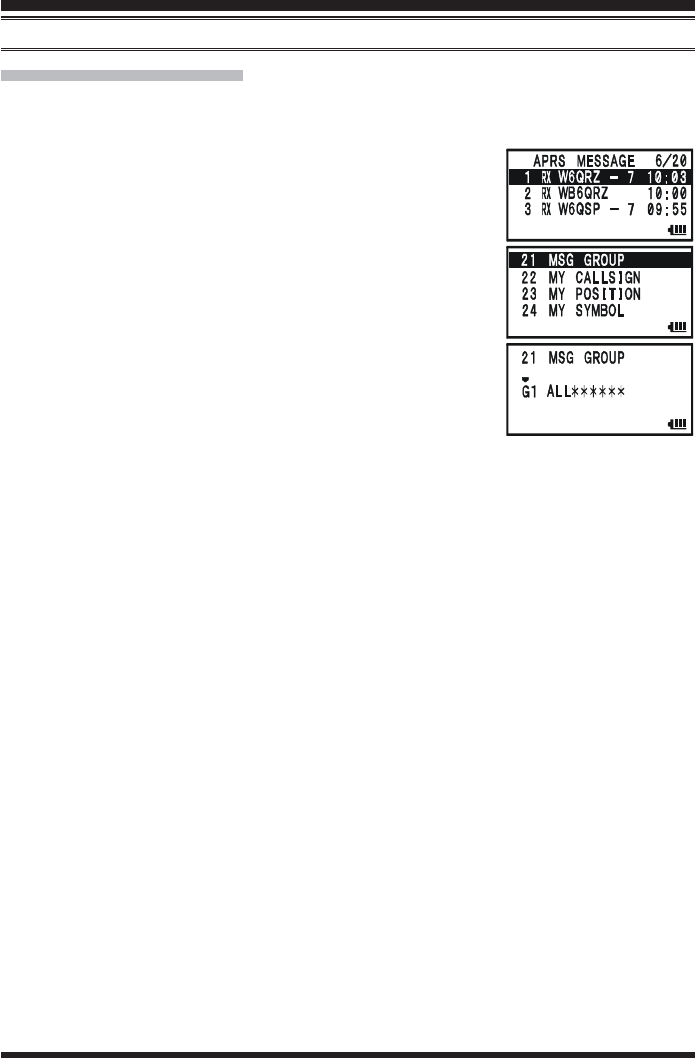
VX-8GR OPERATING MANUAL80
MESSAGE GROUP SETTING
The Message Group option allows you to choose to receive only specific types of message
information.
1. Press the m key several times until the APRS MESSAGE
screen appears on the display.
2. Press and hold the m key for one second to enter the
APRS/GPS Set Mode.
3. Rotate the DIAL knob to select Set Mode Item 21: MSG21: MSG
21: MSG21: MSG
21: MSG
GROUPGROUP
GROUPGROUP
GROUP.
4. Press the m key briefly to enable adjustment of this Set
Mode Item.
5. Press the a/b key to select the “Group” you wish to
utilize (G1 ALLG1 ALL
G1 ALLG1 ALL
G1 ALL, G2 CQG2 CQ
G2 CQG2 CQ
G2 CQ, G3 QSTG3 QST
G3 QSTG3 QST
G3 QST, or G4 YAESUG4 YAESU
G4 YAESUG4 YAESU
G4 YAESU).
6. If you add a new message group code and/or bulletin group
code, select “G5G5
G5G5
G5” (for message group code) or “B1B1
B1B1
B1” ~ “B3B3
B3B3
B3”
(for bulletin group code) by rotating the DIAL knob, then press the M key.
7. Use the M and B keys to navigate to each column, then use the DIAL knob to
select the desired characters/numbers in each column. Repeat for each column to
complete the message (up to 9 characters) or bulletin (up to 5 characters).
8. When you have completed your selection, press the PTT switch to save the new
setting and exit to the APRS MESSAGE screen.
APRS® OPERATION
RECEIVING AN APRS MESSAGE
FCC ID: K6620415X20 / IC:511B-20415X20
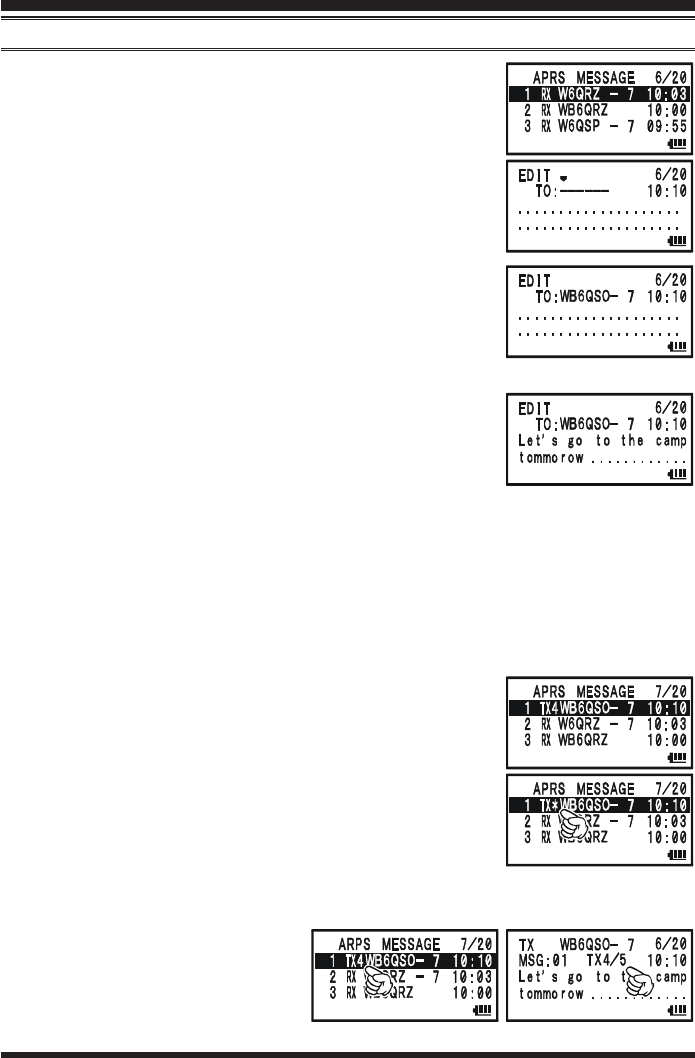
VX-8GR OPERATING MANUAL 81
APRS® OPERATION
TRANSMIT AN APRS MESSAGE
1. Press the m key several times until the APRS MESSAGE
screen appears on the display.
2. Press the h key to enter the “EDIT” mode.
3. Any previously stored message may be cleared using the
following procedures.
1) Press the B key
2) Press the a/b key to select the “ALL CLEARALL CLEAR
ALL CLEARALL CLEAR
ALL CLEAR”.
3) Press the c key.
4. Enter the callsign (with SSID) of the station you wish to
contact using the B/M key pad (select the cursor) or
turn the DIAL knob (select the number/letter).
5. When you have completed entering the callsign (and SSID),
press the M key briefly.
6. Enter the message using the B/M key pad (select
the cursor) or turn the DIAL knob (select the number/let-
ter). Available length is up to 67 characters. You may add/
delete a message/character using the following procedure.
a. If you want to add a previously stored message (determined through APRS/GPS
Set Mode item 5: APRS MSG TXT5: APRS MSG TXT
5: APRS MSG TXT5: APRS MSG TXT
5: APRS MSG TXT; see next page), press the a/b key to
select the “MSG TXT 1MSG TXT 1
MSG TXT 1MSG TXT 1
MSG TXT 1” through “MSG TXT 5MSG TXT 5
MSG TXT 5MSG TXT 5
MSG TXT 5” then press the c key.
b. If you want to delete the message after the cursor, press the a/b key to
select “CLEARCLEAR
CLEARCLEAR
CLEAR” then press the c key.
c. If you want to add a character, press the a/b key to select “INSERTINSERT
INSERTINSERT
INSERT” then
press the c key.
7. When the message entry is complete, press the d key to
transmit the message and return to the APRS MESSAGE
screen. The transmitted message is stored into the APRS
MESSAGE screen.
8. When an acknowledgment packet (“ack”) is received, the
beeper will sound and “” icon will appear on the display.
If an acknowledgment packet (“ack”) is not received, the
APRS message is transmitted repeatedly five times, once
each minute.
9. The remaining number of transmissions of the message is shown on the display. When
there is no acknowledgment packet
(“ack”) even if the APRS message
transmits five times, the “” (pe-
riod) icon (on the APRS MES-
SAGE screen) or “TXOUTTXOUT
TXOUTTXOUT
TXOUT” notation (on the Detailed Message screen) will appear on
FCC ID: K6620415X20 / IC:511B-20415X20
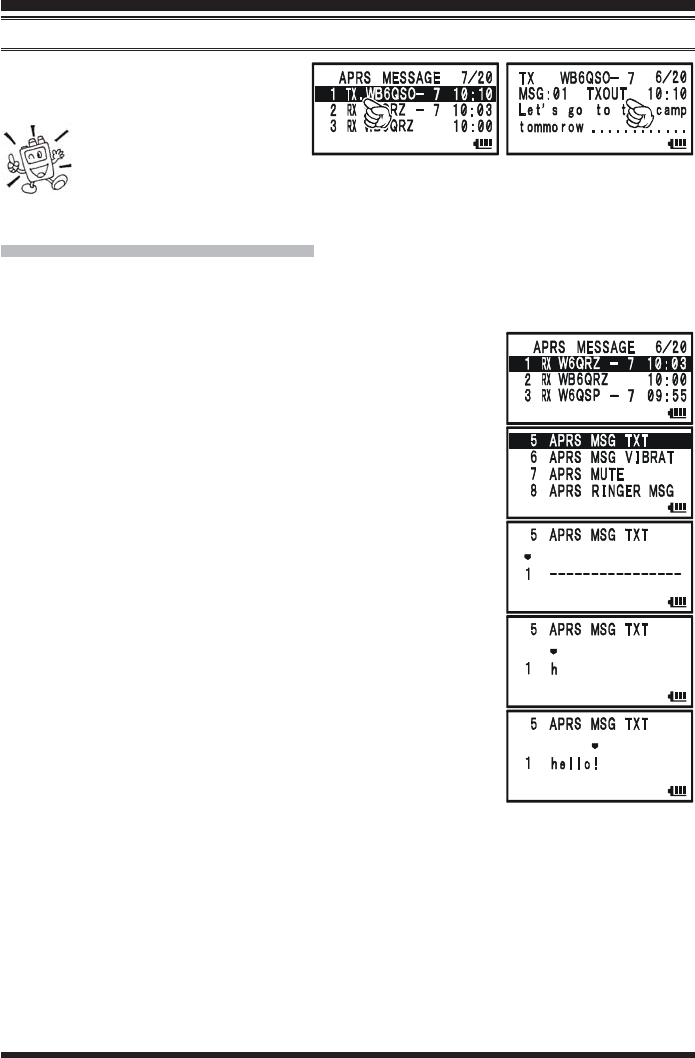
VX-8GR OPERATING MANUAL82
APRS® OPERATION
TRANSMIT AN APRS MESSAGE
the display, instead of the remain-
ing number of transmissions.
You may select the num-
bers and letters for the
callsign and message with the key buttons (1 through 9, and 0) in the
same way as labeling memories.
STORE THE FIXED FORM MESSAGE
The VX-8GR allows you to store five fixed form messages (up to 16 characters for each
message).
1. Press the m key several times until the APRS MESSAGE
screen appears on the display.
2. Press and hold the m key for one second to enter the
APRS/GPS Set Mode.
3. Rotate the DIAL knob to select Set Mode Item 5: APRS5: APRS
5: APRS5: APRS
5: APRS
MSG TXTMSG TXT
MSG TXTMSG TXT
MSG TXT.
4. Press the m key briefly to enable adjustment of this Set
Mode Item.
5. Rotate the DIAL knob to select the Message register (11
11
1 - 55
55
5)
you wish to store your message to.
6. Press the M key briefly to begin message entry into the
selected resister.
7. Rotate the DIAL knob (or press the keyboard) to select the
first character of the message.
8. Press the M key to move to the next character.
9. Repeats steps 7 and 8 to program the remainder of the mes-
sage.
10. If you make a mistake, press the B key to backspace
the cursor and re-enter the correct character.
11. When you have completed your message entry, press the PTT switch to save the new
setting and exit to the APRS MESSAGE screen.
FCC ID: K6620415X20 / IC:511B-20415X20
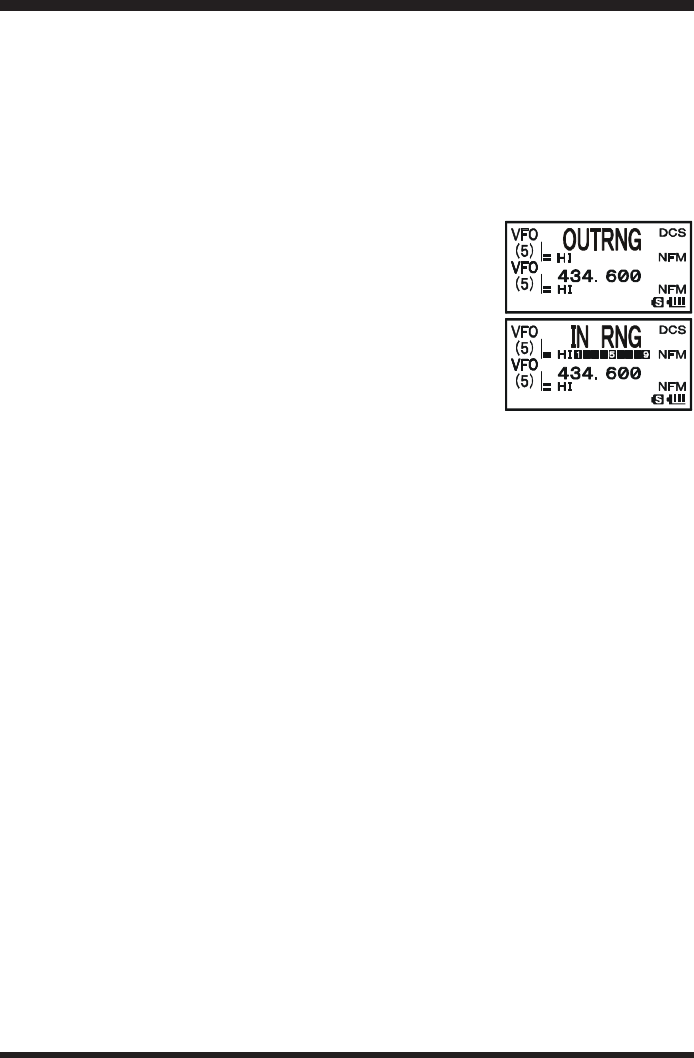
VX-8GR OPERATING MANUAL 83
The ARTSTM feature uses DCS signaling to inform both parties when you and another
ARTSTM-equipped station are within communications range. This may be particularly
useful during Search-and Rescue situations, where it is important to stay in contact with
other members of your group.
Both stations must set up their DCS codes to the same code number, then activate their
ARTSTM feature using the command appropriate for their radio. Alert ringers may be
activated, if desired.
Whenever you push the PTT, or every 25 (or 15) seconds after
ARTSTM is activated, your radio will transmit a signal which
includes a (subaudible) DCS signal for about 1 second. If the
other radio is in range, the beeper will sound (if enabled) and
the display will show “IN RNGIN RNG
IN RNGIN RNG
IN RNG” as opposed to the out of range
display “OUTRNGOUTRNG
OUTRNGOUTRNG
OUTRNG” in which ARTSTM operation begins.
Whether you talk or not, the polling every 15 or 25 seconds will
continue until you de-activate ARTSTM. Every 10 minutes, more-
over, you can have your radio transmit your callsign via CW, to comply with identifica-
tion requirements. When ARTSTM is de-activated, DCS will also be deactivated (if you
were not using it previously in non-ARTSTM operation).
If you move out of range for more than one minute (four pollings), your radio will sense
that no signal has been received, three beeps will sound, and the display will revert to
“OUTRNGOUTRNG
OUTRNGOUTRNG
OUTRNG”. If you move back into range, your radio will again beep, and the display will
change back to the “IN RNGIN RNG
IN RNGIN RNG
IN RNG” indication.
During ARTSTM operation, your operating frequency will continue to be displayed, but no
changes may be made to it or other settings; you must terminate ARTSTM in order to
resume normal operation. This is a safety feature designed to prevent accidental loss of
contact due to channel change, etc.
ARTSTM (AUTOMATIC RANGE TRANSPONDER SYSTEM)
FCC ID: K6620415X20 / IC:511B-20415X20
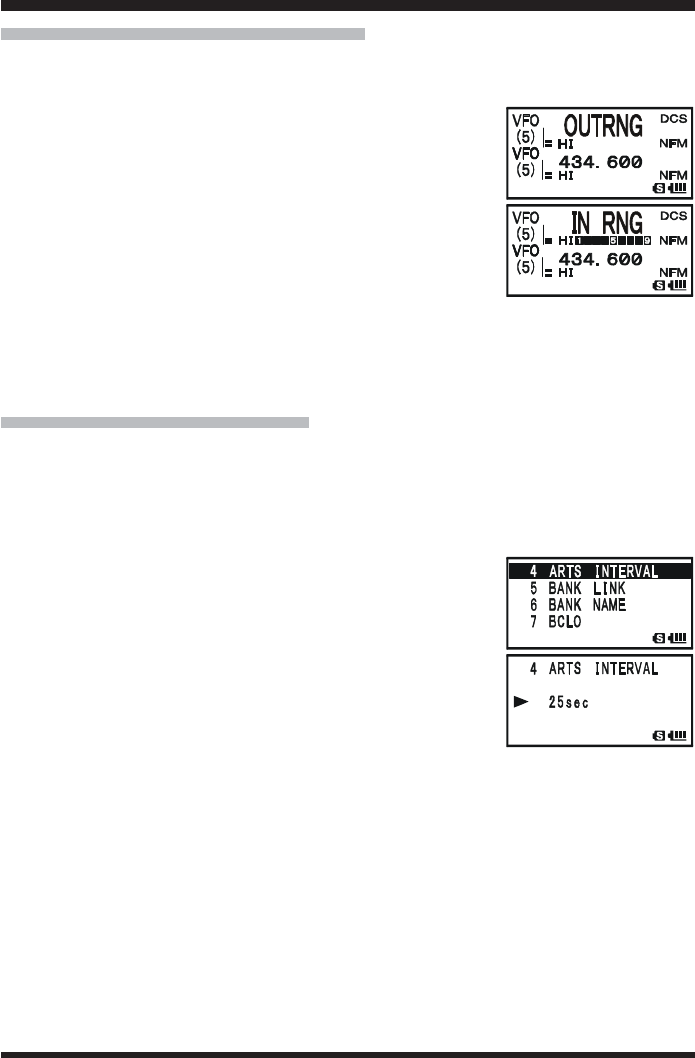
VX-8GR OPERATING MANUAL84
BASIC ARTSTM SETUP AND OPERATION
1. Set your radio and the other radio(s) to the same DCS code number, per the discussion
on page ??.
2. Press the f key, then press the 4 key. You will observe
the “OUTRNGOUTRNG
OUTRNGOUTRNG
OUTRNG” display on the LCD below the operating
frequency. ARTSTM operation has now commenced.
3. Every 25 seconds, your radio will transmit a “polling” call
to the other station. When that station responds with its own
ARTSTM polling signal, the display will change to “IN RNGIN RNG
IN RNGIN RNG
IN RNG”
to confirm that the other station’s polling code was received
in response to yours.
4. Press the 4 key to exit ARTSTM operation and resume normal functioning of the
transceiver.
ARTSTM won’t work if you have used the Lock feature to disable the PTT!
ARTSTM POLLING TIME OPTIONS
The ARTSTM feature may be programmed to poll every 25 seconds (default value) or 15
seconds. The default value provides maximum battery conservation, because the polling
signal is sent out less frequently. To change the polling interval:
1. Press and hold the m key for one second to enter the Set Mode.
2. Rotate the DIAL knob to select Set Mode Item 4: ARTS4: ARTS
4: ARTS4: ARTS
4: ARTS
INTERVALINTERVAL
INTERVALINTERVAL
INTERVAL.
3. Press the m key briefly to enable adjustment of this Set
Mode Item.
4. Rotate the DIAL knob to select the desired polling interval
(25sec25sec
25sec25sec
25sec or 15sec15sec
15sec15sec
15sec).
5. Press the PTT switch briefly to save the new setting and
exit to normal operation.
ARTSTM (AUTOMATIC RANGE TRANSPONDER SYSTEM)
FCC ID: K6620415X20 / IC:511B-20415X20
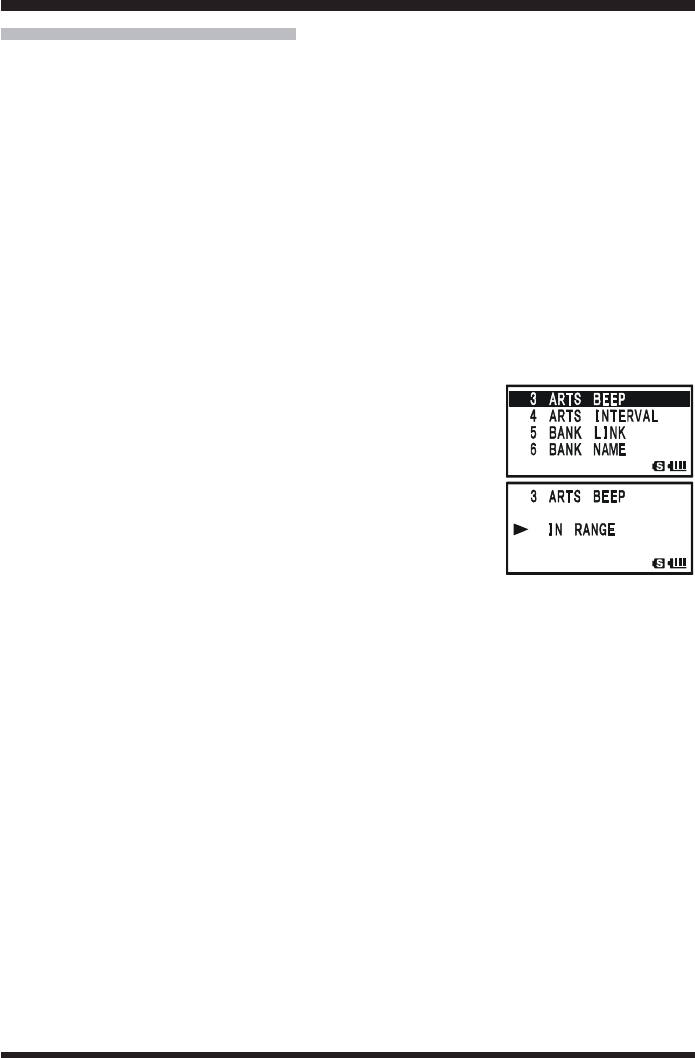
VX-8GR OPERATING MANUAL 85
ARTSTM ALERT BEEP OPTIONS
The ARTSTM feature allows two kinds of alert beeps (with the additional option of turning
them off), to alert you to the current status of ARTSTM operation. Depending on your
location and the potential annoyance associated with frequent beeps, you may choose the
Beep mode which best suits your needs. The choices are:
IN RANGEIN RANGE
IN RANGEIN RANGE
IN RANGE: The beeps are issued only when the radio first confirms that you are
within range, but does not re-confirm with beeps thereafter.
ALWAYSALWAYS
ALWAYSALWAYS
ALWAYS: Every time a polling transmission is received from the other station, the
alert beeps will be heard.
OFFOFF
OFFOFF
OFF: No alert beeps will be heard; you must look at the display to confirm
current ARTSTM status.
To set the ARTSTM Beep mode, use the following procedure:
1. Press and hold the m key for one second to enter the Set Mode.
2. Rotate the DIAL knob to select Set Mode Item 3: ARTS3: ARTS
3: ARTS3: ARTS
3: ARTS
BEEPBEEP
BEEPBEEP
BEEP.
3. Press the m key briefly to enable adjustment of this Set
Mode Item.
4. Rotate the DIAL knob to select the desired ARTS Beep mode
(see above).
5. Press the PTT switch briefly to save the new setting and
exit to normal operation.
ARTSTM (AUTOMATIC RANGE TRANSPONDER SYSTEM)
FCC ID: K6620415X20 / IC:511B-20415X20
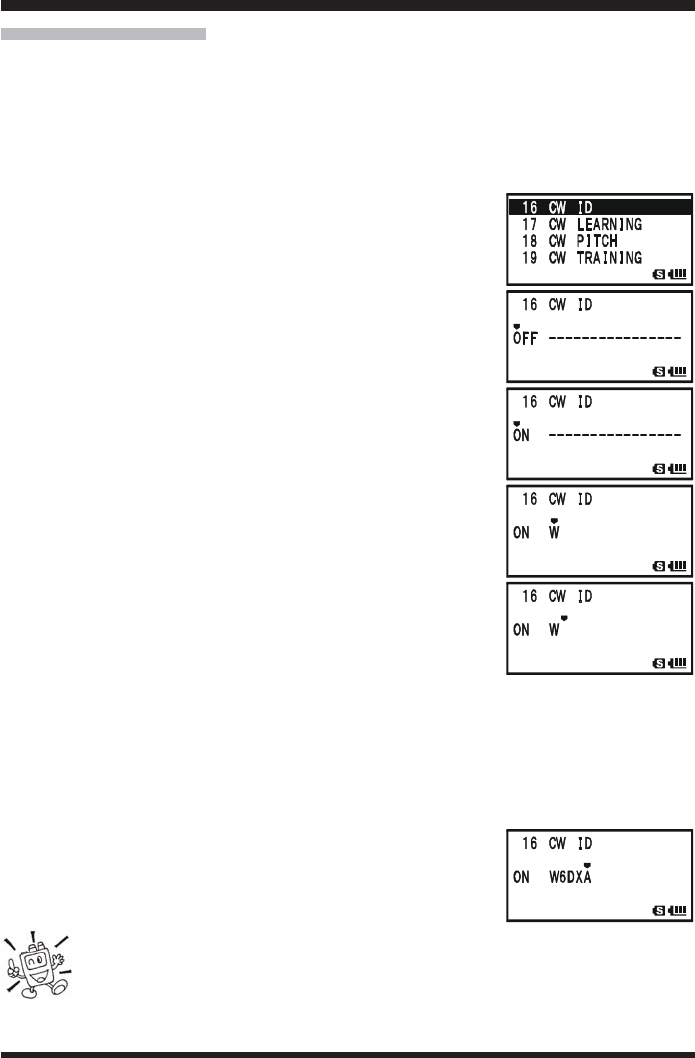
VX-8GR OPERATING MANUAL86
CW IDENTIFIER SETUP
The ARTSTM feature includes a CW identifier, as discussed previously. Every ten minutes
during ARTSTM operation, the radio can be instructed to send “DE (your callsign) K” if
this feature is enabled. The callsign field may contain up to 16 characters.
Here is how to program the CW Identifier:
1. Press and hold the m key for one second to enter the Set Mode.
2. Rotate the DIAL knob to select Set Mode Item 16: CW ID16: CW ID
16: CW ID16: CW ID
16: CW ID.
3. Press the m key briefly to enable adjustment of this Set
Mode Item.
4. Rotate the DIAL knob to select “ONON
ONON
ON” (to activate the CW
ID function).
5. Press the M key to enable programming your callsign.
Press and hold the h key for two seconds to clear any
previous callsign, if desired.
6. Rotate the DIAL knob or press the keyboard to set the first
letter or number in your callsign.
Example 1: Rotate the DIAL knob to select any of the 37
available characters.
Example 2: Press the 9 key repeatedly to toggle among
the five available characters associated with
that key: W X Y Z 9 W .....
7. Press the M key to move on to the next character, if
needed.
8. Repeat steps 6 and 7 as many times as necessary to com-
plete your callsign. Note that the “slant bar” (– • • – •) is
among the available characters, should you be a “portable”
station.
9. Press and hold the h key for two seconds to delete all data after the cursor that may
have been previously stored.
10. If you make a mistake, press the B key to backspace the cursor, then re-enter the
correct letter/number.
11. When you have entered your entire callsign, press the m
key briefly to confirm the callsign, then press the PTT switch
to save the settings and exit to normal operation.
1) You may check your work by monitoring the entered callsign. To do this,
repeat steps 1 - 3 above, then press the f key.
2) You may adjust the monitoring tone (CW sidetone pitch) via Set Mode
Item 18: CW PITCH. Available selections are 400 - 1000 Hz (50 Hz/step).
ARTSTM (AUTOMATIC RANGE TRANSPONDER SYSTEM)
FCC ID: K6620415X20 / IC:511B-20415X20
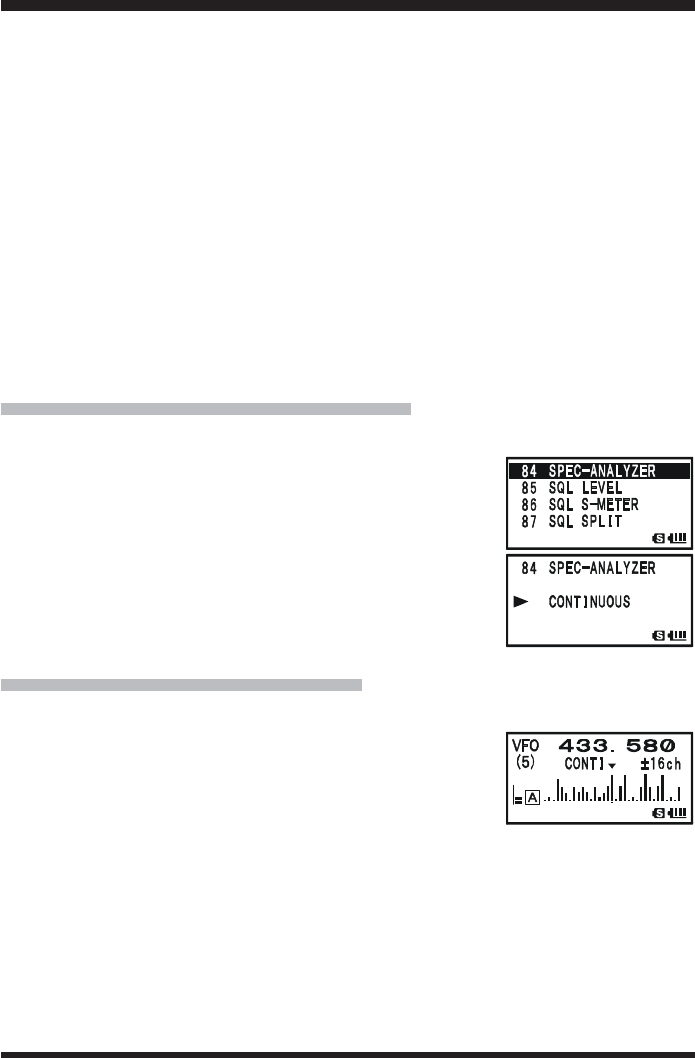
VX-8GR OPERATING MANUAL 87
The Spectrum Analyzer allows viewing operating activity on channels above or below the
current operating channel in the VFO mode.
The display indicates the relative signal strength on channels immediately adjacent to the
current operating frequency.
The Spectrum Analyzer feature can be activated only while the VX-8GR is in the “Mono”
band operation.
Three basic operating modes for the Spectrum Analyzer are available:
1Time1Time
1Time1Time
1Time: In this mode, the transceiver sweeps the current band once.
CONTINUOUSCONTINUOUS
CONTINUOUSCONTINUOUS
CONTINUOUS: In this mode, the transceiver sweeps the current band repeatedly until the
c key is pressed, or the Spectrum Analyzer is turned off.
Full TimeFull Time
Full TimeFull Time
Full Time: This mode is activated similar to a “CONTINUOUSCONTINUOUS
CONTINUOUSCONTINUOUS
CONTINUOUS” mode. However, the
transceiver outputs the audio of the center frequency () from a speaker
when the Spectrum Analyzer is activated between 108 ~ ??? MHz.
SETTING UP THE SPECTRUM ANALYZER MODE:
1. Press and hold the m key for one second to enter the Set Mode.
2. Rotate the DIAL knob to select Set Mode Item 84: SPEC-84: SPEC-
84: SPEC-84: SPEC-
84: SPEC-
ANALYZERANALYZER
ANALYZERANALYZER
ANALYZER.
3. Press the m key briefly to enable adjustment of this Set
Mode Item.
4. Rotate the DIAL knob to select the desired Spectrum Ana-
lyzer mode (see above).
5. Press the PTT switch momentarily to save the new setting
and exit to normal operation.
TO ACTIVATE THE SPECTRUM ANALYZER:
1. Set the radio to the VFO mode in the “Mono” band operation.
2. Press the f key, then press the 8 key to activate the
Spectrum Analyzer.
3. When the Spectrum Analyzer is activated, press the a or
b key to change the visible bandwidth. Available selec-
tions are ±5, ±9, ±16, ±24, and ±50 channels (default: ±16 channels). The visible
bandwidth, however, depends on the selected channel step size, so match the default
channel steps with the amateur band you are using.
4. To turn the Spectrum Analyzer off and operate on the center (displayed) channel,
press the c key to stop the sweep, if needed, then press the f key followed by
8 key.
SPECTRUM ANALYZER OPERATION
FCC ID: K6620415X20 / IC:511B-20415X20
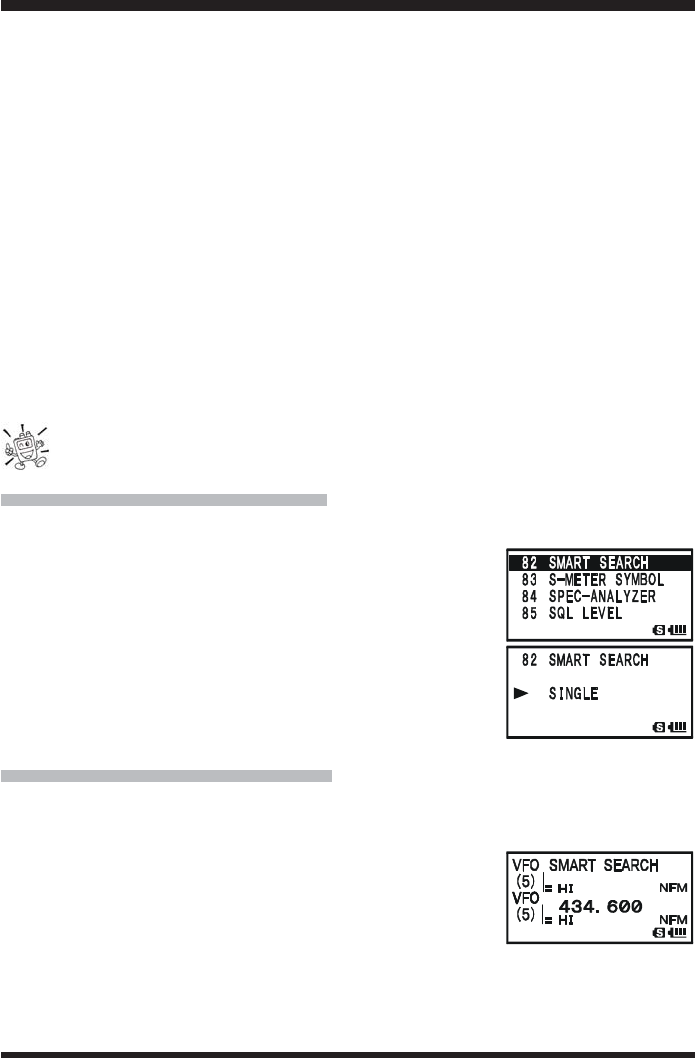
VX-8GR OPERATING MANUAL88
The Smart Search feature allows you to load frequencies automatically according to where
activity is encountered by your radio. When Smart Search is engaged, the transceiver will
search above and below your current frequency, storing active frequencies as it goes (with-
out stopping on them even briefly); these frequencies are stored into a special Smart Search
memory band, consisting of 31 memories (15 above the current frequency, 15 below the
current frequency, plus the current frequency itself).
Two basic operating modes for Smart Search are available:
SINGLESINGLE
SINGLESINGLE
SINGLE: In this mode, the transceiver will sweep the current band once in each
direction starting on the current frequency. All channels where activity is
present will be loaded into the Smart Search memories; whether or not
all 31 memories are filled, the search will stop after one sweep in each
direction.
CONTINUOUSCONTINUOUS
CONTINUOUSCONTINUOUS
CONTINUOUS: In this mode, the transceiver will make one pass in each direction as with
One-Shot searching; if all 31 channels are not filled after the first sweep,
however, the radio will continue sweeping until they are all filled.
The Smart Search feature can only be activated while the VX-8GR is operating
in the Mono band mode.
SETTING THE SMART SEARCH MODE
1. Press and hold the m key for one second to enter the Set Mode.
2. Rotate the DIAL knob to select Set Mode Item 82: SMART82: SMART
82: SMART82: SMART
82: SMART
SEARCHSEARCH
SEARCHSEARCH
SEARCH.
3. Press the m key briefly to enable adjustment of this Set
Mode Item.
4. Rotate the DIAL knob to select the desired Smart Search
mode (see above).
5. Press the PTT switch briefly to save the new setting and
exit to normal operation.
STORING SMART SEARCH MEMORIES
1. Set the radio to the VFO mode in the “Mono” band mode. Be sure that you have the
Squelch adjusted properly (so that band noise is quieted).
2. Press and hold the M key until the “SMART SEARCHSMART SEARCH
SMART SEARCHSMART SEARCH
SMART SEARCH”
notation will appear.
3. Press and hold the B key for one second to begin the
Channel Counter.
4. As active channels are detected, you will observe the number of “loaded” channels
increasing in the regular memory channel window.
5. Depending on the mode you set for Smart Search operation (“SINGLE” or “CON-
TINUOUS”), the Smart Search scan will eventually terminate, and the LCD will re-
SMART SEARCH OPERATION
FCC ID: K6620415X20 / IC:511B-20415X20

VX-8GR OPERATING MANUAL 89
vert to Smart Search Memory Channel “CNTCNT
CNTCNT
CNT.”
6. To recall the Smart Search memories, rotate the DIAL to
choose from among the Smart Search memories.
7. To return to normal operation, press the key.
Smart Search is a great tool when visiting a city for the first time. You don’t
need to spend hours looking up repeater frequencies from a reference
guidebook…just ask your VX-8GR where the action is!
SMART SEARCH OPERATION
FCC ID: K6620415X20 / IC:511B-20415X20
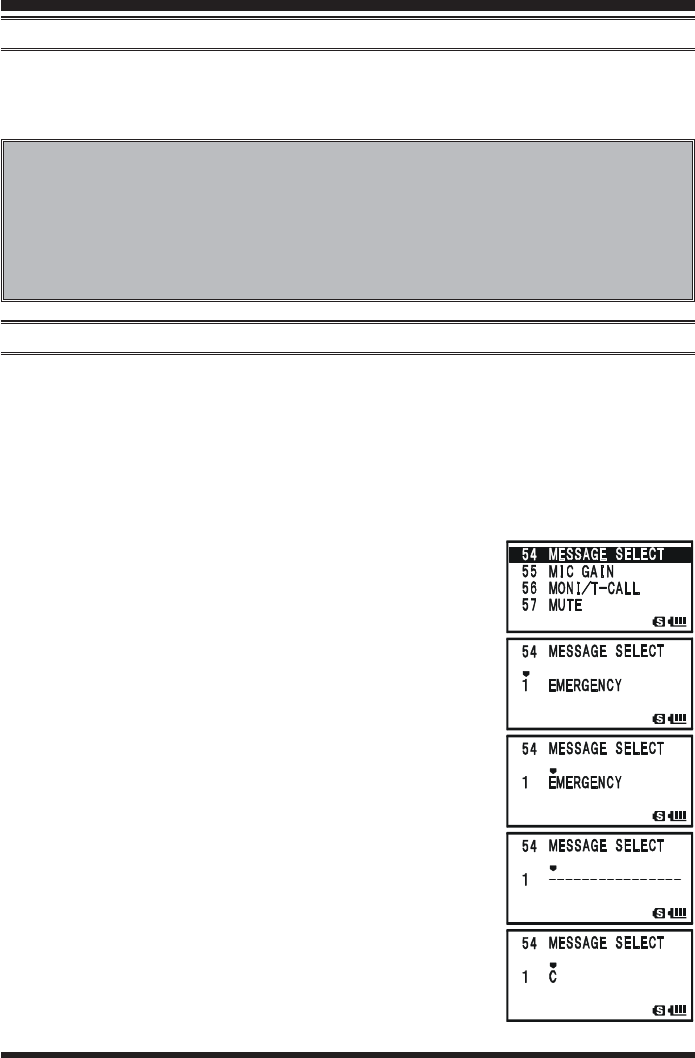
VX-8GR OPERATING MANUAL90
GENERAL
The VX-8GR provides a message feature, which sends a message (up to 16 characters)
instead of sending a voice. 20 different messages can be programmed, any one of them
can be selected and transmitted with your ID.
Note
The Message Feature requires that all members (1) use the Yaesu VX-8GR,
VX-8DR, VX-8R, VX-3R, FTM-10R/SR or FTM-350R transceiver, (2) store
the same messages into the message slots, (3) store the same member list into
the member box, and (4) set the same frequency.
Does not send the Message through a repeater.
PROGRAMMING A MESSAGE
(Requires all members set the same messages into the same message slots in the same
order.)
The VX-8GR has 20 message slots, including a factory-programmed message (EMER-
GENCY). The factory-programmed message of course can be overwritten at any time
with personalized messages.
1. Press and hold the m key for one second to enter the Set Mode.
2. Rotate the DIAL knob to select Set Mode Item 54: MES-54: MES-
54: MES-54: MES-
54: MES-
SAGE SELECTSAGE SELECT
SAGE SELECTSAGE SELECT
SAGE SELECT.
3. Press the m key briefly to enable adjustment of this Set
Mode Item.
4. Rotate the DIAL knob to select the desired Message slot
into which you wish to store a message. The LCD displays
the previously stored message.
5. Press the M key briefly to enable programming of the
message.
6. Press and hold in the h key for one second to clear the
previously stored message, if desired.
7. Rotate the DIAL knob or press the keyboard to set the first
character of the message you wish to store.
Example 1: Rotate the DIAL knob to select any of the 61
available characters.
Example 2: Press the 2 key repeatedly to toggle among
the four available characters associated with that
key: a b c A B C 2 a .....
8. Press the M key to move on to the next character, if
needed.
MESSAGE FEATURE
FCC ID: K6620415X20 / IC:511B-20415X20
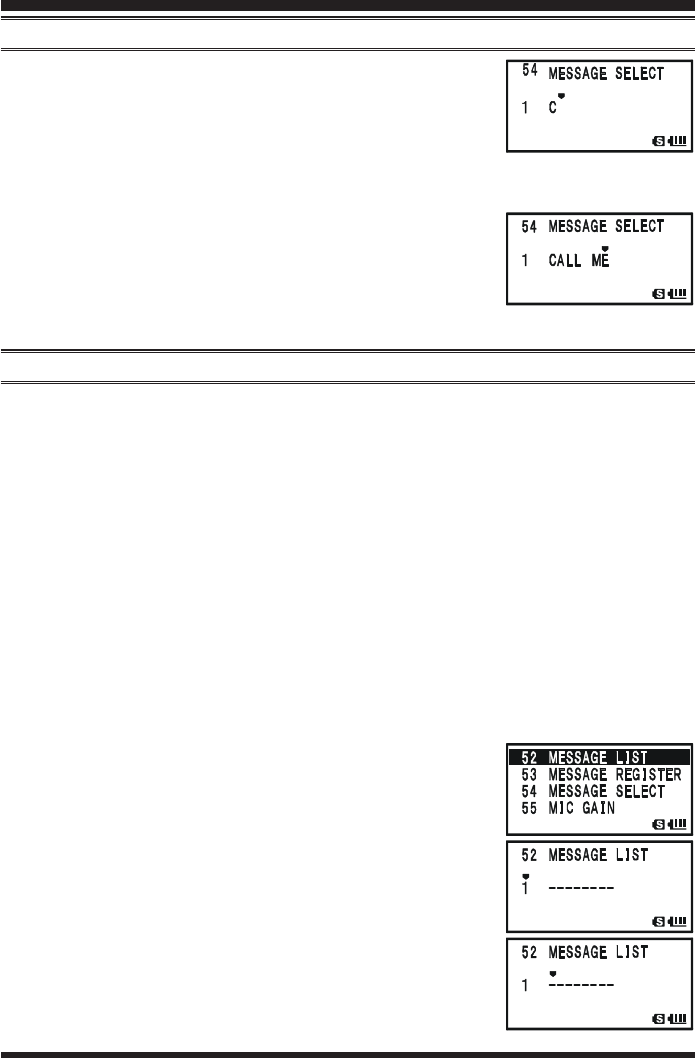
VX-8GR OPERATING MANUAL 91
9. Repeat steps 7 and 8 above to complete the message (up to
16 characters). If you make a mistake, press the B key
to move back to the incorrect character, then re-enter the
correct character.
10. Press and hold in the h key for one second to delete all data after the cursor that
may have been previously stored.
11. When the Message entry is complete, press the m key
briefly to save the new setting.
12. If you wish to store another message, repeat steps 3 through
11 above.
13. Press the PTT switch to exit to normal operation.
PROGRAMMING A MEMBER LIST
(Requires all members set the same member list (includes own ID) into the same member
box in the same order.)
It is possible to register a maximum of 20 persons, in order to identify the sender. When
you receive a message transfer, you will know who sent the message by the ID in the
register. In addition, your ID can be sent to the members when you transmit any messages
to them.
If all the members share the register information (ID), the message sender ID will be
shown on the display when receiving the message.
Even if no IDs are registered, the message function can work. However, in this case,
“MESSAGE1MESSAGE1
MESSAGE1MESSAGE1
MESSAGE1” though “MESSAGE20MESSAGE20
MESSAGE20MESSAGE20
MESSAGE20” will be displayed when receiving a message.
We recommend that you use your call sign for the member list.
1. Press and hold the m key for one second to enter the Set Mode.
2. Rotate the DIAL knob to select Set Mode Item 52: MES-52: MES-
52: MES-52: MES-
52: MES-
SAGE LISTSAGE LIST
SAGE LISTSAGE LIST
SAGE LIST.
3. Press the m key briefly to enable adjustment of this Set
Mode Item.
4. Rotate the DIAL knob to select the desired member box (11
11
1
~ 2020
2020
20) into which you wish to store a member ID. The LCD
will display the previously stored personal ID.
5. Press the M key briefly to enable programming of the
personal ID.
6. Press and hold in the h key for two seconds to clear the
previously stored personal ID, if desired.
7. Rotate the DIAL knob or press the keyboard to set the first
MESSAGE FEATURE
PROGRAMMING A MESSAGE
FCC ID: K6620415X20 / IC:511B-20415X20
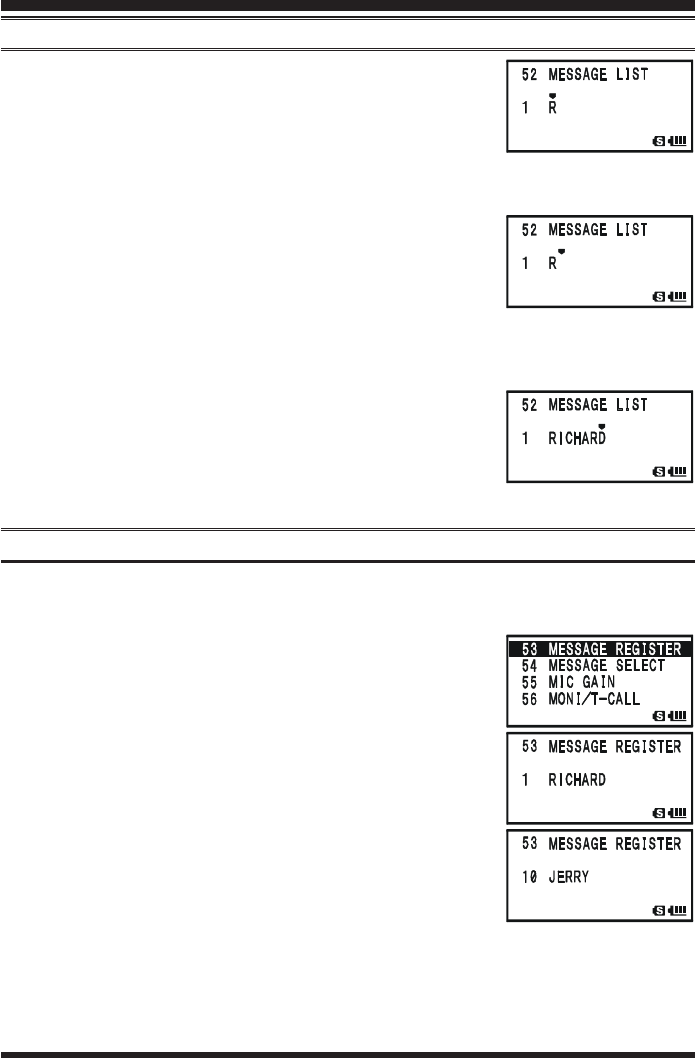
VX-8GR OPERATING MANUAL92
character of the message you wish to store.
Example 1: Rotate the DIAL knob to select any of the 61
available characters.
Example 2: Press the 7 key repeatedly to toggle among
the nine available characters associated with that key: p q r s
P Q R S 7 p .....
8. Press the M key to move on to the next character, if
needed.
9. Repeat steps 7 and 8 above to complete the personal ID (up
to 8 characters). If you make a mistake, press the B key
to move back to the incorrect character, then re-enter the correct character.
10. Press and hold in the h key for two seconds to delete all data after the cursor that
may have been previously stored.
11. When the personal ID entry is complete, press the m key
briefly to save the new setting.
12. If you wish to store another personal ID, repeat steps 3
through 10 above.
13. Press the PTT switch to exit to normal operation.
SET YOUR PERSONAL ID
You may choose your personal ID from the member list as follows.
1. Press and hold the m key for one second to enter the Set Mode.
2. Rotate the DIAL knob to select Set Mode Item 53: MES-53: MES-
53: MES-53: MES-
53: MES-
SAGE REGISTERSAGE REGISTER
SAGE REGISTERSAGE REGISTER
SAGE REGISTER.
3. Press the m key briefly to enable adjustment of this Set
Mode Item.
4. Rotate the DIAL knob to select the member box (11
11
1 ~ 2020
2020
20)
where your ID is stored.
5. Press the PTT switch briefly to save the new setting and
exit to normal operation.
MESSAGE FEATURE
PROGRAMMING A MEMBER LIST
FCC ID: K6620415X20 / IC:511B-20415X20
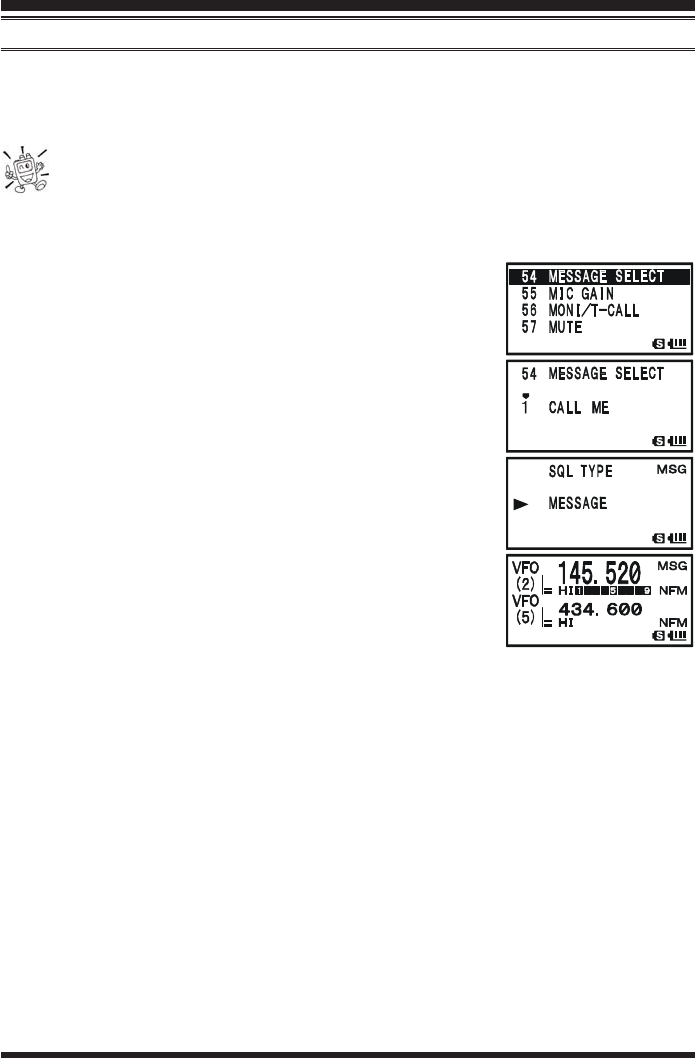
VX-8GR OPERATING MANUAL 93
SENDING A MESSAGE
The registered message can be sent to the members who are receiving on the coordination
frequency. When a message is sent, the transmitter’s ID will be sent also, and the receiver
can identify who sent the message.
The “Personal ID” setting (described in the previous paragraph) is required for
the transmitter’s ID to be shown with the received message.
1. Set the radio to the coordination frequency.
2. Press and hold the m key for one second to enter the Set Mode.
3. Rotate the DIAL knob to select Set Mode Item 54: MES-54: MES-
54: MES-54: MES-
54: MES-
SAGE SELECTSAGE SELECT
SAGE SELECTSAGE SELECT
SAGE SELECT.
4. Press the m key briefly to enable adjustment of this Set
Mode Item.
5. Rotate the DIAL knob to select the desired Message slot
you wish to send.
6. Press the PTT switch to exit to normal operation.
7. Press the f key, then press the M key. This provides a
“Short-cut” to Menu Item 88: SQL TYPE88: SQL TYPE
88: SQL TYPE88: SQL TYPE
88: SQL TYPE.
8. Rotate the DIAL knob until “MESSAGEMESSAGE
MESSAGEMESSAGE
MESSAGE” appears on the
display; this activates the Message feature.
9. Press the PTT switch to exit from the Menu mode and acti-
vate the Message feature. When the Message feature is ac-
tivated, the “MSGMSG
MSGMSG
MSG” notation will appear on the display.
10. Press the PTT switch again (without speaking into the mi-
crophone) to transmit the selected message on the coordina-
tion frequency. It takes approximately 6 seconds to transmit the message.
MESSAGE FEATURE
FCC ID: K6620415X20 / IC:511B-20415X20
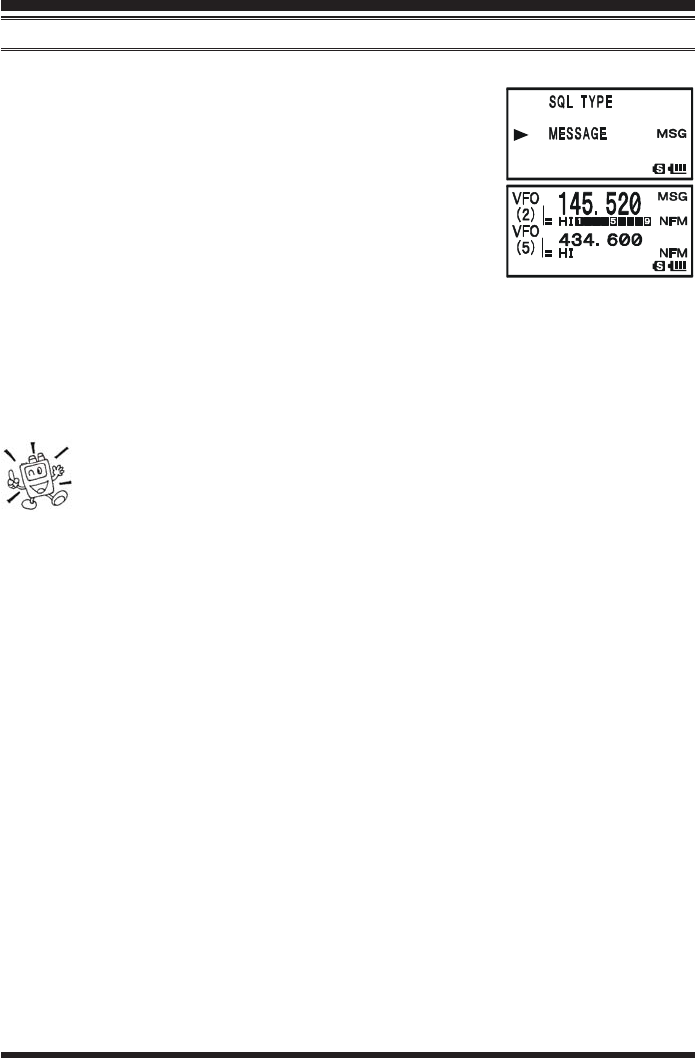
VX-8GR OPERATING MANUAL94
MESSAGE FEATURE
RECEIVING A MESSAGE
1. Set the radio to the coordination frequency.
2. Press the f key, then press the M key. This provides a
“Short-cut” to Set Mode Item 88: SQL TYPE88: SQL TYPE
88: SQL TYPE88: SQL TYPE
88: SQL TYPE.
3. Rotate the DIAL knob until “MESSAGEMESSAGE
MESSAGEMESSAGE
MESSAGE” appears on the
display; this activates the Message feature.
4. Press the PTT switch to exit from the Set Mode and acti-
vate the Message feature. When the Message feature is ac-
tivated, the “MSGMSG
MSGMSG
MSG” notation will appear on the display.
5. When you receive a message: a beep sounds, the LED light
blinks white, and [“Message” FROMFROM
FROMFROM
FROM “sending station’s ID”] scrolls on the display.
6. Press any key (except g key) to clear the received message, and wait for a new
message.
To disable the Message feature, repeat the above procedure, rotating the DIAL knob to
select “OFFOFF
OFFOFF
OFF” in step 3 above.
If you enable the CTCSS/DCS/EPCS Bell feature or CTCSS/DCS/EPCS
Vibrator Operation (described previously), you can tell that you are receiv-
ing a message by the ringing “bell” sound alert or vibrating the transceiver.
FCC ID: K6620415X20 / IC:511B-20415X20

VX-8GR OPERATING MANUAL 95
EMERGENCY CHANNEL OPERATION
The VX-8GR includes an “Emergency” feature, which may be useful if you have some-
one monitoring on the same frequency as your transceiver’s UHF “Home” channel. See
page ?? for details on setting the Home channel.
The “Emergency” feature is activated by pressing and holding in the h key for one
second.
When this is done, (A) the radio is placed on the UHF amateur band Home channel, (B) it
emits a loud “Alarm” sound (the volume is controlled by rotating the DIAL knob while
pressing and holding the g key), (C) it flashes the LED light in white, (D) if you press
the PTT switch, you will disable the Emergency feature temporarily. You can then trans-
mit on the UHF Home channel, and (E) two seconds after the PTT switch release, the
Emergency feature will resume.
To disable the “Emergency” feature, press and hold the h key for one second or turn the
radio Off by pressing and holding in the p(PWR) switch for one second.
Use this feature if you are out for a walk and want a quick way of alerting a family
member to a dangerous situation. The alarm sound may discourage an attacker and allow
you to escape.
1) Be sure to arrange with a friend or family member to be monitoring on the
same frequency, as there will be no identification sent via the Emergency
alarm sound. And do not transmit the alarm tone except in a true emergency!
2) The LED light may be changed to another function via Set Mode Item 29: EMER-
GENCY SELECT; see page xx.
EMERGENCY FEATURE
FCC ID: K6620415X20 / IC:511B-20415X20

VX-8GR OPERATING MANUAL96
EMERGENCY FEATURE
EMERGENCY AUTOMATIC ID (EAI) FEATURE
The Emergency Automatic ID (EAI) feature can be used to aid in searching for persons
who are incapacitated in disasters like earthquakes, especially search-and-rescue person-
nel who may have become injured in a debris field. When using the EAI feature, a searcher
transmits a unique command (CTCSS tone pair), which will automatically cause the in-
jured party’s radio to transmit, so others may perform direction-finding and effect a res-
cue. The incapacitated party may not be able to speak or even press the PTT switch. The
callsign of the incapacitated person will also be transmitted, to assist the rescue team.
If an emergency group is working in a dangerous area, all members should engage the
EAI feature on their transceiver, so that others can assist a fallen team member, if neces-
sary.
The Emergency Automatic ID (EAI) Feature has two operating modes: (1) Interval mode
and (2) Continuous mode.
In the Interval mode (when the VX-8GR receives the CTCSS tone pair), the radio will
automatically transmit a brief (0.5 second) beep tone every 2.5 seconds until the EAI
timer expiration.
In the continuous mode, the radio will automatically transmit continuously (with maxi-
mum microphone gain), until the EAI timer expiration.
The EIA is activated when the CTCSS tone pair stored in the Receiving Pager Code Memory
(configured via Set Mode Item 62: PAGE CODE-RX62: PAGE CODE-RX
62: PAGE CODE-RX62: PAGE CODE-RX
62: PAGE CODE-RX) is received for 5 seconds on the
frequency, which is stored in Memory Channel “EAIEAI
EAIEAI
EAI”. It is NOT necessary for the inca-
pacitated person to press the PTT switch.
If your call sign is stored in the radio and the CW identifier is enabled via Set Mode Item
16: CW ID16: CW ID
16: CW ID16: CW ID
16: CW ID, the radio will transmit your callsign on the air when the EAI feature is first
activated by the remote page, and every 10 minutes thereafter. The “callsign” ID can be
changed to any desired sequence of characters, such as a name. After sending the callsign
or name, the radio will repeatedly transmit three tones for a user-defined period of time
(between 1 and 30 minutes). The callsign or name will be transmitted every 10 minutes.
The Emergency Automatic ID (EAI) Feature requires that you (1) store the CTCSS Tone
Pair into the Receiving Pager Memory (see page xx for procedure), and (2) store the
desired UHF coordination frequency into Memory Channel “EAIEAI
EAIEAI
EAI” (see page 47 for proce-
dure).
FCC ID: K6620415X20 / IC:511B-20415X20
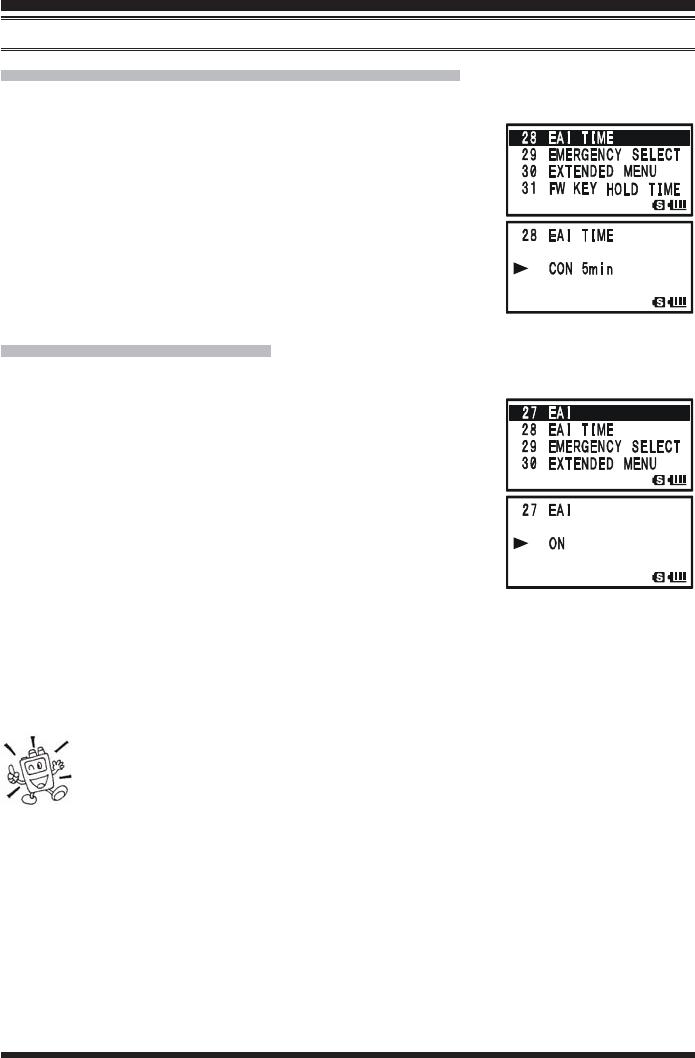
VX-8GR OPERATING MANUAL 97
SELECTING THE EAI MODE AND ITS TRANSMIT TIME
1. Press and hold the m key for one second to enter the Set Mode.
2. Rotate the DIAL knob to select Set Mode Item 28: EAI TIME28: EAI TIME
28: EAI TIME28: EAI TIME
28: EAI TIME.
3. Press the m key briefly to enable adjustment of this Set
Mode Item.
4. Rotate the DIAL knob to select the desired EAI mode (In-
terval EAI “INTINT
INTINT
INT” or Continuous EAI “CONCON
CONCON
CON”) and transmit
time (11
11
1-1010
1010
10, 1515
1515
15, 2020
2020
20, 3030
3030
30, 4040
4040
40, and 5050
5050
50 minutes).
5. Press the PTT switch briefly to save the new setting and
exit to normal operation.
ACTIVATING THE EAI FEATURE
1. Press and hold the m key for one second to enter the Set Mode.
2. Rotate the DIAL knob to select Set Mode Item 27: EAI27: EAI
27: EAI27: EAI
27: EAI.
3. Press the m key briefly to enable adjustment of this Set
Mode Item.
4. Rotate the DIAL knob to select “ONON
ONON
ON” (thus activating the
EAI feature).
5. Press the PTT switch briefly to save the new setting and
exit to normal operation (with EAI feature “ON”).
When the EAI feature is activated, the “EAIEAI
EAIEAI
EAI” icon and the Band
Number (or memory channel number) will appear alternately in the Memory Channel
Number Display Slot of the display.
To disable the EAI feature, just repeat the above procedure, rotating the DIAL knob to
select “OFFOFF
OFFOFF
OFF” in step “4” above.
The VX-8GR will ignore the EAI feature when (1) the squelch is open, (2)
there is an incoming signal on the operating frequency, (3) the operating
frequency is the same as the frequency which is stored in the Memory Chan-
nel “EAI,” or (4) a VHF frequency is stored in Memory Channel “EAI”.
EMERGENCY FEATURE
EMERGENCY AUTOMATIC ID (EAI) FEATURE
FCC ID: K6620415X20 / IC:511B-20415X20
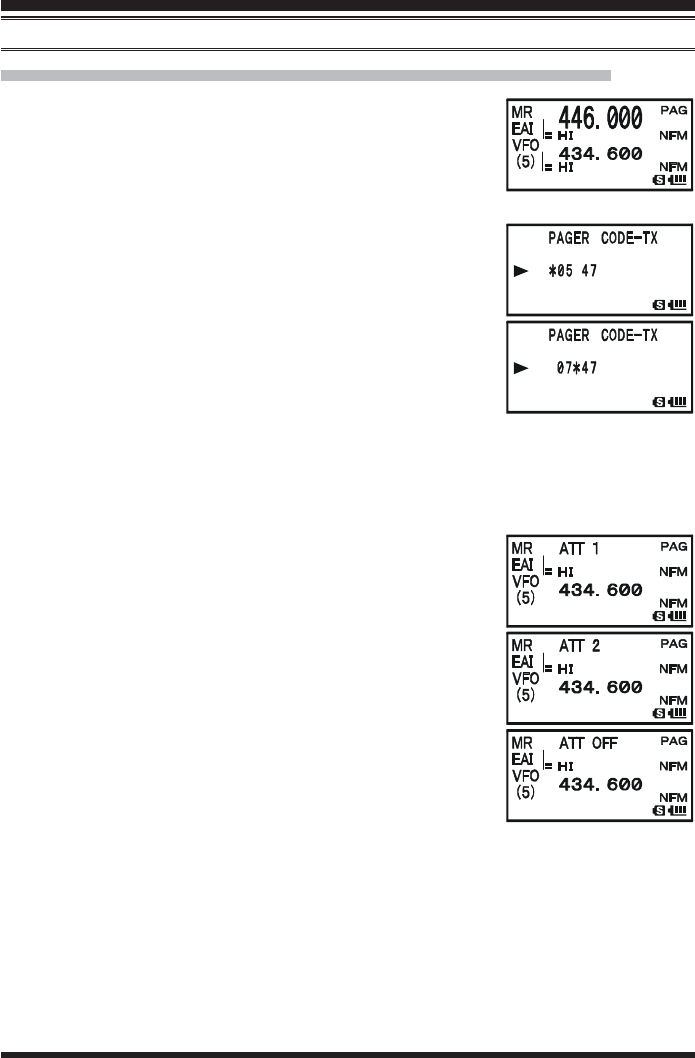
VX-8GR OPERATING MANUAL98
TO LOCATE AN UNRESPONSIVE OPERATOR USING THE EAI FEATURE
1. Recall the Memory Channel “EAIEAI
EAIEAI
EAI” (must be the same as the
searched person’s radio), which is found in the next to the
last “regular” memory channel.
2. Set the CTCSS tone pair to the same CTCSS tone pair stored
in the Receiving Pager Code Memory of the missing person’s radio.
1) Press the f key, then press the 2 key. This pro-
vides a “Short-cut” to Set Mode Item 63: PAGE CODE-63: PAGE CODE-
63: PAGE CODE-63: PAGE CODE-
63: PAGE CODE-
TXTX
TXTX
TX.
2) Rotate the DIAL knob to select the first tone.
3) Press the M key.
4) Rotate the DIAL knob to select the second tone.
5) Press the 2 key to save the new setting and exit from
setting mode.
3. Press and hold in the PTT switch for five seconds. If the EAI signal is received by a
VX-8GR transceiver programmed with matching EAI CTCSS tones the EAI feature
will activate. The lost operator’s radio will beep loudly, and its transmitter will re-
spond repeatedly. You may now begin direction-finding efforts.
4. The ATT (Front End Attenuator) is often useful in locating
the missing person’s radio, as peaks in weaker signals are
more easily observed. You may select the ATT level “ATT 1ATT 1
ATT 1ATT 1
ATT 1
(10 dB),” “ATT 2ATT 2
ATT 2ATT 2
ATT 2 (50 dB),” and “ATT OFFATT OFF
ATT OFFATT OFF
ATT OFF” by pressing the
B key to reduce the signal.
5. Press the c key to exit to normal operation.
EMERGENCY AUTOMATIC ID (EAI) FEATURE
EMERGENCY FEATURE
FCC ID: K6620415X20 / IC:511B-20415X20
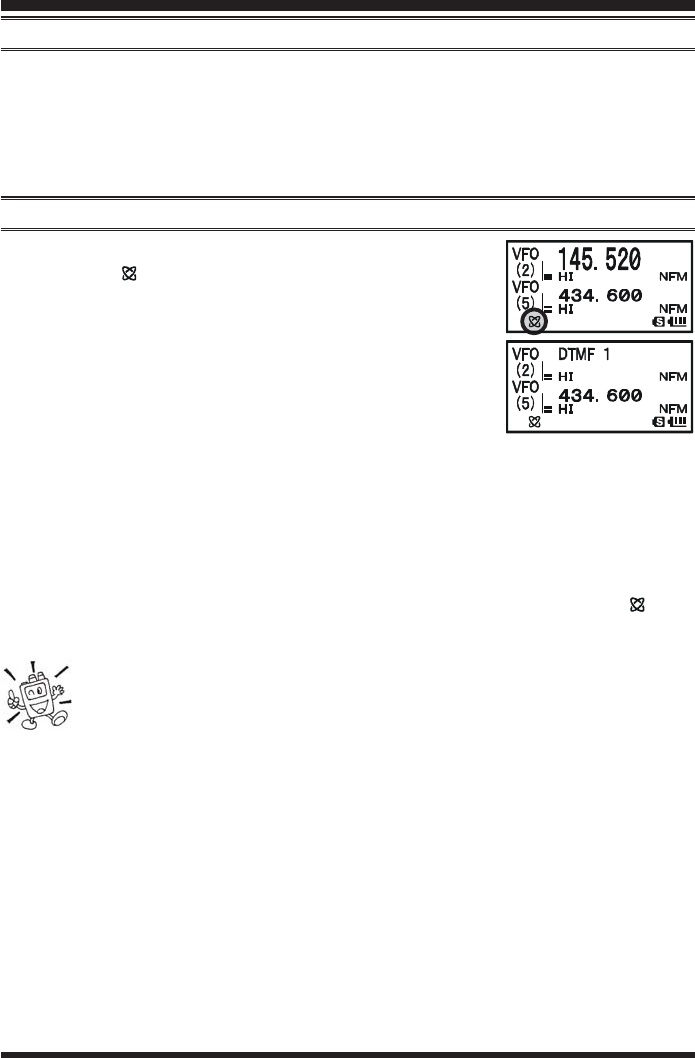
VX-8GR OPERATING MANUAL 99
GENERAL
The VX-8GR can be used to access a “node” (repeater or base station) which is tied into
the Vertex Standard WIRES™ (Wide-Coverage Internet Repeater Enhancement System)
network, operating in the “SRG” (Sister Radio Group) mode. Details may be found at the
WIRES-II Web site: http://www.vxstd.com/en/wiresinfo-en/. This feature may also be used
to access other systems, as described below.
SRG (“SISTER RADIO GROUP”) MODE
1. Press the d key to activate the Internet Connection fea-
ture. The “ ” icon will appear in the lower left corner of
the display.
2. Rotate the DIAL knob, while pressing and holding in the
d key, to select the access number (“DTMF 0DTMF 0
DTMF 0DTMF 0
DTMF 0” - “DTMFDTMF
DTMFDTMF
DTMF
99
99
9”, “DTMF ADTMF A
DTMF ADTMF A
DTMF A”, “DTMF BDTMF B
DTMF BDTMF B
DTMF B”, “DTMF CDTMF C
DTMF CDTMF C
DTMF C”, “DTMF DDTMF D
DTMF DDTMF D
DTMF D”, “DTMFDTMF
DTMFDTMF
DTMF
”, “DTMF #DTMF #
DTMF #DTMF #
DTMF #”) corresponding to the WIRES™ repeater to
which you wish to establish an Internet link (ask your re-
peater owner/operator if you don’t know the access numbers in the network). Now
press the PTT switch to exit from the selection mode.
3. With the Internet Connection feature activated (as in step 1 above), the VX-8GR will
generate a brief (0.1 second) DTMF tone according to your selection in step 2. This
DTMF tone is sent at the beginning of every transmission to establish or maintain the
link to the remote WIRES™ repeater operating in the SRG mode.
4. To disable the Internet Connection feature, press the d key again (The “ ” icon
disappear from the display.
If other users report that you always have a DTMF “beep” at the beginning
of each transmission, and you are not operating in conjunction with Internet
access, disable this function via step 4 above.
INTERNET CONNECTION FEATURE
FCC ID: K6620415X20 / IC:511B-20415X20
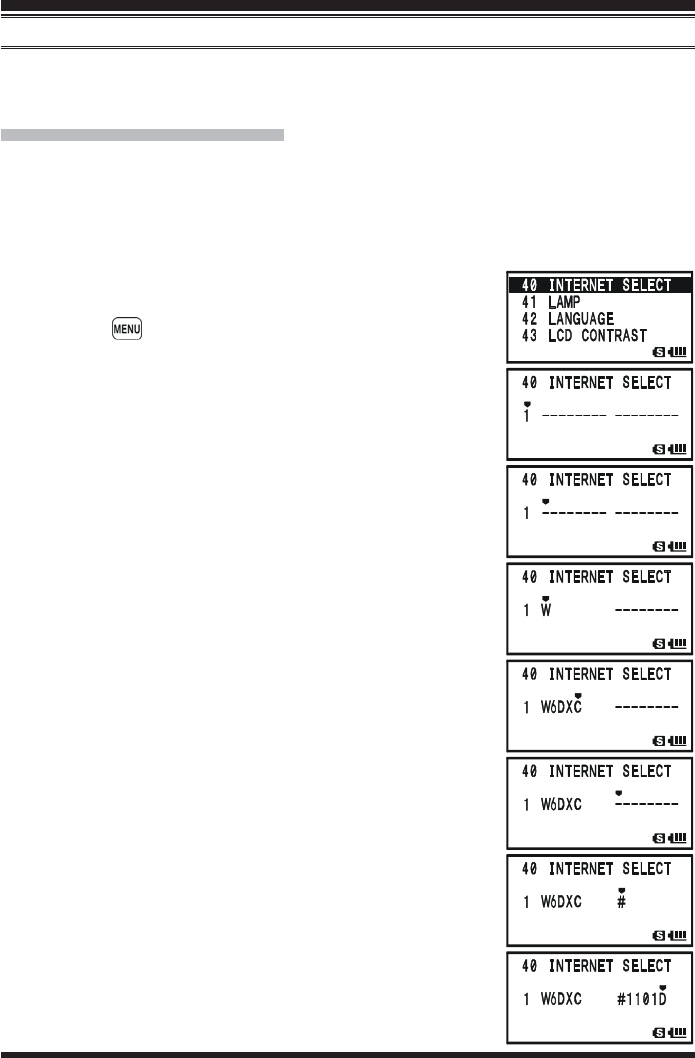
VX-8GR OPERATING MANUAL100
FRG (“FRIENDLY RADIO GROUP”) MODE
You may access other Internet Link Systems (including WIRES™ in the FRG mode) that
use a DTMF string for access.
PROGRAMMING THE FRG CODE
Load the DTMF tones which you wish to use for Internet-link access into an Internet
Memory Register. For purposes of this example, we will use “#1101D” as the access code
of the W6DXC node.
1. Press and hold the m key for one second to enter the Set Mode.
2. Rotate the DIAL knob to select Set Mode Item 40:40:
40:40:
40:
INTERNET SELECTINTERNET SELECT
INTERNET SELECTINTERNET SELECT
INTERNET SELECT.
3. Press the key briefly to enable adjustment of this Set
Mode Item.
4. Rotate the DIAL knob to select the DTMF Memory register
(“11
11
1” - “6464
6464
64”) into which you wish to store the access code.
5. If you wish to attach an alpha/numeric name “Tag” to the
Internet Memory, proceed to the next step; otherwise press
the B key then skip to step 13.
6. Press the M key briefly to enable programming of the
name tag.
7. Rotate the DIAL knob to select the first digit of the desired
label.
8. Press the M key to move to the next character.
9. If you make a mistake, press the B key to back-space
the cursor, then re-enter the correct letter, number, or sym-
bol.
10. Repeat steps 7 through 9 to program the remaining letters,
numbers, or symbols of the desired label. Eight characters
may be used in the creation of a label.
11. When you have programmed a label that is less than 8 char-
acters, press the M key twice to confirm the label and
enable storing the access code; otherwise, just program the
8 character label and press the M key one time.
12. Rotate the DIAL knob to select “##
##
#”.
13. Press the M key briefly to accept the first digit and move
to the second digit of the DTMF string.
14. If you make a mistake, press the B key to backspace
the cursor, then re-enter the correct letter or number.
15. Repeat steps 12 through 14 until you have completed the
access code (“#1101D”).
INTERNET CONNECTION FEATURE
FCC ID: K6620415X20 / IC:511B-20415X20
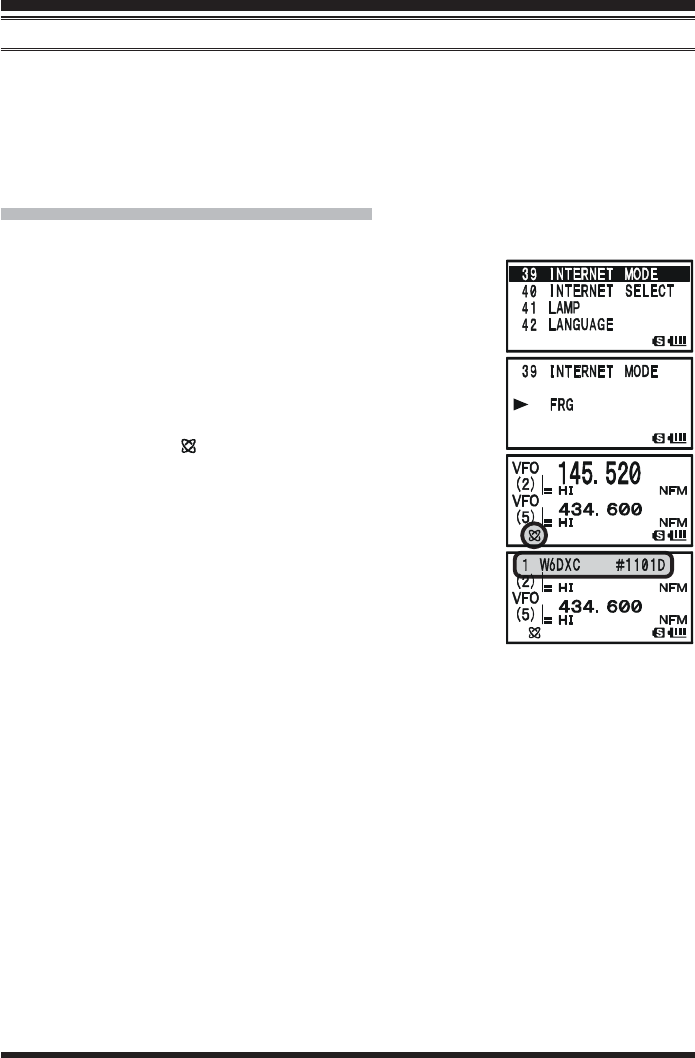
VX-8GR OPERATING MANUAL 101
16. When you have stored an access code that is less than 8 digits, press the M key
twice to confirm the code and enable storing the access code; otherwise, just enter the
8 digits and press the M key one time.
17. Repeat steps 4 through 16 to store other access codes, if so desired.
18. Press the PTT switch to save the settings and exit to normal operation.
OPERATION (ACCESSING AN FRG NODE)
1. Press and hold the m key for one second to enter the Set Mode.
2. Rotate the DIAL knob to select Set Mode Item 3939
3939
39.
3. Press the m key briefly to enable adjustment of this Set
Mode Item.
4. Rotate the DIAL knob to set this Set Mode Item to “FRGFRG
FRGFRG
FRG”
(thus activating the “Other Internet Link System” mode).
5. Press the PTT switch to save the new settings.
6. Press the d key briefly to activate the Internet Connec-
tion feature. The “ ” icon will appear in the lower left of
the display.
7. Rotate the DIAL knob while pressing the d key to select
the Internet Memory register number (“11
11
1” - “6464
6464
64”) corre-
sponding to the Internet link repeater to which you wish to
establish an Internet link, then press the PTT switch briefly
to lock in the selected access number.
8. Once the Internet Connection feature is activated as in step
7 above, you may press the d key, while you are trans-
mitting, to send out the selected DTMF string (to establish the link to the desired
Internet-link node).
9. To return to the WIRES™ SRG mode, repeat steps 1 - 5 above, selecting “SRGSRG
SRGSRG
SRG” in
step 4.
INTERNET CONNECTION FEATURE
FRG (“FRIENDLY RADIO GROUP”) MODE
FCC ID: K6620415X20 / IC:511B-20415X20
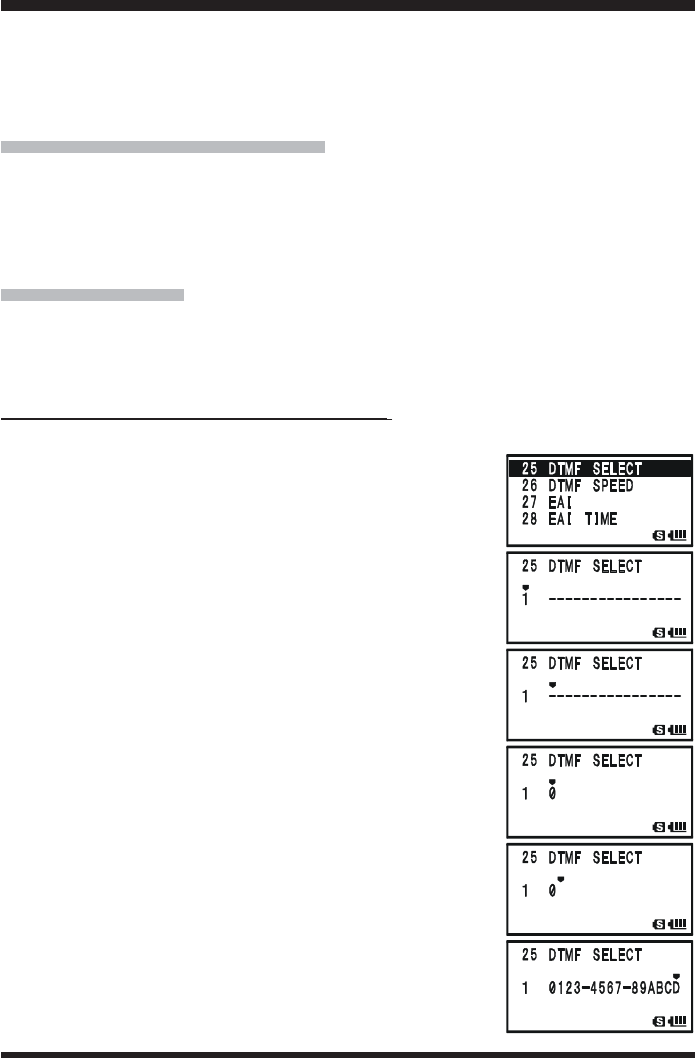
VX-8GR OPERATING MANUAL102
The VX-8GR’s keypad allows easy DTMF dialing for Autopatch, repeater control, or
Internet-link access purposes. Besides numerical digits [0] through [9], the keypad in-
cludes the [] and [#] digits, plus the [A], [B], [C], and [D] tones often used for repeater
control.
MANUAL DTMF TONE GENERATION
You can generate DTMF tones during transmission manually.
1. Press the PTT switch to begin transmission.
2. While transmitting, press the desired numbers on the keypad.
3. When you have sent all the digits desired, release the PTT key.
DTMF AUTODIALER
Nine DTMF Autodial memories are provided, allowing you to store telephone numbers
for autopatch use. You can also store short autopatch or Internet-link access code streams
to avoid having to send them manually.
Here is the DTMF Autodial storage procedure:
1. Press and hold the m key for one second to enter the Set Mode.
2. Rotate the DIAL knob to select Set Mode Item 25: DTMF25: DTMF
25: DTMF25: DTMF
25: DTMF
SELECTSELECT
SELECTSELECT
SELECT.
3. Press the m key briefly to enable adjustment of this Set
Mode Item.
4. Rotate the DIAL knob to select the DTMF Memory register
(11
11
1 - 1010
1010
10) into which you wish to store this DTMF string.
5. Press the M key briefly to begin DTMF Memory entry
into the selected register.
6. Press and hold in the h key for two seconds to clear the
previously-stored data, if desired.
7. Rotate the DIAL knob to select the first digit of the DTMF
string. Selectable entries are 00
00
0 - 99
99
9, AA
AA
A - DD
DD
D, , and ##
##
#. You
may select “––
––
–” to store a “Pause”, if needed.
8. Press the M key to move to the next character.
9. Repeats steps 7 and 8 to program the remaining the DTMF
string.
10. Press and hold in the h key for two seconds to delete the
previously-stored data after the cursor.
11. If you make a mistake, press the B key to back-space
the cursor, re-enter the correct number.
12. Press the PTT switch briefly to save the new setting and
exit to normal operation. To store other numbers, repeat this
process, using a different DTMF memory register.
DTMF OPERATION
FCC ID: K6620415X20 / IC:511B-20415X20
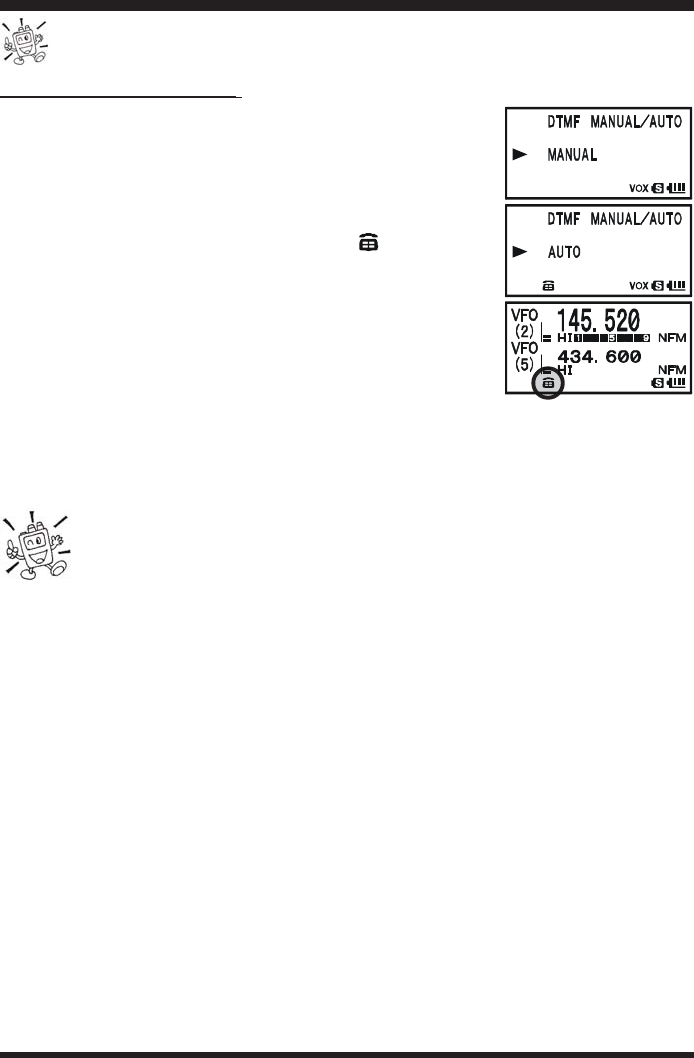
VX-8GR OPERATING MANUAL 103
You may check your work by monitoring the entered DTMF string. To do this,
repeat steps 1 - 4 above, then press the f key.
To send a telephone number:
1. Press the f key, then press the 3 key. This provides a
“Short-cut” to Set Mode Item 24: DTMF MANUAL24: DTMF MANUAL
24: DTMF MANUAL24: DTMF MANUAL
24: DTMF MANUAL/AUTOAUTO
AUTOAUTO
AUTO.
2. Rotate the DIAL knob to select “AUTOAUTO
AUTOAUTO
AUTO” (to activate the
DTMF Autodialer function).
3. Press the PTT switch to exit to normal operation and acti-
vate the DTMF Autodialer function (the “ ” icon will ap-
pear).
4. In the Autodialer function mode, first press the PTT key,
then press the numerical key (1 through 9, and 0:
representing “10”) corresponding to the DTMF memory
string you wish to send. Once the string begins, you may
release the PTT key, as the transmitter will be held “on the
air” until the DTMF string is completed.
To disable the DTMF Autodialer, just repeat the above procedure, rotating the DIAL knob
to select “MANUALMANUAL
MANUALMANUAL
MANUAL” in step “2” above.
1) You can change the DTMF Autodialer sending speed, using Set Mode
Item 26: DTMF SPEED, see page xx for details.
2) You can also set a longer delay between the time your transmitter is keyed
and the first DTMF digit is sent, using Set Mode Item 23: DTMF DELAY, see page xx
for details.
DTMF OPERATION
FCC ID: K6620415X20 / IC:511B-20415X20
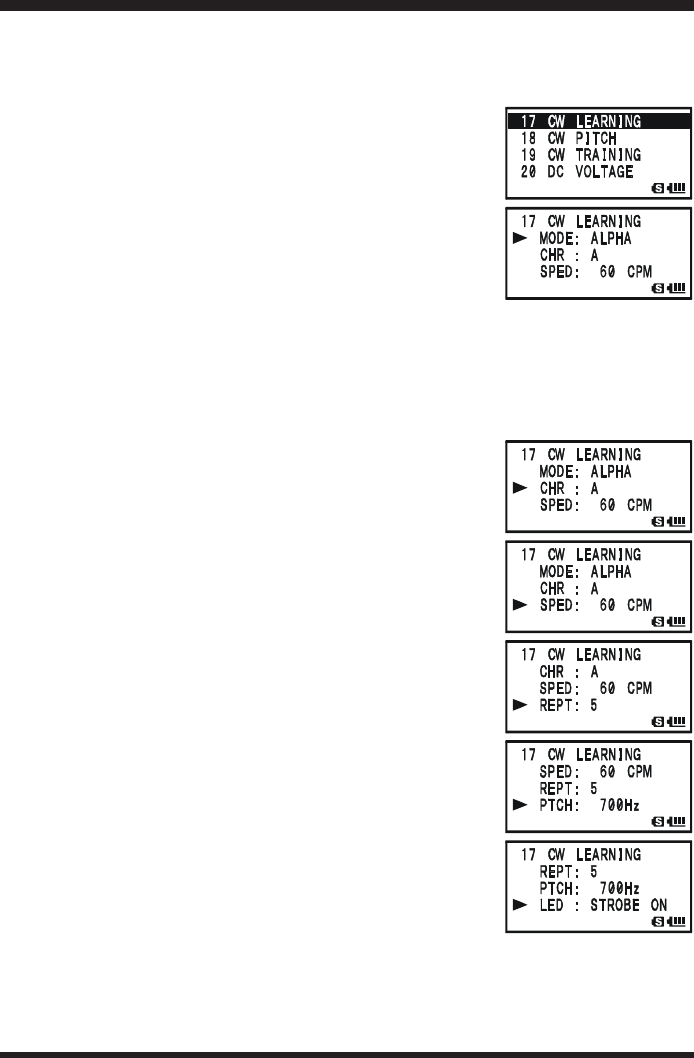
VX-8GR OPERATING MANUAL104
The VX-8GR provides a CW learning feature, which sends the designated Morse Code
via the sidetone (heard in the speaker) to help your CW learning.
1. Press and hold the m key for one second to enter the Set Mode.
2. Rotate the DIAL knob to select Set Mode Item 17: CW17: CW
17: CW17: CW
17: CW
LEARNINGLEARNING
LEARNINGLEARNING
LEARNING.
3. Press the m key briefly to enable adjustment of this Set
Mode Item.
4. Rotate the DIAL knob to select the Training mode (displayed
in fine print at the upper edge of the LCD):
ALPHAALPHA
ALPHAALPHA
ALPHA: Sends the Alphabet characters
ALPHA AUTOALPHA AUTO
ALPHA AUTOALPHA AUTO
ALPHA AUTO: Sends the Alphabet characters (move to
next character automatically)
NUMBERNUMBER
NUMBERNUMBER
NUMBER: Sends the Numeric characters
NUMBER AUTONUMBER AUTO
NUMBER AUTONUMBER AUTO
NUMBER AUTO: Sends the Numeric characters (move to next character automatically)
SYMBLSYMBL
SYMBLSYMBL
SYMBL: Sends the Symbol characters
SYMBL AUTOSYMBL AUTO
SYMBL AUTOSYMBL AUTO
SYMBL AUTO: Sends the Symbol characters (move to next character automatically)
5. Press the b key to change the cursor to “CHRCHR
CHRCHR
CHR”, then ro-
tate the DIAL knob to select the CW code which you want
to learn.
6. Press the b key to change the cursor to “SPEDSPED
SPEDSPED
SPED”, then
rotate the DIAL knob to select the Morse speed. You may
select the units of the code speed in either “CPMCPM
CPMCPM
CPM (charac-
ters per minute)” or “WPM
WPM
WPMWPM
WPM (Words per minute)” by using
the DIAL knob from Set Item “FORMFORM
FORMFORM
FORM”.
7. Press the b key to change the cursor to “REPTREPT
REPTREPT
REPT”, then
rotate the DIAL knob to select the sending repetition (1 -
9).
8. Press the b key to change the cursor to “PTCHPTCH
PTCHPTCH
PTCH”, then
rotate the DIAL knob to adjust the CW sidetone pitch (400
- 1000 Hz, 50 Hz/step).
9. Press the b key to change the cursor to “LEDLED
LEDLED
LED”, then ro-
tate the DIAL knob to switch the flashing of the (white)
LED light “on” and “off”.
10. Press the f key to begin generating the selected code
characters the designated number of times (Only the speaker
CW sidetone is heard, the radio does not transmit).
11. You may adjust the CW sidetone audio level by rotating the DIAL knob while press-
ing and holding the g key.
12. If one of the “AUTOAUTO
AUTOAUTO
AUTO” modes is not selected in step 4 above, press the f key to send
again, or select another code by rotating the DIAL knob from “CHRCHR
CHRCHR
CHR” item and press
CW LEARNING FEATURE
FCC ID: K6620415X20 / IC:511B-20415X20

VX-8GR OPERATING MANUAL 105
the f key to begin generation.
13. To stop CW generation, press the f key again.
14. To disable CW learning feature, press the PTT switch.
The “CPM” selection is based on the international “PARIS” standard, which
stipulates five characters per word.
CW LEARNING FEATURE
FCC ID: K6620415X20 / IC:511B-20415X20
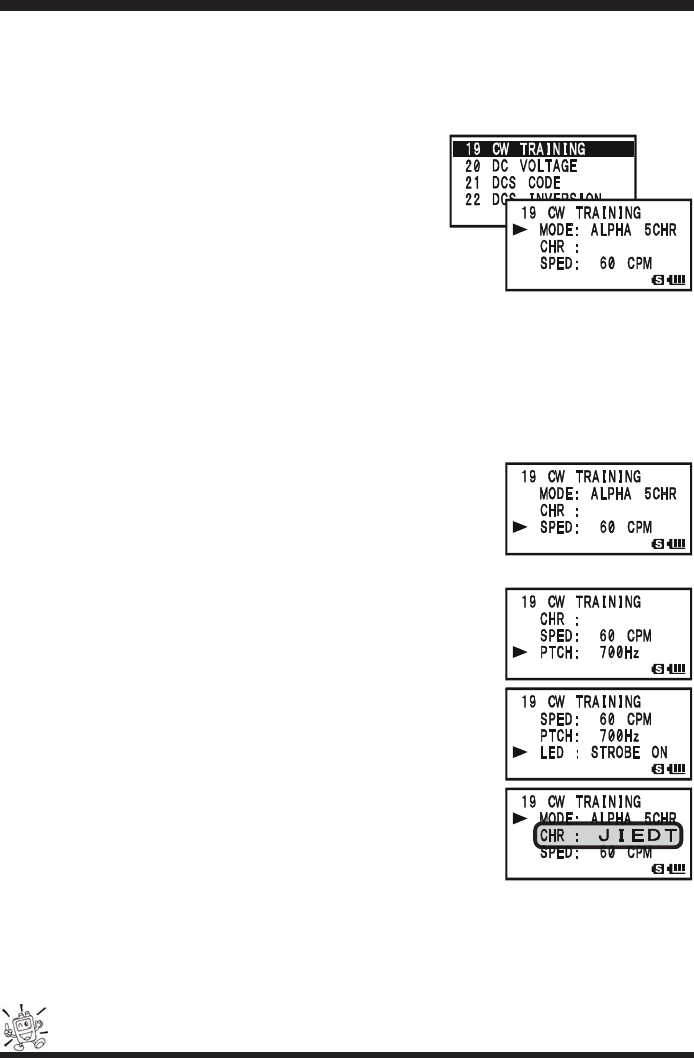
VX-8GR OPERATING MANUAL106
The VX-8GR provides another CW learning feature; call it a CW Training feature, which
sends random Morse Code via the sidetone (heard in the speaker), so you can improve
your CW proficiency.
1. Press and hold the m key for one second to enter the Set Mode.
2. Rotate the DIAL knob to select Set Mode Item 19:19:
19:19:
19:
CW TRAININGCW TRAINING
CW TRAININGCW TRAINING
CW TRAINING.
3. Press the m key briefly to enable adjustment of
this Set Mode Item.
4. Rotate the DIAL knob to select the Training mode (displayed
in fine print at the upper edge of the LCD):
ALPHA 5CHRALPHA 5CHR
ALPHA 5CHRALPHA 5CHR
ALPHA 5CHR: Sends five Alphabet characters only
ALPHA REPTALPHA REPT
ALPHA REPTALPHA REPT
ALPHA REPT: Sends Alphabet characters only (Repeatedly)
NUMBER 5CHRNUMBER 5CHR
NUMBER 5CHRNUMBER 5CHR
NUMBER 5CHR: Sends five Numeric characters only
NUMBER REPTNUMBER REPT
NUMBER REPTNUMBER REPT
NUMBER REPT: Sends Numeric characters only (Repeatedly)
MIX 5CHRMIX 5CHR
MIX 5CHRMIX 5CHR
MIX 5CHR: Sends five Alphabet, Numeric, “?”, and “/” characters (Mixed)
MIX REPTMIX REPT
MIX REPTMIX REPT
MIX REPT: Sends Alphabet, Numeric, “?”, and “/” characters (Mixed, Con-
tinuously in groups of five)
5. Press the b key to change the cursor to “SPEDSPED
SPEDSPED
SPED”, then
rotate the DIAL knob to select the Morse speed. You may
select the units of the code speed between “CPMCPM
CPMCPM
CPM (charac-
ters per minute)” and “WPMWPM
WPMWPM
WPM (Words per minute)” by the
DIAL knob from Set Item “FORMFORM
FORMFORM
FORM”.
6. Press the b key to change the cursor to “PTCHPTCH
PTCHPTCH
PTCH”, then
rotate the DIAL knob to adjust the CW sidetone pitch (400
- 1000 Hz, 50 Hz/step).
7. Press the b key to change the cursor to “LEDLED
LEDLED
LED”, then ro-
tate the DIAL knob to switch the flashing of the (white)
LED light “on” and “off”.
8. Press the a/b key to change the cursor to “MODEMODE
MODEMODE
MODE.
9. Press the f key to begin generation of the code characters
(CW sidetone only, the radio does not transmit); the gener-
ated characters will appear at the right of the “CHRCHR
CHRCHR
CHR” item.
10. You may adjust the CW sidetone audio level by rotating the
DIAL knob while pressing and holding the g key.
11. If one of the “5CHR5CHR
5CHR5CHR
5CHR” modes is selected in step 4 above, press the f key to send
another code group.
12. To stop CW generation, press the f key again.
13. To disable CW training feature, press the PTT switch.
The “CPM” selection is based on the international “PARIS” standard, which
stipulates five characters per word.
CW TRAINING FEATURE
FCC ID: K6620415X20 / IC:511B-20415X20
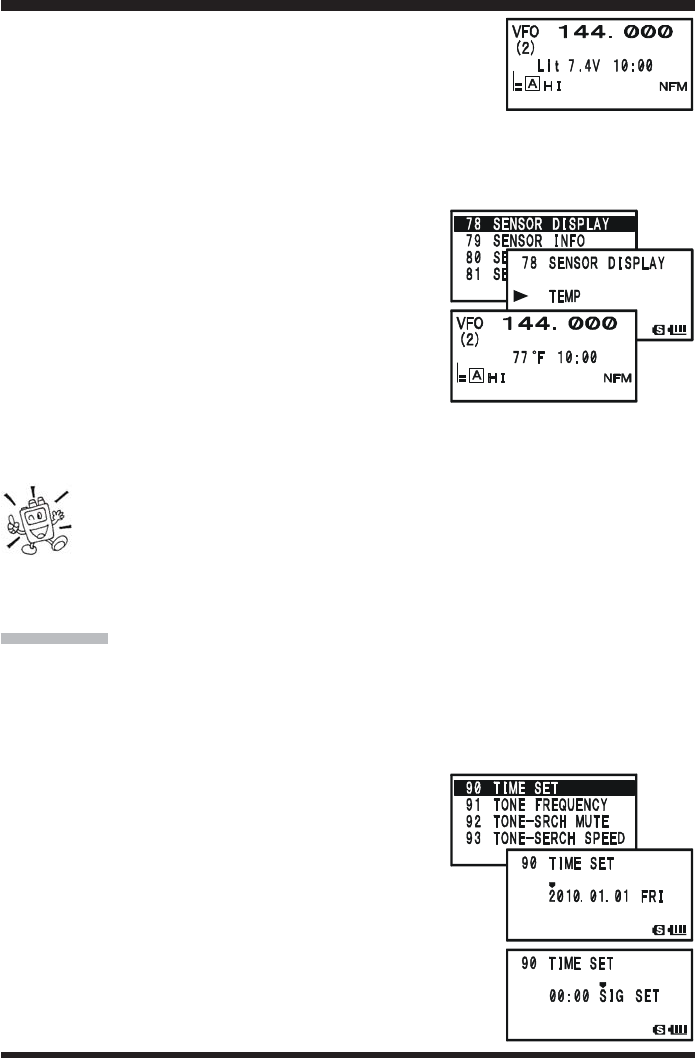
VX-8GR OPERATING MANUAL 107
SENSOR MODE
The VX-8GR always displays the “Battery Voltage” and “Cur-
rent Time” while the VX-8GR is operating in the “Mono” band
mode with the Large characters. You may change the “Battery
Voltage” display to the “Temperature” display which indicates
the current temperature inside the transceiver’s case.
To change the display from the “Battery Voltage” to the “Temperature”:
1. Press and hold the m key for one second to enter the Set Mode.
2. Rotate the DIAL knob to select Set Mode Item 78:78:
78:78:
78:
SENSOR DISPLAYSENSOR DISPLAY
SENSOR DISPLAYSENSOR DISPLAY
SENSOR DISPLAY.
3. Press the m key briefly to enable adjustment of
this Set Mode Item.
4. Rotate the DIAL knob to select “TEMPTEMP
TEMPTEMP
TEMP”.
5. Press the PTT switch briefly to exit to normal op-
eration and display the sensor information on the dis-
play.
To return to the “Battery Voltage” display, just repeat the above procedure, rotating the
DIAL knob to select “DCDC
DCDC
DC” in step “4” above.
1) When select “OFF” in step “4” above, the VX-8GR displays only the “Cur-
rent Time” while the VX-8GR is operating in the “Mono” band mode with
the Large characters.
2) You may monitor the “Battery Voltage” using Set Mode Item 20: DC VOLTAGE, and
the “Temperature” using Set Mode Item 79: SENSOR INFO .
CLOCK SET
The VX-8GR has a 24-hour clock with a calendar which covers all dates from January 1,
2000 through December 31, 2099 (accuracy: ±30 sec/month).
To set the clock:
1. Press and hold the m key for one second to enter the Set Mode.
2. Rotate the DIAL knob to select Set Mode Item 90:90:
90:90:
90:
TIME SETTIME SET
TIME SETTIME SET
TIME SET.
3. Press the m key briefly to enable adjustment of
this Menu Item.
4. Rotate the DIAL knob to select the “year” setting.
5. Press the M key briefly, then rotate the DIAL knob to
select the “month” setting.
6. Repeat the above step to set the “day,” “day of the week,”
“hour,” and “minute” selections.
7. Press the M key briefly, then rotate the DIAL knob to set
“Timer Signal” On (SIGSIG
SIGSIG
SIG) or Off (––––
––––
––). In the “SIGSIG
SIGSIG
SIG” mode, a
FCC ID: K6620415X20 / IC:511B-20415X20

VX-8GR OPERATING MANUAL108
SENSOR MODE
double-beep will be emitted from the speaker at the top of each hour, as long as the
transceiver is turned on.
8. Press the M key briefly, press the c key to start the clock from “00” seconds.
9. When you have finished the time setup, press the PTT switch to save the new setting
and return to normal operation.
The VX-8GR has a rechargeable Li-Ion battery cell used just for the clock.
Therefore, the VX-8GR can maintain its clock data for approximately two
months without using the main battery pack or external DC power.
FCC ID: K6620415X20 / IC:511B-20415X20
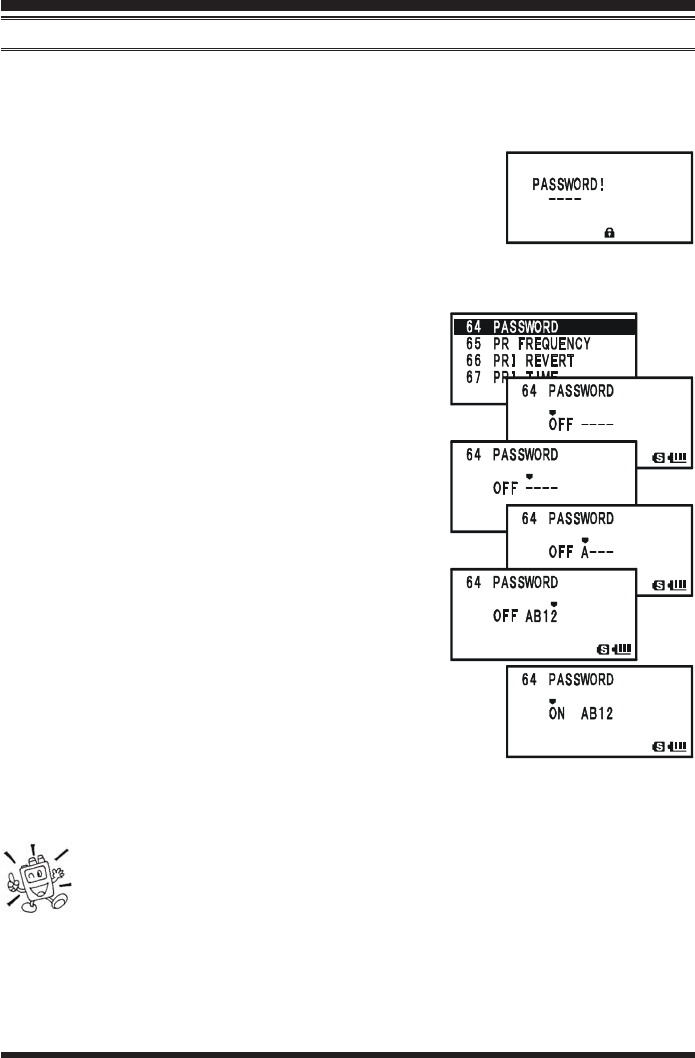
VX-8GR OPERATING MANUAL 109
MISCELLANEOUS SETTING
PASSWORD
The VX-8GR provides a password feature which can minimize the chance that your trans-
ceiver could be used by an unauthorized party.
When the password feature is activated, the radio will ask for the four digit password to be
entered when the radio is first turned on. You must enter the
four digit password from the keypad. If the wrong password is
entered, the microprocessor will shut down the radio automati-
cally.
To enter and activate the password use the following procedure:
1. Press and hold the m key for one second to enter the Set Mode.
2. Rotate the DIAL knob to select Set Mode Item 64:64:
64:64:
64:
PASSWORDPASSWORD
PASSWORDPASSWORD
PASSWORD.
3. Press the m key briefly to enable adjustment of
this Set Mode Item.
4. Press the M key to enable programming the password.
5. Rotate the DIAL knob to select the first digit of the
desired number/letter (00
00
0 - 99
99
9, AA
AA
A, BB
BB
B, C C
C C
C, DD
DD
D, , and ##
##
#).
6. Press the M key to move to the next digit.
7. Repeat steps 5 and 6 to program the remaining num-
bers/letters of the desired password.
8. If you make a mistake, press the B key to move
back to the previous digit, then select the correct num-
ber/letter.
9. When you have finished entering the password, press
the M key and rotate the DIAL knob to select “ONON
ONON
ON” (to
activate the password feature).
10. Press the PTT switch to save the new setting and exit to
normal operation.
If you wish to disable the Password feature, repeat steps 1 - 3 above. Rotate the DIAL
knob to select “OFFOFF
OFFOFF
OFF”, then press the PTT switch.
1) We recommend that you write down the password number, and keep it in a
safe place where you can easily find if you forget your password.
2) If you forget the password number, you may turn on the transceiver by
performing the “Microprocessor Resetting” procedure (see page xx). However, the
VX-8GR will clear the password, as well as all memories, and will restore all other
settings to factory defaults.
FCC ID: K6620415X20 / IC:511B-20415X20
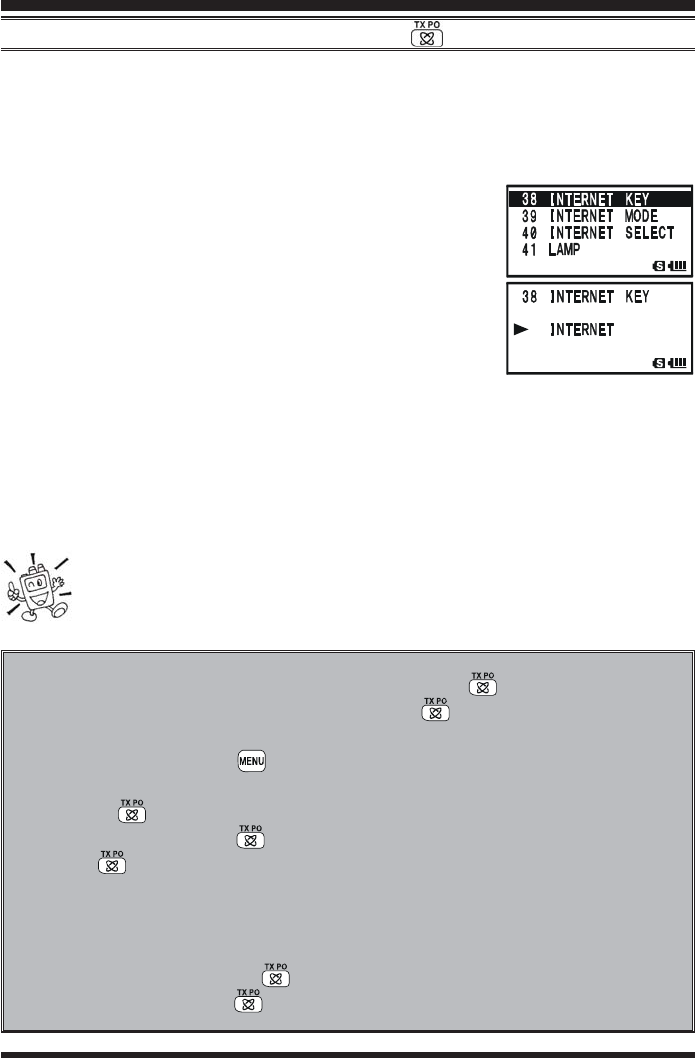
VX-8GR OPERATING MANUAL110
PROGRAMMING THE KEY
The Internet Key is the factory default (“primary” press key) function of the d key.
However, you may change the “primary” (press key) function of the d key to another
function via the Menu mode.
1. Press and hold the m key for one second to enter the Set Mode.
2. Rotate the DIAL knob to select Set Mode Item 38:38:
38:38:
38:
INTERNET KEYINTERNET KEY
INTERNET KEYINTERNET KEY
INTERNET KEY.
3. Press the m key briefly to enable adjustment of this Set
Mode Item.
4. Rotate the DIAL knob to select the desired function:
INTERNETINTERNET
INTERNETINTERNET
INTERNET: Activates/Disables the internet feature.
INTERNET SELECTINTERNET SELECT
INTERNET SELECTINTERNET SELECT
INTERNET SELECT: Recalls the Internet Access Number
(SRG) or Access String (FRG). Select
the SRG number or FRG string via Menu Item 39: INTERNET39: INTERNET
39: INTERNET39: INTERNET
39: INTERNET
MODEMODE
MODEMODE
MODE.
SET MODESET MODE
SET MODESET MODE
SET MODE: A short cut path to recall one of the Menu Items. See box below
for programming.
5. When you have made your selection, press the PTT switch briefly to save the new
setting and exit to normal operation.
When “INTERNET SELECT” or “SET MODE” is assigned to the d key,
the INTERNET function may be activated/disabled via Set Mode Item 36:
INTERNET.
ASSIGN THE SET MODE ITEM TO THE KEY
1. Change (“primary” press key) function of the key to “SET MODESET MODE
SET MODESET MODE
SET MODE”, using
Set Mode Item 38: INTERNET KEY38: INTERNET KEY
38: INTERNET KEY38: INTERNET KEY
38: INTERNET KEY, as descried above.
2. Press and hold in the key for one second to enter the Set Mode again.
3. Rotate the DIAL knob to select the Set Mode Item which you wish to assign
to the key as a short-cut.
4. Press and hold in the key for one second to assign the Set Mode Item to
the key. “MY KEYMY KEY
MY KEYMY KEY
MY KEY” will appear on the display, to confirm that the com-
mand was executed.
5. Press the PTT switch briefly to save the new setting and exit to normal op-
eration.
Now, briefly pressing of the key will immediately recall the selected Menu
Item. You must press the key again to exit to normal operation.
MISCELLANEOUS SETTING
FCC ID: K6620415X20 / IC:511B-20415X20
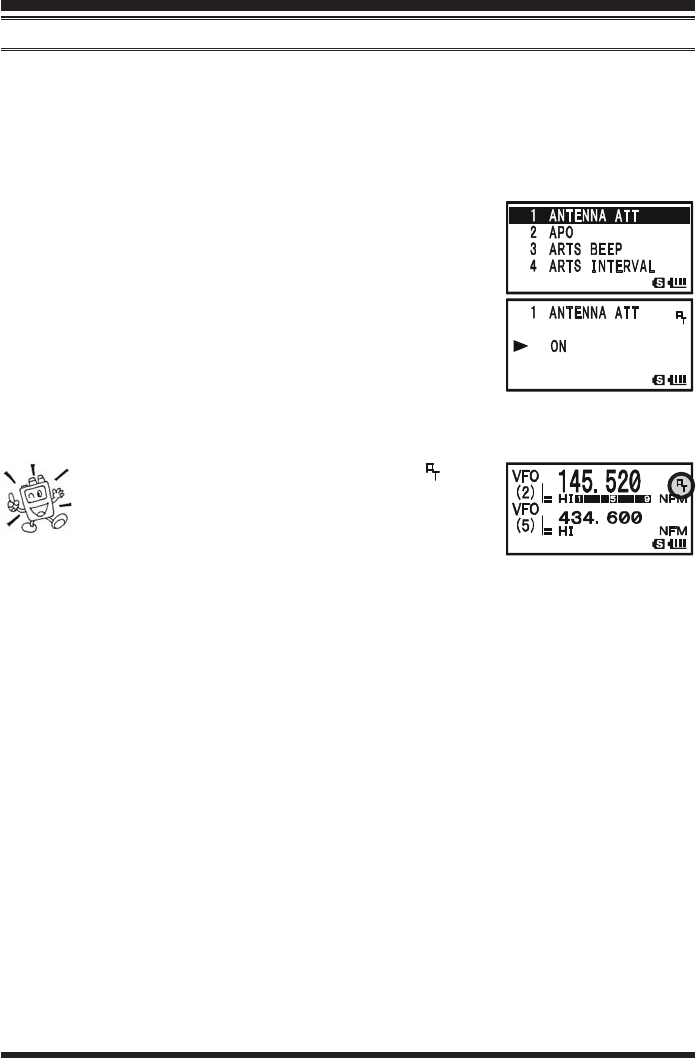
VX-8GR OPERATING MANUAL 111
ATT (FRONT END ATTENUATOR)
The attenuator will reduce all signals (and noise) by 10 dB, and it may be used to make
reception more pleasant under extremely noisy conditions.
1. Set a band (“A-Band” or “B-Band”) on which you wish to activate the “attenuator” to
the “Operating” Band (indicated in large character).
2. Press and hold the m key for one second to enter the Set Mode.
3. Rotate the DIAL knob to select Set Mode Item 1: ANTENNA1: ANTENNA
1: ANTENNA1: ANTENNA
1: ANTENNA
ATTATT
ATTATT
ATT.
4. Press the m key briefly to enable adjustment of this Set
Mode Item.
5. Rotate the DIAL knob to change the setting from “OFFOFF
OFFOFF
OFF” to
“ONON
ONON
ON”.
6. When you have made your selection, press the PTT key to
save the new setting and exit to normal operation.
7. If you wish to disable the attenuator, just repeat the above procedure, rotate the DIAL
knob to select “OFFOFF
OFFOFF
OFF” in step “5” above.
1) When the attenuator is activated, the “ ” icon
will appear on the display.
2) The attenuator can be set independently on each
operating band of the “A-Band” and “B-Band”.
MISCELLANEOUS SETTING
FCC ID: K6620415X20 / IC:511B-20415X20
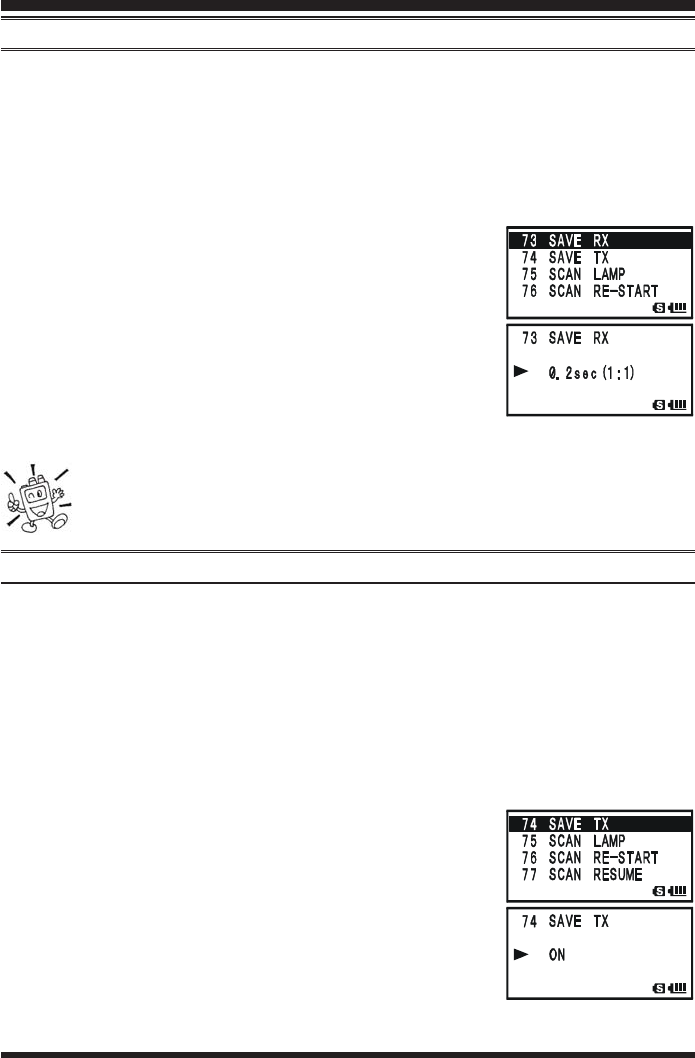
VX-8GR OPERATING MANUAL112
RECEIVE BATTERY SAVER SETUP
An important feature of the VX-8GR is its Receive Battery Saver, which “puts the radio to
sleep” for a time interval, periodically “waking it up” to check for activity. If somebody is
talking on the channel, the VX-8GR will remain in the “active” mode, then resume its
“sleep” cycles. This feature significantly reduces quiescent battery drain, and you may
change the amount of “sleep” time between activity checks using the Menu System:
1. Press and hold the m key for one second to enter the Set Mode.
2. Rotate the DIAL knob to select Set Mode Item 73: SAVE RX73: SAVE RX
73: SAVE RX73: SAVE RX
73: SAVE RX.
3. Press the m key briefly to enable adjustment of this Set
Mode Item.
4. Rotate the DIAL knob to select the desired “sleep” dura-
tion. The selections available are 0.2sec0.2sec
0.2sec0.2sec
0.2sec - 0.9sec0.9sec
0.9sec0.9sec
0.9sec (0.1sec/
step), 1.0sec1.0sec
1.0sec1.0sec
1.0sec - 9.5sec9.5sec
9.5sec9.5sec
9.5sec (0.5sec/step), 10.0sec10.0sec
10.0sec10.0sec
10.0sec - 60.0sec60.0sec
60.0sec60.0sec
60.0sec
(5sec/step), or OFFOFF
OFFOFF
OFF. The default value is 0.2sec0.2sec
0.2sec0.2sec
0.2sec.
5. When you have made your selection, press the PTT switch
to save the new setting and exit to normal operation.
When you are operating on Packet, switch the Receive Battery Saver OFF, as
the sleep cycle may “collide” with the beginning of an incoming Packet trans-
mission, causing your TNC not to receive the full data burst.
TX BATTERY SAVER
The VX-8GR also includes a useful Transmit Battery Saver, which will automatically
lower the power output level when the last signal received was very strong. For example,
when you are in the immediate vicinity of a repeater station, there generally is no reason to
use the full 5 Watts of power output in order to achieve full-quieting access to the repeater.
With the Transmit Battery Saver, the automatic selection of Low Power operation con-
serves battery drain significantly.
To activate the Transmit Battery Saver:
1. Press and hold the m key for one second to enter the Set Mode.
2. Rotate the DIAL knob to select Set Mode Item 74: SAVE TX74: SAVE TX
74: SAVE TX74: SAVE TX
74: SAVE TX.
3. Press the m key briefly to enable adjustment of this Set
Mode Item.
4. Rotate the DIAL knob to set this Set Mode Item to “ONON
ONON
ON”
(thus activating the Transmit Battery Saver).
5. When you have completed your selection, press the PTT
switch to save the new setting and exit to normal operation.
To disable the Transmit Battery Saver, just repeat the above pro-
cedure, rotating the DIAL knob to select “OFFOFF
OFFOFF
OFF” in step 4 above.
MISCELLANEOUS SETTING
FCC ID: K6620415X20 / IC:511B-20415X20
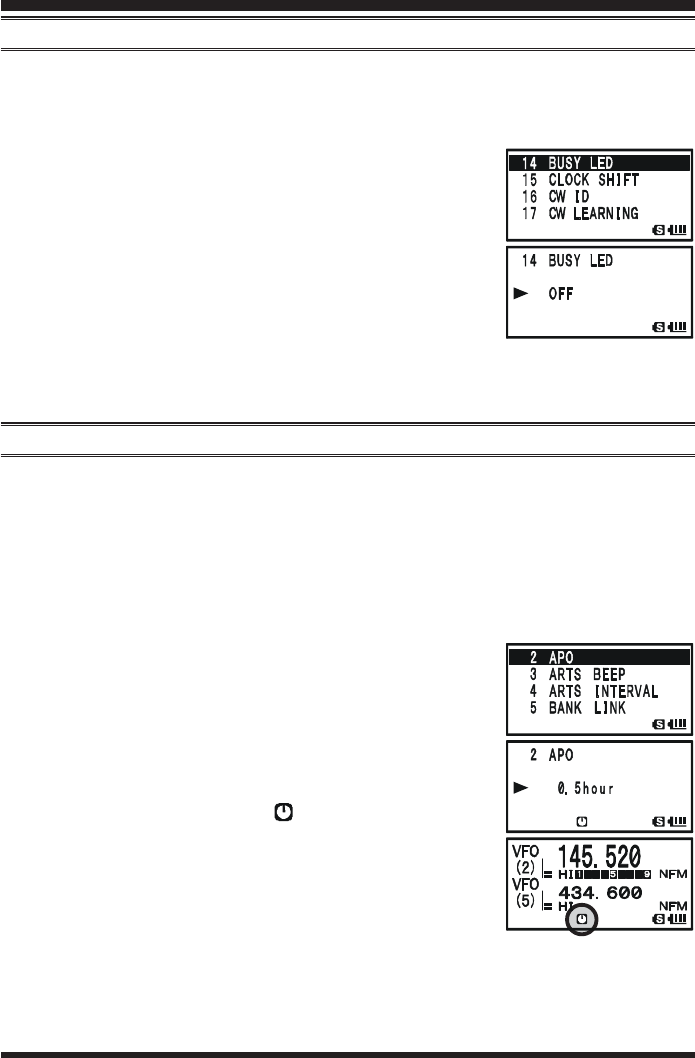
VX-8GR OPERATING MANUAL 113
DISABLING THE BUSY INDICATOR
Further battery conservation may be accomplished by disabling the BUSY indicator while
receiving a signal. Use the following procedure:
1. Press and hold the m key for one second to enter the Set Mode.
2. Rotate the DIAL knob to select Set Mode Item 14: BUSY14: BUSY
14: BUSY14: BUSY
14: BUSY
LEDLED
LEDLED
LED.
3. Press the m key briefly to enable adjustment of this Set
Mode Item.
4. Rotate the DIAL knob to set this Set Mode Item to “OFFOFF
OFFOFF
OFF”
(thus disabling the BUSY lamp).
5. When you have completed your selection, press the PTT
switch to save the new setting and exit to normal operation.
To enable the BUSY indicator, just repeat the above procedure, rotating the DIAL knob to
select “ONON
ONON
ON” in step 4 above.
AUTOMATIC POWER-OFF (APO) FEATURE
The APO feature helps conserve battery life by automatically turning the radio off after a
user-defined period of time within which there has been no dial or key activity.
The available selections for the time before power-off are 0.5 - 12.0 hour, as well as APO
Off. The default condition for the APO is OFF, and here is the procedure for activating it:
1. Press and hold the m key for one second to enter the Set Mode.
2. Rotate the DIAL knob to select Set Mode Item 2: APO2: APO
2: APO2: APO
2: APO.
3. Press the m key briefly to enable adjustment of this Set
Mode Item.
4. Rotate the DIAL knob to select the desired time period after
which the radio will automatically shut down.
5. When you have completed your selection, press the PTT
switch to save the new setting and exit to normal operation.
When the APO is activated, the “ ” icon will appear at the
center bottom on the LCD. If there is no action by you within
the time interval programmed, the microprocessor will shut down
the radio automatically.
Just press and hold in the p(PWR) switch for 2 seconds to
turn the transceiver back on after an APO shutdown, as usual.
To disable the APO, just repeat the above procedure, rotating the DIAL knob to select
“OFFOFF
OFFOFF
OFF” in step 4 above.
MISCELLANEOUS SETTING
FCC ID: K6620415X20 / IC:511B-20415X20
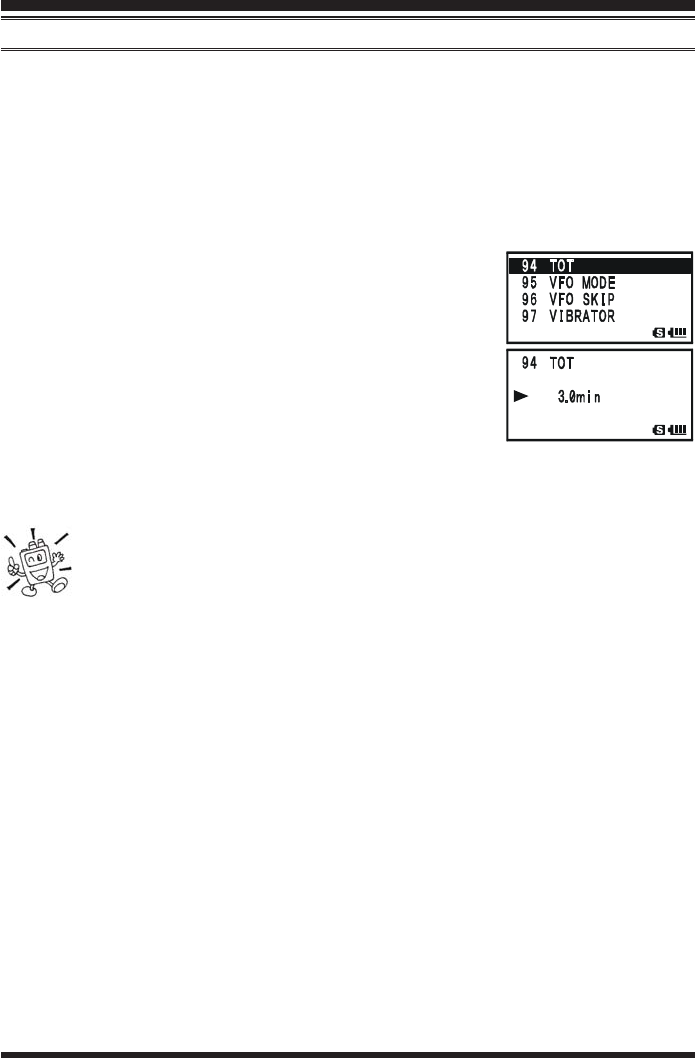
VX-8GR OPERATING MANUAL114
TRANSMITTER TIME-OUT TIMER (TOT)
The TOT feature provides a safety switch which limits transmission to a pre-programmed
value. This will promote battery conservation by not allowing you to make excessively
long transmissions, and in the event of a stuck PTT switch (perhaps if the radio or a
Speaker/Mic is wedged between car seats) it can prevent interference to other users as
well as battery depletion. As configured at the factory the TOT feature is set to OFF, and
here is the procedure for activating it:
1. Press and hold the m key for one second to enter the Set Mode.
2. Rotate the DIAL knob to select Set Mode Item 94: TOT94: TOT
94: TOT94: TOT
94: TOT.
3. Press the m key briefly to enable adjustment of this Set
Mode Item.
4. Rotate the DIAL knob to set the Time-Out Timer to the de-
sired “Maximum TX” time. The available selections are 0.5
- 10.0 minutes (0.5 minute/step).
5. When you have completed your selection, press the PTT
switch to save the new setting and exit to normal operation.
To disable the Time-Out Timer, just repeat the above procedure, rotating the DIAL knob to
select “OFFOFF
OFFOFF
OFF” in step 4 above.
1) When your transmission time is within 10 seconds of the Time-Out Timer
expiration, an Alert bell will provide an audible warning from the speaker.
2) Since brief transmissions are the mark of a good operator, try setting up
your radio’s TOT feature for a maximum transmission time of 1 minute. This will sig-
nificantly improve battery life, too!
MISCELLANEOUS SETTING
FCC ID: K6620415X20 / IC:511B-20415X20
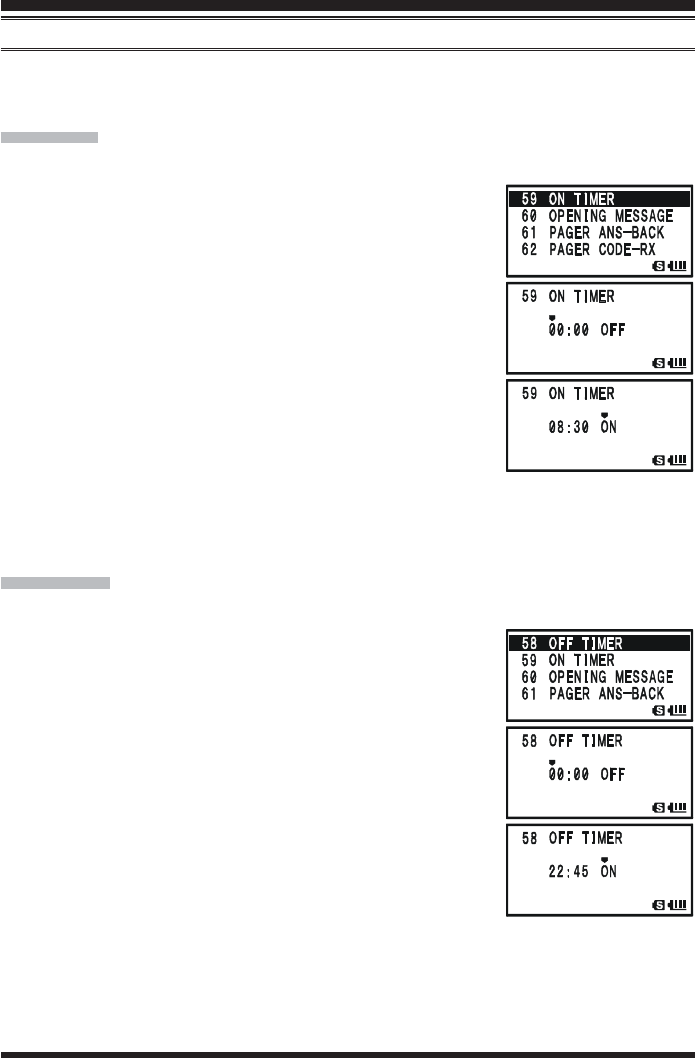
VX-8GR OPERATING MANUAL 115
ON/OFF PRESET TIMER
The VX-8GR includes the capability to turn itself on/off at preset time. If you use these
features, you must first set the VX-8GR’s clock, as described previously (page xx).
ON TIMER
1. Press and hold the m key for one second to enter the Set Mode.
2. Rotate the DIAL knob to select Set Mode Item 59: ON59: ON
59: ON59: ON
59: ON
TIMERTIMER
TIMERTIMER
TIMER.
3. Press the m key briefly to enable adjustment of this Set
Mode Item.
4. Rotate the DIAL knob to set the “hour” at which you want
the radio to switch on.
5. Press the M key, then rotate the DIAL knob to set the
“minute” at which you want the radio to switch on.
6. Press the M key, then rotate the DIAL knob to set this
Menu Item to “ONON
ONON
ON”.
7. When you have made your selections, press the PTT switch
to save the new setting and exit to normal operation.
To disable the ON Timer, just repeat the above procedure, rotating the DIAL knob to
select “OFFOFF
OFFOFF
OFF” in step 6 above.
OFF TIMER
1. Press and hold the m key for one second to enter the Set Mode.
2. Rotate the DIAL knob to select Set Mode Item 58: OFF58: OFF
58: OFF58: OFF
58: OFF
TIMERTIMER
TIMERTIMER
TIMER.
3. Press the m key briefly to enable adjustment of this Set
Mode Item.
4. Rotate the DIAL knob to set the “hour” at which you want
the radio to switch off.
5. Press the M key, then rotate the DIAL knob to set the
“minute” at which you want the radio to switch off.
6. Press the M key, then rotate the DIAL knob to set this
Menu Item to “ONON
ONON
ON”.
7. When you have made your selections, press the PTT switch
to save the new setting and exit to normal operation.
To disable the OFF Timer, just repeat the above procedure, rotating the DIAL knob to
select “OFFOFF
OFFOFF
OFF” in step 6 above.
MISCELLANEOUS SETTING
FCC ID: K6620415X20 / IC:511B-20415X20
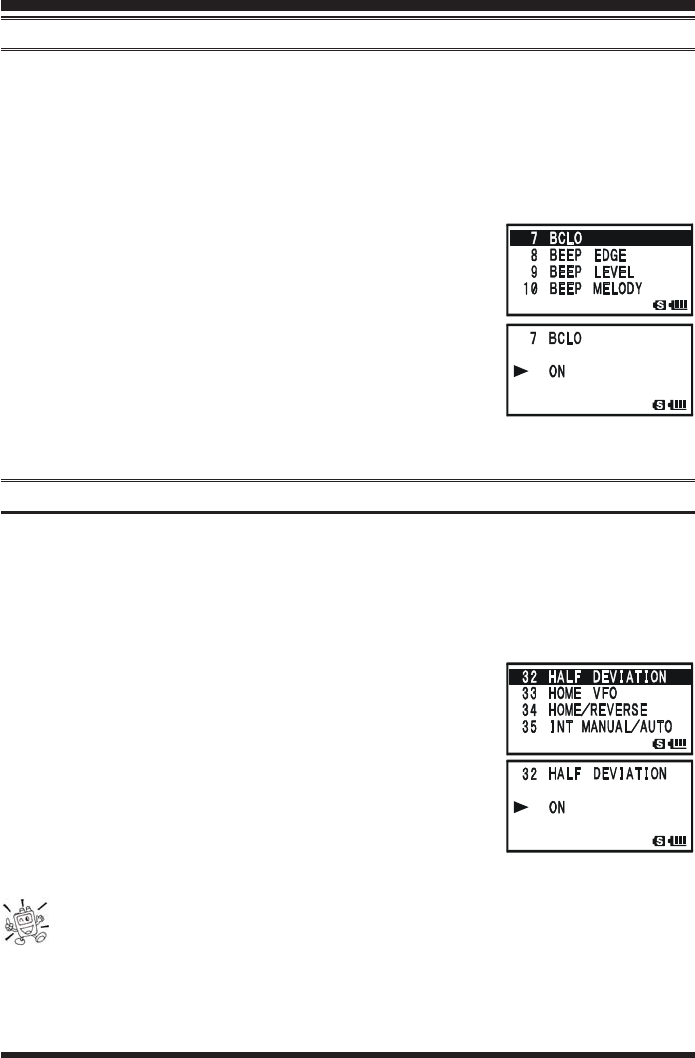
VX-8GR OPERATING MANUAL116
BUSY CHANNEL LOCK-OUT (BCLO)
The BCLO feature prevents the radio’s transmitter from being activated if a signal strong
enough to break through the “noise” squelch is present. On a frequency where stations
using different CTCSS or DCS codes may be active, BCLO prevents you from disrupting
their communications accidentally (because your radio may be muted by its own Tone
Decoder). The default setting for the BCLO is OFF, and here is how to change that setting:
1. Press and hold the m key for one second to enter the Set Mode.
2. Rotate the DIAL knob to select Set Mode Item 7: BCLO7: BCLO
7: BCLO7: BCLO
7: BCLO.
3. Press the m key briefly to enable adjustment of this Set
Mode Item.
4. Rotate the DIAL knob to set this Set Mode Item to “ONON
ONON
ON”
(thus activating the BCLO feature).
5. When you have completed your selection, press the PTT
switch to save the new setting and exit to normal operation.
To disable the BCLO feature, just repeat the above procedure,
rotating the DIAL knob to select “OFFOFF
OFFOFF
OFF” in step 4 above.
CHANGING THE TX DEVIATION LEVEL
In many areas of the world, channel congestion has required that operating channels be
closely spaced. In such operating environments, it is often required that operators use
reduced deviation levels, to reduce the potential for interference to users on adjacent chan-
nels. The VX-8GR includes a simple method of accomplishing this:
1. Press and hold the m key for one second to enter the Set Mode.
2. Rotate the DIAL knob to select Set Mode Item 32: HALF32: HALF
32: HALF32: HALF
32: HALF
DEVIATIONDEVIATION
DEVIATIONDEVIATION
DEVIATION.
3. Press the m key briefly to enable adjustment of this Set
Mode Item.
4. Rotate the DIAL knob to change this Set Mode Item to “ONON
ONON
ON”.
In this configuration (HALF DEVIATION active), the
transmitter’s deviation will be approximately ±2.5 kHz.
5. When you have completed your selection, press the PTT
switch to save the new setting and exit to normal operation.
The “normal” setting for the deviation (when this Set Mode Item is set to “OFF”)
is ±5 kHz.
MISCELLANEOUS SETTING
FCC ID: K6620415X20 / IC:511B-20415X20
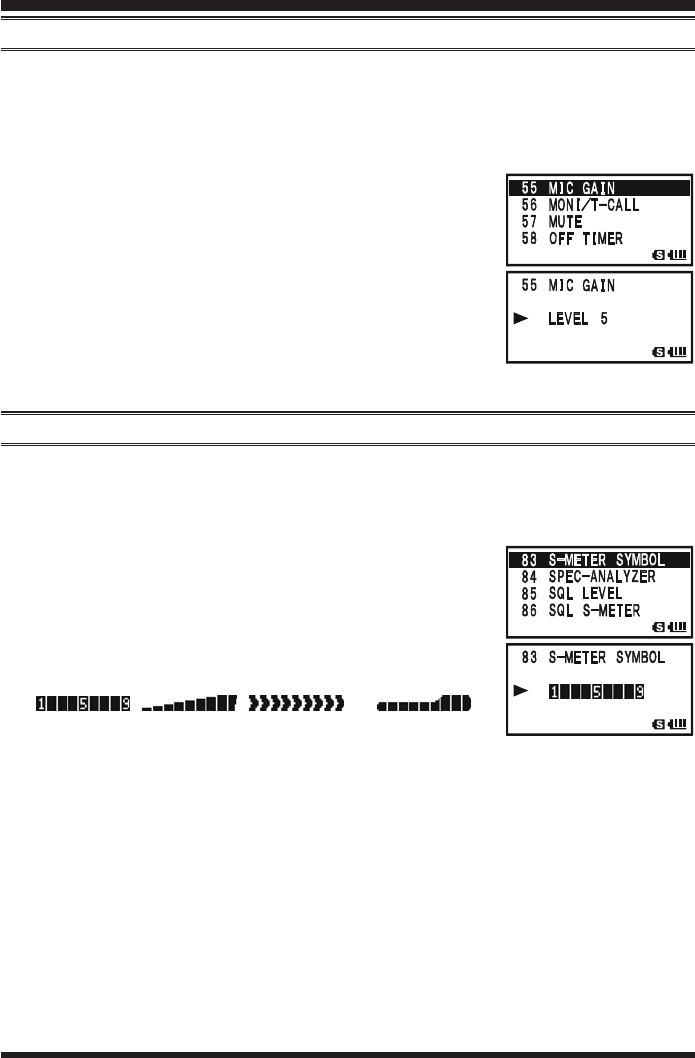
VX-8GR OPERATING MANUAL 117
CHANGING THE MICROPHONE GAIN
At the factory, a microphone gain has been programmed that should be satisfactory for the
internal microphone. If you use the radio under the noisy environment, you may wish to
set a different microphone gain level.
1. Press and hold the m key for one second to enter the Set Mode.
2. Rotate the DIAL knob to select Set Mode Item 55: MIC55: MIC
55: MIC55: MIC
55: MIC
GAINGAIN
GAINGAIN
GAIN.
3. Press the m key briefly to enable adjustment of this Set
Mode Item.
4. Rotate the DIAL knob to select the desired microphone level.
The available selections are LEVEL 1LEVEL 1
LEVEL 1LEVEL 1
LEVEL 1 - LEVEL 9LEVEL 9
LEVEL 9LEVEL 9
LEVEL 9 (factory
default: LEVEL 5LEVEL 5
LEVEL 5LEVEL 5
LEVEL 5).
5. When you have completed your selection, press the PTT
switch to save the new setting and exit to normal operation.
S-AND TX POWER METER SYMBOLS
The VX-8GR has four types of S- (Signal Strength) and TX Power Meter symbol formats
available. You may change the default setting to any of the available symbols.
1. Press and hold the m key for one second to enter the Set Mode.
2. Rotate the DIAL knob to select Set Mode Item 83: S-METER83: S-METER
83: S-METER83: S-METER
83: S-METER
SYMBOLSYMBOL
SYMBOLSYMBOL
SYMBOL.
3. Press the m key briefly to enable adjustment of this Set
Mode Item.
4. Rotate the DIAL knob to select the desired meter symbol
type.
, , , or
5. When you have completed your selection, press the PTT
switch to save the new setting and exit to normal operation.
MISCELLANEOUS SETTING
FCC ID: K6620415X20 / IC:511B-20415X20
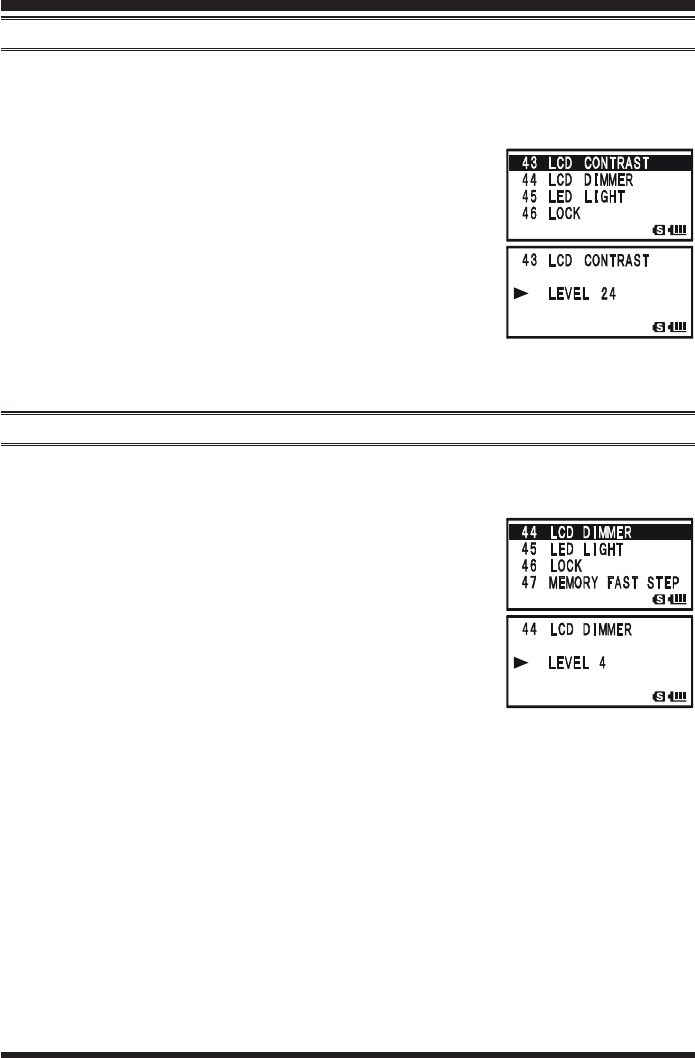
VX-8GR OPERATING MANUAL118
DISPLAY CONTRAST
The LCD’s contrast may be adjusted for best viewing in sunlight or darkness allowing for
best readability using the Set Mode Item.
1. Press and hold the m key for one second to enter the Set Mode.
2. Rotate the DIAL knob to select Set Mode Item 43: LCD43: LCD
43: LCD43: LCD
43: LCD
CONTRASTCONTRAST
CONTRASTCONTRAST
CONTRAST.
3. Press the m key briefly to enable adjustment of this Set
Mode Item.
4. Rotate the DIAL knob to adjust the contrast. As you make
the adjustment, you will be able to see the effects of your
changes. The available selections are LEVEL 12LEVEL 12
LEVEL 12LEVEL 12
LEVEL 12 - LEVELLEVEL
LEVELLEVEL
LEVEL
3232
3232
32 (factory default: LEVEL 24LEVEL 24
LEVEL 24LEVEL 24
LEVEL 24).
5. When you have completed your selection, press the PTT switch to save the new
setting and exit to normal operation.
DISPLAY DIMMER
The LCD and keypad illumination may be adjusted using the Set Mode Item, as well.
1. Press and hold the m key for one second to enter the Set Mode.
2. Rotate the DIAL knob to select Set Mode Item 44: LCD44: LCD
44: LCD44: LCD
44: LCD
DIMMERDIMMER
DIMMERDIMMER
DIMMER.
3. Press the m key briefly to enable adjustment of this Set
Mode Item.
4. Rotate the DIAL knob to adjust the display illumination for
a comfortable brightness level. As you make the adjustment,
you will be able to see the effects of your changes. The
available selections are LEVEL 1LEVEL 1
LEVEL 1LEVEL 1
LEVEL 1 - LEVEL 4LEVEL 4
LEVEL 4LEVEL 4
LEVEL 4 (factory default:
LEVEL 4LEVEL 4
LEVEL 4LEVEL 4
LEVEL 4).
5. When you have completed your selection, press the PTT switch to save the new
setting and exit to normal operation.
MISCELLANEOUS SETTING
FCC ID: K6620415X20 / IC:511B-20415X20
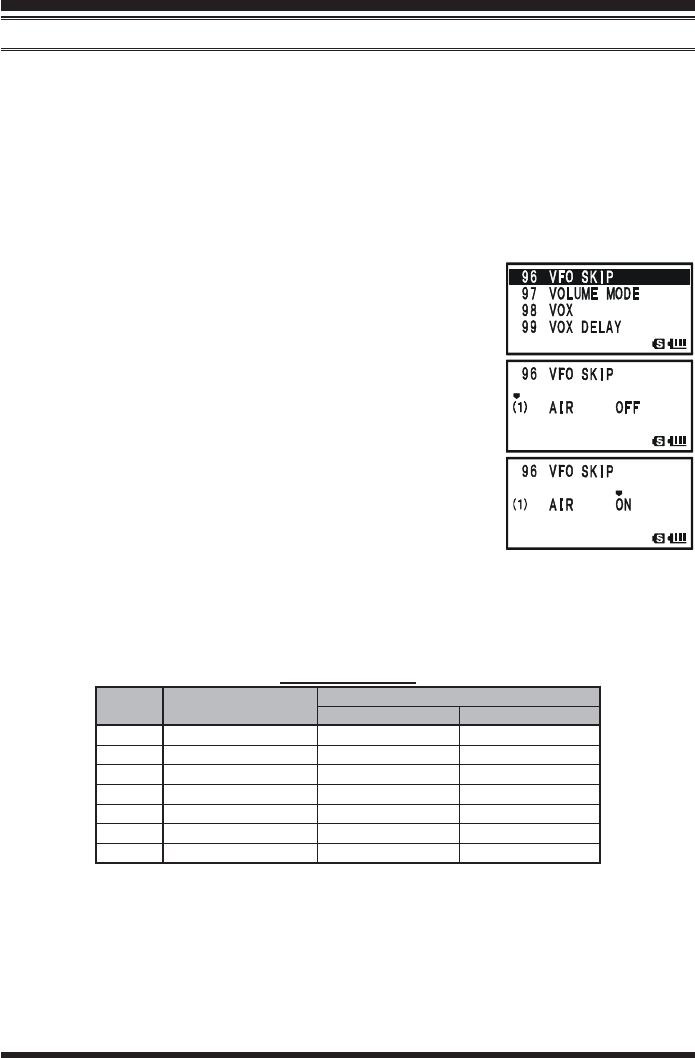
VX-8GR OPERATING MANUAL 119
MY BANDS OPERATION
The “My Bands” feature allows you to select several operating bands, and make only
those bands available for selection via the B key.
For example, if you do not need the reception of the VHF and UHF TV bands, you may
skip (omit) these bands from the band selection loop.
My Bands Setup
1. Set the VX-8GR to the VFO mode.
2. Press and hold the m key for one second to enter the Set Mode.
3. Rotate the DIAL knob to select Set Mode Item 96: VFO SKIP96: VFO SKIP
96: VFO SKIP96: VFO SKIP
96: VFO SKIP.
4. Press the m key briefly to enable adjustment of this Set
Mode Item.
5. Rotate the DIAL knob to choose a band number (see chart
below) you wish to omit (skip) form the band selection loop.
6. Press the M key, then rotate the DIAL knob to select
“ONON
ONON
ON” and omit (skip) the band from the band selection loop.
Note: The band presently in use cannot be turned “ONON
ONON
ON”.
7. Press the M key again.
8. Repeat steps 5 through 7 above to select as many bands as
you like.
9. When you have completed your selection, press the PTT
switch to save the new setting and exit to normal operation.
To re-institute a band into the band selection loop, repeat the above procedure, rotating the
DIAL knob to select “OFFOFF
OFFOFF
OFF” in step 6.
MISCELLANEOUS SETTING
OPERATING BAND
AIR Band
VHF HAM Band
VHF Band
INFO 1 Band
UHF HAM Band
UHF Band
INFO 2 Band
USA Version: Cellular Blocked
FREQUENCY RANGE
BAND
NUMBER
1
2
3
4
5
6
7
“VFO-B”
108-137 MHz
137-174 MHz
174-222 MHz
222-420 MHz
420-470 MHz
470-580 MHz
–
“VFO-A”
108-137 MHz
137-174 MHz
174-222 MHz
222-420 MHz
420-470 MHz
470-774 MHz
774-999.99 MHz
BAND NUMBER CHART
FCC ID: K6620415X20 / IC:511B-20415X20
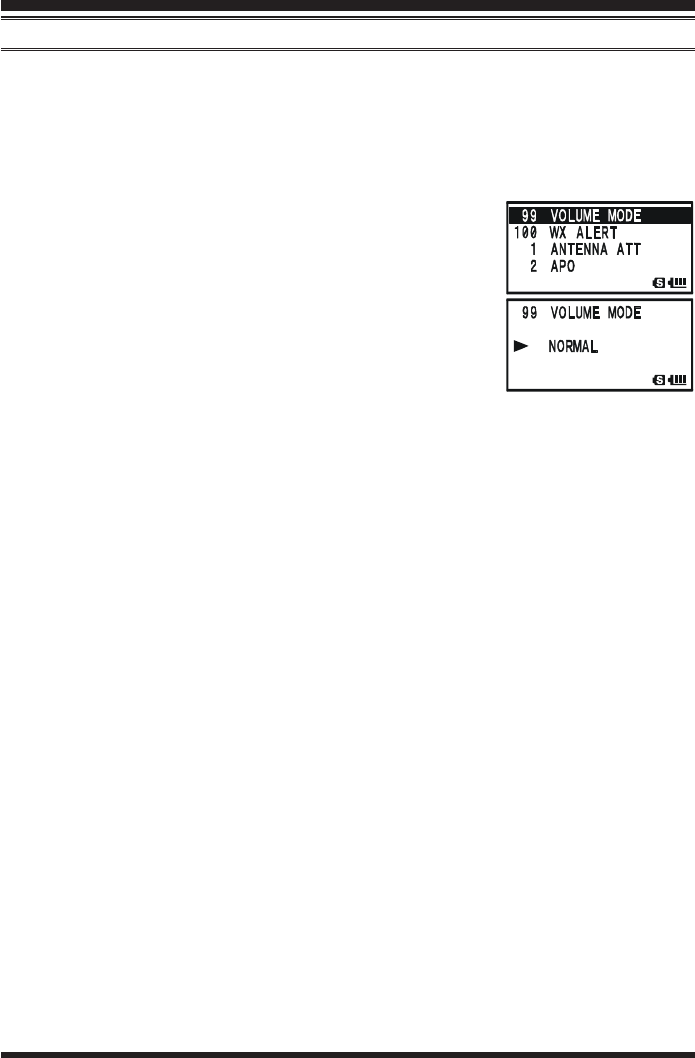
VX-8GR OPERATING MANUAL120
CHANGING THE STATUS OF THE gg
gg
g KEY
By factory default, the g key keeps the status while pressing and holding the g key
down. You may change the status of the g key to keep the status for approximately
three seconds after pressing the g key, after which time it reverts back to its previous
status.
1. Press and hold the m key for one second to enter the Set Mode.
2. Rotate the DIAL knob to select Set Mode Item 99: VOL-99: VOL-
99: VOL-99: VOL-
99: VOL-
UME MODEUME MODE
UME MODEUME MODE
UME MODE.
3. Press the m key briefly to enable adjustment of this Set
Mode Item.
4. Rotate the DIAL knob to select the desired mode.
NORMALNORMAL
NORMALNORMAL
NORMAL: The g key keeps the status while pressing
and holding the g key down.
AUTO BACKAUTO BACK
AUTO BACKAUTO BACK
AUTO BACK: The g key keeps its status for approxi-
mately three seconds after pressing the g key.
5. When you have completed your selection, press the PTT switch to save the new
setting and exit to normal operation.
MISCELLANEOUS SETTING
FCC ID: K6620415X20 / IC:511B-20415X20

VX-8GR OPERATING MANUAL 121
RESET PROCEDURES
In some instances of erratic or unpredictable operation, the cause may be corruption of
data in the microprocessor (due to static electricity, etc.). If this happens, resetting of the
microprocessor may restore normal operation.
Note that all memories will be erased if you do a complete microprocessor reset,
as described below.
MICROPROCESSOR RESETTING
To clear all memories and other settings to factory defaults:
1. Turn the radio off.
2. Press and hold in the B, h, and d keys while turning the radio on.
3. Press the f key briefly to reset all settings to their factory defaults (press any other
key to cancel the Reset procedure).
SET MODE RESETTING
To reset the Set Mode (includes the APRS®/GPS Set Mode) settings to their factory de-
faults:
1. Turn the radio off.
2. Press and hold in the B and c keys while turning the radio on.
3. Press the f key briefly to reset the Set Mode Item settings to their factory defaults
(press any other key to cancel the Reset procedure).
:Except the following Set Mode Items.
Set Mode 6: BANK NAME, 15: CLOCK SHIFT, 16: CW ID,
21: DCS CODE, 22: DCS INVERSION,
25: DTMF SELECT, 29: EMERGENCY SELECT,
32: HALF DEVIATION, 37: INTERNET CODE,
40: INTERNET SELECT, 47: MEMORY FIRST STEP,
48: MEMORY NAME, 50: MEMORY SKIP,
54: MESSAGE SELECT, 62: PAGER CODE-RX,
63: PAGER CODE-TX, 70: RPT SHIFT,
71: RPT SHIFT FREQ, 88: SQL TYPE,
91: TONE FREQUENCY,
APRS®/GPS Set Mode 4: APRS MSG FLASH, 16: DIGI PASS,
21: MSG GROUP, 22: MY CALLSIGN,
23: MY POSITION, 24: MY SYMBOL
FCC ID: K6620415X20 / IC:511B-20415X20
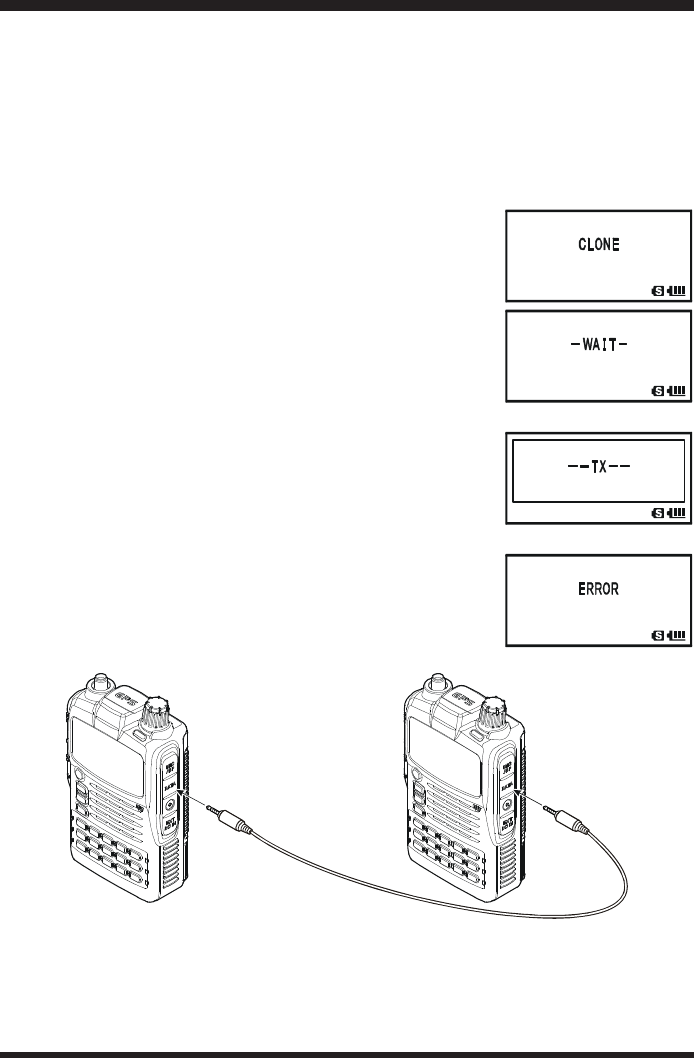
VX-8GR OPERATING MANUAL122
The VX-8GR includes a convenient “Clone” feature, which allows the memory and con-
figuration data from one transceiver to be transferred to another VX-8GR. This can be
particularly useful when configuring a number of transceivers for a public service opera-
tion. Here is the procedure for Cloning one radio’s data to another:
1. Turn both radios off.
2. Connect the optional CT-144 Clone Cable between the DATA jacks of the two ra-
dios.
3. Press and hold in the f key while turning the radios on.
Do this for both radios (the order of switch-on does not
matter). “CLONECLONE
CLONECLONE
CLONE” will appear on the displays of both ra-
dios when the Clone mode is successfully activated in this
step.
4. On the Destination radio, press the M key (“- WAIT -- WAIT -
- WAIT -- WAIT -
- WAIT -”
will appear on the LCD).
5. Press the B key on the Source radio; “- - TX - -- - TX - -
- - TX - -- - TX - -
- - TX - -” will
appear on the Source radio, and the data from this radio
will be transferred to the other radio.
6. If there is a problem during the cloning process, “ERRORERROR
ERRORERROR
ERROR”
will be displayed. Check your cable connections and bat-
tery voltage, and try again.
7. If the data transfer is successful, “CLONECLONE
CLONECLONE
CLONE” will reappear on
both displays. Turn both radios off and disconnect the Clone
Cable. You can then turn the radios back on, and begin nor-
mal operation.
CLONING
(Destination radio)
(Source radio)
CT-143 CloneCable
(Option)
DATA Jack DATA Jack
FCC ID: K6620415X20 / IC:511B-20415X20

VX-8GR OPERATING MANUAL 123
FCC ID: K6620415X20 / IC:511B-20415X20
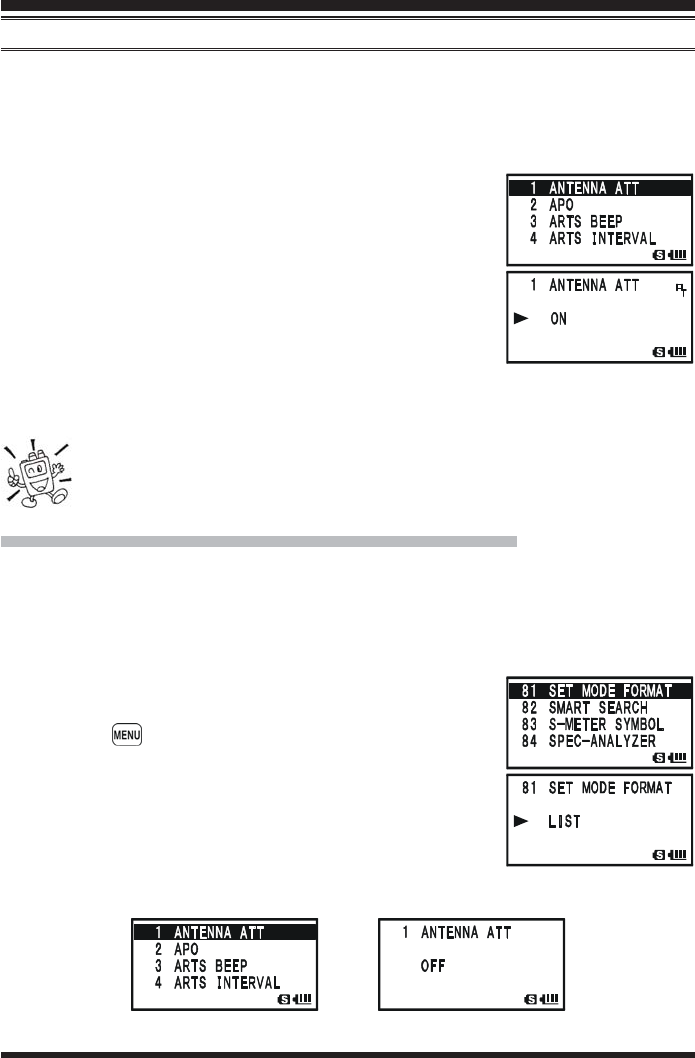
VX-8GR OPERATING MANUAL124
GENERAL
The VX-8GR Set Mode, already described in parts of many previous chapters, is easy to
activate and set. It may be used for configuration of a wide variety of transceiver param-
eters, some of which have not been detailed previously. Use the following procedure to
activate the Set Mode:
1. Press and hold the m key for one second to enter the Set
Mode.
2. Rotate the DIAL knob to select Set Mode Item to be ad-
justed.
3. Press the m key briefly to enable adjustment of the Set
Mode Item.
4. Rotate the DIAL knob to adjust or select the parameter to
be changed on the Set Mode Item selected in above step.
5. After completing your selection and adjustment, press the PTT switch briefly to save
the new setting and exit to normal operation.
Some Set Mode Items (like Set Mode Item 91: TONE FREQUENCY) re-
quire that the m key be pressed after setting of the parameter, and before
exiting to normal operation.
CHANGING THE DISPLAY FORMAT OF THE SET MODE ITEM
By factory default setting, the VX-8GR displays the Set Mode Item with “List” format in
a Set Mode. You may change the display format of the Set Mode to our traditional “Item”
format.
1. Press and hold the m key for one second to enter the Set Mode.
2. Rotate the DIAL knob to select Set Mode Item 81: SET81: SET
81: SET81: SET
81: SET
MODE FORMATMODE FORMAT
MODE FORMATMODE FORMAT
MODE FORMAT.
3. Press the key briefly to enable adjustment of this Set
Mode Item.
4. Rotate the DIAL knob to select “ITEMITEM
ITEMITEM
ITEM”.
5. Press the PTT switch briefly to save the new setting and
exit to normal operation.
To return the display format to the “List”, repeat the above pro-
cedure, rotating the DIAL knob to select “LISTLIST
LISTLIST
LIST” in step 4.
SET MODE
(“LIST” format) (“ITEM” format)
FCC ID: K6620415X20 / IC:511B-20415X20
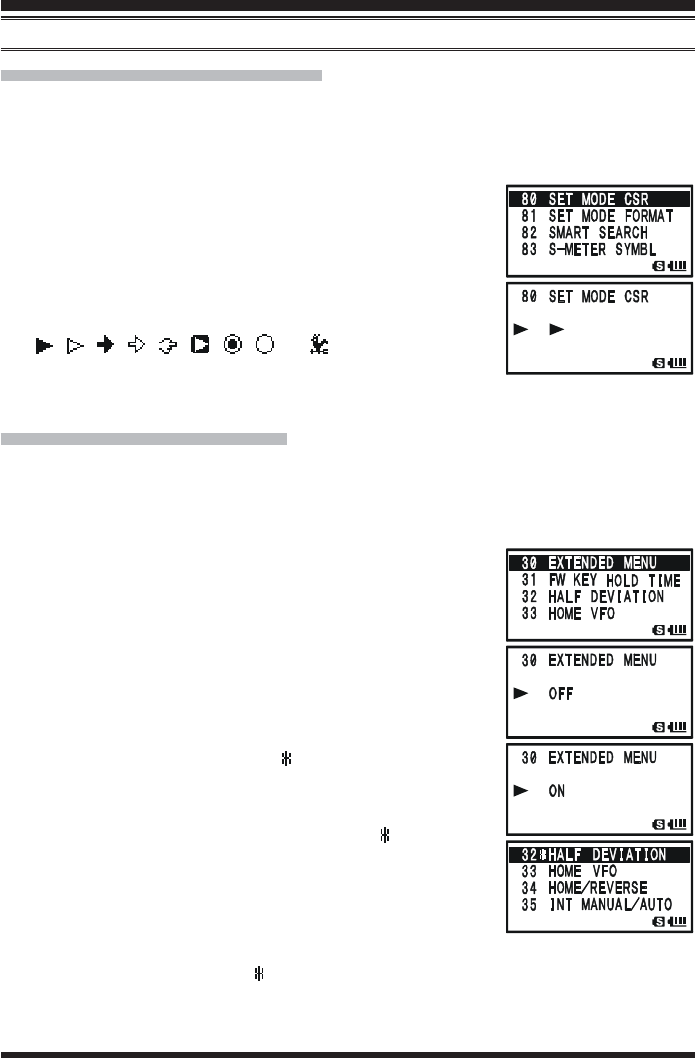
VX-8GR OPERATING MANUAL 125
SET MODE
CHANGING THE SET MODE CURSOR
The VX-8GR has nine types of cursor symbol formats for the Set Mode operation. You
may change the default setting to any of the available symbols.
1. Press and hold the m key for one second to enter the Set Mode.
2. Rotate the DIAL knob to select Set Mode Item 80: SET80: SET
80: SET80: SET
80: SET
MODE CSRMODE CSR
MODE CSRMODE CSR
MODE CSR.
3. Press the g key briefly to enable adjustment of this Set
Mode Item.
4. Rotate the DIAL knob to select the desired cursor symbol
type.
, , , , , , , , or
5. When you have completed your selection, press the PTT
switch to save the new setting and exit to normal operation.
MASKING THE SET MODE ITEMS
There may be situations where you want to “Mask” Set Mode Items so they are not re-
called during Set Mode Item selection.
1. Press and hold the m key for one second to enter the Set Mode.
2. Rotate the DIAL knob to select Set Mode Item 30: EX-30: EX-
30: EX-30: EX-
30: EX-
TENDED MENUTENDED MENU
TENDED MENUTENDED MENU
TENDED MENU.
3. Press the m key briefly to enable adjustment of this Set
Mode Item.
4. Rotate the DIAL knob to select “ONON
ONON
ON”, then press the m
key briefly.
5. Rotate the DIAL knob to select the Set Mode Item to be
“Masked”.
6. Press the f key briefly. A “ ” icon will appear at the
right side of the Set Mode Item Number in the display, indi-
cating the Set Mode Item is to be Masked.
7. Repeat steps 5 and 6 above, to append the “ ” icon to any
other Set Mode Item you wish to “Masked”.
8 When you have completed your selection, press the PTT
switch to save the new setting and exit to normal operation.
To unmask the hidden Set Mode Item, repeat the above procedure. In step 4 above select
“OFFOFF
OFFOFF
OFF” and in step 6 above the “ ” icon will disappear from the Menu Item you wish to
unmask.
GENERAL
FCC ID: K6620415X20 / IC:511B-20415X20

VX-8GR OPERATING MANUAL126
1: ANTENNA ATT
2: APO
3: ARTS BEEP
4: ARTS INTERVAL
5: BANK LINK
6: BANK NAME
7: BCLO
8: BEEP EDGE
9: BEEP LEVEL
10: BEEP MELODY
11: BEEP SELECT
12: BELL RINGER
13: BELL SELECT
14: BUSY LED
15: CLOCK SHIFT
16: CW ID
17: CW LEARNING
18: CW PITCH
19: CW TRAINING
20: DC VOLTAGE
21: DCS CODE
22: DCS INVERSION
23: DTMF DELAY
24: DTMF MANUAL/AUTO
25: DTMF SELECT
26: DTMF SPEED
27: EAI
28: EAI TIME
29: EMERGENCY SELECT
30: EXTENDED MENU
31: FW KEY HOLD TIME
32: HALF DEVIATION
33: HOME VFO
34: HOME/REVERSE
35: INT MANUAL/AUTO
36: INTERNET
37: INTERNET CODE
38: INTERNET KEY
39: INTERNET MODE
40: INTERNET SELECT
41: LAMP
42: LANGUAGE
43: LCD CONTRAST
44: LCD DIMMER
45: LED LIGHT
46: LOCK
47: MEMORY FAST STEP
48: MEMORY NAME
49: MEMORY PROTECT
SET MODE
Enables/Disables the receiver Front-end Attenuator.
Setting of the Automatic Power-Off time.
Select the Beep option during ARTSTM operation.
Select the Polling Interval during ARTSTM operation.
Enables/Disables the Memory Bank Link Scan.
Stores Alpha-Numeric “Tag” for the Memory Bank.
Enables/disables the Busy Channel Lock-Out feature.
Enables/disables the Band-edge beeper while selecting the frequency by the DIAL knob.
Adjust the Beep volume level.
Create the Beep Melody for Bell ringer function.
Enables/Disables the keypad beeper.
Selects the number of Bell ringer repetitions.
Enables/Disables the Bell ringer function and its sound selection.
Enables/Disables the BUSY LED while the squelch is open.
Shifting of CPU clock frequency.
Program and activate the CW Identifier (used during ARTSTM operation).
Enables/Disables the CW Learning feature.
Select the CW tone pitch for the CW Learning, CW Training, and CW Identifier functions.
Enables/Disables the CW Training feature.
Indicates the DC Supply Voltage.
Setting of the DCS code.
Enables/Disables the “Inverted” DCS tone.
Selects the DTMF Autodialer Delay Time.
Enables/Disables the DTMF Autodial feature.
Programming of the DTMF Autodialer.
Selects the DTMF Autodialer Sending Speed.
Enables/Disables the Emergency Automatic ID (EAI) feature.
Sets the Emergency Automatic ID (EAI) operating mode and its transmit time.
Select the alarms utilized when the Emergency function is engaged.
Enables/Disables the extended Set Mode Menu.
Set the duration that a secondary function of the [F/W] key (press and holding the [F/W] key)
is held determines the function they activate.
Reducing the Deviation level by 50 %.
Enables/Disables the function of the VFO DIAL knob, while in the Home Channel mode.
Selects the primary function of the [H/M] key (press the [H/M] key).
Enables/Disables the DTMF Autodialer feature while operating using the Internet Connec-
tion feature (WIRESTM).
Enables/Disables the Internet Connection feature (WIRESTM).
Selects the Access Number (DTMF digit) for the SRG operation of the Internet Connection
feature (WIRESTM).
Selects the primary function of the [INTERNET] key.
Selects the operating mode of the Internet Connection feature (WIRESTM).
Programming of the Access Number (DTMF code) for the FRG station of the WIRESTM (or
non WIRESTM Internet Link System) access.
Selects the LCD/Keypad Lamp mode.
Selects the language for the Set Mode selections.
Setting of the Display contrast level.
Setting of the Display brightness level.
Illuminates the white LED light continuously (useful as emergency flashlight at night).
Selects the Control Locking lockout combination.
Selects the channel step for the fast channel selection mode while in the Memory Recall
mode.
Stores “Alpha-Numeric” tags for the Memory channels.
Enables/Disables the Memory Write Protector.
SET MODE ITEM FUNCTION
ON / OFF
0.5hour - 12.0hour / OFF
IN RANGE / ALWAYS / OFF
15sec / 25sec
--
--
ON / OFF
ON / OFF
LEVEL 1 ~ LEVEL 9 (LEVEL 5)
--
KEY & SCAN / KEY / OFF
1Time - 20Times / CONTINUOUS
OFF / BELL /
USER BP1 / USER BP2 / USER BP3
ON / OFF
ON / OFF
--
--
400 - 1000 Hz (50 Hz/step) (700 Hz)
--
--
104 standard DCS codes (DCS 023)
RX-NORMAL, TX-NORMAL /
RX-INVERT, TX-NORMAL /
RX-BOTH, TX-NORMAL /
RX-NORMAL, TX-INVERT /
RX-INVERT, TX-INVERT /
RX-BOTH, TX-INVERT
50ms / 250ms / 450ms / 750ms / 1000ms
MANUAL / AUTO
--
50ms / 100ms
ON / OFF
INT 1min ~ INT 9min / INT10min / INT15min /
INT20min / INT30min / INT40min / INT50min /
CON 1min ~ CON 9min / CON10min /
CON15min / CON20min / CON30min /
CON40min / CON50min (CON 5min)
BEEP / STROBE / BEEP&STROBE /
BEAM / BEEP&BEAM / CW / BEEP&CW /
CW-ID TX
ON / OFF
FW0.3sec / FW0.5sec / FW0.7sec /
FW1.0sec / FW1.5sec
ON / OFF
DISABLE / ENABLE
HOME / REV
MANUAL / AUTO
ON / OFF
DTMF 0 ~ DTMF 1, DTMF A ~ DTMF D,
DTMF , DTMF # (DTMF 1)
INTERNET / INTERNET SELECT /
SET MODE
FRG / SRG
--
KEY 2sec - KEY10sec / CONTINUOUS /
OFF (KEY 5sec)
ENGLISH / JAPANESE
LEVEL 12 ~ LEVEL32 (LEVEL24)
LEVEL 1 ~ LEVEL 4
--
KEY / DIAL / KEY&DIAL / PTT / KEY&PTT /
DIAL&PTT / ALL
10CH / 20CH / 50CH / 100CH
--
ON / OFF
AVAILABLE VALUES
(DEFALT: BOLD ITALIC)
FCC ID: K6620415X20 / IC:511B-20415X20

VX-8GR OPERATING MANUAL 127
SET MODE
50: MEMORY SKIP
51: MEMORY WRITE
52: MESSAGE LIST
53: MESSAGE REGISTER
54: MESSAGE SELECT
55: MIC GAIN
56: MONI/T-CALL
57: MUTE
58: OFF TIMER
59: ON TIMER
60: OPENING MESSAGE
61: PAGER ANS-BACK
62: PAGER CODE-RX
63: PAGER CODE-TX
64: PASSWORD
65: PR FREQUENCY
66: PRI REVERT
67: PRI TIME
68: PTT DELAY
69: RPT ARS
70: RPT SHIFT
71: RPT SHIFT FREQ
72: RX MODE
73: SAVE RX
74: SAVE TX
75: SCAN LAMP
76: SCAN RE-START
77: SCAN RESUME
78: SENSOR DISPLAY
79: SENSOR INFO
80: SET MODE CSR
81: SET MODE FORMAT
82: SMART SEARCH
83: S-METER SYMBOL
84: SPEC-ANALYZER
85: SQL LEVEL
86: SQL S-METER
87: SQL SPLIT
88: SQL TYPE
89: STEP FREQUENCY
90: TIME SET
91: TONE FREQUENCY
92: TONE-SRCH MUTE
93: TONE-SRCH SPEED
94: TOT
95: VFO MODE
96: VFO SKIP
97: VIBRATOR
98: VIBRATOR MODE
99: VOLUME MODE
100: WX ALERT
Selects the Memory Scan channel-selection mode.
Determines the method of selecting channels for Memory Storage.
Programming a Member List for the Message feature.
Selects your Personal ID for the Message feature.
Programming a Message for the Message feature.
Adjusts the microphone gain level.
Selects the MONI key (just below the PTT switch) function.
Adjusts the receiver audio output level when the MUTE function was activated.
Set the OFF Timer time.
Set the ON Timer time.
Selects the Opening Message that appears when the radio is powered on.
Enables/Disables the Answer Back function of the Enhanced CTCSS Paging & Code Squelch.
Sets the Receiver Pager Code for the Enhanced CTCSS Paging & Code Squelch.
Sets the Transmitting Pager Code for the Enhanced CTCSS Paging & Code Squelch.
Programming and activating the Password feature.
Program the CTCSS Tone Frequency for the User Programmed Reverse CTCSS Decoder.
Enables/Disables the Priority Revert feature.
Selects the time between the Priority (Dual Watch) channel checks, when the feature is
active.
Selects the time delay before the carrier is transmitted, when the PTT switch is pressed.
Enables/Disables the Automatic Repeater Shift function.
Sets the Repeater Shift Direction.
Sets the magnitude of the Repeater Shift.
Sets the receiving mode.
Selects the Receive-mode Battery Saver interval (“sleep” ratio).
Enables/Disables the Transmitter Battery Saver.
Enables/Disables the Scan Lamp (while scanner is paused).
Selects the Scan Re-start Delay time.
Selects the Scan Resume mode.
Selects the sensor information when the transceiver is operating in the “Mono” band mode
with large characters.
Indicates the Information of the internal sensors.
Selects the Set Mode Cursor.
Selects the display format of the Set Mode operation.
Selects the Smart Search Sweep mode.
Selects the S- & TX PO meter Symbol.
Selects the Spectrum Analyzer sweep mode.
Sets the Squelch threshold level.
Adjusts the Squelch threshold level to the S-meter level.
Enables/disables split CTCSS/DCS coding.
Selects the Tone Encoder and/or Decoder mode.
Setting of the DIAL frequency steps.
Sets the Clock time.
Setting of the CTCSS Tone Frequency
Enables/Disables the receiver audio output while the Tone Search Scanner is activated.
Selects the Tone Search Scanner speed.
Setting of the TOT time
Selects or disables the VFO band edge limiting for the current band.
Setting My Band.
Enables/Disables the Vibrator function.
Selects the vibration mode of the Vibrator function.
Select the [VOL] key function.
Enables/Disables the Weather Alert Feature
OFF / SKIP / ONLY
NEXT / LOWER
--
--
--
LEVEL 1 ~ LEVEL 9 (LEVEL 5)
MONI / T-CALL1
MUTE 30%, MUTE 50%,
MUTE 100%, or OFF
--
--
NORMAL / OFF / DC / MESSAGE
ON / OFF
--
--
--
300Hz ~ 3000Hz (1000Hz/step) (1600Hz)
ON / OFF
0.1sec ~ 0.9sec (0.1sec/step) or
1.0sec ~ 10.0sec (0.5sec/step) (5.0sec)
OFF / 20ms / 50ms / 100ms / 200ms
ON / OFF
SIMPLEX / -RPT / +RPT
0.000MHz ~ 150.000MHz (50 kHz/step)2
AUTO / NFM / AM
0.2sec ~ 0.9sec (0.1sec/step),
1.0sec ~ 9.5sec (0.5sec/step), or
10.0sec ~ 60.0sec (5sec/step)
ON / OFF
ON / OFF
0.1sec ~ 0.9sec (0.1sec/step) or
1.0sec ~ 10.0sec (0.5sec/step) (2.0sec)
2.0sec ~ 10.0sec (0.5sec/step) /BUSY /
HOLD (5.0sec)
DC / TEMP / WAVE / BARO / ALTI / OFF
--
Nine patterns
LIST / ITEM
SINGLE / CONTINUOUS
Four patterns
1Time / CONTINUOUS / Full Time
LEVEL 0 ~ LEVEL 15 (LEVEL 1)
OFF / LEVEL 0 ~ LEVEL 9
OFF / ON
OFF / TONE / TONE SQL / DCS /
REV TONE / PR FREQ / PAGER / MESSAGE
AUTO / 5.0 / 6.25 / 8.33 / 9.0 / 10.0 / 12.5 /
15.0 / 20.0 / 25.0 / 50.0 / 100.0 kHz
--
50 standard CTCSS tones (100.0Hz)
ON / OFF
FAST (2.5 tone/sec) / SLOW (1.25 tone/sec)
OFF / 0.5min ~ 10.0min (0.5min/step)
(3.0min)
ALL / BAND
--
OFF / BUSY / SIGNALING
MODE1 / MODE2 / MODE3
NORMAL / AUTO BACK
ON / OFF
SET MODE ITEM FUNCTION AVAILABLE VALUES
(DEFALT: UNDERLINED BOLD)
1: Depends on the transceiver version.
2: Depends on the operating band and transceiver version.
FCC ID: K6620415X20 / IC:511B-20415X20

VX-8GR OPERATING MANUAL128
SET MODE
REPEATER SETTING
Enables/Disables the Automatic Repeater Shift function.
Sets the Repeater Shift Direction.
Sets the magnitude of the Repeater Shift.
CTCSS/DCS/EPCS SETTING
Selects the number of Bell ringer repetitions.
Enables/Disables the Bell ringer function and its sound selection.
Setting of the DCS code.
Enables/Disables the “Inverted” DCS tone.
Enables/Disables the Answer Back function of the Enhanced CTCSS Paging & Code Squelch.
Sets the Receiver Pager Code for the Enhanced CTCSS Paging & Code Squelch.
Sets the Transmitting Pager Code for the Enhanced CTCSS Paging & Code Squelch.
Program the CTCSS Tone Frequency for the User Programmed Reverse CTCSS Decoder.
Enables/Disables split CTCSS/DCS coding.
Selects the Tone Encoder and/or Decoder mode.
Setting of the CTCSS Tone Frequency
Enables/Disables the receiver audio output while the Tone Search Scanner is activated.
Selects the Tone Search Scanner speed.
ARTSTM SETTING
Select the Beep option during ARTSTM operation.
Select the Polling Interval during ARTSTM operation.
Program and activate the CW Identifier (used during ARTSTM operation).
MEMORY SETTING
Enables/Disables the Memory Bank Link Scan.
Stores Alpha-Numeric “Tag” for the Memory Bank.
Selects the channel step for the fast channel selection mode while in the Memory Recall mode.
Stores “Alpha-Numeric” tags for the Memory channels.
Enables/Disables the Memory Write Protector.
Determines the method of selecting channels for Memory Storage.
SCAN SETTING
Selects the Memory Scan channel-selection mode.
Enables/Disables the Scan Lamp (while scanner is paused).
Selects the Scan Re-start Delay time.
Selects the Receive-mode Battery Saver interval (“sleep” ratio).
Enables/Disables the Priority Revert feature.
Selects the time between the Priority (Dual Watch) channel checks, when the feature is active.
BATTERY SAVING SETTING
Setting of the Automatic Power-Off time.
Enables/Disables the BUSY LED while the squelch is open.
Selects the Receive-mode Battery Saver interval (“sleep” ratio).
Enables/Disables the Transmitter Battery Saver.
MESSAGE SETTING
Programming a Member List for the Message feature.
Selects your Personal ID for the Message feature.
Programming a Message for the Message feature.
WIRESTM SETTING
Enables/Disables the DTMF Autodialer feature while using the Internet Connection feature (WIRESTM).
Enables/Disables the Internet Connection feature (WIRESTM).
Selects the Access Number (DTMF digit) for SRG operation of the Internet Connection feature (WIRESTM).
Selects the primary function of the [INTERNET] key.
Selects the operating mode of the Internet Connection feature (WIRESTM).
Programming of the Access Number (DTMF code) for the FRG station of the WIRESTM (or non WIRESTM
Internet Link System) access.
EAI SETTING
Enables/Disables the Emergency Automatic ID (EAI) feature.
Sets the Emergency Automatic ID (EAI) operating mode and its transmit time.
Select the alarms utilized when the Emergency function is engaged.
SET
69:
70:
71:
SET
12:
13:
21:
22:
61:
62:
63:
65:
87:
88:
91:
92:
93:
SET
3:
4:
16:
SET
5:
6:
47:
48:
49:
51:
SET
50:
75:
76:
77:
66:
67:
SET
2:
14:
73:
74:
SET
52:
53:
54:
SET
35:
36:
37:
38:
39:
40:
SET
27:
28:
29:
MODE ITEM
RPT ARS
RPT SHIFT
RPT SHIFT FREQ
MODE ITEM
BELL RINGER
BELL SELECT
DCS CODE
DCS INVERSION
PAGER ANS-BACK
PAGER CODE-RX
PAGER CODE-TX
PR FREQUENCY
SQL SPLIT
SQL TYPE
TONE FREQUENCY
TONE-SRCH MUTE
TONE-SRCH SPEED
MODE ITEM
ARTS BEEP
ARTS INTERVAL
CW ID
MODE ITEM
BANK LINK
BANK NAME
MEMORY FAST STEP
MEMORY NAME
MEMORY PROTECT
MEMORY WRITE
MODE ITEM
MEMORY SKIP
SCAN LAMP
SCAN RE-START
SCAN RESUME
PRI REVERT
PRI TIME
MODE ITEM
APO
BUSY LED
SAVE RX
SAVE TX
MODE ITEM
MESSAGE LIST
MESSAGE REGISTER
MESSAGE SELECT
MODE ITEM
INT MANUAL/AUTO
INTERNET
INTERNET CODE
INTERNET KEY
INTERNET MODE
INTERNET SELECT
MODE ITEM
EAI
EAI TIME
EMERGENCY SELECT
A
VAILABLE
V
ALUES
(D
EFAULT
: B
OLD
I
TALIC
)
ON / OFF
SIMPLEX / -RPT / +RPT
0.000MHz ~ 150.000MHz (50 kHz/step)1
A
VAILABLE
V
ALUES
(D
EFAULT
: B
OLD
I
TALIC
)
1time - 20times / CONTINUOUS
OFF / BELL / USER BP1 / USER BP2 /
USER BP3
104 standard DCS codes (DCS 023)
RX-NORMAL, TX-NORMAL /
RX-INVERT, TX-NORMAL /
RX-BOTH, TX-NORMAL /
RX-NORMAL, TX-INVERT /
RX-INVERT, TX-INVERT / RX-BOTH, TX-INVERT
ON / OFF
--
--
300 Hz ~ 3000 Hz (1000 Hz/step) (1600 Hz)
OFF / ON
OFF / TONE / TONE SQL / DCS / REV TONE /
PR FREQ / PAGER / MESSAGE
50 standard CTCSS tones (100.0Hz)
ON / OFF
FAST (2.5 tone/sec) / SLOW (1.25 tone/sec)
A
VAILABLE
V
ALUES
(D
EFAULT
: B
OLD
I
TALIC
)
IN RANGE / ALWAYS / OFF
15sec / 25sec
--
A
VAILABLE
V
ALUES
(D
EFAULT
: B
OLD
I
TALIC
)
--
--
10CH / 20CH / 50CH / 100CH
--
ON / OFF
NEXT / LOWER
A
VAILABLE
V
ALUES
(D
EFAULT
: B
OLD
I
TALIC
)
OFF / SKIP / ONLY
ON / OFF
0.1sec ~ 0.9sec (0.1sec/step) or
1.0sec ~ 10.0sec (0.5sec/step) (5.0sec)
2.0sec ~ 10.0sec (0.5sec/step) /
BUSY / HOLD (5.0sec)
ON / OFF
0.1sec ~ 0.9sec (0.1sec/step) or
1.0sec ~ 10.0sec (0.5sec/step) (5.0sec)
A
VAILABLE
V
ALUES
(D
EFAULT
: B
OLD
I
TALIC
)
0.5hour - 12.0hour / OFF
ON / OFF
0.2sec ~ 0.9sec (0.1sec/step),
1.0sec ~ 9.5sec (0.5sec/step), or
10.0sec ~ 60.0sec (5sec/step)
ON / OFF
A
VAILABLE
V
ALUES
(D
EFAULT
: B
OLD
I
TALIC
)
--
--
--
A
VAILABLE
V
ALUES
(D
EFAULT
: B
OLD
I
TALIC
)
MANUAL / AUTO
ON / OFF
DTMF 0 ~ DTMF 9, DTMF A ~ DTMF D, DTMF ,
or DTMF # (DTMF 1)
INTERNET / INT SELECT / SET MODE
FRG / SRG
--
A
VAILABLE
V
ALUES
(D
EFAULT
: B
OLD
I
TALIC
)
ON / OFF
INT 1min ~ INT 9min, INT10min, INT15min,
INT20min, INT30min, INT40min, INT50min,
CON 1min ~ CON 9min, CON10min, CON15min,
CON20min, CON30min, CON40min, CON50min,
(CON 5min)
BEEP / STROBE / BEEP & STROBE / BEAM /
BEEP & BEAM / CW / BEEP & CW / CW-ID TX
FCC ID: K6620415X20 / IC:511B-20415X20

VX-8GR OPERATING MANUAL 129
SET MODE
VIBRATOR SETTING
Enables/Disables the Vibrator function.
Selects the vibration mode of the Vibrator function.
DTMF SETTING
Selects the DTMF Autodialer Delay Time.
Enables/Disables the DTMF Autodial feature.
Programming the DTMF Autodialer.
Selects the DTMF Autodialer Sending Speed.
SWITCH/KNOB SETTING
Set the duration that a secondary function of the [F/W] key (press and holding the [F/W] key) is held
determines the function they activate.
Selects the function of the [H/M] key.
Selects the Control Locking lockout combination.
Selects the MONI key (just below the PTT switch) function.
Selects the time delay before the carrier is transmitted, when the PTT switch is pressed.
Select the [VOL] key function.
DISPLAY SETTING
Indicates the DC Supply Voltage.
Selects the LCD/Keypad Lamp mode.
Setting the Display contrast level.
Setting the Display brightness level.
Illuminates the white LED light continuously (useful as emergency flashlight at night).
Selects the Opening Message that appears when the radio is powered on.
Selects the sensor information when the transceiver is operating in the “Mono” band mode with large
character.
Displays internal sensor information.
Selects the S- & TX PO meter Symbol.
Selects the Spectrum Analyzer sweep mode.
BEEP SETTING
Enables/Disables the Band-edge beeper while selecting the frequency with the DIAL knob.
Adjust the Beep volume level.
Create the Beep Melody for Bell ringer function.
Enables/Disables the keypad beeper.
Select the CW tone pitch for the CW Learning, CW Training, and CW Identifier functions.
MISCELLANEOUS SETTING
Enables/Disables the receiver Front-end Attenuator.
Enables/Disables the Busy Channel Lock-Out feature.
Shifting of CPU clock frequency.
Enables/Disables the CW Learning feature.
Enables/Disables the CW Training feature.
Enables/Disables the extended Set Mode Menu.
Reducing the Deviation level by 50 %.
Enables/Disables the function of the VFO DIAL knob, while in the Home Channel mode.
Selects the language for the Set Mode selections.
Adjusts the microphone gain level.
Adjusts the receiver audio output level when the MUTE function was activated.
Set the OFF Timer time.
Set the ON Timer time.
Programming and activating the Password feature.
Sets the receiving mode.
Selects the Set Mode Cursor.
Selects the display format of the Set Mode operation.
Selects the Smart Search Sweep mode.
Sets the Squelch threshold level.
Adjusts the Squelch threshold level to the S-meter level.
Setting of the DIAL frequency steps.
Sets the Clock time.
Setting of the TOT time
Selects or disables the VFO band edge limiting for the current band.
Set My Band.
Enables/Disables the Weather Alert Feature
SET
97:
98:
SET
23:
24:
25:
26:
SET
31:
34:
46:
56:
68:
99:
SET
20:
41:
43:
44:
45:
60:
78:
79:
83:
84:
SET
8:
9:
10:
11:
18:
SET
1:
7:
15:
17:
19:
30:
32:
33:
42:
55:
57:
58:
59:
64:
72:
80:
81:
82:
8
86:
89:
90:
95:
96:
97:
100:
MODE ITEM
VIBRATOR
VIBRATOR MODE
MODE ITEM
DTMF DELAY
DTMF MANUAL/AUTO
DTMF SELECT
DTMF SPEED
MODE ITEM
FW KEY HOLD TIME
HOME/REVERSE
LOCK
MONI/T-CALL
PTT DELAY
VOLUME MODE
MODE ITEM
DC VOLTAGE
LAMP
LCD CONTRAST
LCD DIMMER
LED LIGHT
OPENING MESSAGE
SENSOR DISPLAY
SENSOR INFORMATION
S-METER SYMBOL
SPEC-ANALYZER
MODE ITEM
BEEP EDGE
BEEP LEVEL
BEEP MELODY
BEEP SELECT
CW PITCH
MODE ITEM
ANTENNA ATT
BCLO
CLOCK SHIFT
CW LEARNING
CW TRAINING
EXTENDED MENU
HALF DEVIATION
HOME VFO
LANGUAGE
MIC GAIN
MUTE
OFF TIMER
ON TIMER
PASSWORD
RX MODE
SET MODE CSR
SET MODE FORMAT
SMART SEARCH
SQL LEVEL
SQL S-METER
STEP FREQUENCY
TIME SET
TOT
VFO MODE
VFO SKIP
WX ALERT
A
VAILABLE
V
ALUES
(D
EFAULT
: B
OLD
I
TALIC
)
OFF / BUSY / SIGNALING
MODE1 / MODE2 / MODE3
A
VAILABLE
V
ALUES
(D
EFAULT
: B
OLD
I
TALIC
)
50ms / 250ms / 450ms / 750ms / 1000ms
MANUAL / AUTO
--
50mS / 100mS
A
VAILABLE
V
ALUES
(D
EFAULT
: B
OLD
I
TALIC
)
0.3sec / 0.5sec / 0.7sec / 1.0sec / 1.5sec
HOME / REV
KEY / DIAL / KEY&DIAL / PTT / KEY&PTT /
DIAL&PTT / ALL
MONI / T-CALL2
OFF / 20ms / 50ms / 100ms / 200ms
NORMAL / AUTO BACK
A
VAILABLE
V
ALUES
(D
EFAULT
: B
OLD
I
TALIC
)
--
KEY 2sec - KEY 10sec / CONTINUOUS /
OFF (KEY 5sec)
LEVEL 12 ~ LEVEL32 (LEVEL24)
LEVEL 1 ~ LEVEL 4
--
NORMAL / OFF / DC / MESSAGE
DC / TEMP / WAVE / BARO / ALTI / WX / OFF
--
Four patterns
1Time / Continuous / Full Time
A
VAILABLE
V
ALUES
(D
EFAULT
: B
OLD
I
TALIC
)
ON / OFF
LEVEL 1 - LEVEL 9 (LEVEL 5)
--
KEY & SCAN / KEY / OFF
400 - 1000 Hz (50 Hz/step) (700 Hz)
A
VAILABLE
V
ALUES
(D
EFAULT
: B
OLD
I
TALIC
)
ON / OFF
ON / OFF
ON / OFF
--
--
ON / OFF
ON / OFF
DISABLE / ENABLE
ENGLISH / JAPANESE
LEVEL 1 ~ LEVEL 9 (LEVEL 5)
MUTE 30%,MUTE 50%, MUTE 100%, or OFF
--
--
--
AUTO / NFM / AM / WFM
Nine patterns
LIST / ITEM
SINGLE / CONTINUOUS
LEVEL 0 ~ LEVEL 15 (LEVEL 1)
OFF / LEVEL 0 ~ LEVEL 9
AUTO / 5.0 /6.25 / 8.33 / 9.0 / 10.0 / 12.5 / 15.0 /
20.0 / 25.0 / 50.0 / 100 kHz
--
OFF / 0.5min ~ 10.0min (0.5min/step) (3.0min)
ALL / BAND
--
ON / OFF
1: Depends on the operating band and transceiver version.
2: Depends on the transceiver version.
FCC ID: K6620415X20 / IC:511B-20415X20

VX-8GR OPERATING MANUAL130
SET MODE ITEM 1: ANTENNA ATT
Function: Enables/Disables the receiver Front-end Attenuator.
Available Values: ON / OFF
Default: OFF
Note: This Menu Item can select and set to each operating band and frequency band
individually.
SET MODE ITEM 2: APO
Function: Setting of the Automatic Power-Off time.
Available Values: 0.5hour ~ 12.0hour / OFF
Default: OFF
SET MODE ITEM 3: ARTS BEEP
Function: Select the Beep option during ARTS operation.
Available Values: IN RANGE / ALWAYS / OFF
Default: IN RANGE
IN RANGE: Beeps sound only when the radio first detects that you are within range.
ALWAYS: Beeps sound every time a polling transmission is received from the other
station (every 15 or 25 seconds when in range).
OFF: No alert beeps sound.
SET MODE ITEM 4: ARTS INTERVAL
Function: Select the Polling Interval during ARTS operation.
Available Values: 15sec / 25sec
Default: 25sec
This setting determines how often the other station will be polled during ARTS operation.
SET MODE ITEM 5: BANK LINK
Function: Enables/Disables the Memory Bank Link Scan. See page ?? for details.
SET MODE ITEM 6: BANK NAME
Function: Stores Alpha-Numeric “Tag” for the Memory Bank. See page ?? for details.
SET MODE ITEM 7: BCLO
Function: Enables/Disables the Busy Channel Lock-Out feature.
Available Values: ON / OFF
Default: OFF
SET MODE
SET MODE SELECTION DETAILS
FCC ID: K6620415X20 / IC:511B-20415X20

VX-8GR OPERATING MANUAL 131
SET MODE ITEM 8: BEEP EDGE
Function: Enables/Disables the Band-edge beeper while selecting the frequency by the
DIAL knob.
Available Values: ON / OFF
Default: OFF
Note: When this Set Mode Item is set to “ON”, a beep will sound when the frequency
reaches the band edge while selecting the VFO frequency with the DIAL knob.
SET MODE ITEM 9: BEEP LEVEL
Function: Adjust the Beep volume level.
Available Values: LEVEL 1 ~ LEVEL 9
Default: LEVEL 5
SET MODE ITEM 10: BEEP MELODY
Function: Create the Beep Melody for Bell ringer function. See page 43 for details.
SET MODE ITEM 11: BEEP SELECT
Function: Enables/Disables the keypad beeper.
Available Values: KEY & SCAN / KEY / OFF
Default: KEY & SCAN
KEY & SCAN: The beeper sounds when you press a key or when the scanner stops.
KEY: The beeper sounds when you press a key.
OFF: The beeper is disabled.
SET MODE ITEM 12: BELL RINGER
Function: Selects the number of Bell ringer repetitions.
Available Values: 1Time ~ 20Times / CONTINUOUS
Default: 1Time
SET MODE ITEM 13: BELL SELECT
Function: Enables/Disables the Bell ringer function and its sound selection.
Available Values: OFF / BELL / USER BP1 / USER BP2 / USER BP3
Default: OFF
SET MODE ITEM 14: BUSY LED
Function: Enables/Disables the BUSY LED while the squelch is open.
Available Values: ON / OFF
Default: ON
SET MODE
SET MODE SELECTION DETAILS
FCC ID: K6620415X20 / IC:511B-20415X20

VX-8GR OPERATING MANUAL132
SET MODE
SET MODE ITEM 15: CLOCK SHIFT
Function: Shifting of CPU clock frequency.
Available Values: ON / OFF
Default: OFF
Note: This function is only used to move a spurious response “birdie”, should it fall on a
desired frequency.
SET MODE ITEM 16: CW ID
Function: Program and activate the CW Identifier (used during ARTS™ operation). See
page xx for details.
SET MODE ITEM 17: CW LEARNING
Function: Enables/Disables the CW Learning feature. See page xx for details.
SET MODE ITEM 18: CW PITCH
Function: Select the CW tone pitch for the CW Learning, CW Training, and CW Identi-
fier functions.
Available Values: 400 ~ 1000 Hz (50 Hz/step)
Default: 700Hz
SET MODE ITEM 19: CW TRAINING
Function: Enables/Disables the CW Training feature. See page xx for details.
SET MODE ITEM 20: DC VOLTAGE
Function: Indicates the DC Supply Voltage.
SET MODE ITEM 21: DCS CODE
Function: Setting of the DCS code.
Available Values: 104 standard DCS codes.
Default: DCS 023
SET MODE SELECTION DETAILS
DCS CODE
023 025 026 031 032 036 043 047 051 053
054 065 071 072 073 074 114 115 116 122
125 131 132 134 143 145 152 155 156 162
165 172 174 205 212 223 225 226 243 244
245 246 251 252 255 261 263 265 266 271
274 306 311 315 325 331 332 343 346 351
356 364 365 371 411 412 413 423 431 432
445 446 452 454 455 462 464 465 466 503
506 516 523 526 532 546 565 606 612 624
627 631 632 654 662 664 703 712 723 731
732 734 743 754 – – – – – –
FCC ID: K6620415X20 / IC:511B-20415X20

VX-8GR OPERATING MANUAL 133
SET MODE
SET MODE ITEM 22: DCS INVERSION
Function: Enables/Disables the “Inverted” DCS tone.
Available Values: RX-NORMAL, TX-NORMAL / RX-INVERT, TX-NORMAL /
RX-BOTH, TX-NORMAL / RX-NORMAL, TX-INVERT / RX-INVERT, TX-INVERT /
RX-BOTH, TX-INVERT
Default: RX-NORMAL, TX-NORMAL
RX-NORMAL, TX-NORMAL: Receive and transmit the Normal DCS Tone.
RX-INVERT, TX-NORMAL: Receive the Inverted DCS Tone and transmit the Normal
DCS Tone.
RX-BOTH, TX-NORMAL: Receive both Normal and Inverted DCS Tones and trans-
mit the Normal DCS Tone.
RX-NORMAL, TX-INVERT: Receive the Normal DCS Tone and transmit the Inverted
DCS Tone.
RX-INVERT, TX-INVERT: Receive and transmit the Inverted DCS Tone.
RX-BOTH, TX-INVERT: Receive both Normal and Inverted DCS Tones and trans-
mit the Inverted DCS Tone.
SET MODE ITEM 23: DTMF DELAY
Function: Selects the DTMF Autodialer Delay Time.
Available Values: 50ms / 250ms / 450ms / 750ms / 1000ms
Default: 450ms
SET MODE ITEM 24: DTMF MANUAL/AUTO
Function: Enables/Disables the DTMF Autodial feature.
Available Values: MANUAL / AUTO
Default: MANUAL
SET MODE ITEM 25: DTMF SELECT
Function: Programming of the DTMF Autodialer. See page xx for details.
SET MODE ITEM 26: DTMF SPEED
Function: Selects the DTMF Autodialer Sending Speed.
Available Values: 50mS / 100mS
Default: 50mS
SET MODE ITEM 27: EAI
Function: Enables/Disables the Emergency Automatic ID (EAI) feature.
Available Values: ON / OFF
Default: OFF
SET MODE SELECTION DETAILS
FCC ID: K6620415X20 / IC:511B-20415X20

VX-8GR OPERATING MANUAL134
SET MODE
SET MODE ITEM 28: EAI TIME
Function: Sets the Emergency Automatic ID (EAI) operating mode and its transmit time.
Available Values: INT 1min ~ INT 9min / INT10min / INT15min / INT20min /
INT30min / INT40min / INT50min / CON 1min ~ CON 9min / CON10min /
CON15min / CON20min / CON30min / CON40min / CON50min
Default: CON 5min
INT: Interval Mode
CON: Continuous Mode
SET MODE ITEM 29: EMERGENCY SELECT
Function: Select the alarms utilized when the Emergency function is engaged.
Available Values: BEEP / STROBE / BEEP&STROBE / BEAM / BEEP&BEAM / CW /
BEEP&CW / CW-ID TX
Default: BEEP & STROBE
BEEP: Loud “Alarm” sounds.
STROBE: Flashes the white LED light.
BEEP&STROBE: Loud “Alarm” sounds along with flashing of the white LED light.
BEAM: The white LED light glows continuously.
BEEP&BEAM: Loud “Alarm” sounds and the white LED light glows continuously.
CW: The white LED light flashes according to the programmed Emer-
gency message (Morse Code) at a rate of five words per minute.
BEEP&CW: Sounds tones via the speaker, and flashes the white LED light, ac-
cording to the programmed Emergency message (Morse Code) at a
rate of five words per minute.
CW-ID TX: Transmits the programmed Emergency message (Morse Code) and
flashes the white LED light, according to the programmed Emergency
message (Morse Code) on the air beginning one minute after activa-
tion of the Emergency function.
: The internationally-recognized Morse Code “S.O.S” message (• • • – – – • • •) is
programmed at the factory for the Emergency message.
Here’s how to program the Emergency Message:
1. Press the M key to display any previously-stored emergency message.
2. Press and hold the h key for two seconds to clear any previous emergency mes-
sage, if desired.
3. Rotate the DIAL knob, or press one of the keyboard keys, to select the first letter/
number of the message.
Example 1: Rotate the DIAL knob to select any of the 39 available characters.
Example 2: Press the 2 key repeatedly to toggle among the four available charac-
ters associated with that key: A B C 2
SET MODE SELECTION DETAILS
FCC ID: K6620415X20 / IC:511B-20415X20

VX-8GR OPERATING MANUAL 135
SET MODE
4. Press the M key to move to the next character, if needed.
5. Repeat previous steps 3 and 4 to complete the message (up to 16 characters).
6. If you make a mistake, press the B key to backspace the cursor; now re-enter the
correct letter/number.
7. Press and hold the h key for two seconds to delete all data after the cursor that may
have been previously stored erroneously.
8. When you have entered the message, press the M key again to confirm the mes-
sage, then press the PTT switch to save the settings and exit to normal operation.
SET MODE ITEM 30: EXTENDED MENU
Function: Enables/Disables the extended Set Mode Menu.
Available Values: ON / OFF
Default: OFF
SET MODE ITEM 31: FW KEY HOLD TIME
Function: Set the duration time that the f key must be held to activate the secondary
function.
Available Values: FW0.3sec / FW0.5sec / FW0.7sec / FW1.0sec / FW1.5sec
Default: FW0.5sec
SET MODE ITEM 32: HALF DEVIATION
Function: Reducing the Deviation level by 50 %.
Available Values: ON/OFF
Default: OFF
SET MODE ITEM 33: HOME VFO
Function: Enables/Disables the function of the VFO DIAL knob, while in the Home Chan-
nel mode.
Available Values: DISABLE / ENABLE
Default: ENABLE
SET MODE ITEM 34: HOME/REVERSE
Function: Selects the function of the h key.
Available Values: HOME / REV
Default: REV
HOME: Pressing the h key instantly recalls a favorite “Home” channel.
REV: Pressing the h key reverses transmit and receive frequencies during repeater
operation.
SET MODE SELECTION DETAILS
FCC ID: K6620415X20 / IC:511B-20415X20

VX-8GR OPERATING MANUAL136
SET MODE
SET MODE ITEM 35: INT MANUAL/AUTO
Function: Enables/Disables the DTMF Autodialer feature while using the Internet Con-
nection feature (WIRESTM).
Available Values: MANUAL / AUTO
Default: MANUAL
SET MODE ITEM 36: INTERNET
Function: Enables/Disables the Internet Connection feature (WIRESTM).
Available Values: ON / OFF
Default: OFF
SET MODE ITEM 37: INTERNET CODE
Function: Selects the Access Number (DTMF digit) for SRG operation of the Internet
Connection feature (WIRESTM).
Available Values: DTMF 0 ~ DTMF 9, DTMF A ~ DTMF D, DTMF , or DTMF #
Default: DTMF 1
SET MODE ITEM 38: INTERNET KEY
Function: Selects the primary function of the d key.
Available Values: INTERNET / INTERNET SELECT / SET MODE
Default: INTERNET
INTERNET: The d key Enables/Disables the internet feature.
INTERNET SELECT: The d key recalls the Internet Access Number (SRG) or Access
String (FRG). (SRG) or (FRG) is determined via Set Mode Item
39: INTERNET MODE.
SET MODE: The d key is the Short-cut path to recall one of the Set Mode
Items. See page xx for programming.
SET MODE ITEM 39: INTERNET MODE
Function: Selects the operating mode of the Internet Connection feature (WIRESTM).
Available Values: FRG / SRG
Default: SRG
SET MODE ITEM 40: INTERNET SELECT
Function: Programming of the Access Number (DTMF code) for the FRG station of the
WIRESTM (or non WIRESTM Internet Link System) access.
See page xx for details.
SET MODE SELECTION DETAILS
FCC ID: K6620415X20 / IC:511B-20415X20

VX-8GR OPERATING MANUAL 137
SET MODE
SET MODE ITEM 41: LAMP
Function: Selects the LCD/Keypad Lamp mode.
Available Values: KEY 2sec ~ KEY10sec / CONTINUOUS / OFF
Default: KEY 5sec
KEY 2sec ~ KEY10sec: Illuminates the LCD/Keypad for the selected time, when any key
is pressed.
CONTINUOUS: Illuminates the LCD/Keypad continuously.
OFF: Disables the LCD/Keypad illumination
SET MODE ITEM 42: LANGUAGE
Function: Selects the language for the Set Mode selections.
Available Values: ENGLISH / JAPANESE
Default: ENGLISH
SET MODE ITEM 43: LCD CONTRAST
Function: Setting of the Display contrast level.
Available Values: LEVEL 12 ~ LEVEL32
Default: LEVEL24
SET MODE ITEM 44: LCD DIMMER
Function: Setting of the Display brightness level.
Available Values: LEVEL 1 ~ LEVEL 4
Default: LEVEL 4
SET MODE ITEM 45: LED LIGHT
Function: Illuminates the white LED light continuously (useful as emergency flashlight
at night).
SET MODE ITEM 46: LOCK
Function: Selects the combination of key buttons that are locked out by the LOCK func-
tion.
Available Values: KEY / DIAL / KEY&DIAL / PTT / KEY&PTT / DIAL&PTT / ALL
Default: KEY&DIAL
SET MODE ITEM 47: MEMORY FAST STEP
Function: Selects the channel step for the fast channel selection mode while in the Memory
Recall mode.
Available Values: 10CH / 20CH / 50CH / 100CH
Default: 10CH
SET MODE SELECTION DETAILS
FCC ID: K6620415X20 / IC:511B-20415X20

VX-8GR OPERATING MANUAL138
SET MODE
SET MODE ITEM 48: MEMORY NAME
Function: Stores “Alpha-Numeric” tags for the Memory channels.
See page xx for details.
SET MODE ITEM 49: MEMORY PROTECT
Function: Enables/Disables the Memory Write Protector.
Available Values: ON/OFF
Default: OFF
Note: When this Set Mode Item is set to “ON”, the memory write operation is ignored.
SET MODE ITEM 50: MEMORY SKIP
Function: Selects the Memory Scan channel-selection mode.
Available Values: OFF / SKIP / ONLY
Default: OFF
OFF: All memory channels will be scanned (the “flag” will be ignored).
SKIP: The scanner will “skip” the flagged channels during scanning.
ONLY: The scanner will only scan channels that are flagged (Preferential Scan List).
SET MODE ITEM 51: MEMORY WRITE
Function: Determines the method of selecting channels for Memory Storage.
Available Values: NEXT / LOWER
Default: NEXT
NEXT: Stores the data into the memory channel, which is next highest from the last-
stored memory channel.
LOWER: Stores the data into the next-available “free” channel.
SET MODE ITEM 52: MESSAGE LIST
Function: Programming a Member List for the Message feature.
See page xx for details.
SET MODE ITEM 53: MESSAGE REGISTER
Function: Selects your Personal ID for the Message feature.
See page xx for details.
SET MODE ITEM 54: MESSAGE SELECT
Function: Programming a Message for the Message feature.
See page xx for details.
SET MODE SELECTION DETAILS
FCC ID: K6620415X20 / IC:511B-20415X20

VX-8GR OPERATING MANUAL 139
SET MODE
SET MODE ITEM 55: MIC GAIN
Function: Adjusts the microphone gain level.
Available Values: LEVEL 1 ~ LEVEL 9
Default: LEVEL 5
SET MODE ITEM 56: MONI/T-CALL
Function: Selects the e key (just below the PTT switch) function.
Available Values: MONI/T-CALL
Default: Depends on the transceiver version.
MONI: Pressing the e key causes the Noise/Tone Squelch to be over-ridden, allow-
ing you to listen for weak (or non-encoded) signals.
T-CALL: Pressing the e key activates a 1750-Hz burst tone, used for repeater access in
many countries.
SET MODE ITEM 57: MUTE
Function: Adjusts the receiver audio output level when the MUTE function was acti-
vated.
Available Values: MUTE 30%, MUTE 50%, MUTE 100%, or OFF
Default: OFF
SET MODE ITEM 58: OFF TIMER
Function: Set the OFF Timer time.
The OFF Timer turns the radio off at the programmed time. See page xx for details.
SET MODE ITEM 59: ON TIMER
Function: Set the ON Timer time.
The ON Timer turns the radio on at the programmed time. See page xx for details.
SET MODE ITEM 60: OPENING MESSAGE
Function: Selects the Opening Message that appears when the radio is powered on.
Available Values: NORMAL / OFF / DC / MESSAGE
Default: NORMAL
NORMAL: Appears the Vertex Standard Logo.
OFF: No Opening Message.
DC: Appears the Vertex Standard Logo with the current time and the power
supply voltage.
MESSAGE: The Vertex Standard Logo appears along with your message. See the fol-
lowing procedure for creating a message.
Here’s how to program the Opening Message.
1. Select this Set Mode Item to “MESSAGE”.
2. Press the M key to enable programming of the Opening Message. You will notice
SET MODE SELECTION DETAILS
FCC ID: K6620415X20 / IC:511B-20415X20

VX-8GR OPERATING MANUAL140
the first character entry location blinking.
3. Rotate the DIAL knob, or press one of the keyboard keys, to select the first letter,
number, or symbol of the message.
Example 1: Rotate the DIAL knob to select any of the 61 available characters.
Example 2: Press the 2 key repeatedly to toggle among the seven available char-
acters associated with that key: a b c 2 A B C
4. Press the M key to move to the next character, if needed.
5. Repeat previous steps 3 and 4 to complete the message (up to 16 characters).
6. If you make a mistake, press the B key to back-space the cursor; now re-enter the
correct letter, number, or symbol.
7. When you have entered the desired Opening Message, press the m key to save the
new settings.
SET MODE ITEM 61: PAGER ANS-BACK
Function: Enables/Disables the Answer Back function of the Enhanced CTCSS Paging &
Code Squelch.
Available Values: ON / OFF
Default: OFF
SET MODE ITEM 62: PAGER CODE-RX
Function: Sets the Receiver Pager Code for the Enhanced CTCSS Paging & Code Squelch.
See page xx for details.
SET MODE ITEM 63: PAGER CODE-TX
Function: Sets the Transmitting Pager Code for the Enhanced CTCSS Paging & Code
Squelch.
See page xx for details.
SET MODE ITEM 64: PASSWORD
Function: Programming and activating the Password feature.
See page xx for details.
SET MODE ITEM 65: PR FREQUENCY
Function: Program the CTCSS Tone Frequency for the User Programmed Reverse CTCSS
Decoder.
Available Values: 300 Hz ~ 3000 Hz (100 Hz/step)
Default: 1600 Hz
SET MODE ITEM 66: PRI REVERT
Function: Enables/Disables the Priority Revert feature.
Available Values: ON / OFF
Default: OFF
SET MODE
SET MODE SELECTION DETAILS
FCC ID: K6620415X20 / IC:511B-20415X20

VX-8GR OPERATING MANUAL 141
SET MODE ITEM 67: PRI TIME
Function: Selects the time between the Priority (Dual Watch) channel checks, when the
feature is active.
Available Values: 0.1sec ~ 0.9sec (0.1sec/step) or 1.0sec ~ 10.0sec (0.5sec/step)
Default: 5.0sec
SET MODE ITEM 68: PTT DELAY
Function: Selects the time delay before the carrier is transmitted, when the PTT switch is
pressed.
Available Values: OFF / 20ms / 50ms / 100ms / 200ms
Default: OFF
SET MODE ITEM 69: RPT ARS
Function: Enables/Disables the Automatic Repeater Shift function.
Available Values: ON / OFF
Default: ON
SET MODE ITEM 70: RPT SHIFT
Function: Sets the Repeater Shift Direction.
Available Values: SIMPLEX / –RPT / +RPT
Default: SIMPLEX
SET MODE ITEM 71: RPT SHIFT FREQ
Function: Sets the magnitude of the Repeater Shift.
Available Values: 0.000MHz ~ 150.000MHz (50 kHz/step)
Default: Depends on the operating band and transceiver version.
SET MODE ITEM 72: RX MODE
Function: Sets the receiving mode.
Available Values: AUTO / NFM / AM
Default: AUTO (Mode automatically changes according to operating frequency).
SET MODE ITEM 73: SAVE RX
Function: Selects the Receive-mode Battery Saver interval (“sleep” ratio).
Available Values: 0.2sec ~ 0.9sec (0.1sec/step), 1.0sec ~ 9.5sec (0.5sec/step), or 10.0sec
~ 60.0sec (5sec/step)
Default: 0.2sec
SET MODE ITEM 74: SAVE TX
Function: Enables/Disables the Transmitter Battery Saver.
Available Values: ON / OFF
Default: OFF
SET MODE
SET MODE SELECTION DETAILS
FCC ID: K6620415X20 / IC:511B-20415X20

VX-8GR OPERATING MANUAL142
SET MODE ITEM 75: SCAN LAMP
Function: Enables/Disables the Scan Lamp (while scanner is paused).
Available Values: ON / OFF
Default: ON
SET MODE ITEM 76: SCAN RE-START
Function: Selects the Scan Re-start Delay time.
Available Values: 0.1sec ~ 0.9sec (0.1sec/step) or 1.0sec ~ 10.0sec (0.5sec/step)
Default: 2.0sec
SET MODE ITEM 77: SCAN RESUME
Function: Selects the Scan Resume mode.
Available Values: 2.0sec ~ 10.0sec (0.5sec/step) /BUSY / HOLD
Default: 5.0sec
2.0sec - 10.0sec: The scanner will halt on a signal it encounters, and will hold there for
the selected resume time. If you do not take action to disable the scanner
within that time period, the scanner will resume even if the station is still
active.
BUSY: The scanner will halt on a signal it encounters. When the signal drops,
the scanner will resume. The Scan resume time (default 2 seconds) is
controlled set by the Set Mode Item 76: SCAN RE-START.
HOLD: The scanner will halt on a signal it encounters. It will not restart auto-
matically; you must manually re-initiate scanning if you wish to resume.
SET MODE ITEM 78: SENSOR DISPLAY
Function: Selects the sensor information when the transceiver is operating in the “Mono”
band mode with large characters.
Available Values: DC / TEMP/ OFF
Default: DC
DC: Indicates the battery voltage and battery type.
TEMP: Indicates the current temperature inside the transceiver’s case.
OFF: Disables the sensor information (Indicates the “Current Time” only).
SET MODE ITEM 79: SENSOR INFO
Function: Indicates the information of the internal sensors.
SET MODE ITEM 80: SET MODE CSR
Function: Selects the Set Mode Cursor.
Available Values: nine patterns ( / / / / / / / / )
Default:
SET MODE
SET MODE SELECTION DETAILS
FCC ID: K6620415X20 / IC:511B-20415X20
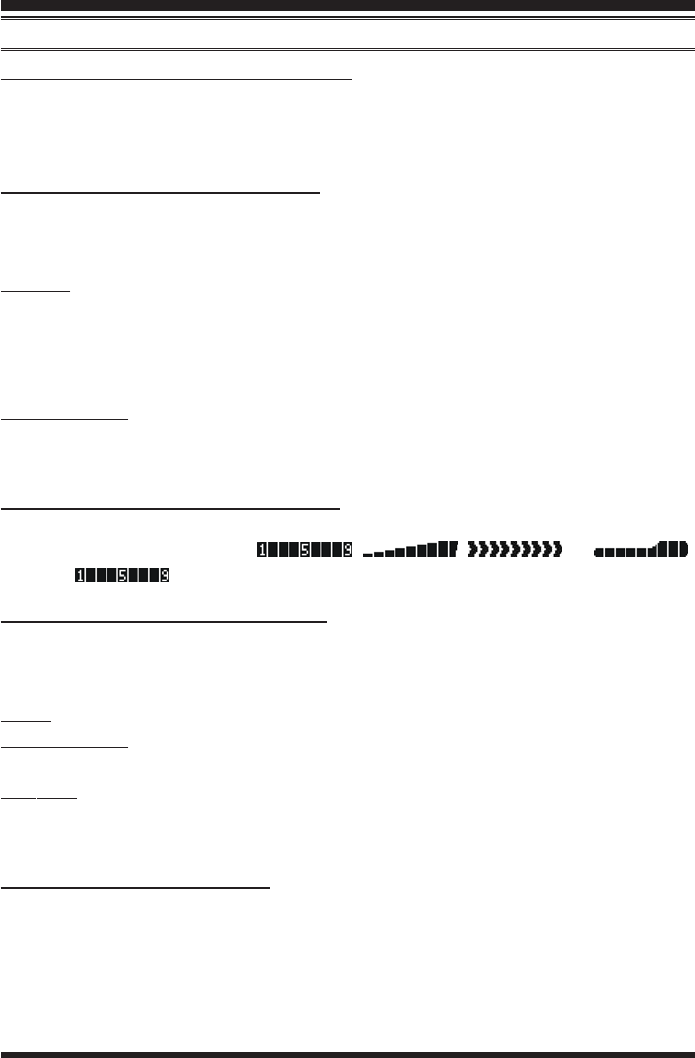
VX-8GR OPERATING MANUAL 143
SET MODE ITEM 81: SET MODE FORMAT
Function: Selects the display format of the Set Mode operation.
Available Values: LIST / ITEM
Default: LIST
SET MODE ITEM 82: SMART SEARCH
Function: Selects the Smart Search Sweep mode.
Available Values: SINGLE / CONTINUOUS
Default: SINGLE
SINGLE: The transceiver sweeps the current band once in each direction starting
on the current frequency. All channels where activity is present (up to
15 in each direction) are loaded into the Smart Search memories. Whether
or not all 31 memories are filled, the search stops after one sweep in
each direction.
CONTINUOUS: The transceiver makes a sweep in each direction as with the “SINGLE”
mode, but if all 31 channels are not filled after the first sweep, the radio
continues sweeping until they are all filled.
SET MODE ITEM 83: S-METER SYMBOL
Function: Selects the S- & TX PO meter Symbol.
Available Values: Four patterns ( , , , or )
Default:
SET MODE ITEM 84: SPEC-ANALYZER
Function: Selects the Spectrum Analyzer sweep mode.
Available Values: 1Time / CONTINUOUS / Full Time
Default: 1time
1Time: The receiver sweeps the current band once.
CONTINUOUS: The receiver sweeps the current band repeatedly until the Spectrum Ana-
lyzer is turned off.
Full Time: This mode is activated similar to a “Continuous” mode. However, the
transceiver outputs audio on the center frequency () through the speaker
when Spectrum Analyzer is activated.
SET MODE ITEM 85: SQL LEVEL
Function: Sets the Squelch threshold level.
Available Values: LEVEL 0 ~ LEVEL 15
Default: LEVEL 1
SET MODE
SET MODE SELECTION DETAILS
FCC ID: K6620415X20 / IC:511B-20415X20

VX-8GR OPERATING MANUAL144
SET MODE ITEM 86: SQL S-METER
Function: Adjusts the Squelch threshold level to the S-meter level.
Available Values: OFF / LEVEL 1 ~ LEVEL 9
Default: OFF
SET MODE ITEM 87: SQL SPLIT
Function: Enables/Disables split CTCSS/DCS coding.
Available Values: OFF / ON
Default: OFF
When this Set Mode Item is set to “ON”, you can see the following additional parameters
after the “MESSAGE” parameter while selecting the Set Mode Item 88: SQL TYPE:
D CD: DCS Encode only (“DC” icon will appear while operating)
TONE-DCS: Encodes a CTCSS Tone and Decodes a DCS code
(the “T-D” icon will appear during operation)
D CD-TONE SQL: Encodes a DCS code and Decodes a CTCSS Tone
(the “D-T” icon will appear during operation)
Select the desired operating mode from the selections shown above.
SET MODE ITEM 88: SQL TYPE
Function: Selects the Tone Encoder and/or Decoder mode.
Available Values: OFF / TONE / TONE SQL / DCS / REV TONE / PR FREQ / PAGER
/ MESSAGE
Default: OFF
TONE: Activates the CTCSS Encoder
TONE SQL: Activates the CTCSS Encoder/Decoder
DCS: Activates the Digital Coded Squelch Encoder/Decoder
REV TONE: Activates the Reverse CTCSS Encoder/Decoder (Mutes the receiver when
the matching tone is received).
PR FREQ: Activates the User Programmed Reverse CTCSS Encoder/Decoder (Mutes
the receiver when the matching tone with Set Mode Item 65: PR FRE-
QUENCY is received).
PAGER: Activates the Enhanced Paging & Code Squelch.
MESSAGE: Activates the Message feature.
Note: See also Set Mode Item 87: SQL SPLIT regarding additional selections available
during “Split Tone” operation.
SET MODE
SET MODE SELECTION DETAILS
FCC ID: K6620415X20 / IC:511B-20415X20

VX-8GR OPERATING MANUAL 145
SET MODE ITEM 89: STEP FREQUENCY
Function: Setting of the DIAL frequency steps.
Available Values: AUTO / 5.0 / 6.25 / 8.33 / 10.0 / 12.5 / 15.0 / 20.0 / 25.0 / 50.0 / 100.0
kHz
Default: AUTO (Step automatically changes according to operating frequency.)
Note: 1) This Set Mode Item can select and set the Dial frequency steps to individual
memory channels when Memory Offset Tuning is enabled as shown on page xx.
2) 8.33 kHz steps are available only when receiving on the Air band.
3) 5.0 kHz steps are not available for use on 250 - 300 MHz, nor above 580 MHz.
SET MODE ITEM 90: TIME SET
Function: Sets the Clock time.
See page xx for details.
SET MODE ITEM 91: TONE FREQUENCY
Function: Setting of the CTCSS Tone Fre-
quency
Available Values: 50 standard CTCSS tones
Default: 100.0 Hz
SET MODE ITEM 92: TONE-SRCH MUTE
Function: Enables/Disables the receiver au-
dio output while the Tone Search Scanner is
activated.
Available Values: ON / OFF
Default: ON
SET MODE ITEM 93: TONE-SRCH SPEED
Function: Selects the Tone Search Scanner speed.
Available Values: FAST (2.5 tone/sec) / SLOW (1.25 tone/sec)
Default: FAST (2.5 tone/sec)
SET MODE ITEM 94: TOT
Function: Setting of the TOT time
Available Values: OFF / 0.5min - 10.0min (0.5min/step)
Default: 3.0min (3 minutes)
The time-out timer shuts off the transmitter after a continuous transmission which is equal
to the programmed time.
SET MODE
SET MODE SELECTION DETAILS
CTCSS TONE FREQUENCY (Hz)
67.0 69.3 71.9 74.4 77.0 79.7
82.5 85.4 88.5 91.5 94.8 97.4
100.0 103.5 107.2 110.9 114.8 118.8
123.0 127.3 131.8 136.5 141.3 146.2
151.4 156.7 159.8 162.2 165.5 167.9
171.3 173.8 177.3 179.9 183.5 186.2
189.9 192.8 196.6 199.5 203.5 206.5
210.7 218.1 225.7 229.1 233.6 241.8
250.3 254.1 – – – –
FCC ID: K6620415X20 / IC:511B-20415X20

VX-8GR OPERATING MANUAL146
SET MODE ITEM 95: VFO MODE
Function: Selects or disables the VFO band edge limiting for the current band.
Available Values: ALL / BAND
Default: BAND
ALL: When the VFO frequency reaches the high edge of the current band, the VFO
frequency will jump to the low band edge of the next band (or vice versa).
BAND: When the VFO frequency reaches the high band edge of the current band, the
VFO frequency will jump to the low band edge of the current band (or vice versa).
SET MODE ITEM 96: VFO SKIP
Function: Set the My Band.
Available Values: ON / OFF
Default: OFF
The “My Band” feature allows you to select several operating bands, and make only those
bands available for selection via the B key.
ON: Only the bands that are turned on will be shown when pushing the B key.
OFF: When the B key is pressed, the bands that are turned “OFF” will not be shown.
See page 100 for details.
SET MODE ITEM 97: VIBRATOR
Function: Enables/Disables the Vibrator function.
Available Values: OFF / BUSY / SIGNALIMG
Default: OFF
OFF: The Vibrator function is disabled.
BUSY: The transceiver vibrates when receive a signal.
SIGNALIMG: The transceiver vibrates when receive a signal which include the CTCSS,
DCS, or EPCS which matches that set into your decoder.
SET MODE ITEM 98: VIBRATOR MODE
Function: Selects the vibration mode of the Vibrator function.
Available Values: MODE1 / MODE2 / MODE3
Default: MODE1
MODE1: The transceiver vibrates continuously.
MODE2: The transceiver vibrates at a long interval.
MODE3: The transceiver vibrates at a short interval.
SET MODE
SET MODE SELECTION DETAILS
FCC ID: K6620415X20 / IC:511B-20415X20

VX-8GR OPERATING MANUAL 147
SET MODE ITEM 99: VOLUME MODE
Function: Select the g key function.
Available Values: NORMAL / AUTO BACK
Default: NORMAL
NORMAL: The g key keeps the status while pressing the g key.
AUTO BACK: The g key keeps the status for approximately three seconds after press-
ing the g key.
SET MODE ITEM 100: WX ALERT
Function: Enables/disables the Weather Alert Feature
Available Values: ON/OFF
Default: OFF
SET MODE SELECTION DETAILS
FCC ID: K6620415X20 / IC:511B-20415X20

VX-8GR OPERATING MANUAL148
APRS/GPS SET MODE
FUNCTION AVAILABLE VALUES
(DEFALT: BOLD ITALIC)
1: APRS DESTINATION
2: APRS FILTER
3: APRS MODEM
4: APRS MSG FLASH
5: APRS MSG TXT
6: APRS MSG VIBRAT
7: APRS MUTE
8: APRS RINGER MSG
9: APRS RINGER BCON
10: APRS UNIT
11: APRS TX DELAY
12: BEACON INTERVAL
13: BEACON STATS TXT
14: BEACON TX
15: COM PORT SETTING
16: DIGI PATH
17: GPS DATUM
18: GPS POWER
19: GPS TIME SET
20: GPS UNIT
21: MSG GROUP
22: MY CALLSIGN
23: MY POSITION
24: MY SYMBOL
25: POSITION COMMENT
26: SmartBeaconing
27: TIME ZONE
Indicates the model code of this transceiver.
Selects the filter type option allowing you to receive the only specified types of APRS Beacon
data.
Enables/Disables the APRS modem (AX25 Data modem) and its Baud Rate.
Enables/Disables the white LED light when the APRS message is received.
Programming the Fixed form APRS Message.
Selects the Vibration function when receive the APRS Message.
Enables/Disables the audio output of the “B-Band” during APRS operation.
Enables/Disables the alert ringer when the APRS message is received.
Enables/Disables the alert ringer when the APRS beacon is received.
Selects the unit for the APRS Beacon information.
Select the transmission delay time between transmitting the APRS data and transmitting a
preamble (flag code) prior to the APRS data.
Select the Beacon Interval time during APRS operation
Store the message for the APRS Beacon
Enables/Disables the automatic transmission of the APRS Beacon.
Sets the COM port setting.
Sets the APRS packet path you wish to path through.
Select the GPS Datum.
Enables/Disables the built-in GPS Receiver Unit.
Enables/Disables the GPS clock data to be used.
Selects the units for the GPS information.
Selects the filter type option allowing you to receive only specified types of APRS Message
information.
Program your callsign.
Determine and memorize your location (Lat/Log).
Selects your icon which will be displayed on the monitors of other stations as you.
Selects position comment depending on your situation.
Sets the SmartBeaconingTM feature. (SmartBeaconingTM from HamHUD Nichetronix)
Set the time offset between the local time and UTC.
APY008 (Fixed)
Mic-E: ON / OFF
POSITION: ON / OFF
WEATHER: ON / OFF
OBJECT: ON / OFF
ITEM: ON / OFF
STATUS: ON / OFF
OTHER: ON / OFF
OFF / 1200bps / 9600bps
MSG: OFF / 2sec - 10sec (2sec/step) / 20sec /
30sec / 60sec / CONTINUOUS /
EVERY 2s - EVERY 10s (10sec/step) /
EVERY 1m - EVERY 10m (10min/step)
(4sec)
GRP: OFF / 2sec - 10sec (2sec/step) / 20sec /
30sec / 60sec / CONTINUOUS (4sec)
BLT: OFF / 2sec - 10sec (2sec/step) / 20sec /
30sec / 60sec / CONTINUOUS (4sec)
--
MSG: ON / OFF
GRP: ON / OFF
BLT: ON / OFF
ON / OFF
MSG: OFF / ON / USER BP1 / USER BP2 /
USER BP3
GRP: OFF / ON / USER BP1 / USER BP2 /
USER BP3
BLT: OFF / ON / USER BP1 / USER BP2 /
USER BP3
ON / OFF
Position: MM.MM’ / MM’SS”
Distance: km / mile
Speed: km/h / knot / mph
Altitude: m / ft
Temp: °C / °F
Rain: mm / inch
Wind: m / s / mph
100ms / 150 ms / 200ms / 250ms / 300ms /
400ms / 500ms / 750ms / 1000ms
30sec / 1min / 2min / 3min / 5min / 10min /
15min / 20min / 30min / 60min
--
MANUAL / AUTO / SMART
P1 OFF
P2 (1) 1 WIDE1 -1
P3 (2) 1 WIDE1 -1,2 WIDE2 - 1
P4 (2) 1 - - - - - - , 2 - - - - - -
P5 (2) 1 - - - - - - , 2 - - - - - -
P6 (2) 1 - - - - - - , 2 - - - - - -
P7 (2) 1 - - - - - - , 2 - - - - - -
P8 (8) 1 - - - - - - , 2 - - - - - -
WGS-84 / Tokyo Mean / Tokyo Japan /
Tokyo Korea / Tokyo Okinawa
GPS ON / GPS OFF
AUTO / MANUAL
Position: .MMM’ / ‘SS”
Speed: km/h / knot / mph
Altitude: m / ft
G1 ~ G5, B1 ~ B3
(G1: ALL, G2: CQ, G3: QST, G4: YAESU)
--
GPS / Lat / Lon / P1 ~ P10
more than 180 symbols
Off Duty / En Route / In Service / Returning /
Committed / Special / Priority /
Custom 0 ~ Custom 6 / EMERGENCY!
OFF / TYPE1 / TYPE2 / TYPE3
UTC -13:00H ~ UTC +13:00H (0.5H / step)
(UTC + 0:00H)
SET MODE ITEM
FCC ID: K6620415X20 / IC:511B-20415X20

VX-8GR OPERATING MANUAL 149
APRS/GPS SET MODE DETAILS
APRS/GPS Set Mode Item 1: APRS DESTINATION
Function: Indicates the model code of this transceiver.
Default: APY008
This model code can not be changed.
APRS/GPS Set Mode Item 2: APRS FILTER
Function: Selects the filter type option allowing you to receive only the specified types of
APRS Beacon data.
Available Values: Mic-E, POSITION, WEATHER, OBJECT, ITEM, STATUS, OTHER
Default: Mic-E: ON, POSITION: ON, WEATHER: ON, OBJECT: ON, ITEM: ON,
STATUS: ON, OTHER: OFF
Mic-E: When this item set to “ON”, the transceiver shows the stations which send
a MIC Encoder Beacon.
POSITION: When this item set to “ON”, the transceiver shows the stations which send
a Position Beacon and Raw NMEA data.
WEATHER: When this item set to “ON”, the transceiver shows the stations which send
a Weather Beacon.
OBJECT: When this item set to “ON”, the transceiver shows the stations which send
an Object Beacon.
ITEM: When this item set to “ON”, the transceiver shows the stations which send
an Item Beacon.
STATUS: When this item set to “ON”, the transceiver shows the stations which send
a Status Beacon.
OTHER: When this item set to “ON”, the transceiver shows the stations which send
a packet signal except the APRS beacon.
APRS/GPS Set Mode Item 3: APRS MODEM
Function: Enables/Disables the APRS modem (AX.25 Data modem) and its Baud Rate.
Available Values: OFF / 1200bps / 9600bps
Default: OFF
APRS/GPS SET MODE
FCC ID: K6620415X20 / IC:511B-20415X20

VX-8GR OPERATING MANUAL150
APRS/GPS Set Mode Item 4: APRS MSG FLASH
Function: Selects the interval time of the white LED light function when the APRS mes-
sage is received.
Available Values: MSG:OFF / 2sec - 10sec (2sec/step) / 20sec / 30sec / 60sec /
CONTINUOUS / EVERY 2s - EVERY 10s (10sec/step) /
EVERY 1m - EVERY 10m (10min/step)
GRP: OFF / 2sec - 10sec (2sec/step) / 20sec / 30sec / 60sec /
CONTINUOUS
BLT: OFF / 2sec - 10sec (2sec/step) / 20sec / 30sec / 60sec /
CONTINUOUS
Default: MSG: 4sec, GRP: 4sec, BLT: 4sec
MSG: When receive the message to myself, the white LED light flashes according to the
setting of this item.
GRP: When receive the group message, the white LED light flashes according to the
setting of this item.
BLT: When receive the bulletin message, the white LED light flashes according to the
setting of this item.
APRS/GPS Set Mode Item 5: APRS MSG TXT
Function: Programming the Fixed form APRS Message.
See page ?? for details.
APRS/GPS Set Mode Item 6: APRS MSG VIBRAT
Function: Selects the Vibrator function when receive the APRS Message.
Available Values: MSG: ON / OFF, GRP: ON / OFF, BLT: ON /OFF
Default: MSG: OFF, GRP: OFF, BLT: OFF
MSG: When this item set to “ON”, the transceiver vibrates when receive the message to
myself.
GRP: When this item set to “ON”, the transceiver vibrates when receive the group mes-
sage.
BLT: When this item set to “ON”, the transceiver vibrates when receive the bulletin
message.
APRS/GPS SET MODE
APRS/GPS SET MODE DETAILS
SETTING
EVERY 2sec - 5sec
EVERY 6sec - 9sec
EVERY 10sec - 50sec
EVERY 1min - 5min
EVERY 6min - 10min
LED LIGHT
Flash one time every setting interval
Flash two times every setting interval
Flash three times every setting interval
Flash four times every setting interval
Flash five times every setting interval
FCC ID: K6620415X20 / IC:511B-20415X20

VX-8GR OPERATING MANUAL 151
APRS/GPS Set Mode Item 7: APRS MUTE
Function: Enables/Disables audio output of the “B-Band” during APRS operation.
Available Values: ON/OFF
Default: OFF
APRS/GPS Set Mode Item 8: APRS RINGER MSG
Function: Selects the alert ringer when the APRS message is received.
Available Values: MSG: OFF / ON / USR BP1 / USR BP2 / USR BP3
GRP, BLN: OFF / ON / USR BP1 / USR BP2 / USR BP3
Default: MSG: OFF, GRP, BLN: OFF
MSG: When receive the message to myself, the alert ringer sounds according to the
setting of this item.
GRP, BLN: When receive the group or bulletin message, the alert ringer sounds accord-
ing to the setting of this item.
APRS/GPS Set Mode Item 9: APRS RINGER BCON
Function: Enables/Disables the alert ringer when the APRS beacon is received.
Available Values: ON/OFF
Default: ON
APRS/GPS Set Mode Item 10: APRS UNIT
Function: Selects the unit for the APRS Beacon information.
Available Values: Position: MM.MM’/MM’SS”, Distance: km/mile,
Speed: km/h/knot/mph, Altitude: m/ft, Temp: °C/°F, Rain: mm/inch, Wind: m/s/mph
Default: Position: MM.MM’, Distance: mile, Speed: mph, Altitude: ft, Temp: °F,
Rain: inch, Wind: mph
APRS/GPS Set Mode Item 11: APRS TX DELAY
Function: Select the transmission delay time between transmitting the APRS data and
transmitting a preamble (flag code) prior to the APRS data.
Available Values: 100ms/150ms/200ms/250ms/300ms/400ms/500ms/750ms/1000ms
Default: 300ms
PRS/GPS Set Mode Item 12: BEACON INTERVAL
Function: Select the Beacon Interval time during APRS operation
Available Values: 30sec/1min/2min/3min/5min/10min/15min/20min/30min/60min
Default: 5min
APRS/GPS Set Mode Item 13: BEACON STATS TXT
Function: Store the message for the APRS Beacon
See page xx for details.
APRS/GPS SET MODE
APRS/GPS SET MODE DETAILS
FCC ID: K6620415X20 / IC:511B-20415X20

VX-8GR OPERATING MANUAL152
APRS/GPS Set Mode Item 14: BEACON TX
Function: Enables/Disables the automatic transmission of the APRS Beacon.
Available Values: MANUAL/AUTO/SMART
Default: MANUAL
MANUAL: The VX-8GR does not transmit the APRS beacon automatically. To transmit
the APRS beacon, just press the d key.
AUTO: The VX-8GR transmits the APRS beacon automatically at the time interval
which is set in Set Mode Item 12: BEACON INTERVAL.
SMART: The VX-8GR transmits the APRS beacon automatically when the events that
are set in Set Mode Item 26: SmartBeaconing occures.
APRS/GPS Set Mode Item 15: COM PORT SETTING
Function: Sets the COM port setting.
Available Values: STATUS: OFF / ON
SPEED: 4800 / 9600 / 19200 (bps)
INPUT: OFF / GPS
OUTPUT: OFF / GPS / WAY.P
WAYPOINT: NMEA6 / NMEA7 / NMEA8 / NMEA9
Default: STATUS: OFF, SPEED: 9600, INPUT: OFF, OUTPUT: OFF,
WAYPOINT: NMEA9
SPEED: This item selects the baud rate of the COM port which connects the
optional packet cable.
INPUT: This item selects the type of data input to the COM port.
OUTPUT: This item selects the type of data output to the COM port.
When this item is set to “OFF”, the transceiver does not output any
data from the COM port.
When this item is set to “GPS”, the transceiver outputs the GPS data
(NMEA data: GGA & RMC) from the COM port.
When this item is set to “WAY.P”, the transceiver outputs the
Waypoint data from the COM port.
APRS/GPS Set Mode Item 16: DIGI PATH
Function: Sets the APRS packet path you wish to path through.
Available Values: P1 ~ P8
Default: P1: OFF, P2: WIDE1-1, P3: WIDE1-1/WIDE2 -1, P4 ~ P8: non
APRS/GPS SET MODE
APRS/GPS SET MODE DETAILS
FCC ID: K6620415X20 / IC:511B-20415X20

VX-8GR OPERATING MANUAL 153
APRS/GPS Set Mode Item 17: GPS DATUM
Function: Select the GPS Datum.
Available Values: WGS-84/Tokyo Mean/Tokyo Japan/Tokyo Korea/Tokyo Okinawa
Default: WGS-84
APRS/GPS Set Mode Item 18: GPS POWER
Function: Enables/Disables the built-in GPS Antenna Unit.
Available Values: GPS OFF/GPS ON
Default: GPS OFF
APRS/GPS Set Mode Item 19: GPS TIME SET
Function: Enables/Disables the GPS clock data to be used.
Available Values: AUTO/MANUAL
Default: AUTO
APRS/GPS Set Mode Item 20: GPS UNIT
Function: Selects the units for GPS information.
Available Values: Position: .MMM’/ ‘SS”, Speed: km/h/knot/mph, Altitude: m/ft
Default: Position: .MMM’, Speed: mph, Altitude: ft
Note: The “Position” item selects the coordinate system. When the “Position” item is set
to “.MMM’.MMM’
.MMM’.MMM’
.MMM’”, the VX-8GR displays the location (Lat/Lon) in “ddd° mm. mmmddd° mm. mmm
ddd° mm. mmmddd° mm. mmm
ddd° mm. mmm” (Decimal
system). When the “Position” item is set to “‘SS”‘SS”
‘SS”‘SS”
‘SS””, the VX-8GR displays the location
(Lat/Lon) in “ddd° mm ssddd° mm ss
ddd° mm ssddd° mm ss
ddd° mm ss” (Sexagesimal System). The position information used during
APRS operation is used to display the location (Lat/Lon) in Sexagesimal System, regard-
less of this Set Mode setting.
APRS/GPS Set Mode Item 21: MSG GROUP
Function: Selects the filter type option allowing you to receive only the specified types of
APRS Message information.
Available Values: G1 ~ G5, B1 ~ B3
Default: G1: ALL, G2: CQ, G3: QST, G4: YAESU, G5: non, B1 ~ B3: non
APRS/GPS Set Mode Item 22: MY CALLSIGN
Function: Program your callsign.
See page xx for details.
APRS/GPS SET MODE
APRS/GPS SET MODE DETAILS
FCC ID: K6620415X20 / IC:511B-20415X20

VX-8GR OPERATING MANUAL154
APRS/GPS Set Mode Item 23: MY POSITION
Function: Determine and memorize your location (Lat/Lon).
Available Values: GPS / Lat / Lon / P1 ~ P10
Default: GPS
GPS: Your location is determined by the built-in GPS receiver Unit.
Lat/Lon: Your location can be entered manually (See page xx for details).
P1 ~ P10: Memory Slot for your location (Lat/Lon) as measured with the GPS.
To memorize the location:
1. Receive the GPS signal.
2. Recall the APRS/GPS Set Mode Item 23: MY POSITION23: MY POSITION
23: MY POSITION23: MY POSITION
23: MY POSITION.
3. Press the m key briefly to enable adjustment of this Set Mode Item.
4. Rotate the DIAL knob to select the memory slot (11
11
1 - 1010
1010
10) you wish to memorize your
location into.
5. Press and hold the h key for one second to memorize your location (Lat/Lon) into
the slot.
Note: Remember to return this Set Mode Item to “Auto” after you have finished entering
your position data into memory. If not then the transceiver always transmits the position
data stored in memory and not your true GPS position data.
APRS/GPS Set Mode Item 24: MY SYMBOL
Function: Select your icon which will be displayed to identify your station on the moni-
tors of other stations.
Available Values: ICON1, ICON2, ICON3 (46 symbols each), and ICON4 (free select
charactor)
Default: ICON1: , ICON2: , ICON3:, USER:
You may replace the default icon of the ICON1, ICON2, and ICON3 to another one by
rotating the DIAL knob after having pressed the M key.
If you wish to change the ICON4 icon, press the M key twice, then rotate the DIAL
knob to select the desired Symbol Table ID (left digits in the parenthesis), then press the
M key and rotate the DIAL knob to select the desired Symbol Code (right digits in the
parenthesis).
APRS/GPS Set Mode Item 25: POSITION COMMENT
Function: Selects position comment depending on your situation.
Available Values: Off Duty, En Route, In Service, Returning, Committed, Special, Prior-
ity, Custom 0 ~ Custom 6, EMERGENCY!
Default: Off Duty
APRS/GPS SET MODE
FCC ID: K6620415X20 / IC:511B-20415X20

VX-8GR OPERATING MANUAL 155
APRS/GPS SET MODE
APRS/GPS Set Mode Item 26: SmartBeaconing
Function: Selects the various parameters of the SmartBeaconingTM. The transceiver trans-
mits the APRS beacon automatically when each parameter value exceeds the set point.
Available Values: OFF, TYPE1, TYPE2, or TYPE3
LOW SPEED: 2 ~ 30 mph
HIGH SPEED: 3 ~ 70 mph
SLOW RATE: 1 min ~ 100 min
FAST RATE: 10 sec ~ 180 sec
TURN ANGLE: 5° ~ 90°
TURN SLOPE: 1 ~ 255
TURN TIME: 5 sec ~ 180 sec
Default: TYPE1 (for Vehicle) TYPE2 (for Bicycle) TYEP3 (for Warking)
LOW SPD: 5 mph 3 mph 2 mph
HIGH SPD: 70 mph 30 mph 12 mph
SLOW RATE: 30 min 30 min 30 min
FAST RATE: 120 sec 120 sec 120 sec
TURN ANGL: 28° 28° 28°
TURN SLOP: 26 11 7
TURN TIME: 30 sec 30 sec 30sec
Press the a/b key to select each parameter, then rotate the DIAL knob to set the
parameter values.
The units of the speed are determined by the transceiver version.
SmartBeaconingTM from HamHUD Nichetronix.
STATUS: These resisters sum up (combine) the “LOW SPD” through “TURN TIME”
items parameters in the “TYPE 1”, “TYPE 2”, or “TYPE 3” settings.
When STATUS is set to “TYPE 1”, “TYPE 2”, or “TYPE 3”, the
SmartBeaconingTM is activated with parameters of that setting.
When STATUS is set to “OFF”, the SmartBeaconingTM function is dis-
abled.
LOW SPD: This item designates the lower speed threshold. The VX-8GR transmits an
APRS beacon when your movement speed becomes lower than the se-
lected speed. The transmission interval time of the APRS beacon is set in
“SLOW RATE” item. The speed unit is determined from the APRS/GPS
Set Mode Item 10: APRS UNIT.
HIGH SPD: This item designates the higher speed threshold. The VX-8GR transmits
an APRS beacon when your movement speed becomes higher than the
selected speed. The transmission interval time of the APRS beacon is set
in “FAST RATE” item. The speed unit is determined from the APRS/GPS
Set Mode Item 10: APRS UNIT.
FCC ID: K6620415X20 / IC:511B-20415X20

VX-8GR OPERATING MANUAL156
APRS/GPS SET MODE
SLOW RATE: This item designates the transmission interval time of the APRS beacon at
low movement speeds.
FAST RATE: This item designates the maximum transmission interval time of the APRS
beacon at high movement speeds.
TURN ANGL: This item designates the course change angle that indicates a progress
heading change.
TURN SLOP: This item sets a coefficient to modify the TURN ANGLE algorithm, thus
increasing the beacon rate for lower movement speeds.
When this setting value is increased, the threshold angles of the APRS
beacon timing are increased as the vehicle velocity is decreased.
TURN TIME: This item designates the minimum delay time between each APRS bea-
con. The VX-8GR does not transmit an APRS beacon until this setting
time has elapsed since the previous APRS beacon transmission, prevent-
ing too frequent beacon transmissions.
SmartBeaconingTM from HamHUD Nichetronix.
APRS/GPS Set Mode Item 27: TIME ZONE
Function: Set the time offset between the local time and UTC.
Available Values: UTC -13:00H ~ UTC +13:00H (0.5H/step)
Default: UTC +0:00H
FCC ID: K6620415X20 / IC:511B-20415X20
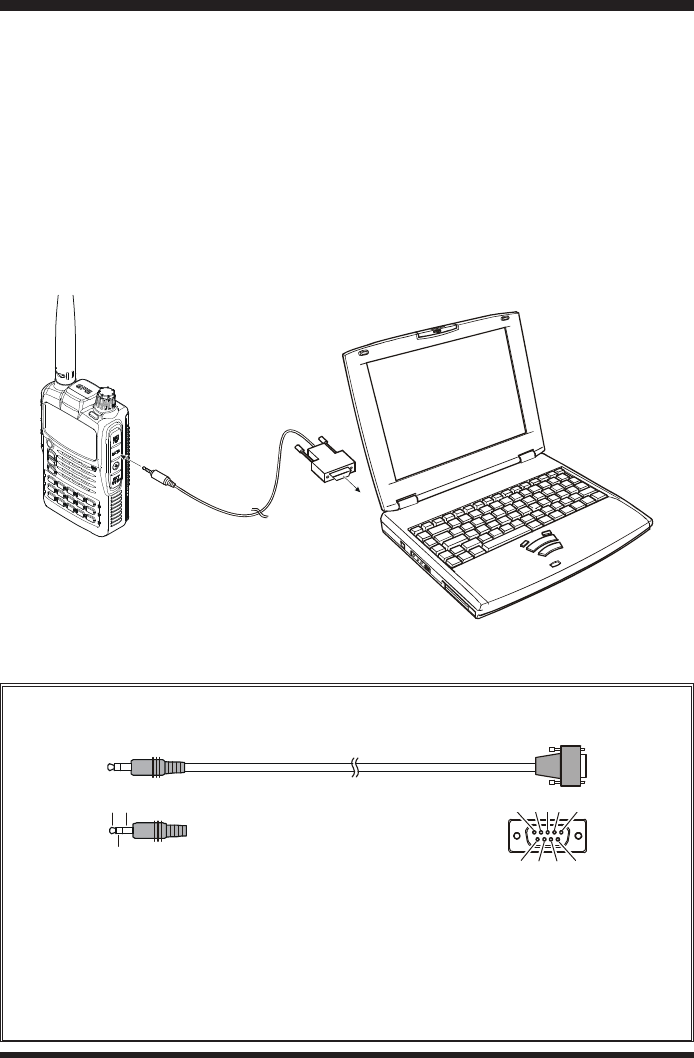
VX-8GR OPERATING MANUAL 157
The VX-8GR allows connecting a computer USB port to the ACC Jack, and enables
following functions. Refer to refer to “APRS/GPS Set Mode Item 15: COM PORT SET-
TING” for the details.
Displays the location data (Lat/Lon) of the after-market GPS receiver on the dis-
play.
Outputs the location data (Lat/Lon) of the built-in GPS receiver unit.
Outputs the Waypoint data of the received APRS beacon.
Refer to the illustration below, connect the optional CT-143 PC Connection Cable be-
tween the USB jack of your Computer and the DATA Jack on the VX-8GR.
APPENDIX (COMPUTER CONNECTIONS)
DATA Jack
CT-143 PC Connection Cable
(Option)
COM Port
D-SUB 9-PIN
N.C.
TXD (Serial data output: VX-8GR PC)
RXD (Serial data input: VX-8GR PC)
N.C.
GND
N.C.
Connected to pin
Connected to pin
N.C.
2.5-mm 3-pin PLUG
TXD (Serial data output: VX-8GR PC)
RXD (Serial data input: VX-8GR PC)
GND
CT-143 Cable Connections
To VX-8GR To PC
FCC ID: K6620415X20 / IC:511B-20415X20

VX-8GR OPERATING MANUAL158
SPECIFICATIONS
GENERAL
Frequency Ranges: A (Main) Band RX: 108-137 MHz (Air Band)
137-174 MHz (144 MHz HAM)
174-222 MHz (VHF-TV)
222-420 MHz (General 1)
420-470 MHz (430 MHz HAM)
470-800 MHz (UHF-TV, Cellular Blocked)
800-999.90 MHz (General 2, Cellular Blocked)
B (Sub) Band RX: 108-137 MHz (Air Band)
137-174 MHz (144 MHz HAM)
174-222 MHz (VHF-TV)
222-420 MHz (General 1)
420-470 MHz (430 MHz HAM)
470-580 MHz (UHF-TV)
TX: 144-146 MHz or 144-148 MHz
430-440 MHz or 430-450 MHz
Channel Steps: 5/6.25/8.33/10/12.5/15/20/25/50/100 kHz
Emission Type: F1D, F2A, F2D, F3E
Frequency Stability: ±5 ppm (–10 °C to +60 °C [+14 °F to +140 °F])
Repeater Shift: ±600 kHz (144 MHz), ±1.6/5.0/7.6 MHz (430 MHz)
Antenna Impedance: 50 Ohms
Supply Voltage: Nominal: 7.4 V DC (Negative Ground)
Operating: 4-14 V DC (Negative Ground, EXT DC jack)
Operating with Charging: 11-16 V DC (Negative Ground, EXT DC jack)
Current Consumption: 200 mA (Mono Band Receive)
(@7.4 VDC, approx.) 240 mA (Dual Band Receive)
85 mA (Mono Band Receive, Standby, Saver Off)
120 mA (Dual Band Receive, Standby, Saver Off)
35 mA (Mono Band Receive, Standby, Saver On “Save Ratio 1:5”)
42 mA (Dual Band Receive, Standby, Saver On “Save Ratio 1:5”)
300 μA (Auto Power Off)
1.7A (144 MHz, 5W TX)
1.9 A (430 MHz, 5W TX)
Operating Temperature: –20 °C to +60 °C (–4 °F to +140 °F)
Case Size (W x H x D): 60 x 95 x 28 mm (2.4” x 3.7” x 1.1”) w/o knob & antenna
Weight (Approx.): 250 g (8.8 oz) with FNB-101LI & antenna
TRANSMITTER
RF Power Output: 1.0 W (@4.5 V: AA x 3)
5.0 W (@7.4 V or EXT DC)
L3: 2.5 W, L2: 1 W, L1: 0.05 W (@7.4 V)
Modulation Type: F2E, F3E: Variable Reactance
Maximum Deviation: ±5 kHz (F2E/F3E)
Spurious Emission: At least 60 dB below (@ TX power HI/L3/L2)
At least 50 dB below (@ TX power L1)
Microphone Impedance: 2K Ohms
FCC ID: K6620415X20 / IC:511B-20415X20

VX-8GR OPERATING MANUAL 159
RECEIVER
Circuit Type: Double-Conversion Superheterodyne
IF: 1st: 47.25 MHz (A (Main) Band),
46.35 MHz (B (Sub) Band),
2nd: 450 kHz
Sensitivity: 1.5 μV (TYP) for 10 dB SN (108-137 MHz @AM)
0.2 μV for 12 dB SINAD (137-140 MHz @NFM)
0.16 μV for 12 dB SINAD (140-150 MHz @NFM)
0.2 μV for 12 dB SINAD (150-174 MHz @NFM)
1.0 μV for 12 dB SINAD (174-222 MHz @NFM)
0.5 μV for 12 dB SINAD (300-350 MHz @NFM)
0.2 μV for 12 dB SINAD (350-400 MHz @NFM)
0.18 μV for 12 dB SINAD (400-470 MHz @NFM)
1.5 μV for 12 dB SINAD (470-540 MHz @NFM)
3.0 μV (TYP) for 12 dB SINAD (540-800 MHz @NFM)
1.5 μV (TYP) for 12 dB SINAD (800-999.90 MHz @NFM)
(Cellular Blocked)
Selectivity: 12 kHz/35 kHz (–6dB/–60dB: NFM, AM)
AF Output: 200 mW @ 8 Ohms for 10 % THD (@ 7.4 V DC)
400 mW @ 8 Ohms for 10 % THD (@ 13.8 V DC)
Specifications are subject to change without notice, and are guaranteed within the 144/430 MHz
amateur bands only.
Cellular Blocked per FCC rule Part 15.121, may not receive 900 MHz Amateur band.
SPECIFICATIONS
FCC ID: K6620415X20 / IC:511B-20415X20

VX-8GR OPERATING MANUAL160
FCC ID: K6620415X20 / IC:511B-20415X20

1. Changes or modifications to this device not expressly approved by VERTEX
STANDARD could void the user’s authorization to operate this device.
2. This device complies with part 15 of the FCC Rules. Operation is subject to
the following two conditions; (1) this device may not cause harmful
interference, and (2) this device must accept any interference including
interference that may cause undesired operation.
3. The scanning receiver in this equipment is incapable of tuning, or readily
being altered, by the User to operate within the frequency bands allocated
to the Domestic public Cellular Telecommunications Service in Part 22.
WARNING: MODIFICATION OF THIS DEVICE TO RECEIVE CELLULAR
RADIOTELEPHONE SERVICE SIGNALS IS PROHIBITED UNDER FCC RULES
AND FEDERAL LAW.
DECLARATION BY MANUFACTURER
The Scanner receiver is not a digital scanner and is incapable of being converted
or modified to a digital scanner receiver by any user.
FCC ID: K6620415X20 / IC:511B-20415X20

Printed in JapanCopyright 2010
VERTEX STANDARD CO., LTD.
All rights reserved.
No portion of this manual
may be reproduced
without the permission of
VERTEX STANDARD CO., LTD.
EH041M100
FCC ID: K6620415X20 / IC:511B-20415X20